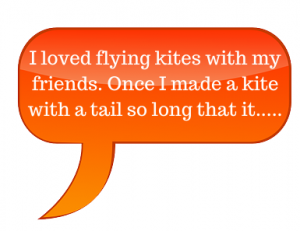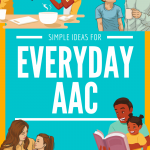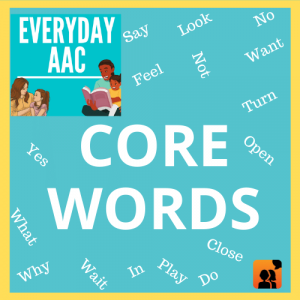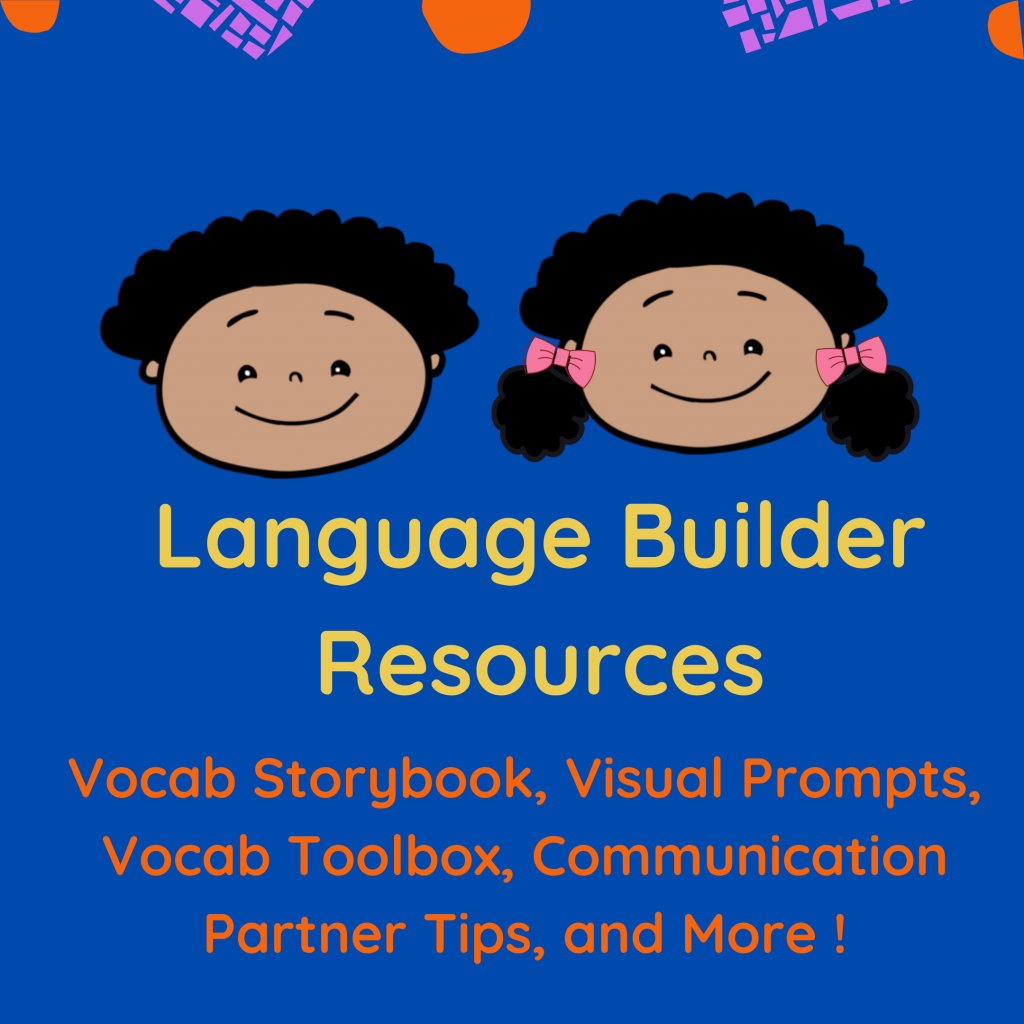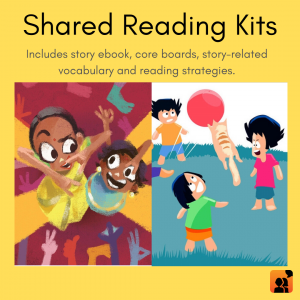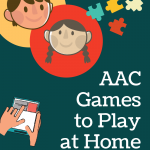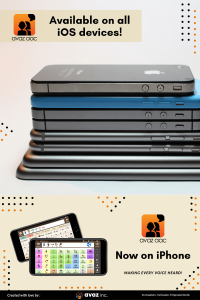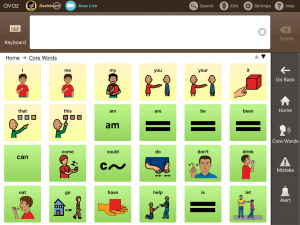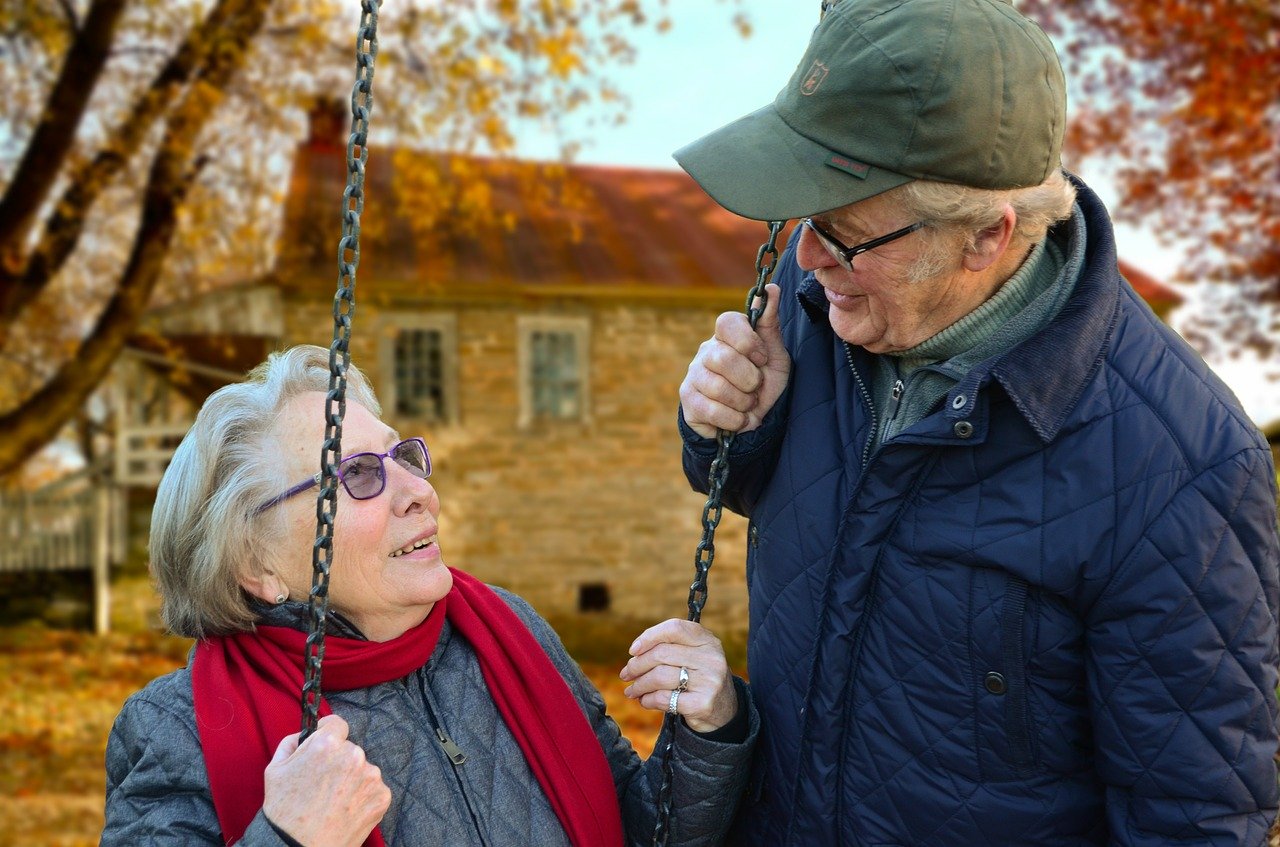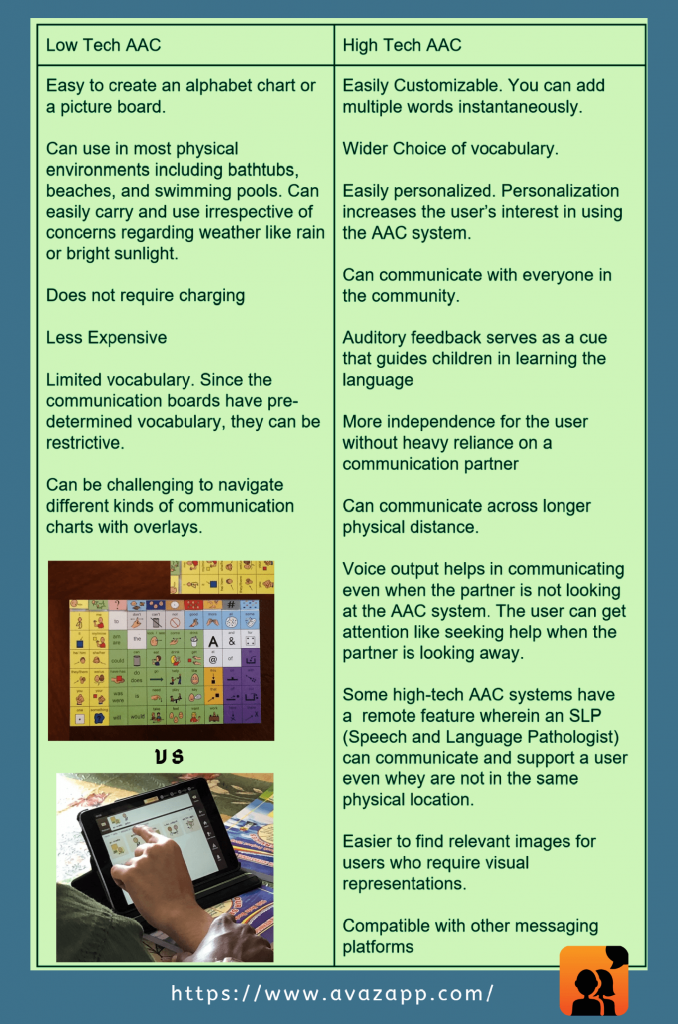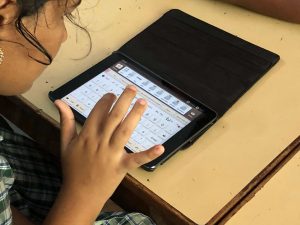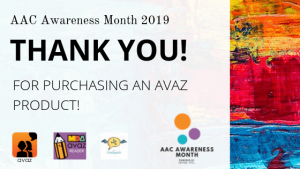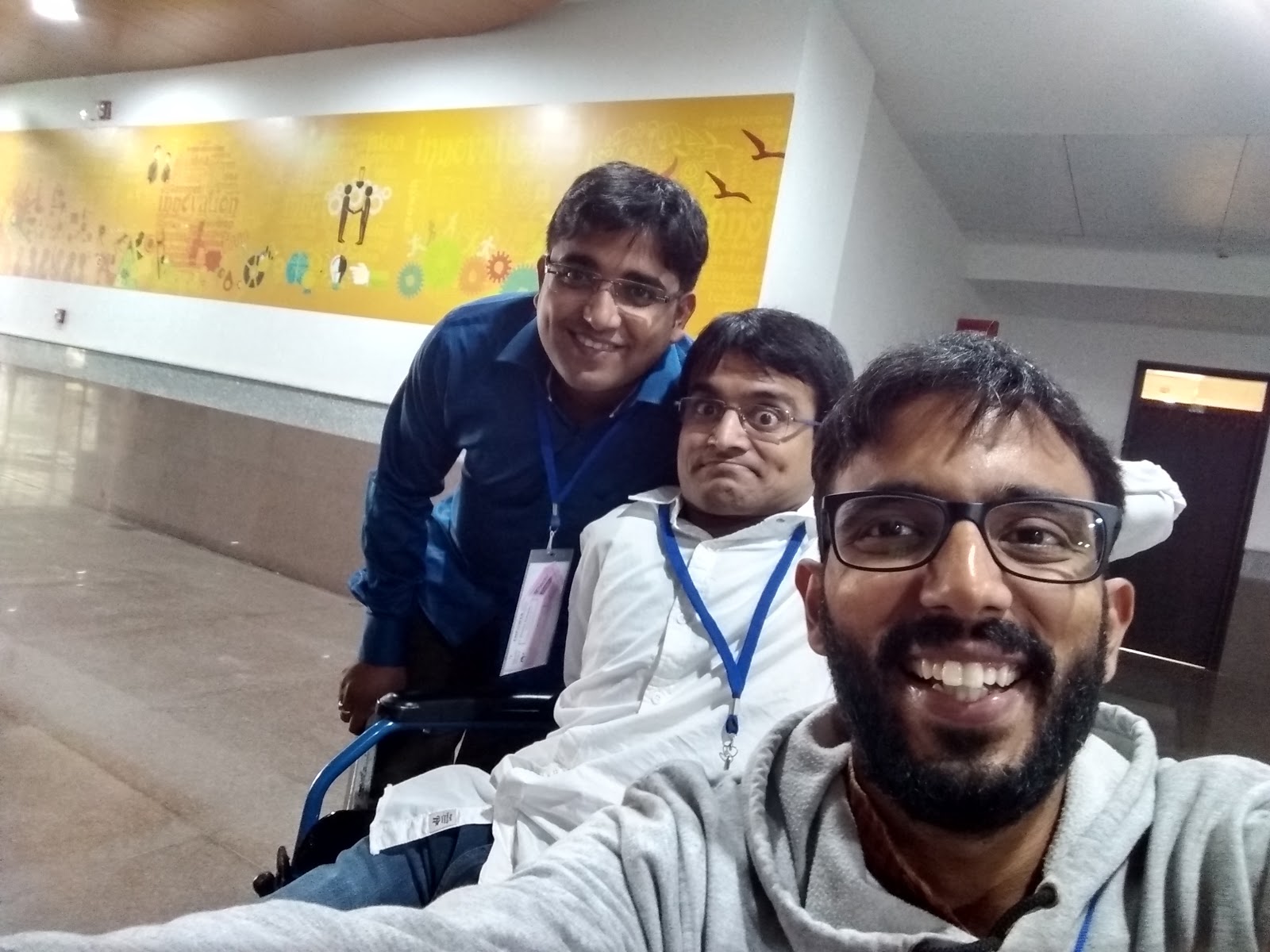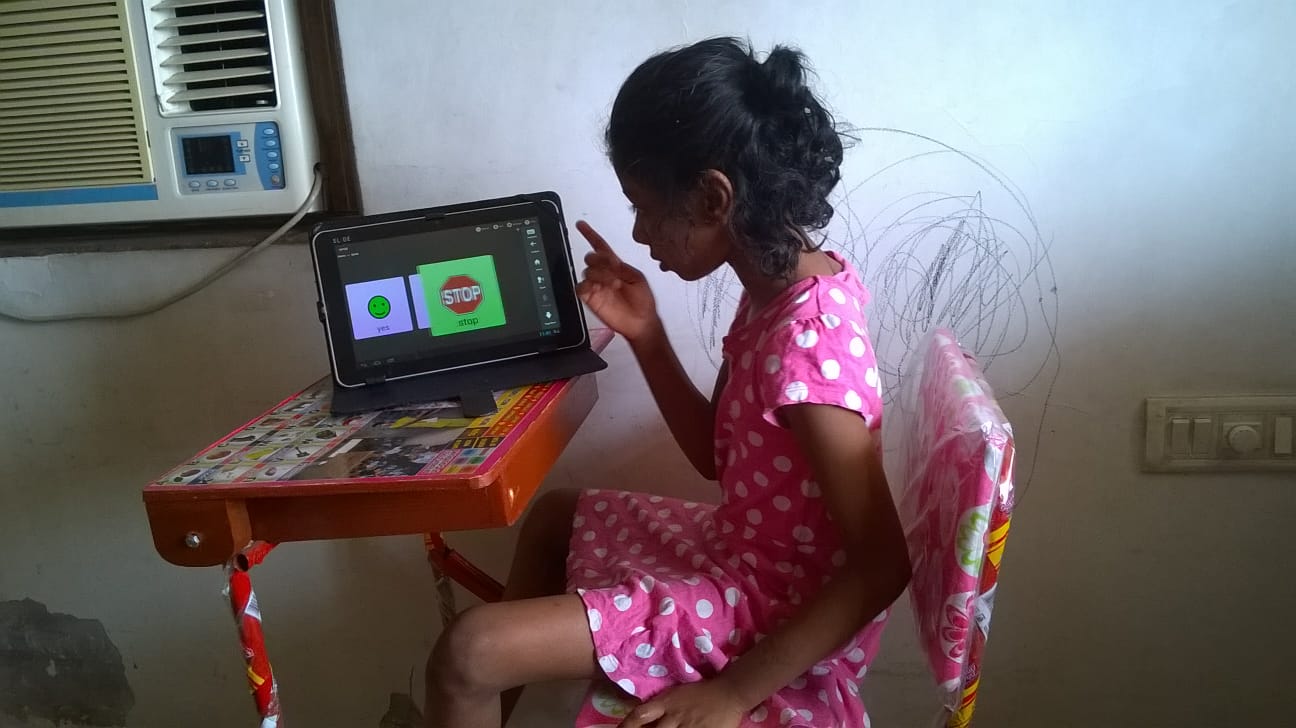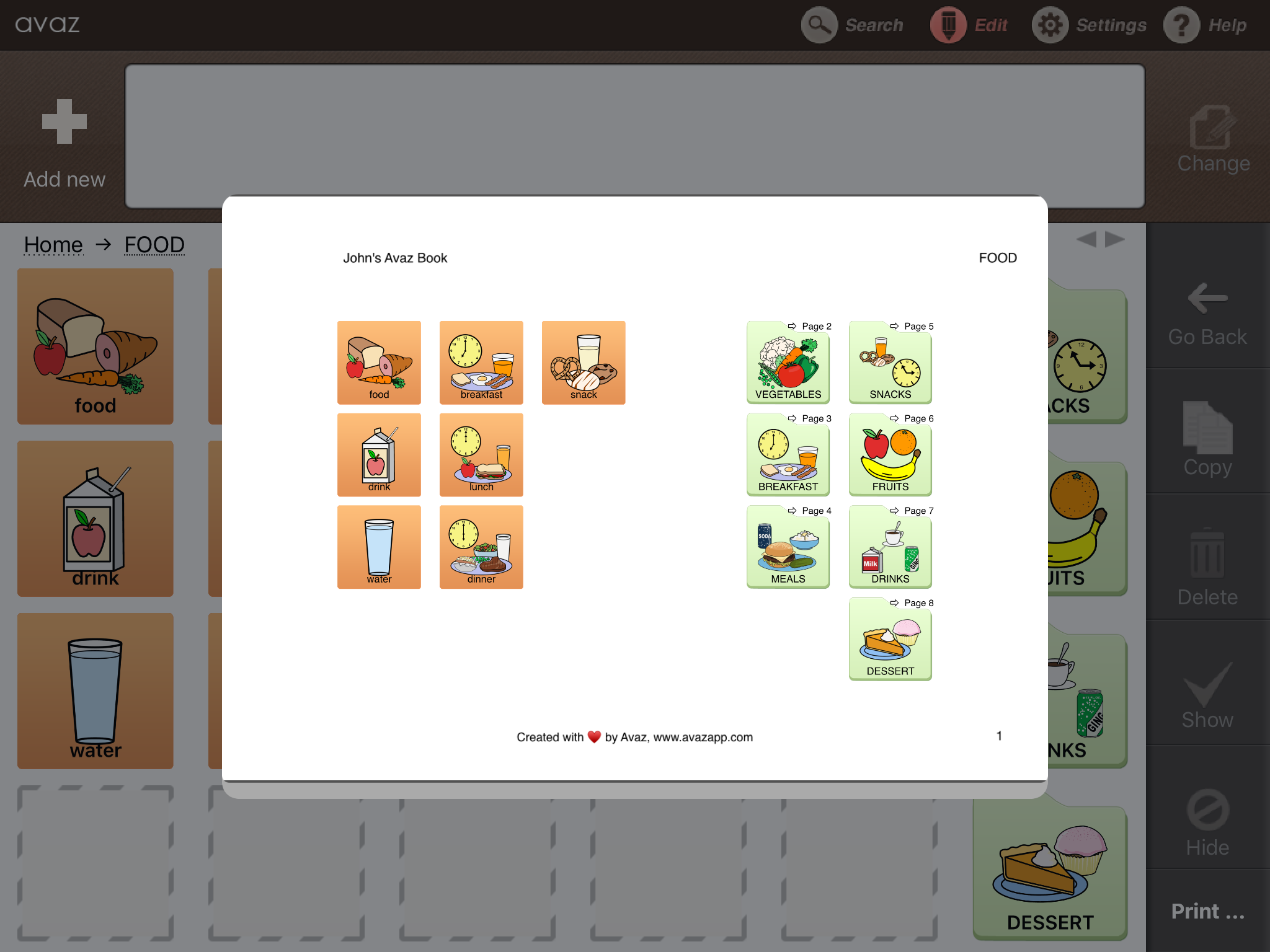Impacting Lives Through Codes
Sep 14, 2020
 Developing assistive technology apps requires more than just knowledge of coding and programming languages. It demands a deep understanding of the end users’ challenges, empathy, and a devotion to find solutions that make their lives better. And we can proudly say that it is these qualities in our programmers that has led to our apps positively impacting the lives of users around the world. “Although I put my heart and soul into every feature of the app, customization options in Avaz AAC app is something I love working on because it opens doors for several users,” says our senior developer Balaji. He says nothing makes him happier than hearing from a user about how the app has helped them be understood. Vignesh, who is never short of innovative ideas, had this to say about working on the "Build Sentence" feature in MDA Avaz Reader app. “The idea of breaking down a sentence to smaller units that aid in comprehension is an interesting idea I haven't seen being attempted by other apps. It is a challenging problem that requires the use of cutting edge natural language processing algorithms combined with experimenting and rethinking visual representation of sentences.” He feels that although every product release feels special, the moments that he cherishes are the ones where he gets to interact with end-users and watch them try out new features of our products. “I love the personalization options in Avaz AAC app”, says Kavitha, who works closely with our developers to ensure a better user experience. She loves how the app helps children communicate and learn, and recalls how thrilled she was when her neurotypical toddler was drawn to how the app speaks out. Abdul, who is a valuable member of our QA team, says he too loves how the personalization options in Avaz AAC app makes it easier for parents and professionals to make the app become a child’s voice. We are extremely proud of the splendid job our programmers are doing, following in the footsteps of others who have led the way. We are glad that their passion for programming is enabling inclusion and empowerment of people with special needs across the gl
Developing assistive technology apps requires more than just knowledge of coding and programming languages. It demands a deep understanding of the end users’ challenges, empathy, and a devotion to find solutions that make their lives better. And we can proudly say that it is these qualities in our programmers that has led to our apps positively impacting the lives of users around the world. “Although I put my heart and soul into every feature of the app, customization options in Avaz AAC app is something I love working on because it opens doors for several users,” says our senior developer Balaji. He says nothing makes him happier than hearing from a user about how the app has helped them be understood. Vignesh, who is never short of innovative ideas, had this to say about working on the "Build Sentence" feature in MDA Avaz Reader app. “The idea of breaking down a sentence to smaller units that aid in comprehension is an interesting idea I haven't seen being attempted by other apps. It is a challenging problem that requires the use of cutting edge natural language processing algorithms combined with experimenting and rethinking visual representation of sentences.” He feels that although every product release feels special, the moments that he cherishes are the ones where he gets to interact with end-users and watch them try out new features of our products. “I love the personalization options in Avaz AAC app”, says Kavitha, who works closely with our developers to ensure a better user experience. She loves how the app helps children communicate and learn, and recalls how thrilled she was when her neurotypical toddler was drawn to how the app speaks out. Abdul, who is a valuable member of our QA team, says he too loves how the personalization options in Avaz AAC app makes it easier for parents and professionals to make the app become a child’s voice. We are extremely proud of the splendid job our programmers are doing, following in the footsteps of others who have led the way. We are glad that their passion for programming is enabling inclusion and empowerment of people with special needs across the gl Using Descriptive Teaching to Support the Learning of Communicators
 We want AAC users to have access to a wide range of vocabulary so that their communication is not inhibited and their learning is not affected. From science to social studies, children may come across several new terms throughout the school year. But programming all the content vocabulary into their AAC systems can be challenging. The Descriptive Model invented by Gail Tatenhove provides a way for teachers to impart classroom instruction in a way that allows use of core vocabulary that is already programmed into the communicator’s AAC system.
We want AAC users to have access to a wide range of vocabulary so that their communication is not inhibited and their learning is not affected. From science to social studies, children may come across several new terms throughout the school year. But programming all the content vocabulary into their AAC systems can be challenging. The Descriptive Model invented by Gail Tatenhove provides a way for teachers to impart classroom instruction in a way that allows use of core vocabulary that is already programmed into the communicator’s AAC system.Explaining Descriptive Teaching
“Using a descriptive style, the teacher mentions and references the context-specific words, then teaches concepts behind the words using high frequency, re-usable, common words” (Van Tatenhove 2009). The teachers explain a term to be taught using common words that they know are already in the communicator’s AAC System. This is in contrast to the referential style of teaching which involves the teacher asking close-ended questions, which the communicator may able to answer only if they have access to the corresponding vocabulary.Descriptive vs Referential Teaching
In Referential teaching, the focus is on memorization of terms and their definitions. This gives little scope for creative thinking and participation by learners with special needs. Descriptive teaching, on the other hand, uses primarily core words. Since core words comprise about 80% of the words we use in everyday life and can be used across different contexts, communicators typically have them already programmed in their AAC systems. This gives communicators an opportunity to learn using words they are familiar with. Let’s look at a few examples of descriptive and referential teaching: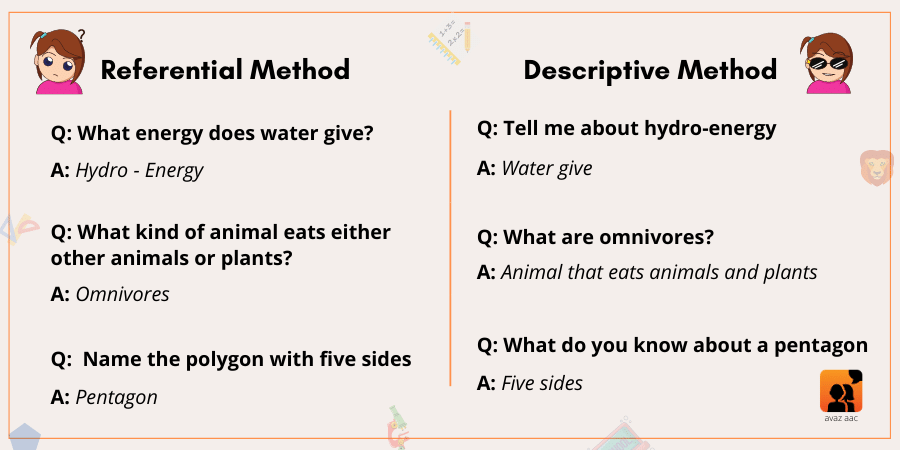
Why use Descriptive Teaching?
Imagine having to include every mathematical or scientific or geographical term that the child is learning about. It can mean an enormous amount of effort from the professional which can be well spent on helping the child gain a deeper understanding of the concept. Adding new vocabulary also means that the communicator has to remember how to navigate to the respective folder. This additional cognitive load can potentially slow down the communicator’s learning. Descriptive teaching allows children to focus on the concepts being taught rather than expending their energy on finding the right vocabulary in their AAC systems. It also allows them to interact with their peers and teachers, and take part in academic discussions in both inclusive and special education classrooms.Things to Keep in Mind for Descriptive Teaching to Work
The successful implementation of the Descriptive Teaching model would need a collaborative effort from teachers, speech language pathologists, and parents. The teachers, especially, can benefit from having a list of words programmed into a child’s AAC system and must be aware of any new words that are added. This will help them tailor their instruction and modify their questions accordingly. For example, the teacher can explain an earthquake as ‘shaking of ground’. But if they learn that the word ‘sudden’ has been newly added to the child’s AAC system, the teacher can explain it better as ‘ a sudden shaking of ground’. Earthquake: sudden shaking of ground Similarly, the teacher can explain tornadoes as ‘strong winds’. But if the child had the word ‘dangerous’ in their AAC system, the teacher can say ‘strong, dangerous winds’ and help the child get a more precise definition. Tornadoes: strong, dangerous winds Communicators with special needs may require support to keep up with their peers in schools. When teachers use the descriptive method and adapt classroom instruction, children get a chance to exhibit their competence and realize their potential.Activities to Build Receptive Language Skills in Children
Board Games
Skill: Following Directions Use fun board games which can build receptive vocabulary and teach children to follow directions. Use simple instructions according to the language level of the child. Board games targeting specific categories or word groups can help improve comprehension. For example, prepositions, action words, classroom words, etc can be taught using themed board games with the corresponding vocabulary. Click on the picture below to get a free downloadable fun board game to help children understand and follow directions:
Art and Crafts
Skill: Sequencing Teach your child to draw something simple like a flower, an apple or a stick figure. Explain the sequence of drawing and use the activity to target vocabulary related to shapes, colours, and spatial concepts. For example, draw a stick figure together with your child. As you draw, explain each step using corresponding vocabulary. Here are some examples of receptive words and concepts that can be taught during drawing. First draw a circle. Then draw a big line below the circle. Then draw a small line to the left of the big line. Then draw a small line to the right of the big line.
For example, draw a stick figure together with your child. As you draw, explain each step using corresponding vocabulary. Here are some examples of receptive words and concepts that can be taught during drawing. First draw a circle. Then draw a big line below the circle. Then draw a small line to the left of the big line. Then draw a small line to the right of the big line.Mealtime
Skill: Identifying Vocabulary Meal times can be an excellent time to build language skills. Ask children to set the table or help in serving food. Bring two forks. Put the pan in the sink Get the big orange cup Pass the carrots please You can also describe the object - function, category, size or the shape of the object. Get me something to drink water Can you pass the vegetable please? Get me something to clean the table. Give me the bigger spoon. Use everyday activities and fun games to develop the receptive language skills of children. Reading books with pictures gives an excellent opportunity to teach a lot of descriptive words and also helps in encouraging children to answer questions. Using picture recipes for cooking and playing games such as ‘I Spy’ and ‘Simon Says’ are also great ways to help children develop their language skills.How to Help Children Learn Turn Taking?
 Games and Playtime
Games and Playtime
- Mealtime
- TV Time
- Everyday Conversations
Turn Taking Strategies
Children with developmental disabilities and cognitive deficits may struggle to learn turn taking. So it’s important to give them necessary tools to acquire this skill.- Model Turn Taking
- Help Children Wait

- Vocabulary
Positive Reinforcement Examples, Strategies, and Benefits
 Positive Reinforcement vs Bribery
Positive Reinforcement vs Bribery
Positive reinforcement is a way by which we offer favourite things or activities to encourage desired behaviour in children. It can also act as an incentive for a child to learn new behaviours or skills. The main difference between positive reinforcement and bribery lies in how we reward children. For example, if we want a child to brush their teeth by themselves, we give them identified reinforcers after we see them putting in reasonable effort in the activity. The reinforcer can be set up in advance and can even be used as a visual cue to encourage the child. Bribery on the other hand may be rewards handed out while a challenging behaviour is occurring. Giving a treat to manage behaviours without a well thought out plan may be counter productive. Offering rewards prior to the task and promising valuable items or events for simple tasks can also set wrong expectations in children.Types of Positive Reinforcement
There are several types of positive reinforcers that we can offer to children depending on expected behaviour. Here are a few types with examples -- Natural/ Direct reinforcement: This type of reinforcement results naturally directly from the appropriate behavior. For example, if a child interacts with their peers in a group activity appropriately, they are more likely to be invited to participate in group activities. In this case, the child seeks attention and participation and their appropriate interaction is reinforced by the attention they get.
- Social reinforcers – This type of reinforcers are mediated by parents, teachers, other adults, or peers. It includes an expression of approval or praise when the child shows desired behaviour.
- Activity Reinforcers – This type of reinforcers encourage appropriate behaviour by offering participation in a favourite activity. Since this can provide social reinforcement from a parent, peer or an adult child would like to spend time with, this can be a great incentive. Reading with the child, doing puzzles, or play activities are some examples of activity reinforcers.
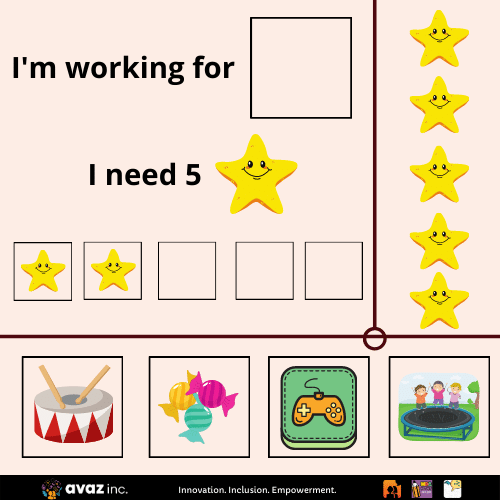 Tangible Reinforcers – This type of reinforcers are easy to set up as a visual cue if needed. it includes offering treats or child's favourite toys. These reinforcers have to used wisely since giving too may treats with an underlying health issue can become problematic. It's better to go for other form of reinforcers if they work for the child.
Tangible Reinforcers – This type of reinforcers are easy to set up as a visual cue if needed. it includes offering treats or child's favourite toys. These reinforcers have to used wisely since giving too may treats with an underlying health issue can become problematic. It's better to go for other form of reinforcers if they work for the child.
- Token Reinforcement – This type of reinforcement involves awarding tokens or points for appropriate behavior. Tokens can be used to encourage the child to work towards a larger goal. For example, if the child finishes their homework, they get a token. If the child loves video games, the child can collect tokens to earn the opportunity to play video games. Using visuals to explain how many tokens are needed for a preferred activity/item can help children understand the concept better.
Positive Reinforcement Examples
Effective reinforcers do not necessarily cost you a fortune. It's all about identifying what the child really likes - things or activities that a child wouldn't mind working hard to get. Here's a list of simple reinforcers that won't burn a hole in your pocket- Written Approval (Writing 'Well done' or 'Great job!')
- Star Stickers
- Tokens or points
- Getting to choose a movie for the whole family to watch
- Getting to choose the meal for dinner
- Staying up an hour past bedtime
- Warm hugs
- Sensory play actvities
- Getting 30 minutes additional screen time
- More play time
- Play date with a friend
- Piggyback rides (for younger children)
- More time with a pet
- No-chore day
Positive Reinforcement Tips
 There are a few things you may have to keep in mind for positive reinforcement to work. Here are a few tips to get it right-
There are a few things you may have to keep in mind for positive reinforcement to work. Here are a few tips to get it right-- Clear Definition of Expected Behaviour: It's best not to assume that you and the child will understand instructions the same way. Giving vague instructions such as 'Be nice to your friend' may just confuse the child. They may not understand what you expect them to do. Instead, say things like, "Don't grab his toy while he is playing." Use social stories and visual to explain the desired behaviours.
- Be Specific in Your Praise: Saying, "You did a wonderful job" may not be helpful. Instead try saying, "You did a wonderful job of sharing your toy with your friend while playing."
- Provide the Reinforcer Immediately: The timing of reinforcement matters. When you give a reinforcer immediately after the desired behaviour, it's more likely for the child to understand what behaviour they are receiving the reinforcer for.
- Be Earnest in Praise: Praising the child just for the sake of it may have negative effects. Children may set their bar too low or wouldn't be motivated to work harder.
- Use Reinforcers Discreetly: Using reinforcers too often can dilute the purpose of reinforcement and lead to satiation. Satiation means that the reinforcer has lost its effect and you may need to look for another reinforcer. It's also important to choose something that is motivating enough for the child. Some of new behaviours we expect children to learn may be difficult for them. The reinforcer needs to be enticing enough for them to put effort in the task.
Simple Games to develop speech and language of children with special needs
Parents and professionals across the globe seem to have embraced remote therapy, overcoming any initial hesitation or apprehensions. For children with special needs, however, it may have taken longer to get used to seeing their teachers or therpaists on their screens. It may also take a while to get accustomed to focussing on lessons with none of their peers around. Although these can be truly challenging circumstances, parents have also expressed how remote therapy has turned out to be beneficial for the family. Parents are now able to actively participate in the children’s therapy sessions which allows them to apply the strategies they learnt in everyday scenarios.
While parental involvement is a major factor towards a child's progress, the mode of learning can also play an instrumental role. Children may be more interested to learn if it was fun. This is why most therapists use games to teach social skills and academic concepts. Most of these games can be played with things lying around the house and does''t require extensive setup or planning. Here are a few such games that you can try at home for developing your child’s cognitive and literacy skills.
1. What's in the Bag?




How to Play:
- Children can reach into the bag and try to guess the item they have picked
- Encourage them to describe the item - how it feels, the size, shape, etc.
- Prompt by asking questions such as 'Is it hard or soft?'
- Children can also pick an item from the bag and find any other item in the room that belongs to the same category. For example, if they picked a pencil, they can be encouraged to find a related item such as an eraser or sharpener.
- AAC users can use communication boards or apps such as Avaz AAC app to describe the item.
2. I Spy




How to Play
- Say, 'I spy something green', or 'I see something green', and encourage the child to find a green object from the room
- Use 'I Spy' worksheets where children can be encouraged to identify animals, birds, and other categories.
- While reading a storybook, you can get the child to focus on the details of the story by pointing out to objects, facial expressions or characters in the story. For example, 'I see something round' to get to child to focus on a ball.
- You can mention shape, colour, size, and other attributes of the object to develop descriptive language
- You can also help in developing phonics by saying, 'I spy something starting with b'
3.Snakes and Ladders




This ancient Indian game can be a fun way to teach young children how to deal with disappointments and surprises in life.
How to Play
- Get a Snakes & Ladders board game, download a printable, or make your own board by drawing a 10x10 array of squares with snakes and ladders connecting a few squares
- Personalize the DIY board by including rewards and reinforcers in a few squares.
- Explain turn taking to the child by saying 'My turn' and 'Your turn' during the game. AAC users can have the relevant vocabulary included in their apps or communication boards.
- As the children roll the dice, encourage them to count the number of squares to move their tokens
- For children who understand addition, you can ask them to perform the adsition first before moving their token to the right square.
- Explain to the child how it's alright if the snake brings them down a few rows. They can always find their way back to the ned goal if they kept trying.
- You can also teach direction words such as 'up', down', left', and right' using this game.
Free Resource Download



Numeracy for Learners with Disabilities: Strategies for Teaching Maths
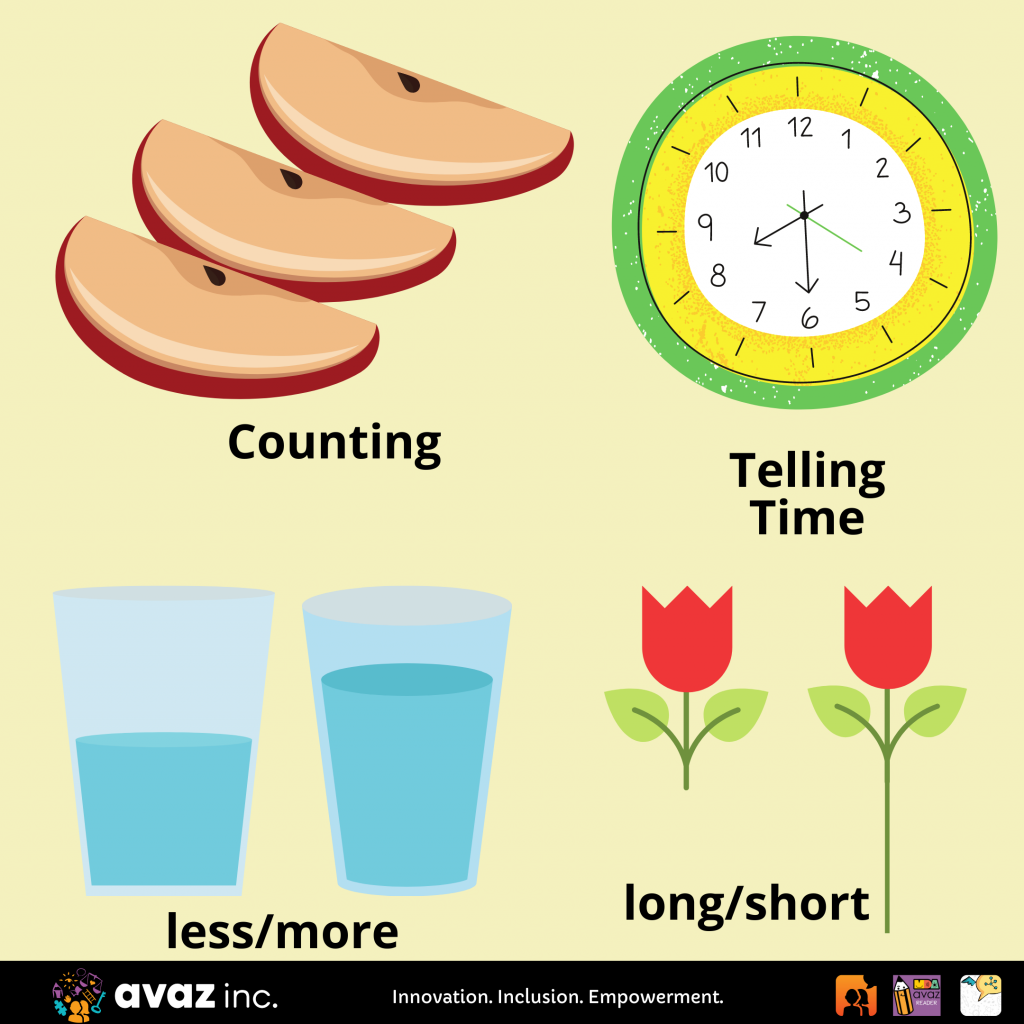
Real World Instruction
We may begin numeracy instruction for neurotypical children by teaching them to identify numbers and to count. But learners with disabilities may need a different approach since they may find it easier to understand concepts when they are connected to the real world. Hence we may need to focus on teaching functional numeracy skills through everyday scenarios. Here are a few examples:- Breakfast time:
- While Cooking:
- Craft Time:
Fun & Games
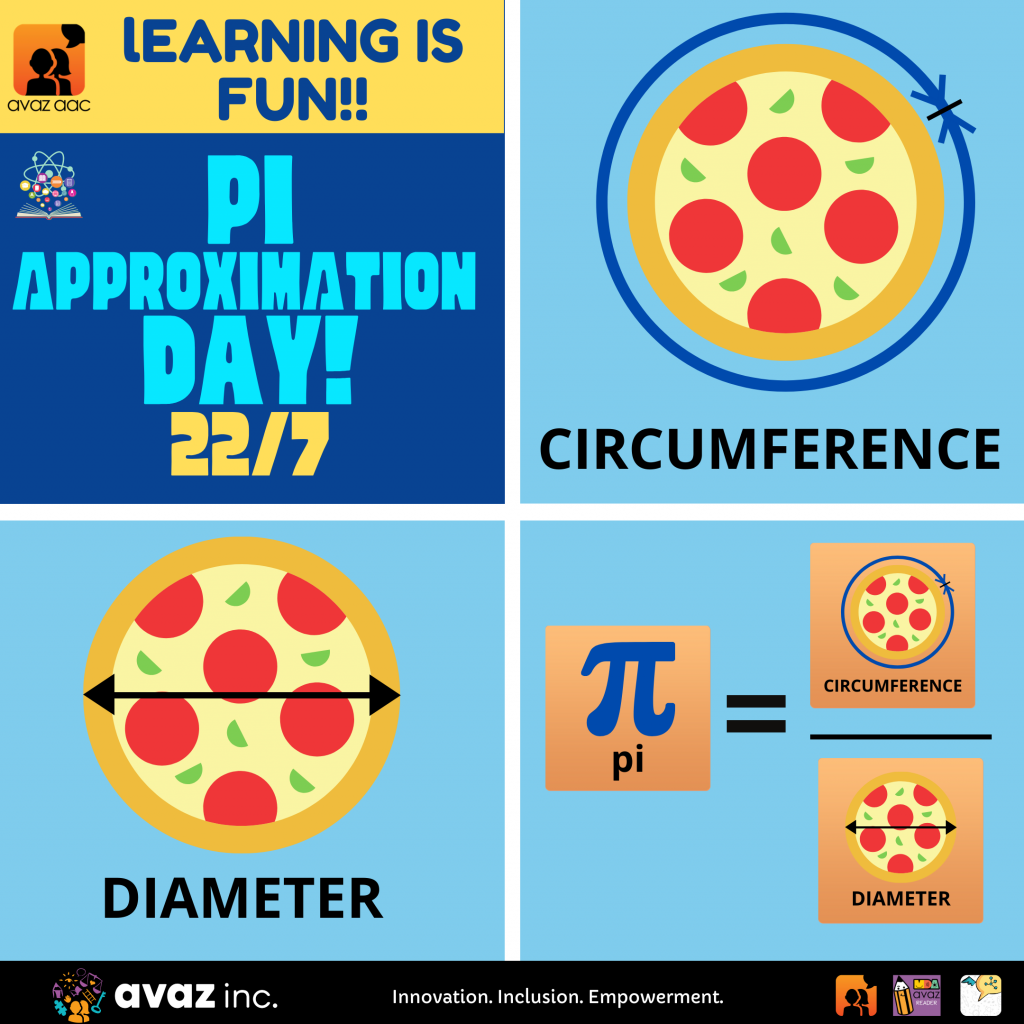 Children may learn better if concepts are taught through fun activities. It may be especially helpful if we teach using the learner’s favourite item/activity. For example, a kid who loves pizza would find learning maths to be a lot more interesting if it was taught with the pizza pie.
Children may learn better if concepts are taught through fun activities. It may be especially helpful if we teach using the learner’s favourite item/activity. For example, a kid who loves pizza would find learning maths to be a lot more interesting if it was taught with the pizza pie.- Bigger slice/ smaller slice
- Number of slices
- More sauce/less sauce
- The shape of the pizza
- The shape of the slices
- Circumference, radius, diameter, Fraction, and Pi
- How many flowers have you drawn? (counting)
- Which flower is the biggest/smallest?
- Which flower has the longest/shortest stem?
Visual Supports
Verbal instructions may be difficult to comprehend for learners with auditory processing difficulties and cognitive challenges. Using visual aids such as visual schedules and communication boards can help in teaching number concepts. Less/More and money exchange can also be explained better through pictures and worksheets. For example, the concept of time may be very abstract for learners with developmental disabilities. Visual schedules can help in explaining the concept of before, after, later, now, etc. to such learners. They’ll be able to understand that swimming is scheduled after reading and before Mealtime. Calendars are also great tools to teach time. Children who are looking forward to the premiere of their favourite TV show or the arrival of grandparents can countdown to the day they are very excited about.AAC and Math
AAC(Augmentative and Alternative Communication) can be incorporated into Math instruction so that learners with complex communication needs can understand number concepts and communicate what they know and don’t know. AAC can also help them be an active participant in an inclusive learning environment where children do group projects. The learner’s AAC system needs to have the vocabulary for numbers, measurement units, concepts of time, and money. It’s important to include mathematical terms relevant to the learner’s curriculum such as fractions, estimate, rounding, etc. Descriptive teaching model can help a great deal in explaining advanced concepts. Here's a free Math Communication board for emergent learners: Avaz Math Communication Board Hope you find these strategies useful. If you have any feedback or suggestions, please give them in the comment section below.Addressing Challenging Behaviours During Lockdown
Looking at Behaviours as Communication
Instead of identifying behavioural challenges as problems, it’s best if we understood the functions of behaviour. Here’s a table explaining what the child may be attempting to communicate through their behaviours: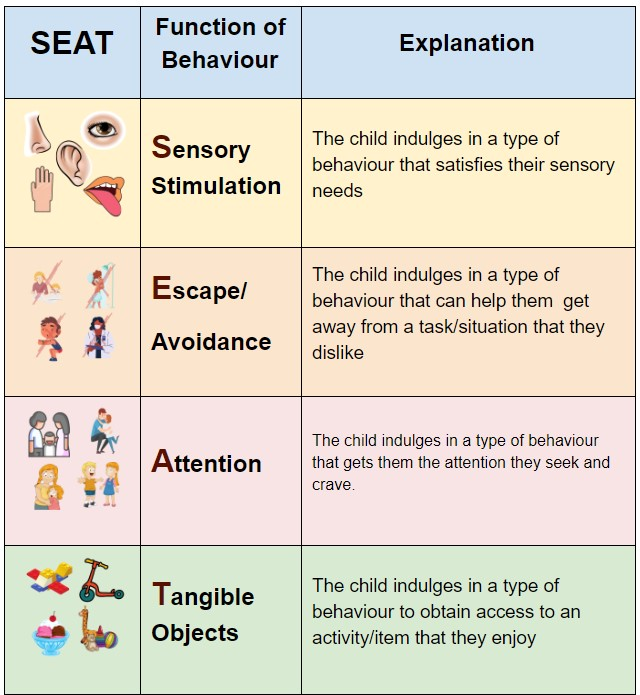
Simple Ideas to Manage Challenging Behaviours
There’s a lot we can do to prevent behavioural issues by manipulating the environment of the child. 1.Provide AAC Systems Children with complex communication needs may struggle with social communication which includes understanding of pragmatics. They may take things literally and may be unable to convey their thoughts effectively. Providing AAC(Alternative and Augmentative Communication) systems can help a great deal for such children. From low tech boards, sign language, objects of reference, to high tech robust AAC systems, children can use any communication mode with which they can make themselves understood better. Giving them the means to reject/ refuse and protest is very important. Give access to pre-store phrases or single words to communicate their disapproval or sensory issues.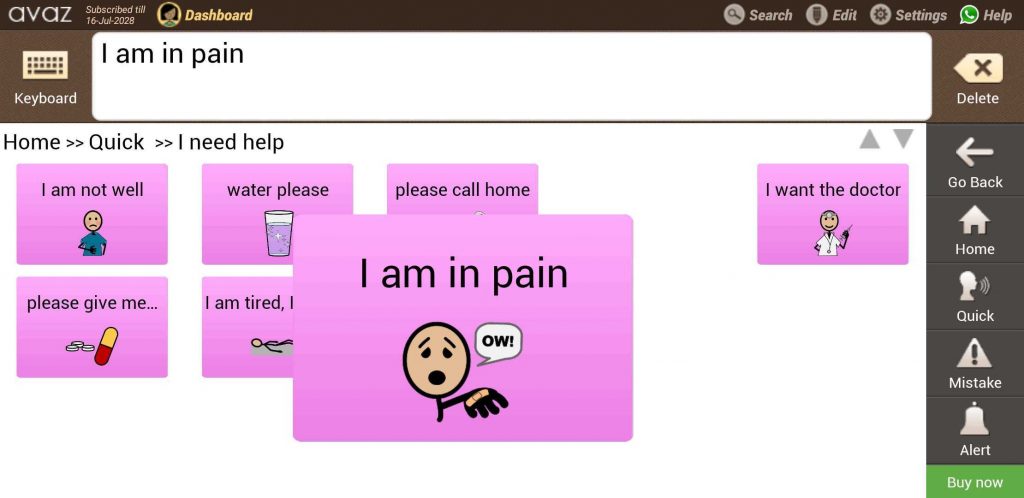 ‘Leave me alone’ ‘Go away’ ‘Stop’ ‘Not now’ ‘Don’t like it’ ‘I need a break’ ‘It’s too loud’ ‘I’m taking a walk’ ‘Want my sensory ball’ 2.Use Visual Supports Children with disabilities can understand visuals better than verbal instructions and guidelines. So, use visual schedules and cues that help them understand expected behaviour. Make sure that there’s no ambiguity on what the expected behaviour is. If you’re using social stories, keep the language simple and use relevant images. Since most children are learning from home, it may be helpful to have a designated area in the house for learning. Get the child involved in decorating the area with stickers of books and school supplies so that they associate the area with learning. 3. Discuss and Create Routines with the Child All children crave structure because it makes them feel in control. For children with disabilities, structure means predictability, which in turn means reduced anxiety about what to expect in a given day. Get the child’s inputs on how they’d like the day structured. Since learning from home can be hard, it’s ok to be a little flexible. If they can’t handle too many online sessions, a nap or a fun activity between the sessions may not be a bad idea. Make sure the family members and professionals can agree on the routine. Make room within the activity for the child to choose what they want to do. For example, if the child wanted to dance during exercise time or read their favourite book again, acknowledge their requests as much as possible. 4.Assign Chores and Give Rewards
‘Leave me alone’ ‘Go away’ ‘Stop’ ‘Not now’ ‘Don’t like it’ ‘I need a break’ ‘It’s too loud’ ‘I’m taking a walk’ ‘Want my sensory ball’ 2.Use Visual Supports Children with disabilities can understand visuals better than verbal instructions and guidelines. So, use visual schedules and cues that help them understand expected behaviour. Make sure that there’s no ambiguity on what the expected behaviour is. If you’re using social stories, keep the language simple and use relevant images. Since most children are learning from home, it may be helpful to have a designated area in the house for learning. Get the child involved in decorating the area with stickers of books and school supplies so that they associate the area with learning. 3. Discuss and Create Routines with the Child All children crave structure because it makes them feel in control. For children with disabilities, structure means predictability, which in turn means reduced anxiety about what to expect in a given day. Get the child’s inputs on how they’d like the day structured. Since learning from home can be hard, it’s ok to be a little flexible. If they can’t handle too many online sessions, a nap or a fun activity between the sessions may not be a bad idea. Make sure the family members and professionals can agree on the routine. Make room within the activity for the child to choose what they want to do. For example, if the child wanted to dance during exercise time or read their favourite book again, acknowledge their requests as much as possible. 4.Assign Chores and Give Rewards When children are productive, they feel proud of themselves. When their self-esteem grows, they may not try to seek attention through challenging behaviours. So, give children simple household chores depending on their abilities. Set them up for success by assigning simple tasks which they can complete. From setting the table to cleaning their desk, give them small responsibilities. Once they’ve successfully completed a task, praise them and offer rewards that you deem appropriate. Rewards need not be fancy or expensive. It can be your attention, your participation in an activity they enjoy, or tokens and star stickers.
When children are productive, they feel proud of themselves. When their self-esteem grows, they may not try to seek attention through challenging behaviours. So, give children simple household chores depending on their abilities. Set them up for success by assigning simple tasks which they can complete. From setting the table to cleaning their desk, give them small responsibilities. Once they’ve successfully completed a task, praise them and offer rewards that you deem appropriate. Rewards need not be fancy or expensive. It can be your attention, your participation in an activity they enjoy, or tokens and star stickers. How Avaz Made our Lives Simpler: Tanisha’s Communication Journey
 My daughter was diagnosed to be on the Autism spectrum at the age of 3 and like all special needs families, we went through the process of never ending therapies, running from one therapy centre to another. Needless to say, it was traumatic and exhausting in the beginning. However, this soon became our daily routine - juggling our time between therapists and doctor visits . After nearly 3 years of vigorous therapies, we achieved very little development in her speech and language. We could see that our daughter had potential and how badly she wanted to communicate with everybody. But being unable to communicate only led to frustration and behaviour issues. Thankfully, we got introduced to Avaz AAC app through Ms.Vandana at the Sunrise Learning Centre. And how the app has changed our lives!!! My family was instantly fascinated by the idea of an app that would enable us to communicate with our child. We were excited about the prospect of our daughter expressing her needs and feelings to us. Building Communication, Language, Life Skills, and Literacy We started with lots of pictures of all the preferred items of my daughter to build her interest. My daughter accepted Avaz wholeheartedly as she felt empowered by being able to communicate her needs by simply selecting a picture from the folder. Avaz had made communication easier for her. It was a happy moment for the entire family when Tanisha chose to communicate through images rather than crying or screaming. We proceeded to make schedules with Avaz to help manage her anxieties. The app made our lives simpler in many ways. We didn't need to carry our visual cards everywhere, as we had a system which was more practical and we could explain many things to her on the go. My husband is a Merchant Navy officer and we travelled with him on the ship. Being onboard a ship involves many challenges with frequently changing weather, variations in time zones, and long days between ports. Separation from family members for a longer duration of time only added to the emotional struggles. Avaz became a medium for us to explain what is happening around her to our daughter and why it is happening. This includes the dining etiquette, different parts of the ship, when we will reach the next port, when we will be back home, and many more things which were previously next to impossible to explain to her. [caption id="attachment_5762" align="aligncenter" width="534"]
My daughter was diagnosed to be on the Autism spectrum at the age of 3 and like all special needs families, we went through the process of never ending therapies, running from one therapy centre to another. Needless to say, it was traumatic and exhausting in the beginning. However, this soon became our daily routine - juggling our time between therapists and doctor visits . After nearly 3 years of vigorous therapies, we achieved very little development in her speech and language. We could see that our daughter had potential and how badly she wanted to communicate with everybody. But being unable to communicate only led to frustration and behaviour issues. Thankfully, we got introduced to Avaz AAC app through Ms.Vandana at the Sunrise Learning Centre. And how the app has changed our lives!!! My family was instantly fascinated by the idea of an app that would enable us to communicate with our child. We were excited about the prospect of our daughter expressing her needs and feelings to us. Building Communication, Language, Life Skills, and Literacy We started with lots of pictures of all the preferred items of my daughter to build her interest. My daughter accepted Avaz wholeheartedly as she felt empowered by being able to communicate her needs by simply selecting a picture from the folder. Avaz had made communication easier for her. It was a happy moment for the entire family when Tanisha chose to communicate through images rather than crying or screaming. We proceeded to make schedules with Avaz to help manage her anxieties. The app made our lives simpler in many ways. We didn't need to carry our visual cards everywhere, as we had a system which was more practical and we could explain many things to her on the go. My husband is a Merchant Navy officer and we travelled with him on the ship. Being onboard a ship involves many challenges with frequently changing weather, variations in time zones, and long days between ports. Separation from family members for a longer duration of time only added to the emotional struggles. Avaz became a medium for us to explain what is happening around her to our daughter and why it is happening. This includes the dining etiquette, different parts of the ship, when we will reach the next port, when we will be back home, and many more things which were previously next to impossible to explain to her. [caption id="attachment_5762" align="aligncenter" width="534"]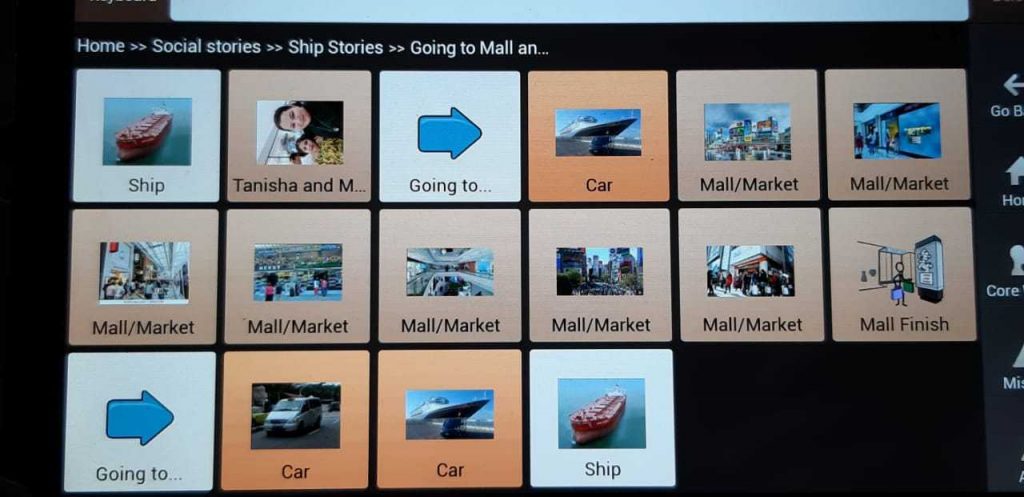 Social Story Explaining a Visit to the Mall[/caption] Avaz AAC app helped to form a bridge between our daughter and my whole family. It allowed us to use our specific customised pictures and audio modulations which helped in teaching generalization and improving comprehension. We also use Avaz to develop her life skills by focussing on ADLs. Avaz has also helped build her literacy skills because she was a good visual learner. Avaz During Lock down When lockdown happened, there were major changes in her routine. Since she can’t go to school and has minimum social interaction, Avaz has helped Tanisha to communicate with her grandparents and other family members. She tells them what food she ate, what activities she did ,and whether she liked them or not. She also tells them that she loves and misses them a lot 💜. We have been modelling, and just now Tanisha is trying to communicate better with us (still with prompt ). But it has become a little easier for us to understand where she is feeling pain and she is trying to understand what are we doing to help her. She is also sending WhatsApp messages about her health to her grandparents and Mamu (Uncle).
Social Story Explaining a Visit to the Mall[/caption] Avaz AAC app helped to form a bridge between our daughter and my whole family. It allowed us to use our specific customised pictures and audio modulations which helped in teaching generalization and improving comprehension. We also use Avaz to develop her life skills by focussing on ADLs. Avaz has also helped build her literacy skills because she was a good visual learner. Avaz During Lock down When lockdown happened, there were major changes in her routine. Since she can’t go to school and has minimum social interaction, Avaz has helped Tanisha to communicate with her grandparents and other family members. She tells them what food she ate, what activities she did ,and whether she liked them or not. She also tells them that she loves and misses them a lot 💜. We have been modelling, and just now Tanisha is trying to communicate better with us (still with prompt ). But it has become a little easier for us to understand where she is feeling pain and she is trying to understand what are we doing to help her. She is also sending WhatsApp messages about her health to her grandparents and Mamu (Uncle).  While the lock down has brought many challenges, it has also given us more time and opportunities to interact with her. We involve her in day to day activities such as deciding what meals are cooked where Tanisha uses the app to tell her choice to us. We are also using Avaz to give her a picture breakdown of steps involved in completing each task. This has helped her immensely in developing life skills. Avaz is aptly named - it has become my daughter's voice and every communication attempt is a step forward to more communication. (‘Avaz’ in Hindi means ‘Voice’ 😊) Find more Avaz AAC user stories and videos here and here. We'd love to hear more from parents about the creative ways in which they use Avaz. Sharing ideas is one way that you can help other parents stay motivated and positive. Send in your stories to support@avazapp.com or share your experiences in the comment section below.
While the lock down has brought many challenges, it has also given us more time and opportunities to interact with her. We involve her in day to day activities such as deciding what meals are cooked where Tanisha uses the app to tell her choice to us. We are also using Avaz to give her a picture breakdown of steps involved in completing each task. This has helped her immensely in developing life skills. Avaz is aptly named - it has become my daughter's voice and every communication attempt is a step forward to more communication. (‘Avaz’ in Hindi means ‘Voice’ 😊) Find more Avaz AAC user stories and videos here and here. We'd love to hear more from parents about the creative ways in which they use Avaz. Sharing ideas is one way that you can help other parents stay motivated and positive. Send in your stories to support@avazapp.com or share your experiences in the comment section below. How Play Therapy Techniques Help Children Cope with Routine Changes
 When Play Becomes Therapy Playing is probably one of the top favourite activities of most children. Apart from fun which is the obvious benefit, playing can also help children build their skills and boost self-esteem. Play therapy is a process by which children of all abilities are given tools to engage in fun activities that provide a sense of belonging and inclusion. This psychological intervention method uses play to address the physical, cognitive, emotional needs of a child. Studies have shown that play therapy can have far greater benefits with parental involvement. It can serve as a method for parents to understand the world through the child's eyes. Benefits of Play Therapy Playing can help in nurturing skills that are required for children to lead fulfilling lives. Here are some of the skills that can be developed through play:
When Play Becomes Therapy Playing is probably one of the top favourite activities of most children. Apart from fun which is the obvious benefit, playing can also help children build their skills and boost self-esteem. Play therapy is a process by which children of all abilities are given tools to engage in fun activities that provide a sense of belonging and inclusion. This psychological intervention method uses play to address the physical, cognitive, emotional needs of a child. Studies have shown that play therapy can have far greater benefits with parental involvement. It can serve as a method for parents to understand the world through the child's eyes. Benefits of Play Therapy Playing can help in nurturing skills that are required for children to lead fulfilling lives. Here are some of the skills that can be developed through play:-
 Self-expression
Self-expression - Self-regulation
- Problem Solving
- Addressing Fears
- Managing Stress
- Social Interactions
- Social Communication
- Self-dependence
- Sensory behaviours
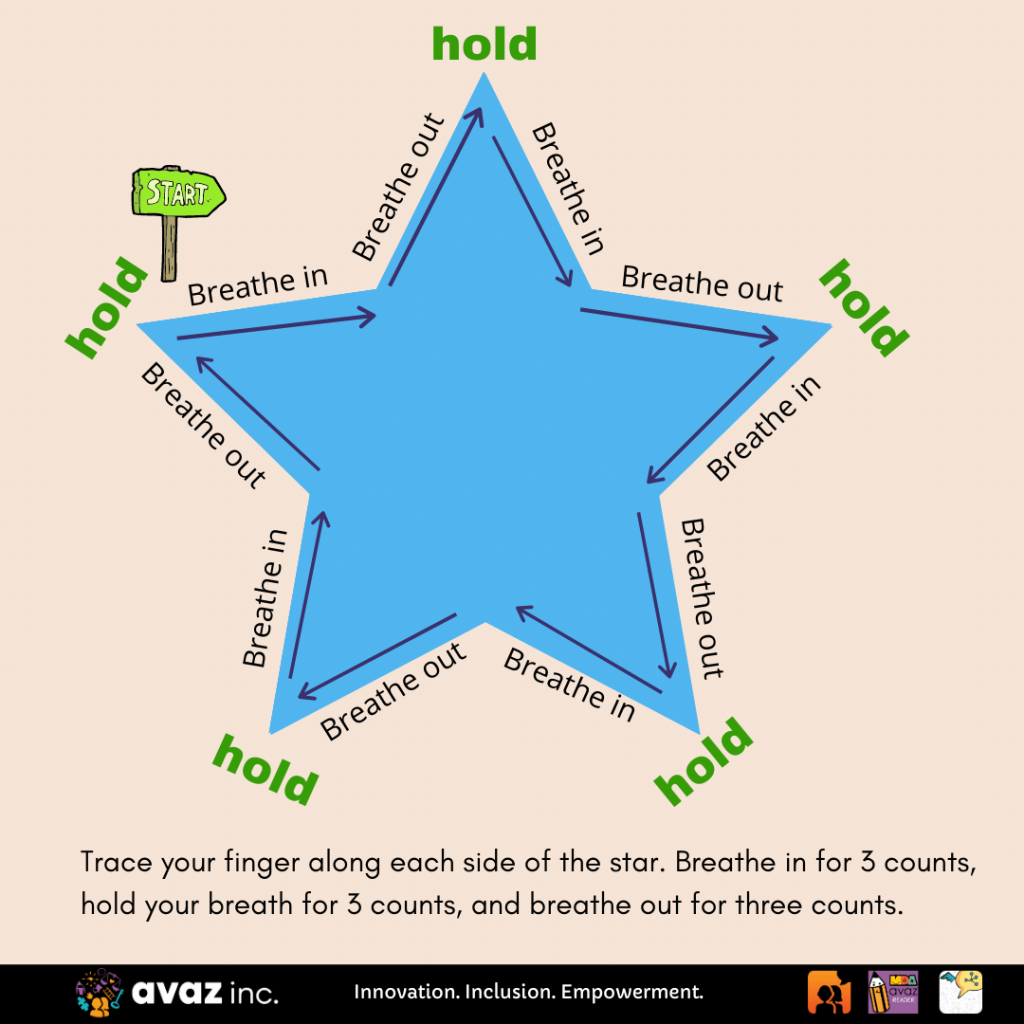 Breathing Exercises We all know that taking deep breaths can help in calming us when we face stressful situations. Young children may need help in learning how to take deep breaths when they feel stressed. One simple technique used to teach deep breathing is with shapes. As children trace these shapes, they learn to inhale, hold their breath and exhale to take deep breaths. Bubbles can also be used to teach deep breathing to children. Blowing a big bubble can help children learn how to breathe deep from the stomach and exhale slowly. Social stories can also be used to tell children how our body can relax when it gets more oxygen. This can help children understand why they feel anxiety in their bodies and that they can deep breathe to calm themselves. Hope you found these play therapy techniques useful. Please share your feedback and suggestions in the comment section below.
Breathing Exercises We all know that taking deep breaths can help in calming us when we face stressful situations. Young children may need help in learning how to take deep breaths when they feel stressed. One simple technique used to teach deep breathing is with shapes. As children trace these shapes, they learn to inhale, hold their breath and exhale to take deep breaths. Bubbles can also be used to teach deep breathing to children. Blowing a big bubble can help children learn how to breathe deep from the stomach and exhale slowly. Social stories can also be used to tell children how our body can relax when it gets more oxygen. This can help children understand why they feel anxiety in their bodies and that they can deep breathe to calm themselves. Hope you found these play therapy techniques useful. Please share your feedback and suggestions in the comment section below. 5 Simple Activities to Develop the Emotional Intelligence Skills of Learners with Disabilities
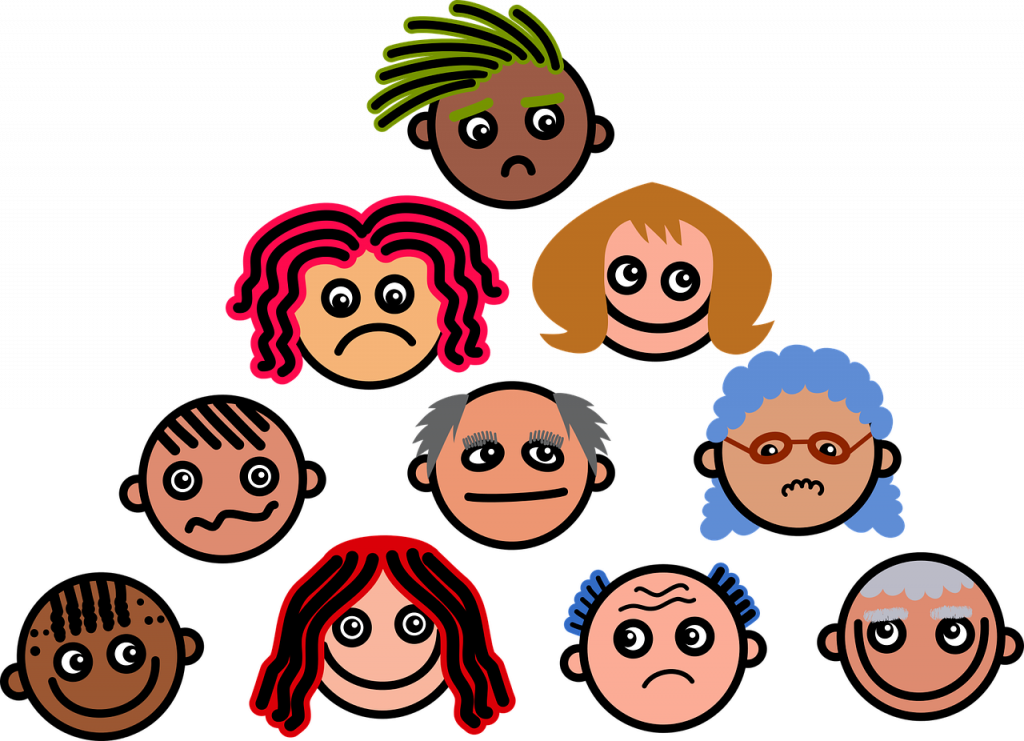 F is for Fun and Feelings
F is for Fun and Feelings
Imagine giving a lecture to young children about all the 27 distinct emotions that humans are said to have. No matter how articulate you are, chances are most children might not pick up any valuable information on how to deal with emotions. Emotions is a complex concept to teach. As distinct as many of these emotions are, they are also interconnected. So, the best way to teach emotion is through fun activities and games. Here are a few simple, interesting ideas to help children learn emotions:- Story and Movies
- Emotion Masks Game
- Personal Photo Album
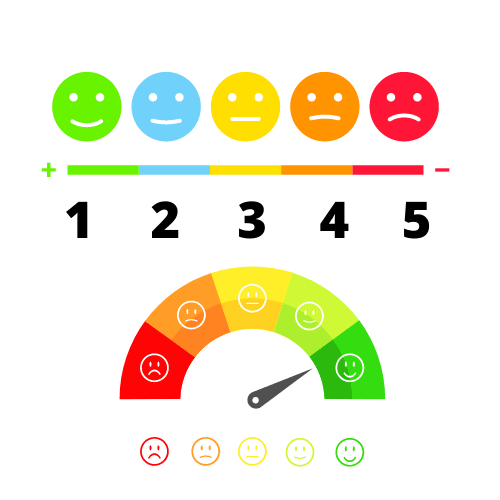 Emotions Scale/ Chart
Emotions Scale/ Chart
- Voice Recordings
Avaz AAC Resources for Teaching Emotions
Here's a story about Johnny, a little boy and his different emotions. Read the story and help the child identify the emotions. You can ask the learner to match the emotion tiles from the given Vocab Toolbox to the emotions in the book. You can also encourage them to tap the corresponding emotion icon on their AAC system.
 It's important to give communicators vocabulary to describe their emotions so that they can express their distinct feelings. Avaz AAC offers extensive vocabulary for emotions. You can download communication board for emotions here. that can help develop the emotional intelligence skills of young children.
It's important to give communicators vocabulary to describe their emotions so that they can express their distinct feelings. Avaz AAC offers extensive vocabulary for emotions. You can download communication board for emotions here. that can help develop the emotional intelligence skills of young children.Avaz’s Top 4 Accessibility Features of iOS 14
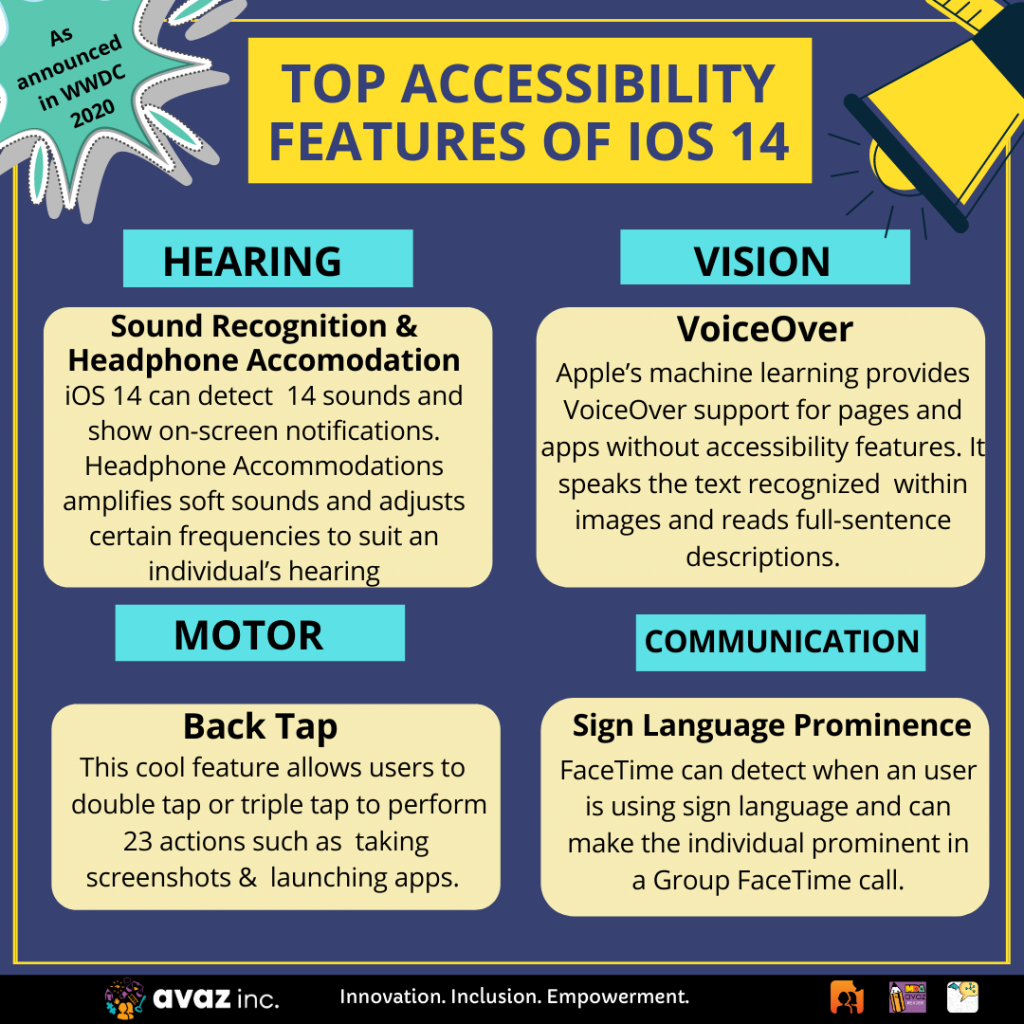 1. Sound Recognition
1. Sound Recognition
Your iPhone or iPad can now detect a sound you’ve configured it to listen for. The device's intelligence shows on-screen notification when it comes across 14 different sounds, namely, Fire Alarm, Siren, Smoke Alarm, Cat, Dog, Appliances, Car Horn, Door Bell, Door Knock, Water Running, Baby Crying, and Shouting. Whom Does it Help: People who are deaf or hard of hearing How to enable Sound Recognition - Launch Settings from your Home screen.
- Tap Accessibility.
- Tap Sound Recognition.
- Tap the Sound Recognition On/Off Switch.
2. Back Tap
This is a cool feature which allows users to perform several quick actions by tapping on the back of the iPhone. It can be used for 23 actions and users can assign separate tap gestures for the different actions. By double tapping or triple tapping, you can take screenshots, turn the volume up and down, mute, scroll, open the control center, and launch apps. Whom it Helps: People with limitations in fine motor capabilities How to Enable Back Tap:- Launch Settings
- Tap Accessibility
- Tap Touch
- Tap Back Tap
3. VoiceOver
Apple's VoiceOver that translates on-screen text into speech gets new functionalities in iOS14. Apples's on-device machine learning recognizes key elements displayed on the screen and provides VoiceOver support for pages and apps without built-in accessibility features. It speaks the text recognized within images and reads full-sentence descriptions. Whom it Helps: People with vision impairments How to Set Up Voice Over:- Launch Settings from your Home screen.
- Tap Accessibility.
- Tap VoiceOver under the Vision Category
- Tap Voiceover Switch to turn it ON
4. Headphones Accommodations
This awesome new feature amplifies soft sounds and adjusts certain frequencies to suit an individual’s hearing. There are 3 amplification settings with which you can customize settings for movies, music, phone calls, etc. Headphone Accommodations also works with Airpod Pro’s Transparency mode making quiet voices in your surroundings more audible. Whom it Helps: People who are deaf or hard of hearing How to enable Headphone Accommodations:- Launch Settings from your Home screen.
- Tap Accessibility.
- Tap Audio/Visual.
- Tap the Headphone Accommodations On/Off Switch
Using Social Stories to Explain Social Situations
Social stories are simple narratives that help people having deficits in social pragmatics understand appropriate social interaction protocols and responses. While they were originally developed for children on the spectrum, they can be useful for people of all ages having social communication challenges. Visual representation of a situation or concept as depicted in social stories can be more meaningful to people with auditory processing issues than verbal instructions. Moreover, social stories help in reinforcing concepts by repeating the information consistently.
Using social stories is an evidence-based practice created in 1991 by Carol Gray, a teacher for children with autism. They are essentially visual descriptions of a situation, event, concept, or activity. The purpose of the story is to help children understand the situation better and to teach them socially appropriate responses.
How to write social stories?
A poorly made social story can convey wrong information to a child. So, it’s necessary to put some thought into what the story is about. Here are few things to keep in mind while writing a social story.
1.Use Simple Language
Make sure that the language is uncomplicated and does not leave much to interpretation. Typically, social stories are written from the perspective of the person for whom you’re creating the story. You can also use third person language for some older kids.
- Keep it to the Point
You may want to convey a lot of information but all that cannot be cramped into one social story. If you have different events or concepts that you need to address, create individual stories for them.
- Collect All Relevant Information
Before you start writing a story, be clear about the purpose of the story. If it’s about a particular event, try and think of all the details you have about that event. For example, if you want to write a story about an upcoming birthday party, look at how the learner had reacted to such events in the past. Was there anything particular that made them uncomfortable? Was there anything that they thoroughly enjoyed? Getting all the details written down helps you build an effective story.
- Make it Visual
Use a lot of pictures and include personal pictures if possible. For example, if you are writing a story about how to organize their things in the classroom, use pictures of their desk, materials, bins where their things should be placed, etc. This can help them make the connection to the things the story is referring to.
Benefits of Using Social Stories
Children with autism and other developmental disabilities may have processing delays and may struggle with generalization of a concept. Their sensory issues or communication deficits may also lead to challenging behaviors. Verbal instructions may not be effective and therefore social stories are seen as an excellent means to give directions to children and for behavioral regulation.
Creating Social Stories Using Avaz AAC
You can use Avaz AAC to create social stories in no time. With Avaz AAC, you can bing search for images from within the app. This means that you need not search for images on the web and import it into the app. You can also add multiple words/phrases at a go. A main advantage of making stories with Avaz AAC is that there is auditory feedback as the learner taps on the icons of the AAC system. Screen recording of the social story gives you a video which you can play for the learner when needed.
Here is a sample story made with Avaz AAC.
You can find more COVID related social stories here.
Download a free editable social story for Learning from Home here.
Get the Word file and personalize it as you wish 😊
Building Language for All Communicative Functions – Greetings, Questions, and Expressing Feelings
Last week, we learnt strategies and vocabulary required for a few communicative functions such as Requesting, Refusing, and Commenting. This week, let’s see how we can build language for a few more communicative functions - namely, Greetings, Answering Questions, and Expressing Feelings. There are, of course, more communicative functions and we’ll see how we can build a communicator’s language for those purposes in future blogs.
Greetings:
Greetings are one of the fundamental components of social communication. It sets the tone for conversations and gets communicators started on making connections with others.
Strategies:
- Teach them to wave hi, give high fives, and fist bumps (or foot-taps and elbow bumps during these COVID times). You can come up with more elaborate and cooler greetings young kids are into these days to get them motivated.
- Use low tech cards with Hi, Hello, and vocabulary for other pleasantries we commonly exchange.
- Enlist a peer such as a friend or a sibling and encourage the children to greet each other.
- If the communicator has a high tech AAC system, make sure they have quick access to pres-stored phrases for greetings.
Vocabulary:
Hi, Hello, How are you, Good morning, Thank you. I’m fine
Answering Questions
Asking too many questions can make the communicator feel tested. So, we must make sure we make a lot of comments and observations too as we ask questions. It's also important to include open-ended questions to encourage the communicators to express their thoughts on any given topic.
Strategies:
- A good point to start will be questions about the communicator's favourite objects or activities.
Is this your truck?
Do you want to listen to music now?
If you are convinced that the communicator's answer to these questions will be a 'Yes', model the language by tapping 'Yes' on the AAC system. Make sure to reinforce it by granting the object/activity immediately.
Ask open-ended questions related to the communicator's favourite thing / activity.
This truck looks cool. What other toys do you like?
2. Ask questions related to pictures, storybooks, and television shows the child is interested in.
'What's the little girl eating?'
'Who gave cake to the dog?
Make a few comments before asking the questions and encourage the communicator to make inferences from what they're reading.
The mom looks mad because Jessica lied to her.
Do you think Jessica is going to be punished?
3. Involve peers and make them ask questions to each other. Children learn better when it's more fun. Have children make silly faces or make silly dance moves and then ask them to stop.
'Do you want to continue making silly faces?'
If the communicator responds, acknowledge and praise. Explain what they have conveyed to you by saying 'Yes'.
Ex'Oh..you're saying 'Yes'. So, you're saying you'd like to keep making silly faces. Sure. Go ahead'
Vocabulary:
Yes, No, Agree, Disagree, here, there, now, later, etc.
Expressing Feelings
There is a wide range of emotions and communicators should be taught to identify these distinct emotions. When children don't have the proper means to express their feelings, they may resort to challenging behaviours. It's important that we teach them to understand and label their emotions. Once they are able to recognize their emotions, they can be taught coping strategies for when they feel overwhelmed with strong emotions.
Strategies:
- Use tools such as emotion wheel and games to help children identify and label emotions.
- Talk about your emotions throughout the day. Make sure you talk about negative emotions such as your anger, disappointment etc. This will encourage the communicators to discuss their negative emotions too.
I got mad when I saw the messy table.
Talk about how you dealt with those emoti ons and tell the communicators they can do something similar too.
I just took a deep breath and listened to some music to calm myself down. Once I was calm, I requested you to help me clean the table.
3. Storybooks are great resources to discuss emotions. Talk about the emotional journey of the characters in the story. Help communicators see the correlation between an event and an emotion.
He's happy because he won the game.
She lost her teddy bear. She must be sad.
Draw the communicator's attention to facial expressions that convey the different emotions so that they can identify the emotions in people around them. This, in turn, helps them identify their own emotions.
4. It's important that AAC users have access to extensive vocabulary for the various emotions. Some children may feel sad when they don’t get to do their favourite activity while others may get mad or feel disappointed about it. Communicators should have access to quick phrases with which they can vent their feelings. Include phrases in their AAC systems for their coping mechanisms too so that they can communicate to others when they need to be left alone or that they don’t feel understood.
Get away from me
I’m going to my room
I need a break now
You’re not listening to me
I’m frustrated
Something’s bothering me
Vocabulary:
happy, sad, frustrated, excited, disappointed, funny, great, mad, etc.
Communicative Functions with Reading
Shared reading can be a great way to teach communicative functions to AAC users. As you read text, encourage the communicator to answer questions. We have put together a Language Learning Bundle with a story to encourage answering questions in emergent communicators.
How to Use the Bundle:ead Language Builder Instructions PDF given below for details on how to use this bundle. Click on the below icons to download the individual PDFs
Expressing Emotions: Ideas to Teach Young Children
When children get better at expressing emotions, their anxieties and challenging behaviours can reduce. But feelings and emotions are complex and abstract concepts which makes them difficult to teach. They are internal states of mind which need to be experienced and felt by the child, and hence becomes tricky to "teach" as concepts.
One of the simplest ways to help them understand the various emotions is by giving them exposure to different experiences When you talk about the child's emotions during the experience, it helps the child associate the emotion with that experience. This further helps them identify and understand the concept of emotions better.
Sample Situations to Teach Emotions
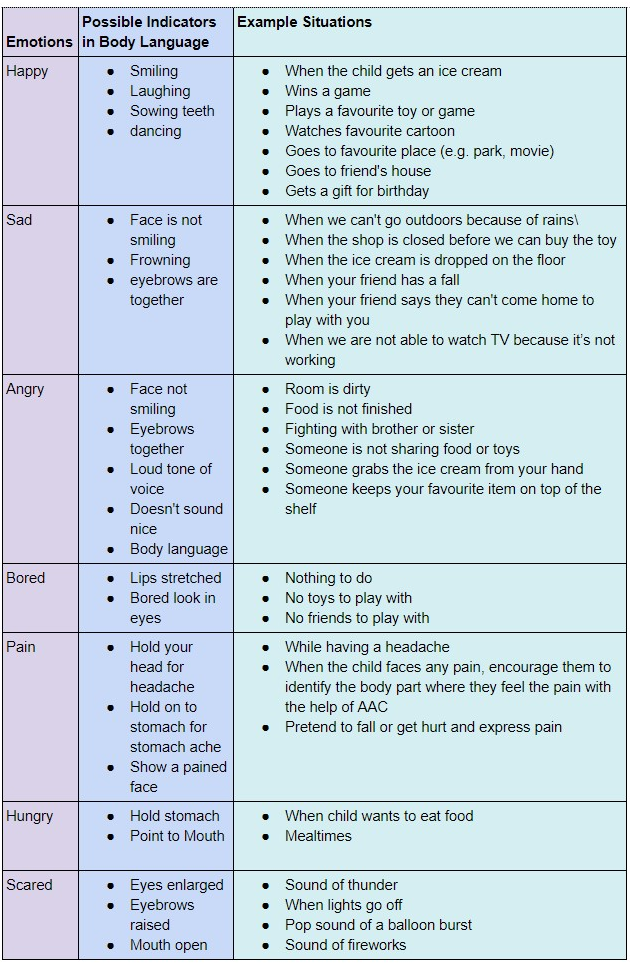
Here are a few simple ideas to teach emotions to young children:
Picture cards
Use picture cards / flash cards that you may, to talk about various emotions. Explain how these emotions are displayed.
Example: HAPPY
Show different pictures of happy faces and say "When we are happy we are smiling and laughing, and showing our teeth. When we are happy we are dancing, or singing." etc.

2. Facial gestures
Show with your own facial gestures and expressions the various emotions. Express it through your eyes (enlarged eyes for anger), eyebrows (narrowed eyebrows for anger), mouth( pouting for sadness),
3. Own photos
Take your child's photo when they are happy and smiling and explain it to them to help them associate the "feeling" with the emotion and the word.
4. Story-telling through books
Choose stories that display emotions. E.g. hare and tortoise - how the hare feels sad when losing and hare feels happy when winning.
5. Discuss emotions while watching TV shows or videos
Talk about the emotions of the characters while watching the shows together. Choose shows that display emotions.
6. Take videos
Take a video of yourself or other members of the family while they are happy - e.g. during their birthday, cake cutting, playing with friends etc.
5. Role play
During role play you can pretend to be a person who is happy for a particular reason. E.g. I am your teacher and you answered correctly in class. I am happy and clapping for you.
that you are playing the role of a person or a character in a story that has a happy event.
E.g. I am the teacher. You have finished your work! Very good, I am happy.
5. Drama
Create a story with different characters and enact a drama with emotions.
E.g. a child who has lost his dog feels sad.
6. Create more opportunities during the day to express various emotions
Model the words as you discuss the emotions
Remember not to try and teach emotions when the child is going through a meltdown. Teach these concepts when the child is in a happy and receptive state of mind. Expressing emotions can make the child feel heard and understood. It also gives them the opportunity to seek help when they experience negative emotions. So, it's an important skill to have which can pave the path to their self-expression and self-dependence.
Understanding Prompting Hierarchy
Any new learning can be quite overwhelming for the user. New users can benefit from prompting, regardless of age, communication skills, or cognitive ability. Prompts can be used to assist the user in successfully learning to perform a task - it is a method of guiding the user to give the correct response. If you don’t prompt, the user will continue an incorrect behaviour, and the motivation to learn will decrease. But it's important to understand that prompts may be difficult to fade. This is where knowledge of prompting hierarchy can be handy
What is a prompt?
A prompt is a cue or instruction that is given before or during a user's action or response. There are different types of prompts that you can use to motivate the user to learn and succeed.
What are the different types of prompts?
There are different types of prompts:
Verbal prompts, such as saying “Tap the picture of cookies!”
Gestural prompts, such as pointing to an appropriate icon on Avaz AAC app that remind them to use it.
Physical prompting. It usually includes hand under hand (which is largely recommended in literature) and that can be easily faded. Physical prompts also include taking the user’s hand and making them point to the appropriate icon. Physical prompting is less helpful and using them is not really advocated and it is extremely culturally sensitive (and it does not support safe practices that are important to protect vulnerability)
Prompting Hierarchy - Least-to-most prompting
Though prompts are very useful in teaching a new concept and working on the use of it, it is also important to use them carefully. Users become dependent on prompts easily and would seek an adult's or partner’s help before they make any type of response. Research suggests the hierarchy of least-to-most prompting as it provides the user sufficient time to respond to a natural stimulus occurring in the environment. Prompting hierarchy refers to the order and different levels of support that can be used to help the user get the appropriate responses. Remember, as you decide the type of prompts you also need to think of ways to fade prompts over time. Regardless of how often we provide prompts or what type of prompts we provide, providing a model of the possible words suitable in the conversation is considered the most useful strategy we can use.
Let us look at various prompts ranging from least intrusive to most intrusive with encouraging the user to use the word ‘GO’ to make the car go.
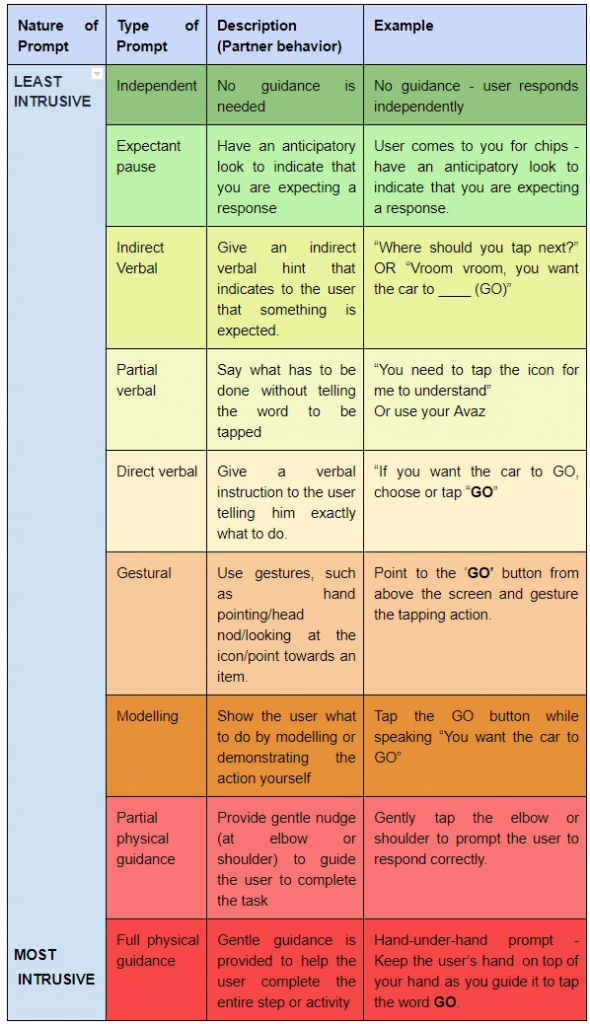
The Powerful Pause
While using each prompt, it is most important to give an expectant pause and WAIT for the user’s response. The wait time can vary from 5-15 secs for the user to produce the expected response. When you say something, wait for a response. If the user says something, respond and move on. If the user doesn’t respond, give the next prompt in the hierarchy and WAIT for the response. If you don’t use enough wait time, you may be providing more prompts than needed. Remember, rushing through prompts essentially takes away opportunities for the user to respond.

Indirect Verbal
If the user does not respond, you can give indirect verbal prompts to help them construct a response.

Some reasons for prompt dependency are:
Over-use of prompts
Helping too much or helping too soon
Failure to fade prompts
Repeated use of prompt hierarchy across all the environments and partners thus hindering independent selection of icons
Prompt fading
If the user doesn’t respond, give the next one in the prompting hierarchy and WAIT for the response. If you don’t use enough wait time, you may be providing more prompts than needed. Remember, rushing through prompts essentially takes away opportunities for the user to respond. Inappropriate prompting can result in prompt dependence, passive engagement, and of course poor use of communication tools. Hence it is very important to start fading prompts gradually but consistently so that the user doesn’t become dependent on the prompts. Start with the one that is most appropriate for the user, but regardless of the prompt used, work towards making your user independent of the prompt. Fade each type of prompt until the user is able to respond independently, without any prompts.
Courtesy: Compiled by Octave Speech and Hearing, Bangalore.
Teaching Young AAC Users to Be Aware, Sensitive, and Empowered
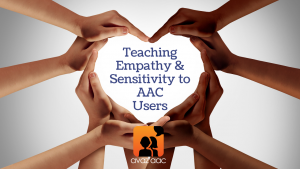 From climate change to handling of the pandemic or politics, we may all have different opinions. We may also have different ways in which we address these topics. All of them are valid as long as they come from a place of understanding. Now, more than ever, we need to seek common ground as we embrace different viewpoints. Similarly, there’s no one right way to talk about topics which may be difficult to explain to children. Here are a few simple things we can do to ensure that AAC users are in the know and are not left without a say on significant social events.
From climate change to handling of the pandemic or politics, we may all have different opinions. We may also have different ways in which we address these topics. All of them are valid as long as they come from a place of understanding. Now, more than ever, we need to seek common ground as we embrace different viewpoints. Similarly, there’s no one right way to talk about topics which may be difficult to explain to children. Here are a few simple things we can do to ensure that AAC users are in the know and are not left without a say on significant social events.Standing up for Themselves
Children must be encouraged to have their opinions and must be given ample opportunities to express them. Parents and professionals need to be mindful of giving them the space to express their opinions even if it may be inconvenient for them. Some children may not be more forthcoming with their opinions, likes, and dislikes. That does not mean they don't have one. Give sufficient visual or verbal prompts as required to help them express their views. As for vocabulary that builds agency. ‘Stop’ and ‘No’ are very powerful words that give a communicator control over their surroundings. Look for activities that the communicator is not keen on doing or antecedents for challenging behaviors. Once you can identify an activity the communicator dislikes, ask them to do the activity and tell them they could use ‘No’ to refuse the activity. Try to acknowledge and honour their refusal as much as possible. Similarly, encourage them to use ‘Stop’ during an activity if they do not want to continue doing it. Once you’ve finished playing a song during Music time, ask them if they want you to ‘stop’ or ‘play’. Model these words across different activities such as reading and playtime until they gain an understanding of how to use them in various scenarios. The communicator’s AAC system must be programmed with vocabulary that aligns with their right to express themselves freely. Include pre-stored phrases for negation such as 'Not good' 'Don't want' ‘I Don't like It' As children grow, it’s important to tailor these phrases and include more that suit their personalities. ‘I need some space’ ‘I need some time for myself’ ‘I disagree’ ‘This is not right’ ‘This is unfair’ AAC users deserve these and more vocabulary with which they can fume, disagree, raise valid questions, demand answers, and make their points loud and clear.Standing for What They Believe in
As we equip AAC users with self-advocacy skills, it’s equally important that we acknowledge their right to be part of the social discourse. Encourage social interactions from an early age and help them connect to others in the community. Their opinions on societal matters count as much as those of their peers. The world needs to hear all sides and perspectives and the voice of an AAC user should be allowed to resonate along with all other voices that are trying to bring about change. Make sure young communicators have a lot of reporting vocabulary in their AAC systems. They should be able to complain about any ill treatment meted out to them or others. We must encourage them to voice out their apprehensions about people or actions bothering them. The more we are willing to listen, the less they will be reluctant about reporting any unpleasant events.Exposure to Diversity
Read books or watch shows and movies with diverse characters. These characters can offer an excellent way to talk about different races, ethnicities, social groups, cultures, religions, customs, languages, economic backgrounds and how they have their own place in the world.Teaching Appropriate Language
Society has changed and so have the norms of acceptable language. Casual remarks that are insensitive cannot be laughed off anymore. For emergent communicators, we can overlook their language errors because our goal is to get them to communicate effectively. For young adults who seek active societal participation, we need to give appropriate vocabulary and explain why some words may be considered offensive.Talking About Current Events
There's a lot going on around the world. With the barrage of misinformation that's out there, it's important that we stick to facts while we talk to children. Choose video clips or news images carefully so as to not overwhelm them. For some older children who may have already learned about things through the news, avoiding discussion may make them feel more anxious. As you explain what’s going on, reassure them that it will be alright and attempt to answer all their questions as honestly as possible. We live in a world with race, religion, gender, and socioeconomic inequalities and talking about them to children can be extremely hard. But those are the realities of the world and what children know about them will shape their opinions, their capacity for empathy and determine their demeanour towards others. So, we owe it to our communicators to keep them abreast of the events occurring in the world. This will empower them with knowledge with which they can decide for themselves to play whatever role they choose to, in the larger society.Building Language for All Communicative Functions
 There are several reasons we communicate. Sometimes, we communicate just to get the attention of a loved one while other times we have profound things to say or a strong point to make. Communication, therefore, is the bedrock of human relationships and social interactions. In addition to fostering bonds, it also allows us to stand up for ourselves, stand for things we believe in, and thus is an important tool for self-advocacy. So, we must ensure that AAC users acquire the necessary skills for the entire range of communicative functions.
There are several reasons we communicate. Sometimes, we communicate just to get the attention of a loved one while other times we have profound things to say or a strong point to make. Communication, therefore, is the bedrock of human relationships and social interactions. In addition to fostering bonds, it also allows us to stand up for ourselves, stand for things we believe in, and thus is an important tool for self-advocacy. So, we must ensure that AAC users acquire the necessary skills for the entire range of communicative functions.
List of communicative functions
From expressing our feelings to giving or getting information, communication serves several purposes in our daily lives. Language instruction for AAC users must focus on expanding their communicative functions so that their expression is not limited. When some communicators do not know the appropriate means to communicate, they may resort to challenging behaviours to convey their emotions, needs, and wants. The key is to give them relevant vocabulary in their AAC systems and create consistent communication opportunities for the various communicative functions.
Here are some of the purposes of communication.
- Requesting
- Greeting
- Refusing/Rejecting
- Commenting
- Protesting
- Asking Questions
- Sharing Information
Let's see how we can support a communicator with these communicative functions:
Requesting
This is probably one of the most important skills for an emergent communicator to pick up because this helps them to get what they want.
Strategies:
- Identify motivators for communication. It could be the communicator’s favourite activity, toy, or food item. It’s easier to work on requests when there is a clear motivation present.
- Create an environment replete with activities and items that are communication motivators.
- Put their favourite snack in clear containers so that the communicator would request for help. Give food in a bowl without utensils. Keep their favourite blanket or hide one shoe when they are ready to go out. Make sure that the child does not get frustrated while sabotaging the environment to elicit requests.
- Acknowledge all request attempts and prompt if the communicator is unable to make an independent request.
- Their desired toy/activity acts as a natural reinforcer but a praise can only add to their excitement.
Vocabulary:
Want, Need, More, This, That, Now, Give, Eat, Hungry, Play are some words that the communicator can use along with fringe vocabulary such as toy, cookie, TV, etc.
Refusing/Rejecting
Since children with complex communication needs may be vulnerable, it’s important to ensure that they are raised with an awareness of their likes and dislikes. It’s also equally important to teach them the power of words and how they can use it to implement their right to refuse and reject.
Strategies:
- Identify activities or moments that the communicator is not excited about. This might involve a bit of guesswork. If you notice any challenging behaviours, try and see the antecedent which might give you a clue.
- Try to engage the kid in the activity and model ‘No’ or ‘don’t like’ on the communicator’s AAC system. For example, if the child seems to be not too interested in reading, model ‘I don’t want it’ . Say, “Oh, you’re saying you don’t want it. OK” and close the book.
- Make sure you are able to acknowledge their refusal while modelling the vocabulary. In case you are unable to accommodate their requests, try and negotiate as much as possible so that they feel heard.
- When they pick an item they like, help them see how they rejected others to choose their favourite item.
“Oh.. you want cookies? You don’t want cake”
Vocabulary:
stop, don’t, no, not, now, later, go, break
Commenting
This can be a complex communicative function to teach for emergent communicators. But commenting is a great skill to acquire because it helps communicators initiate and engage in meaningful conversations.
Strategies:
1.Model commenting by making a lot of comments during shared reading or watching TV together.
“This is very funny”
“The girl’s hat looks cool”
2. Give visual prompts such as commenting cards and sentence strips
3. Ask wh questions using visual prompts. Remember that verbal prompts may be useful but difficult to fade.
“What do you see”
“Where is the hare?”
4.Use play time and sensory toys to make tons of comments. Give them the slime, the play doh, and scarf and encourage them to tell you how the item feels.
Model the vocabulary on their AAC system consistently and prompt until they can utter it independently.
Vocabulary:
see, feel, taste, along with descriptive words
Communicative Functions with Reading
Shared reading can be a great way to teach communicative functions to AAC users. As you read text, draw the communicator's attention to the different things and encourage them to make comments. We have put together a LanguageLearning Bundle with a story to encourage commenting in emergent communicators.
How to Use the Bundle:
Read Language Builder Instructions PDF given below for details on how to use this bundle. Click on the below icons to download the individual PDFs
Building Literacy: Teaching Grammar to AAC Users
Autonomous communication and boundless expression are very much the primary goals of AAC. While we focus on developing communication skills, it is equally important that we lay the foundation for literacy. Since grammar is fundamental to any language, AAC users can benefit from focussed instruction that helps them gain an understanding of key grammatical structures.
Why Teach Grammar?
Why should we focus on proper language usage for AAC users? Because it is important that we set a high bar for AAC users and for what we expect them to achieve. When we respect their competence, it drives us to work towards giving the necessary support systems that enable them to meet our expectations and even go on to exceed them :) Besides, language abilities have been found to play a instrumental role in literacy. So, AAC users must be supported adequately to learn grammar so as to facilitate their literacy acquisition.
Looking at Errors as Stepping Stones
Yes, we would like AAC users to learn the right way to form sentences and use words. But the emphasis should always be on communication, especially for emergent communicators. Our quest for grammatical accuracy cannot be at the cost of an AAC user’s communication skills development. To this end, it may be best if we acknowledge and respond to all their communication attempts during the early stages of their AAC journey without worrying about grammar. Every utterance regardless of any errors should be encouraged. These errors can be recast when they are ready for it and can serve as a stepping stone to grammar learning. Once the communicator puts together two or more words, we can gradually encourage them towards grammatically correct phrases and sentences.
Correcting Without Obstructing Communication
Recasting is one of the effective strategies used for grammar instruction. A communication partner recasts by repeating the communicator's utterances and correcting the language or adding more details. This corrective feedback is not overt and is designed to keep the conversation going. Model the correct usage verbally as you tap the words on the AAC system. Here are a few ways in which you can support grammar learning in emergent communicators:
Grammar Supports in Avaz AAC
Avaz supports several language forms and provides morphology options for verb, adjective and noun forms. You can turn on the Grammar setting to turn be able to use the various morphological word forms. You can turn on the setting for the picture mode and keyboard modes independently.
- Tap the Settings icon on the top bar.
- Scroll down and tap Grammar
- Tap the Grammar option to ON.
- Then tap the modes (picture / keyboard ) for which you want to use the Grammar options.
Turning the Grammar option to OFF will turn off the setting in both the modes.
The word forms displayed for each type of word in Avaz are:
Verbs (past, past participle, present, continuous, future tense)
e.g. EAT (ate, eaten, eats, eating, will eat)
Nouns (singular, plural, possessive),
e.g. BAG (bag, bag's, bags)
Adjectives (simple, comparative, superlative)
e.g. BIG (big, bigger, biggest)
Pronouns
e.g. YOU (you, yourself, your, yours)
Learn more about it here


Grammar Learning with Shared Reading
Shared reading can be a great way to teach grammar to AAC users. As you read text, draw the communicator's attention to the different word forms and sentence structures. We have put together a Grammar Learning Bundle with a story to teach plurals for emergent communicators.
How to Use the Bundle:
Read Language Builder Instructions PDF given below for details on how to use this bundle. Click on the below icons to download the individual PDFs
Avaz AAC App: The New found Voice at Sunrise Learning
Sunrise Learning is a Center for Autism and Special Needs located in Noida, India. The center uses Avaz extensively for teaching communication strategies to their students. Since communication partner skills are important for a communicator’s AAC use, the center also focuses on training parents so that they can guide children and empower them with communication.
We are grateful to Vandana Gautam who played a pivotal role in Sunrise Learning center adopting Avaz AAC app. Thanks to her passion for implementing AAC in the center, several students with complex communication needs can express themselves better. A huge thanks to Dr. Sonali, Founder and Principal of Sunrise Learning Center for supporting the efforts of all the teachers and making it all happen. Here’s what special educators in the Center had to say about Avaz AAC and how it has enabled their students to communicate better:How it All Began
Sunrise Learning’s Avaz journey started on 4th August 2018. We had a workshop on Avaz app byNaryanan. He introduced the wonderful app to us, and it just occurred to us- Why not have such a powerful tool of communication for our students. And thus we got started.Charting the Course
Initially, it took us a lot of time and planning to make a road map. We spent a lot of time understanding the communication needs. To do this, We requested parents and class teachers to gather background information of each student along with relevant pictures. We created individualized folders for all students on the ipad, with subfolders of “family”, “things at home” “favourites” etc. When a student opened their personal folder on the ipad, they could see their family members, along with other things they could relate to. This familiarity made them happy and motivated them to use Avaz.When Students Couldn’t Wait for ‘Avaz Class’
Avaz in the Classroom
Avaz AAC was soon introduced in the classrooms or with smaller groups of students. The class teachers were instrumental in bringing AVAZ to the students by including it in everyday schedule.Smart Classes with Avaz
We converted the regular classes to “smart” classes using Apple TV. The regular walls became alive with new exciting pictures and videos and drew the attention of the students. These smart classes were different from the regular “audio-visual” classes.(that we create using the projector). These Avaz-Apple TV classes were more engaging bcause we are able to modulate the screen through the buttons on the ipad. And so students were able to enjoy the “real time action” on the wall. It’s fun, exciting, and a novel way to get their complete attention towards the activity or the concept being introduced. Once we taught them how to pay attention to the teacher and the board, we then introduced students to various concepts through Avaz. We taught them about their surroundings. Most importantly, we helped them to communicate about their needs, feelings, likes and dislikes. This step was the most crucial, in making this app a “voice” for students who are either non-verbal or less expressive. It meant a whole new world for them, and for their teachers, to discover a “new means” to express, say, ask for, request, demand and speak for themselves!!Avaz’s Role in Acquisition of Literacy and Life Skills
Avaz also helped us to teach students academics skills such as listening comprehension, reading comprehension, picture comprehension, understanding the concepts and storytelling. In fact, storytelling sessions became more interactive, and the quiz sessions became far more fun! We organized an Independence Day Quiz using Avaz and got amazing responses from the students who might not have been able to express their capabilities without Avaz. Then in 2019, we used Avaz for a “theatre play” at the 3rd Annual Function at Sunrise Learning. Earlier, other students or teachers delivered the dialogues for the non-verbal students. But with Avaz, the students delivered their dialogues themselves. It was one of the most touching and emotional moments for parents who never thought it was possible to hear their children speak dialogues in a play on the stage at a cultural event. Recently, we have been using Avaz to teach independent skills to our students. They have been working in the Sunrise Learning Shoppe, and the Sunrise Learning café, working on their own, towards independence and dignity. Now, they make tea, sandwiches using the recipes on Avaz without any other physical or verbal support. Our students are also learning self-help skills using Avaz. Few of the students are using Avaz to order food in the restaurants.Laying the Foundation for Self-Dependence
So far, it has been a great tool for the students to express their feelings and pain and helped to reduce or minimize control battles, aggressive behaviours and anxiety episodes. Reducing anxiety, in turn increases connection and bonding, thus increasing the chances of learning and development of social skills. Our next step is to gift Avaz AAC app to all our students who need a tool to communicate, express, and learn. We believe that it will boost their self-confidence and their ability to connect with the world, and lead them towards freedom from the “stigma” of being “disabled due to the inability to speak”. Once they learn to use a tool that gives them the “ability” to express themselves, (be it writing, typing, or AAC like Avaz), there is NO STOPPING THEM...!! Thank you Avaz team, for understanding the perspective of people on the autism spectrum, and creating a tool as powerful as this. Thank you, Ms Vandana Gautam for introducing this tool to the students at Sunrise Learning, and inspiring and motivating all the teachers and parents to use AAC to make it a new found “voice” for the children !! Learn more about Sunrise Learning Center at www.sunriselearning.inwww.facebook.com/sunriselearningnoida122 Hope you enjoyed reading about how AAC was used to power the communication of students with speech and langauage difficulties. If you have a story to share, please let us know in the comment section below or write to us at support@avazapp.comExpansion of Language: Supporting AAC Learner’s Progress
We often see that one of the major stumbling blocks for an emergent communicator's progress is the struggle to get past single word utterances. The simplest way to help them overcome this is by building on what they already know. And the key here is to refrain from adding too much new information.
One Step at a Time Please
This language building strategy works best if the goal set is to attain just the next step in their language development i.e, single word communicators must be encouraged to utter two-word or three-word phrases. Setting an overambitious goal can end up discouraging them and can prove to be counter productive.
There's A Method to This Expansion
By using expansion strategies, we can help communicators gradually build their sentence length. This, however, is easier said than done. Without an understanding of how best to expand language, we may just end up confusing the communicator. (Learn more about expansion and extension here.)
When then communicator says, 'TV', say, 'Want to watch TV?" and model the two words on the child's AAC system.
Saying, 'Oh, I think your favourite cartoon will be on now' or 'After you finish reading' aren't necessarily incorrect reponses. But communicators tend to pick up language skills better when we repeat the word they have uttered and add little new information.
Here's a look at how you can expand a communicator's single-word utterances:



Be Specific in Your Praise
When the communicator successfully puts together words, praise them and let them know what you're appreciating them for.
Instead of saying, " Good job", say, "Good job. You said want cookie"
"Well done. You said more cookie please"
This will ensure that the child knows clearly what they are receiving the praise for. This reinforcement will go a long way in motivating them to put more words together.
Language Builder Bundle
Here is a sample activity bundle for language building. This bundle focuses on the core word 'Want'.
Use the core word poster to reiterate the communicator's knowledge of the word 'Want'
Read the story book given to model two-word phrases to encourage the child to expand their language.
Cut Pictures from the Vocab Toolbox to make the reading fun. Cut, Play, Communicate!
Use the Gamified PDFs to help the child acquire fringe vocabulary along with core vocabulary
Refer Communication Partner Ideas for how to incorporate language building in daily activities.
How to Use the Bundle
Read Language Builder Instructions PDF given below for details on how to use this bundle. Click on the below icons to download the individual PDFs
Download all the above resources as a Language Builder Bundle here
Hope you use this Language Builder Bundle in your child's communication journey. Please share your opinions, suggestions and feedback in the comment section below or write to us at support@avazapp.com
MDA Avaz Reader: Shared Reading Made Simpler
If you are looking for a simple tool for shared reading with your child, MDA Avaz Reader is the perfect fit. It is a reading app that comes with several exciting stories that cater to different reading levels. Avaz Reader app is great tool for shared reading because it comes with a host of reading supports for each word. For emergent communicators who need visual representation, the picture hints for each word can be of great help. Syllable hint, word family hint, and comprehension tool are some features of the Avaz Reader app that can help communicators gain literacy skills.
Download a free trial of Avaz Reader for iOS I Android here to read this story.
Watch how Reader app helps children with reading
You can also take a photo of any text, be it a textbook, magazine, or storybook and read it with Avaz Reader. This means that you child gets all the reading help they want for their academic excellence too 🎓. Hope you and your family has fun reading books with Avaz Reader. Keep reading because there are more exiting books coming your way !!
Avaz User Stories and Videos
We always love to know how users across the world are using Avaz AAC app and how it helps communicators express themselves better. Seeing the impact Avaz AAC has on their lives motivates to do more and create better technology solutions. Here are a few stories and videos from Avaz AAC users who have shared snippets of their personal communication journey with us -
Language Builder Resources: Play, Learn, Communicate!
 Teaching Grammar:Plurals
Teaching Grammar:Plurals  Communicative Functions: Commenting
Communicative Functions: Commenting  Communicative Functions: Answering Questions
Communicative Functions: Answering Questions 
Avaz Joyful Reading: Resources for Shared Reading

Shared reading is a simple and delightful way to pick up language and communication skills as you take children on an exciting journey with awe-inspiring characters inhabiting fascinating worlds. Avaz Inc. has put together a joyful reading kit with resources to get you started with shared reading. Read a story together with your child and help them build vocabulary and communication skills.
Avaz Joyful Reading Kit
What's included in the kit:
- A fun children’s story in PDF format with words highlighted for modelling
- Interactions - Suggested questions and comments to encourage child’s interaction
- Printable Communication board with relevant set of core words
- Printable Communication board with story-related vocabulary
Joyful Reading with Communication Boards
Read the story eBook and model on the communications boards given in the Joyful Reading Kit. Refer Interactions PDF for suggested comments and questions to encourage interaction.

Joyful Reading with High Tech AAC Systems
Read the story eBook and model on your high tech AAC system. Refer Interactions PDF for suggested comments and questions to encourage interaction.

Getting started with Shared Reading:
Model language as you get ready to read and use the C.A.R (Comment. Ask. Read) strategy while reading. Read more about the C.A.R strategy and how to encourage interaction here.
Get your Joyful Reading Kit Here
Try Shared Reading with Reader App
Symbol and Language hints for each word just a tap away
Avaz Reader as a Schoolwork Helper: For Lessons, E-reading Worksheets, and Assignments
Schools are still struggling to get virtual classrooms right which leaves parents to figure out how to best support their children’s learning at home. As we see on social media and on news, families are finding it really difficult to make the switch to online learning. Parents of younger kids, especially, are looking for any help they can get to ensure that their children are not left behind.
 Be it Science lessons, Social Studies Assignments, or Math word Problems - reading comprehension is the key to acing all these academic tasks. Avaz Reader is a reading app with which a child can learn to read independently with minimal support from parents. Plus, it is a perfect complement to online learning and the virtual classroom setup.
Be it Science lessons, Social Studies Assignments, or Math word Problems - reading comprehension is the key to acing all these academic tasks. Avaz Reader is a reading app with which a child can learn to read independently with minimal support from parents. Plus, it is a perfect complement to online learning and the virtual classroom setup.What’s possible with Reader?
Got that reading comprehension worksheet that your child needs to work on or the science lesson on Eyes and Ears that they need to read? Learning is all about reading and understanding what one reads. Typically, teachers read to children and re-read text at school so that children can get familiar with the vocabulary. Schools employ shared reading and guided reading strategies to help children develop their reading skills. With inadequate support from teachers due to virtual classrooms, young children may find it difficult to read on their own. Avaz Reader has several reading supports which help them develop their reading vocabulary, phonological awareness, fluency, and comprehension.Download a free trial of Avaz Reader for iOS I Android here.
Auto-Read Take a photo of the assignment worksheet or a screenshot of the ereading worksheet and import it into Reader. You can also import any text in Pdf format. The app reads the text aloud and this supports learners who comprehend better when they listen to information. Word Hints As the child reads text, there are a wide range of hints available for each word. Just tap on any word and the app provides several hints that make reading easier for young children. These hints include Syllable hint, Picture Hint, Pronunciation hint, Word family hint, etc. Comprehension Tool The comprehension tool highlights different parts of the sentence so that the child does not miss any key information. This helps children pay attention to every detail of the text, thus ensuring better comprehension. Focus Mode Children who get overwhelmed by long passages can benefit from Focus Mode which helps them read one line of the text at a time. Finger Tracking The pencil icon on the reading page which can be dragged with the help of a finger shows all the words they’ve already read. If your child is prone to skipping words as they read, then the finger tracking tool can be a great help. Apart from these awesome reading supports, Reader also has several cool and interesting stories for children to read and we are adding more books every week. Get Avaz Reader today and help children discover the joy of reading. Hope Avaz Reader serves as a reading buddy for your child guiding them whether they are reading for school or for pleasure.
Comprehension Tool The comprehension tool highlights different parts of the sentence so that the child does not miss any key information. This helps children pay attention to every detail of the text, thus ensuring better comprehension. Focus Mode Children who get overwhelmed by long passages can benefit from Focus Mode which helps them read one line of the text at a time. Finger Tracking The pencil icon on the reading page which can be dragged with the help of a finger shows all the words they’ve already read. If your child is prone to skipping words as they read, then the finger tracking tool can be a great help. Apart from these awesome reading supports, Reader also has several cool and interesting stories for children to read and we are adding more books every week. Get Avaz Reader today and help children discover the joy of reading. Hope Avaz Reader serves as a reading buddy for your child guiding them whether they are reading for school or for pleasure. Smart Games AAC users can Play with Digital Assistants
Memory Tic Tac Toe
Command: Alexa, Tic Tac Toe This classic game of noughts and crosses can be played from memory. While older children can play this game without pen and paper, younger children may need a little help for them to remember the positions. AAC users will need the vocabulary for all the 9 positions of the game programmed into their AAC system.True or False
Command: Alexa, True or False This is an exciting game for kids to test their knowledge about the world by answering either "true" or "false". This game has a multiplayer mode which means that the whole family can play too.Rock Paper
Command: Hey Google, Talk to Rock Paper This rock-paper-scissors-lizard-Spock game which can be played both with Google Home and Google Assistant on phones is an expansion on the traditional Rock, Paper, Scissors game. AAC users will need vocabulary for all the variables such as Scissors, Paper, Rock, Lizard, and Spock added in their AAC system.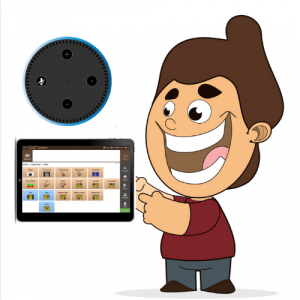 Connect 4
Connect 4
Command: Alexa, Play Connect 4 Kids can enjoy playing the game "Connect-Four" against Alexa. If you don’t have Echo Show and Echo Spot, play with an actual Connect 4 set or open the website https://calcbox.de to see the game board. Customize your child’s AAC system to include the commands 'Start a new game' and 'I throw into slot #' for this game. After you have made your move, Alexa makes her move and awaits your next move as an answer.Animal sounds
Command: Hey Google, Talk to Animal Sounds How does a fox sound? What about the hippo? This is a wonderful game or those curious minds who wonder about animal sounds. Make sure to include the above mentioned command in the child’s AAC system to start playing this game.Yucky sound
Command: Alexa, Open Yucky Sound Does your child have a huge laugh hearing fart and burp sounds? Then this is just the right game for them 😆 Some commands to include in the AAC system are: Open Yucky Sound, Burp sound, and Suprise me.Fart noises
Command: Hey Google, Talk to Fart Noises Google Home and Google assistant don’t shy away from giving us the best silly fart noises. Include the above mentioned command in your child’s AAC system and let your child have fun listening to some big ones and some nasty ones. 🤣🤣 Games with smart assistants can motivate AAC use in emergent communicators and they are also an excellent way to teach the core words, Stop, More, Yes, and No. Asking the smart assistant to ask for more of a game or stop a game, or answering Yes/No if they wish to continue a game teaches children the power of these core words and how they can manipulate their environment by mastering these words.Find more AAC Resources including free printables here.
Core Word Ideas
 Download a high resolution pdf here: AAC Everyday - Core Word ON Core Word: IN
Download a high resolution pdf here: AAC Everyday - Core Word ON Core Word: IN  Download a high resolution pdf here: AAC Everyday - Core Word IN Core Words: STOP, MORE, GO
Download a high resolution pdf here: AAC Everyday - Core Word IN Core Words: STOP, MORE, GO  Download a high resolution pdf here: AAC Everyday - Core Word STOP MORE GO Core Word: WANT
Download a high resolution pdf here: AAC Everyday - Core Word STOP MORE GO Core Word: WANT  Download a high resolution pdf here: AAC Everyday - Core Word - WANT Language Builder Bundle for Core Word WANT
Download a high resolution pdf here: AAC Everyday - Core Word - WANT Language Builder Bundle for Core Word WANT  Download the bundle here.
Download the bundle here.Convert Any Book into Audiobook: Supporting Your Child’s Learning During School Closures
 Remote Learning Struggles Studies suggest that virtual classrooms can affect the performance of students. This means that kids may have to work harder to get good grades - Lots and lots of reading and spending more time with homework. Reading Proficiency Facts One in five children in England cannot read well by the age of 11 67% of fourth-grade students may not read proficiently at their grade level The English reading proficiency of children in countries where English is not a native language is much lower. The key thing to note is that low reading comprehension levels affect more than just the scores in the English test. Link between Reading and Science/Math The connection between Math/Science and English proficiency may sound far-fetched but studies suggest otherwise. Reading levels and comprehension may have a much larger impact on a child’s academic performance and knowledge than we think.
Remote Learning Struggles Studies suggest that virtual classrooms can affect the performance of students. This means that kids may have to work harder to get good grades - Lots and lots of reading and spending more time with homework. Reading Proficiency Facts One in five children in England cannot read well by the age of 11 67% of fourth-grade students may not read proficiently at their grade level The English reading proficiency of children in countries where English is not a native language is much lower. The key thing to note is that low reading comprehension levels affect more than just the scores in the English test. Link between Reading and Science/Math The connection between Math/Science and English proficiency may sound far-fetched but studies suggest otherwise. Reading levels and comprehension may have a much larger impact on a child’s academic performance and knowledge than we think.  Audiobook as a Solution for More Reading Practice? Experts say that children may comprehend text better with audiobooks. Audiobooks are said to help a child improve their fluency and build their vocabulary. The increased fluency may encourage them to read for longer. It also can influence their choice of books with greater chances of them choosing books with high-level words. Audiobooks are said to cater to the learning styles of average to high-achieving students too, helping them to read beyond their own level. Make Your Own Audiobook with Avaz Reader Use any age-appropriate text, be it worksheets, textbooks, storybooks, or magazines. Forget about special PDFs or web resources. Add a page by simply capturing an image with text in it. Just take a clear picture of the text and have the Reader app read it to you!
Audiobook as a Solution for More Reading Practice? Experts say that children may comprehend text better with audiobooks. Audiobooks are said to help a child improve their fluency and build their vocabulary. The increased fluency may encourage them to read for longer. It also can influence their choice of books with greater chances of them choosing books with high-level words. Audiobooks are said to cater to the learning styles of average to high-achieving students too, helping them to read beyond their own level. Make Your Own Audiobook with Avaz Reader Use any age-appropriate text, be it worksheets, textbooks, storybooks, or magazines. Forget about special PDFs or web resources. Add a page by simply capturing an image with text in it. Just take a clear picture of the text and have the Reader app read it to you! 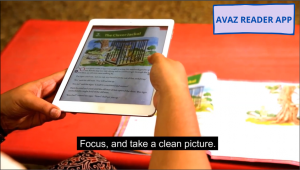 You can change the voice accent, speed, font size and more in Settings.
You can change the voice accent, speed, font size and more in Settings. 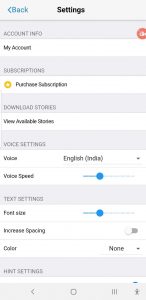
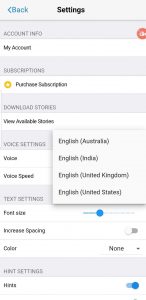 There are also a host of reading supports readily available so children can read independently. Reading Supports Available: Download a free trial of Avaz Reader for iOS I Android here. Hope Avaz Reader serves as a reading buddy for your child guiding them whether they are reading for school or for pleasure.
There are also a host of reading supports readily available so children can read independently. Reading Supports Available: Download a free trial of Avaz Reader for iOS I Android here. Hope Avaz Reader serves as a reading buddy for your child guiding them whether they are reading for school or for pleasure. AAC Everyday: Reflecting on the Day with AAC
Download this resource as a PDF here: Recap Your Day with AAC
We are all still adjusting to the new realities although it's been a few weeks now since most of us have been staying at home. Discussing the day’s plans with your child at the beginning of the day prepares them for the various activities. But in times like these, our well-crafted plans may go for a toss and that’s okay. Taking some time to discuss how the day went gives a great opportunity to get your child’s inputs on how they’d like to structure their day. Isn’t this a wonderful way to encourage AAC use and choice-making as you get insights on how to plan the next day?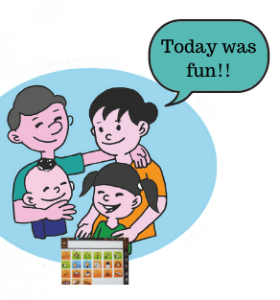 Peaks and Pits of the Day
Peaks and Pits of the Day
This ritual highly recommended by experts involves families discussing the highs and lows of each day. This helps in reassessing goals and priorities. Praise your child for all their completed tasks. This reinforcement motivates them to do better. Talk to them about things they need to work on. Giving specific instructions gives them clarity on what they are expected to do. List all the things you are grateful for and encourage your child to do so too. Talk a little about things that are going on around the world and how several people are working hard to keep us safe. Encourage your child to talk about their emotions. A good way to do that is to talk about your own emotions. There are going to be good and bad days. Discuss how we can deal with negative emotions and reassure them that you will support them when they’re having a rough time. Allow your child to decide how they want to schedule their favourite activities during the day. This gives them a sense of control and power and helps them with decision-making skills. Be ready to be flexible and try to accommodate their requests. You can use the ‘First-Then” method to tell them if they finished a certain activity first, then they can have their way with their favourite activity. Conversation Ideas
Children may find it difficult to recall how the day went or may struggle to communicate it to you. You can start by talking about the peaks and pits of your day. I’m going to start with the best part of my day. I was glad I could complete my project on time. I was annoyed to see the mess on the table. Once you’ve discussed your day, you can encourage your child to talk about theirs. Give them prompts if needed and remind them of the activities they did during the day. If you have a planner or a visual schedule that your child follows, seeing it may help children recall what they did during the day. Do you think today was fun? What activity did you enjoy the most? The mermaid book used to be my favourite too. If your child has not completed an activity, give them a chance to explain why. Hear them out before telling them why you expect them to complete the activity and how you can help them with it. You did not do exercise today. Would you like to dance during exercise time?
I’m going to start with the best part of my day. I was glad I could complete my project on time. I was annoyed to see the mess on the table. Once you’ve discussed your day, you can encourage your child to talk about theirs. Give them prompts if needed and remind them of the activities they did during the day. If you have a planner or a visual schedule that your child follows, seeing it may help children recall what they did during the day. Do you think today was fun? What activity did you enjoy the most? The mermaid book used to be my favourite too. If your child has not completed an activity, give them a chance to explain why. Hear them out before telling them why you expect them to complete the activity and how you can help them with it. You did not do exercise today. Would you like to dance during exercise time?Core words
 Here are a few core words you can model during your daily reflections with the family:
Here are a few core words you can model during your daily reflections with the family:- Let’s talk about the best parts of today
- I liked the game we played
- Your brother was upset
- What didn’t you like about the movie?
- You did a great job!
- Thanks for helping me clean
- Would you like more playtime tomorrow?
- You finished all your homework
- Grandma was happy to talk to you
- Let’s play the game again tomorrow
Communicative Functions
 For emergent communicators, AAC is often used only for questions or requesting. Here’s a range of communicative functions you can use AAC for while discussing the good and the not-so-good parts of the day:
For emergent communicators, AAC is often used only for questions or requesting. Here’s a range of communicative functions you can use AAC for while discussing the good and the not-so-good parts of the day:- Question: Did you enjoy reading the book about aliens?
- Comment: I love Taco Tuesdays
- Describe: The weather has been lovely today
- Instruct: Let’s talk about the good stuff first
- Request information: What game would you like to play tomorrow?
- Express feelings: I was upset when my computer stopped working
- Joke: Do you know why our dog loved today? Because he thought it was ‘CHEWS’ day 🤣 🤣
Find more AAC ideas and activities here.
Storytime with Avaz Reader
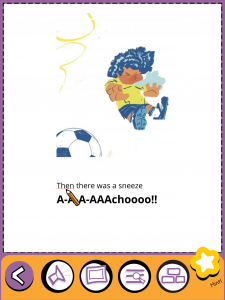 Here’s the host of reading supports your child gets while reading this story. 1.Picture Hint 2.Syllable Hint 3.Prefix/Suffix Hint 4.Rhyming Hint 5.Pronounciation Hint 6.Audio Hint 7.Comprehension Tool 8.Focus Mode 9.Finger Tracking [gallery size="medium" ids="5109,5112,5113"] [gallery size="medium" ids="5114,5108,5115"] [gallery size="medium" ids="5118,5117,5116"] You can also take a photo of any text, be it a textbook, magazine, or storybook and read it with Avaz Reader. This means that you child gets all the reading help they want for their academic excellence too 🎓. Hope you and your family has fun reading books with Avaz Reader. Keep reading because there are more exiting books coming your way !!
Here’s the host of reading supports your child gets while reading this story. 1.Picture Hint 2.Syllable Hint 3.Prefix/Suffix Hint 4.Rhyming Hint 5.Pronounciation Hint 6.Audio Hint 7.Comprehension Tool 8.Focus Mode 9.Finger Tracking [gallery size="medium" ids="5109,5112,5113"] [gallery size="medium" ids="5114,5108,5115"] [gallery size="medium" ids="5118,5117,5116"] You can also take a photo of any text, be it a textbook, magazine, or storybook and read it with Avaz Reader. This means that you child gets all the reading help they want for their academic excellence too 🎓. Hope you and your family has fun reading books with Avaz Reader. Keep reading because there are more exiting books coming your way !! AAC Everyday: Strengthening Bonds Through Family Anecdotes and AAC
Download this resource as a PDF here: Family Anecdotes and AAC
Every family has its share of stories - silly stories of mom and her cousins playing together as children, or sentimental stories of grandma making pancakes for dad and his siblings. Some of the most delicious recipes, family traditions, and impressive skills get passed on to future generations through these stories. With school closures and lockdowns, let's use this opportunity to share these anecdotes with children. And to support our AAC user's learning, let's model away as we tell them these exciting anecdotes. 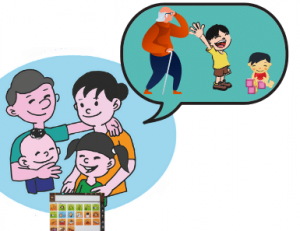 Down the Memory Lane with AAC
Down the Memory Lane with AAC
- Take your family album out to make the storytelling more visual.
- Play a game encouraging your child to identify family members in the photos. This can be a fun game to play with siblings where you can keep score of who can identify more people.
- Connect the anecdote back to your child's life. Ask questions about what they would have done or how they would have felt if in a similar situation.
- Since family stories are replete with myriad emotions and sentiments, this can be a wonderful opportunity to discuss feelings. You can also discuss human relationships, the social bonds we form, and how they are important to lead a fulfilling life.
- Video call a family member or a friend who's part of the anecdote and show them how heartwarming and emotionally uplifting social interactions can be
Conversation Ideas
- I loved flying kites with my friends.
- I used to be excited about breakfast at Grandma's place.
- Grandma's chocolate chip pancakes were the best.
- Let's make pancakes tomorrow.
- This pink dress was my favourite.
- What's your favourite outfit?
- Don't I look just like you in this photo?
- This was the friend who sat next to me in middle school.
- Is your friend nice to you?
Core Words

- This is my brother's friend.
- He works as a nurse now.
- He helps sick people get well.
- No. That's not me
- Look at Grandpa with his dog.
- That's my mom's painting on the wall
- I stopped watching scary movies after that.
- I kept my marbles under my bed.
- She had the same rag doll
- I had an amazing time at the barn.
Communicative Functions
For emergent communicators, AAC is often used only for questions or requesting. Here’s a range of communicative functions you can use AAC for while cooking together:- Comment: The prank was fun!
- Describe: I had a big red toy car
- Instruct: Be gentle while turning the pages of the album
- Request information: What colour is your toy car?
- Express feelings: I was sad when we moved out of that house.
- Joke: I asked my dad if he knew what a solar eclipse was. He said, "No sun" 🤣 🤣
You can find more AAC ideas and activities here.
COVID-19 RESOURCES
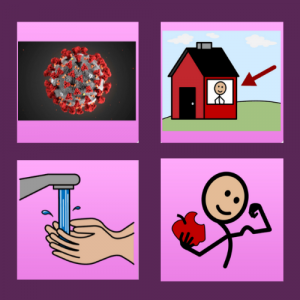 Resources for Parents
Resources for Parents 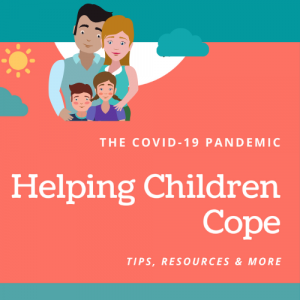 AAC Resources
AAC Resources 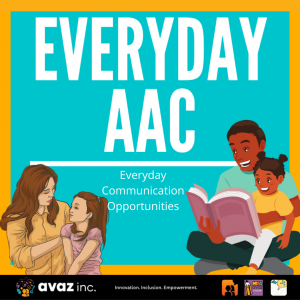
Teletherapy with Avaz
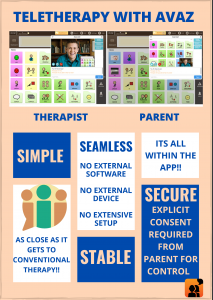 Learn more about Avaz Live, a seamless and simple solution for remote therapy With stay-at home and lockdown orders extended, remote therapy is the need of the hour. Avaz AAC has an inbuilt solution for teletherapy through which a therapist can model language, tweak settings, and demonstrate AAC strategies Lear more about Avaz Live here.
Learn more about Avaz Live, a seamless and simple solution for remote therapy With stay-at home and lockdown orders extended, remote therapy is the need of the hour. Avaz AAC has an inbuilt solution for teletherapy through which a therapist can model language, tweak settings, and demonstrate AAC strategies Lear more about Avaz Live here. AAC and Exercise: A Fun Way to Model and get the Family Fit
Download this AAC activity as a PDF here: AAC Everyday_ Exercise
No playgrounds, no gym time, no playing with friends. Without their regular dose of physical activities, kids are likely to channel their energies elsewhere. This can spell disaster and create quite a ruckus in the house if they don't have structured activities to satiate their adrenaline cravings. Exercise not only engages kids but can also lift your spirits up as it’s a great stress buster. Think you don't have enough time with the additional responsibilities you've been taking on due to school closures? How about making exercise a family activity? Even better, how about using exercise time to communicate and model language using AAC? This way, you're getting two of your important goals for the day met at the same time. 👍Say Hello to Your New Instructor
Break down the exercise time into mini workout sessions and let your child lead the family in one of those sessions. Create a separate folder in your high tech AAC system and include icons for the individual routines such as jumping jacks, bear crawl, skipping etc.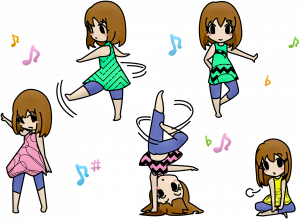 For example, if your child is great at hula hooping, let them take control of that session and get you all spinning the hoop. You can include phrases in their AAC system that allows them to dictate what you do. Spin faster Spin clockwise Talk to them about what other things they would want the family to do with the hoop. Spin two hoops Remember to pay heed to their orders and give it your best shot even if you can't find a way to keep the hoops from falling to the floor 😂 If your little one is into dance, then let them take charge and teach you a few awesome moves. Choose the soundtrack they would like the family to work out to. What music would you like? This BTS song sounds interesting
For example, if your child is great at hula hooping, let them take control of that session and get you all spinning the hoop. You can include phrases in their AAC system that allows them to dictate what you do. Spin faster Spin clockwise Talk to them about what other things they would want the family to do with the hoop. Spin two hoops Remember to pay heed to their orders and give it your best shot even if you can't find a way to keep the hoops from falling to the floor 😂 If your little one is into dance, then let them take charge and teach you a few awesome moves. Choose the soundtrack they would like the family to work out to. What music would you like? This BTS song sounds interestingConversation Ideas
 Build the conversation from your child's individual interests. Can you jump as high as I do? Who is your favourite dancer? Remember, I used to walk in the mornings with your mom everyday? It's fun working out with you and your sister We must do this everyday This is so much better than working out at the gym. Doing exercise everyday keeps you healthy What activities did you do during gym at school? Did you like gym class? You are an amazing dancer Do you want to take dance lessons? I can look for a few online lessons for you.
Build the conversation from your child's individual interests. Can you jump as high as I do? Who is your favourite dancer? Remember, I used to walk in the mornings with your mom everyday? It's fun working out with you and your sister We must do this everyday This is so much better than working out at the gym. Doing exercise everyday keeps you healthy What activities did you do during gym at school? Did you like gym class? You are an amazing dancer Do you want to take dance lessons? I can look for a few online lessons for you.Core words
Here are a list of core words that can be modelled during this activity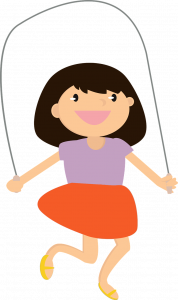 Arms up over the shoulder Arms down Breathe in Breathe out Can you do this five more times? Want to do the plank again? Now lift the other leg up Do you want to stop now? I'm going to do jumping jacks five times Would you like to rest for a few minutes ? I can feel my heart beating fast
Arms up over the shoulder Arms down Breathe in Breathe out Can you do this five more times? Want to do the plank again? Now lift the other leg up Do you want to stop now? I'm going to do jumping jacks five times Would you like to rest for a few minutes ? I can feel my heart beating fast Communicative Functions
For emergent communicators, AAC is often used only for questions or requesting. Here’s a range of communicative functions you can use AAC for while doing exercise together:- Comment: Dancing is fun!
- Describe: Your skipping rope is pink. I have a blue skipping rope
- Instruct: Don't bend your knees
- Request information: How long did you do the plank for?
- Express feelings: I feel relaxed after the workout
- Joke: You know why the line works out? To get in shape 🤣 🤣
COVID-19 Social Stories
A Delicious Way to Continue AAC Learning During Lockdown
Download this activity as a snippet in PDF
If you are concerned about your child's AAC learning losing momentum due to missed therapy sessions, worry not. There's a lot you can do at home to aid their AAC learning. Kitchen, especially can be a great place to practice AAC conversations with your child. Get them into the kitchen and you'd be surprised to see how much they can help. And there are conversations galore to be had and tons of modelling opportunities. Let’s not forget the yummy meal that makes it way to the table in the process.Choice Making with a Chef Hat on
Discuss the menu with children. Give them the power to choose what they want to cook with you. What can we make for dinner today? Model on their AAC system and encourage the child to come up with suggestions. Remember to wait for a few seconds for their response.
 Do you want to help make lasagna, rice, or something else? Keep the question open-ended. They may just blow your mind with a choice of dish that you didn’t see coming. What vegetables do you think will go well with the pasta? Raid the fridge with them so that they can look at the vegetables and make the decision.
Do you want to help make lasagna, rice, or something else? Keep the question open-ended. They may just blow your mind with a choice of dish that you didn’t see coming. What vegetables do you think will go well with the pasta? Raid the fridge with them so that they can look at the vegetables and make the decision.Conversation Ideas:
This can lead to many interesting conversations. Here are a sample sentences you could say: Oh..Zucchini. I love grilled Zucchini salad. Great choice (A little compliment that puts a smile on their face 😊)
Oh..Zucchini. I love grilled Zucchini salad. Great choice (A little compliment that puts a smile on their face 😊)
- Grandma makes amazing Zucchini fritters. We should make them some day.
- Grandma is a very good cook. You love her pancakes, don’t you?
- This Zucchini is green. Let me get some yellow zucchini. Look, this one is yellow.
- Look, the green zucchini is longer than the yellow zucchini.
Core Words While Cooking
If you're looking for low tech core boards, you can find them here.
It’s not a family activity unless you keep communicating, right? Once you've decided on what to cook, you can model throughout the activity.
- I'm going to turn the stove ON
- We need to add more water.
- The water isn't hot yet. We need to wait longer.
- I'm going to close the pot.
- Open the fridge.
- Keep the bowl on the counter.
- I'm putting the rice in the pot.
- Get some butter from the fridge.
- Let's stop stirring.
- Let's start chopping the vegetables.
Communicative Functions
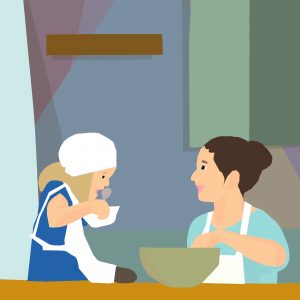 For emergent communicators, AAC is often used only for questions or requesting. Here’s a range of communicative functions you can use AAC for while cooking together:
For emergent communicators, AAC is often used only for questions or requesting. Here’s a range of communicative functions you can use AAC for while cooking together:- Question: Can you wash these herbs, please?
- Comment: This pan is too hot.
- Describe: These crisps are yummy
- Instruct: Peel the garlic carefully
- Request information: How many cups of water did you pour?
- Express feelings: This tastes delicious. I’m excited for dad to try this
- Joke: Look. The onion got the cut but I’m the one crying. 🤣 🤣
AAC Everyday: Communication Opportunities in Everyday Life
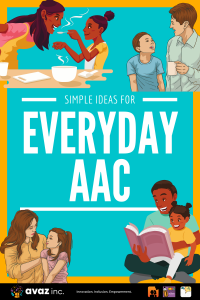 It's like the world has come to a standstill due to the lockdown across the globe. But we can't let this affect the AAC learning of children. Now is when they need to communicate more than ever. To let their fears be known. To convey their irritability and frustrations due to the change in routines. Or for those little ones who like to see the brighter side of things to tell you how much they're enjoying spending time with family. For AAC users, the lack of access to their regular therapy sessions can stall their progress. The last thing we want is for an user who was picking up key AAC skills to lose their way due to inconsistent AAC use. We need to find ways to get them to use AAC. The advice to keep communicating and modelling still holds true. But with parents having to work from home and taking care of children staying indoors all day, they may be at a loss on how to continue the AAC learning. So what if AAC use can be incorporated into daily activities? There are many simple and effective ways to do just that. We are putting together a few ideas for you. New ideas added every week! So here goes - [caption id="attachment_4822" align="alignleft" width="225"]
It's like the world has come to a standstill due to the lockdown across the globe. But we can't let this affect the AAC learning of children. Now is when they need to communicate more than ever. To let their fears be known. To convey their irritability and frustrations due to the change in routines. Or for those little ones who like to see the brighter side of things to tell you how much they're enjoying spending time with family. For AAC users, the lack of access to their regular therapy sessions can stall their progress. The last thing we want is for an user who was picking up key AAC skills to lose their way due to inconsistent AAC use. We need to find ways to get them to use AAC. The advice to keep communicating and modelling still holds true. But with parents having to work from home and taking care of children staying indoors all day, they may be at a loss on how to continue the AAC learning. So what if AAC use can be incorporated into daily activities? There are many simple and effective ways to do just that. We are putting together a few ideas for you. New ideas added every week! So here goes - [caption id="attachment_4822" align="alignleft" width="225"] AAC in the Kitchen[/caption] [caption id="attachment_5010" align="alignleft" width="225"]
AAC in the Kitchen[/caption] [caption id="attachment_5010" align="alignleft" width="225"]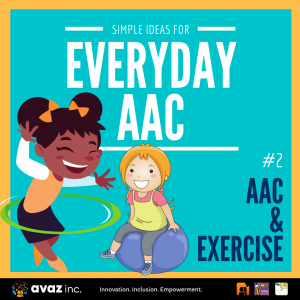 AAC During Exercise[/caption] [caption id="attachment_5122" align="alignnone" width="225"]
AAC During Exercise[/caption] [caption id="attachment_5122" align="alignnone" width="225"]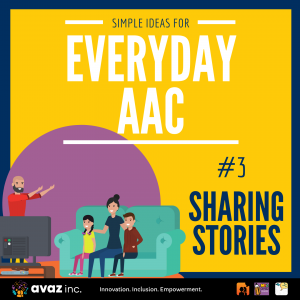 AAC and Anecdotes[/caption] [caption id="attachment_5143" align="alignleft" width="225"]
AAC and Anecdotes[/caption] [caption id="attachment_5143" align="alignleft" width="225"]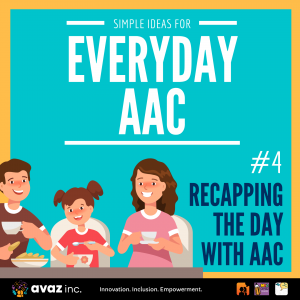 Daily Reflections with AAC[/caption]
Daily Reflections with AAC[/caption] Self-Care: Put Your Oxygen Mask On First Before Caring for Loved Ones
 Children are staying home due to school closures and it can be overwhelming for parents having to take on the multiple roles of a teacher, AAC specialist, and occupational therapist in addition to their domestic duties. For those working from home, it can be a tough balancing act to take care of their professional commitments as well. While so many things may seem to demand your immediate attention at once, It’s important to prioritize self-care. Don’t Beat Yourself Up You don’t have to be perfect at handling the additional responsibilities that’ve been piled on you due to the lockdown. It’s okay to feel clueless about what to do to keep your child’s AAC progress going. Remember that there are others in the same boat as you and there is no reason to feel guilt for not doing enough. Reach Out to the Community You’d be surprised how much you can learn from the experiences of other AAC families. Not to forget the wealth of resources so generously shared on social media by the best AAC experts. Connect to them via facebook and Whatsapp groups, or other social media platforms. A small tip, a visual schedule they use, or a fun activity they do can give you ideas of how to engage your kids. Include ‘Me Time’ in Your Schedule Yes. You need to plan and carve out a time out of your busy schedule for self-care. This may be in the early morning when the rest of the family is asleep, where you sip a cup of steaming coffee all by yourself. Or some time during the day where you chat with your old time friends cracking silly jokes. Don’t underestimate what a few minutes of ‘me time’ can do for your emotional and mental health. AAC is Communication Aided Language Stimulation, Prompting, Core word, Fringe word - Don’t let these terminologies bog you down. Yes, there are best practices for modelling and strategies that’ll better serve the AAC learning of your child. But, the key is to keep communicating. From breakfast time to homework time, make it a point to include the AAC system while communicating to your child. Just by communicating using AAC any chance you get, you are aiding your child’s AAC progress in a big way. Get the Family Involved Do yourself a favour and delegate a few household responsibilities to other family members. Children get responsibilities too. Household chores can be a great way to teach them discipline and work ethic. The toddler putting away their toys in their toy box is one less job for you to do. Assign simple tasks to children and appreciate them once they complete them. Nothing like a sense of accomplishment to motivate young children to do a task. Music and Games All work and no play makes everyone dull 😩 Make your daily routines exciting by playing some music in the background. Doing the dishes may seem a little less exhausting with your favourite musician serenading you. Family time can be spent playing fun board games, dancing together to funky tunes, or singing karaoke. If you are looking for exciting games to play with AAC, you can find them here. Remember that that it's not what you do, it's You that means most to your family. So, makes sense to invest your time and energy in some self-love 💖
Children are staying home due to school closures and it can be overwhelming for parents having to take on the multiple roles of a teacher, AAC specialist, and occupational therapist in addition to their domestic duties. For those working from home, it can be a tough balancing act to take care of their professional commitments as well. While so many things may seem to demand your immediate attention at once, It’s important to prioritize self-care. Don’t Beat Yourself Up You don’t have to be perfect at handling the additional responsibilities that’ve been piled on you due to the lockdown. It’s okay to feel clueless about what to do to keep your child’s AAC progress going. Remember that there are others in the same boat as you and there is no reason to feel guilt for not doing enough. Reach Out to the Community You’d be surprised how much you can learn from the experiences of other AAC families. Not to forget the wealth of resources so generously shared on social media by the best AAC experts. Connect to them via facebook and Whatsapp groups, or other social media platforms. A small tip, a visual schedule they use, or a fun activity they do can give you ideas of how to engage your kids. Include ‘Me Time’ in Your Schedule Yes. You need to plan and carve out a time out of your busy schedule for self-care. This may be in the early morning when the rest of the family is asleep, where you sip a cup of steaming coffee all by yourself. Or some time during the day where you chat with your old time friends cracking silly jokes. Don’t underestimate what a few minutes of ‘me time’ can do for your emotional and mental health. AAC is Communication Aided Language Stimulation, Prompting, Core word, Fringe word - Don’t let these terminologies bog you down. Yes, there are best practices for modelling and strategies that’ll better serve the AAC learning of your child. But, the key is to keep communicating. From breakfast time to homework time, make it a point to include the AAC system while communicating to your child. Just by communicating using AAC any chance you get, you are aiding your child’s AAC progress in a big way. Get the Family Involved Do yourself a favour and delegate a few household responsibilities to other family members. Children get responsibilities too. Household chores can be a great way to teach them discipline and work ethic. The toddler putting away their toys in their toy box is one less job for you to do. Assign simple tasks to children and appreciate them once they complete them. Nothing like a sense of accomplishment to motivate young children to do a task. Music and Games All work and no play makes everyone dull 😩 Make your daily routines exciting by playing some music in the background. Doing the dishes may seem a little less exhausting with your favourite musician serenading you. Family time can be spent playing fun board games, dancing together to funky tunes, or singing karaoke. If you are looking for exciting games to play with AAC, you can find them here. Remember that that it's not what you do, it's You that means most to your family. So, makes sense to invest your time and energy in some self-love 💖 News Today – Discussing News with AAC Users
This Avaz News book can be downloaded as a PDF here: News Today: Discussing News with AAC Users
 The primary focus of AAC learning is generally on teaching language and communication skills. But AAC users deserve more. They have a right to know what's going on in the world much like we do. Discussing everyday news using AAC is a great way for them to become aware of the happenings around the globe. It is also an excellent way for them to get introduced to complex concepts including emotional intelligence, economics, science, and more. Here’s a piece of news we can discuss with AAC users: The fabulous job that doctors and healthcare workers are doing world over in the fight against COVID 19.
The primary focus of AAC learning is generally on teaching language and communication skills. But AAC users deserve more. They have a right to know what's going on in the world much like we do. Discussing everyday news using AAC is a great way for them to become aware of the happenings around the globe. It is also an excellent way for them to get introduced to complex concepts including emotional intelligence, economics, science, and more. Here’s a piece of news we can discuss with AAC users: The fabulous job that doctors and healthcare workers are doing world over in the fight against COVID 19.- Start by talking to them about how Coronavirus is making many people sick (Make sure not to overwhelm them by giving too many details)
- Reassure them that there is no need to worry as long as we stay indoors
- Ask them - If everyone is staying home, who's taking care of sick people?
- Time to explain the selfless work of doctors and medical professionals
- About how they are leaving their homes to care for others -> This can lead to a conversation about empathy and the value of caring for others
- Tell them how sick people become ok because of them -> Help them see the rewards of empathy and hard work
- Encourage them to express gratitude for the doctors -> Help them appreciate the efforts of people around them such as family members and friends too.
- Lead by example by saluting the work of the amazing medical professionals -> Demonstrate your appreciation by applauding or saluting the healthcare workers. Children may find it easier to follow if they saw you doing it.
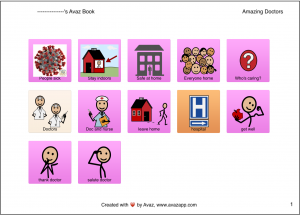
What to say
- Corona virus is making many people sick
- No need to worry as long as we stay indoors
- We are safe when we stay home
- Everyone is staying home
- But who's taking care of sick people
- It’s the doctors who are caring for the sick
- Doctors and healthcare workers are being selfless
- They are leaving their homes
- They are helping for sick in hospitals
- Sick people get well because of them
- We should thank the doctors
- A big salute to the amazing doctors
You can download this News book with larger images as PDF here. Avaz News Book_Amazing DoctorsAvaz Inc. salutes the wonderful doctors and medical professionals. We vow to honour your efforts by following your advice and safety guidelines.
10 Cerebral Palsy Facts and Myths You Must Know
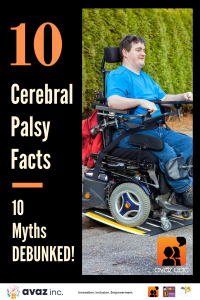 Cerebral Palsy is the most common motor disability of childhood. People with CP can have varying levels of symptoms and difficulties. There is a lot of misinformation about CP that dictates the society’s perception of the condition. Here are 10 myths and the corresponding Cerebral Palsy facts that people need to be aware of-
Cerebral Palsy is the most common motor disability of childhood. People with CP can have varying levels of symptoms and difficulties. There is a lot of misinformation about CP that dictates the society’s perception of the condition. Here are 10 myths and the corresponding Cerebral Palsy facts that people need to be aware of-- Myth: CP is caused only by brain injuries at birth
- Myth: Premature births cause CP
- Myth: Everyone with CP has some degree of intellectual disability
- Myth: People with CP cannot communicate
- Myth: People with CP generally have a short life.
- Myth: Children with CP have poor quality of life
- Myth: CP is hereditary
- Myth: People with CP will not be able to walk.
- Myth: CP will get worse with age
- Myth: People with CP cannot lead independent lives
How Reading Apps Help Children with Learning
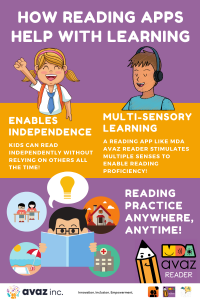 Geography is Jessica's favourite subject in school. Her teacher has asked the class to read the chapter on landforms and is preparing a quizlet on the same. As she is reading, she comes across the sentence, 'A strait is a narrow waterway that connects two larger bodies of water'. Jessica can't get past the word 'strait' as she is clueless on what to make of it. She doesn't want to skip the word lest the word should appear on the quiz. She looks up at her friends and they seem to be absorbed with the book. She thinks momentarily about asking the teacher, who is still busy composing the quiz, for help. But she refrains from doing so. The rest of the class seems to have no problem reading the word and she doesn't want to be seen as dumb. She stares at the word again frantically trying to harness her mental energies into figuring out that word. She wishes her brother were there because he was the one who helped her at home with her reading tasks. He would've read it aloud to her. He would've broken down the syllables and taught her how to pronounce the word. Jessica's anxiety builds. She's got an A+ on all subjects and doesn't want to fail the Geography quiz just because she can't decode a six letter word. Several children like Jessica suffer due to their reading difficulties and are made to feel inadequate. Although they are perfectly capable of excelling at school, they are constantly battling their struggles to keep up with their peers. Without appropriate intervention strategies, they may have to work harder to prove themselves and this puts a tremendous emotional and psychological strain on them.
Geography is Jessica's favourite subject in school. Her teacher has asked the class to read the chapter on landforms and is preparing a quizlet on the same. As she is reading, she comes across the sentence, 'A strait is a narrow waterway that connects two larger bodies of water'. Jessica can't get past the word 'strait' as she is clueless on what to make of it. She doesn't want to skip the word lest the word should appear on the quiz. She looks up at her friends and they seem to be absorbed with the book. She thinks momentarily about asking the teacher, who is still busy composing the quiz, for help. But she refrains from doing so. The rest of the class seems to have no problem reading the word and she doesn't want to be seen as dumb. She stares at the word again frantically trying to harness her mental energies into figuring out that word. She wishes her brother were there because he was the one who helped her at home with her reading tasks. He would've read it aloud to her. He would've broken down the syllables and taught her how to pronounce the word. Jessica's anxiety builds. She's got an A+ on all subjects and doesn't want to fail the Geography quiz just because she can't decode a six letter word. Several children like Jessica suffer due to their reading difficulties and are made to feel inadequate. Although they are perfectly capable of excelling at school, they are constantly battling their struggles to keep up with their peers. Without appropriate intervention strategies, they may have to work harder to prove themselves and this puts a tremendous emotional and psychological strain on them.How Reading Apps Help
Let's see how Jessica could’ve aced her Geography quiz with reading apps such as MDA Avaz Reader: Any written text including textbooks, worksheets, magazines, storybooks, newspapers etc can be read with MDA Avaz Reader. Just take a clear photo of the text to be read and you get a variety of supports readily available. Once Jessica taps the word ‘strait’ in MDA Avaz Reader, she can access the following hints: [caption id="attachment_4664" align="alignleft" width="250"] Picture Hint[/caption] [caption id="attachment_4666" align="aligncenter" width="250"]
Picture Hint[/caption] [caption id="attachment_4666" align="aligncenter" width="250"] Pronunciation hint[/caption] [caption id="attachment_4667" align="alignleft" width="250"]
Pronunciation hint[/caption] [caption id="attachment_4667" align="alignleft" width="250"] Syllable Blend Hint[/caption] [caption id="attachment_4665" align="aligncenter" width="250"]
Syllable Blend Hint[/caption] [caption id="attachment_4665" align="aligncenter" width="250"] Syllable Hint[/caption]
Syllable Hint[/caption] The Role of Reading Apps
Conventional reading intervention strategies do an excellent job in preparing the child to overcome their reading challenges. However, the child may not have access to such resources all the time and this can limit their progress. Reading apps can not only complement existing intervention methods but can also serve as a way to ensure that consistent support is available to those who need them. Here are a few ways in which assistive technology offers reading support to children: Independence This is probably the foremost benefit of having a reading app. The child no longer has to wait for someone to help them with a word. If they want to read the latest ‘Diary of a Wimpy Kid’ book, they need not put it off until a parent or teacher can assist them. This ability to read without having to rely on others gives them independence and helps them become more proficient readers. Multisensory Learning Children learn to read and spell better if multisensory techniques are employed in the classroom. They also tend to retain more information when a more engaging and fun approach is taken during instruction. Reading apps provide picture and audio hints providing stimulation for all kinds of learners. Reading Practice With the 24×7 support reading apps provide, children can read at school, at home, while waiting at the dentist’s or while on vacation, and grow their love for reading. Since the app serves as a reading buddy, children do not need to expend their energy in decoding each word. This encourages them to read more! Further, experts suggest that reading volume can significantly influence reading fluency and comprehension.Shared Reading and Literacy for AAC Users
MDA Avaz Reader is a reading app that offers several reading supports for emergent readers. The Auto-Read feature of the app reads the stories aloud and the speed and the accent of the voice can be customized for each learner. More importantly, MDA Avaz Reader has several reading supports including symbol hint which can help AAC users learn words and build language skills during shared reading. [caption id="attachment_4897" align="alignleft" width="273"]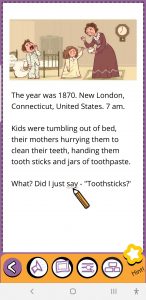 Tap on the word you want to model[/caption] [caption id="attachment_4896" align="aligncenter" width="271"]
Tap on the word you want to model[/caption] [caption id="attachment_4896" align="aligncenter" width="271"]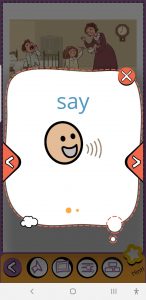 Picture hint[/caption] When you tap on any word that you want to model, a picture hint shows up. The visual reinforcement can help AAC users easily make the connection between the words in their AAC system and the words in the stories. There are picture hints for the several fringe words too which make it a stimulating reading experience for AAC users. The pencil icon that tracks the word being read can also help the learner focus on that particular word. As children read more, they are likely to pick up key skills that are vital for their literacy. You can also add any PDF or take a photo of a storybook that the child got as a gift or any magazine they enjoy reading. Many children fall behind in school or literacy because they get stuck at words they are not familiar with. This hugely limits their growth and academic performance. A reading app can make a world of difference in enabling children to overcome their reading challenges and to realize their full potential.
Picture hint[/caption] When you tap on any word that you want to model, a picture hint shows up. The visual reinforcement can help AAC users easily make the connection between the words in their AAC system and the words in the stories. There are picture hints for the several fringe words too which make it a stimulating reading experience for AAC users. The pencil icon that tracks the word being read can also help the learner focus on that particular word. As children read more, they are likely to pick up key skills that are vital for their literacy. You can also add any PDF or take a photo of a storybook that the child got as a gift or any magazine they enjoy reading. Many children fall behind in school or literacy because they get stuck at words they are not familiar with. This hugely limits their growth and academic performance. A reading app can make a world of difference in enabling children to overcome their reading challenges and to realize their full potential. Avaz AAC Android: Exciting News About Updates
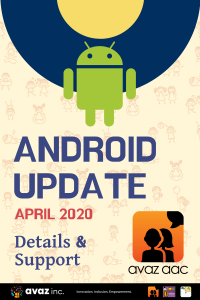 Hello Avaz AAC family! Hope you are healthy and staying safe. These are difficult times, more so for people with special needs. We’re glad to bring some cheer amidst the uncertainty around us. We’re coming up with an update for Avaz AAC Android with awesome features that give you an improved user experience. Here’s what’s included in our latest update:
Hello Avaz AAC family! Hope you are healthy and staying safe. These are difficult times, more so for people with special needs. We’re glad to bring some cheer amidst the uncertainty around us. We’re coming up with an update for Avaz AAC Android with awesome features that give you an improved user experience. Here’s what’s included in our latest update:New Voices, More Voices:
Avaz Avaz AAC is all about giving a voice to people having complex communication needs. With that aim, AAC will now feature voices from Google! This gives the user a wider choice of voices. Since Google keeps adding more high quality voices periodically, you’ll keep having more voices to choose from :) You can also change other vocal characteristics such as pitch to make the voice sound more nuanced and appropriate for each user. This means that users can choose voices that best match their personalities and individual preferences. This Android update also gives you access to regional language text to speech voices like Hindi, Tamil, Telugu, Kannada, Gujarati, Malayalam, Marathi and many more.Whatsapp Support for Users and Communication Partners
It’s no secret that proficiency of communication partners has a huge role in the AAC learning of a user. We understand that beginning communicators and their communication partners may need consistent support to get comfortable with the AAC system. To facilitate this, we are planning to send AAC resources regularly over Whatsapp once you opt in for it. Since Whatsapp is an easier medium to reach AAC users, we are hopeful that more AAC users and caregivers will benefit from receiving AAC resources including mini tutorials, how-tos, and more. Now, you can reach out to us over WhatsApp. You can send us quick queries about app features, customization, ways to use Avaz AAC, personalization options etc. This is just another way we can support you in your AAC journey.Why Google Voices?
We are switching to Google voices because our previous voice provider Ivona no longer supports voices for Android. It was a tough decision for us to make and rest assured we considered all options before making this switch. Google voices was chosen for quality and affordability. All other alternatives would have made Avaz AAC unaffordable for a majority of our users - and that would have been very unfair to many kids waiting for a voice. The switch to Google voices means that some voices like Raveena / Ivy / Justin / Sally will no longer be available on Avaz AAC for Android.Adjusting to New Voices
In case you use one of the voices that is no longer supported, we completely understand that the voice change might be a challenge. This might be the case especially for the child who is already used to a particular voice. We are extending this advance information to enable you to prepare for this change and to accordingly prepare your child too. As always, we are here to support you! Here are some tips for you to help the user prep for the voice change if applicable to them - TIP 1 As a trial, start by changing the voice in your current app to see how your child is responding to the change. Do this in regular intervals to gradually set expectations for the voice change. How to switch or change voice in your current app -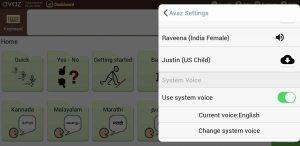 You can change the voice by going to settings and tapping on the Change system voice option. Please note that at present you will be taken to the device settings to change voice. Once you download the update for Avaz AAC Android, you can make these changes from within the app. Tap on 'Language' to choose a voice.
You can change the voice by going to settings and tapping on the Change system voice option. Please note that at present you will be taken to the device settings to change voice. Once you download the update for Avaz AAC Android, you can make these changes from within the app. Tap on 'Language' to choose a voice. 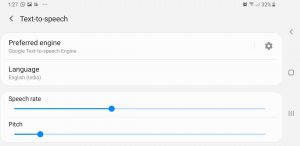
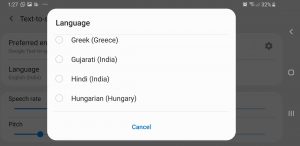 TIP 2 Talk to your child about the upcoming change. Using a social story to talk about this will go a long way in explaining it to them. Here’s one example of a social story you can use to do this -
TIP 2 Talk to your child about the upcoming change. Using a social story to talk about this will go a long way in explaining it to them. Here’s one example of a social story you can use to do this - How to Retain the Old Voices
After attempting to prepare your child, if you still think your child will not be able to handle the change, there is a way in which you can retain the old voices. Please note - We DO NOT recommend this, but if you see no other way out, you can try this method: Turn off auto-update in your Play store. This will let you retain the original voices. This also means that you will not get any further app updates or new features. Android apps downloaded from the Google Play Store are automatically updated by default.To turn off auto-update, follow these steps:- Open the Google Play Store on your Android device.
- Tap the Search Box at the top of the Play Store.
- Enter the name of the app and tap Search.
- Tap on the app to open the listing.
- Tap the three-dot overflow menu in the top right-hand corner.
- Click to deselect the checkbox next to Enable auto update.
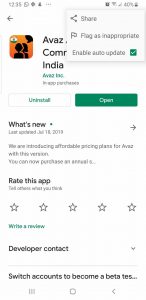 Turning off auto-update in Play store[/caption] Once you configure these settings, the app will no longer automatically update. If you have any questions or concerns, you can always reach out to us at support@avazapp.com. Please know that we’ll do our best to make this transition smooth for everyone.
Turning off auto-update in Play store[/caption] Once you configure these settings, the app will no longer automatically update. If you have any questions or concerns, you can always reach out to us at support@avazapp.com. Please know that we’ll do our best to make this transition smooth for everyone.What to Expect in Future Updates:
Sharing Vocabulary Avaz users can soon share vocabulary folders with other Avaz users. This means that if you have created a very useful folder of words, you can share it with others directly from within Avaz AAC itself! Teachers and therapists can share folders and words with parents too! Plus, vocabulary can be shared via WhatsApp as well. Your constructive feedback and suggestions have steered our efforts towards refining our apps. With your continued support, we are determined to include more features that make communication effortless with Avaz AAC.Let the Games Begin – AAC Games the Whole Family can Play
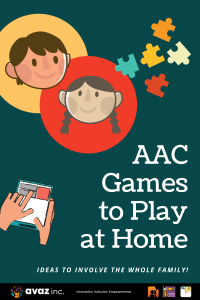 So, schools are closed and we are home religiously following WHO guidelines for social distancing. News updates paint a bleak picture. While it’s important to stay aware, we cannot let the crisis consume our minds. So, let’s consider this challenge an opportunity in disguise- an opportunity to spend some quality family time, to build communication and strengthen family bonds. Connecting with others during these trying times can keep our anxieties at bay. Some of these games can be played with other AAC users over social media. So, families with AAC users can get together and plan for some organized AAC fun. Ditch the TV and movies, folks. It’s time for games. Fun games that AAC users can play with their families 👨👩👦👦. Click on the images below to see how to play these awesome games:
So, schools are closed and we are home religiously following WHO guidelines for social distancing. News updates paint a bleak picture. While it’s important to stay aware, we cannot let the crisis consume our minds. So, let’s consider this challenge an opportunity in disguise- an opportunity to spend some quality family time, to build communication and strengthen family bonds. Connecting with others during these trying times can keep our anxieties at bay. Some of these games can be played with other AAC users over social media. So, families with AAC users can get together and plan for some organized AAC fun. Ditch the TV and movies, folks. It’s time for games. Fun games that AAC users can play with their families 👨👩👦👦. Click on the images below to see how to play these awesome games: WORD CHAIN
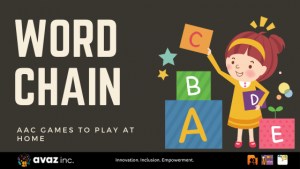
MEMORY GAME
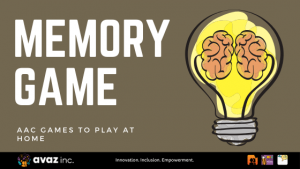
WHO'S THE BOSS

GAMES WITH DIGITAL ASSISTANTS
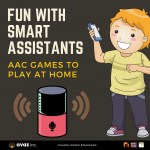 With young kids missing school and therapy sessions, exciting games like these can fill their days with fun and joy. It will also enable them to keep in touch with their AAC learning and continue the progress they have made with it at therapy. It can also help in shifting the focus away from the glumness around us and make time for self-care and family well being. Did you like these games? Please share screenshots or videos of how you played the games with friends and family. You can post them in the comment section below or send them to support@avazapp.com
With young kids missing school and therapy sessions, exciting games like these can fill their days with fun and joy. It will also enable them to keep in touch with their AAC learning and continue the progress they have made with it at therapy. It can also help in shifting the focus away from the glumness around us and make time for self-care and family well being. Did you like these games? Please share screenshots or videos of how you played the games with friends and family. You can post them in the comment section below or send them to support@avazapp.com Play Word Chain with AAC
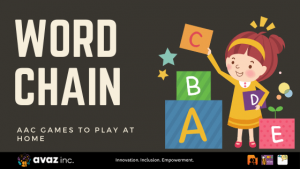 This classic game can go on and on because the last we checked, there are around 171,476 words in the Oxford dictionary📕. Agreed, kids may not know most of it. But what a way for them to gain vocabulary. And spelling. This can be played with any number of players. The more the merrier. How to Play: One player communicates a word. The next player needs to communicate a word beginning with the previous word’s final letter. The next player needs to do the same and so on. For example, Player 1: orange (The last letter of this word is ‘e’. So, the next word begins with ‘e’) Player 2: elephant (This word ends with ‘t’. So, Player 3 needs to say a word beginning with ‘t’) An example word chain could look like this: Orange, elephant, tiger, river, rain,notebook, king Since AAC systems are compatible with social media, you can play this game with other AAC users and their families. Here’s how our Avaz AAC users rocked this game in a Whatsapp group:
This classic game can go on and on because the last we checked, there are around 171,476 words in the Oxford dictionary📕. Agreed, kids may not know most of it. But what a way for them to gain vocabulary. And spelling. This can be played with any number of players. The more the merrier. How to Play: One player communicates a word. The next player needs to communicate a word beginning with the previous word’s final letter. The next player needs to do the same and so on. For example, Player 1: orange (The last letter of this word is ‘e’. So, the next word begins with ‘e’) Player 2: elephant (This word ends with ‘t’. So, Player 3 needs to say a word beginning with ‘t’) An example word chain could look like this: Orange, elephant, tiger, river, rain,notebook, king Since AAC systems are compatible with social media, you can play this game with other AAC users and their families. Here’s how our Avaz AAC users rocked this game in a Whatsapp group: 

 Did you like this game? Please share screenshots or videos of how you played this game with friends and family. You can post them in the comment section below or send them to support@avazapp.com
Did you like this game? Please share screenshots or videos of how you played this game with friends and family. You can post them in the comment section below or send them to support@avazapp.comMemory Game with AAC
 This game that puts our memory to test can be played with things that lie around the house. This can be exciting game to play for both kids and adults. How to play: Keep a few items covered on a tray such as ball, pen, ruler, book, etc. Reveal the items for a few minutes so that all players can take a look at them. Cover the tray again with a cloth. All players write down the list of items from their memory. The player who gets the most number of items right wins🏆. The number of items and the time given to memorize them can be increased as the players get more adept at this. For beginning AAC communicators, you can create a memory game folder and add the names of all the items on the tray. The trick is to mix it up with items that are not on the tray. (This is pretty easy with Avaz AAC because you can add multiple words at one go). They then tap on the items they remember from the tray. For more advanced AAC users you can have them navigate the app and tap out the names of items they remember!
This game that puts our memory to test can be played with things that lie around the house. This can be exciting game to play for both kids and adults. How to play: Keep a few items covered on a tray such as ball, pen, ruler, book, etc. Reveal the items for a few minutes so that all players can take a look at them. Cover the tray again with a cloth. All players write down the list of items from their memory. The player who gets the most number of items right wins🏆. The number of items and the time given to memorize them can be increased as the players get more adept at this. For beginning AAC communicators, you can create a memory game folder and add the names of all the items on the tray. The trick is to mix it up with items that are not on the tray. (This is pretty easy with Avaz AAC because you can add multiple words at one go). They then tap on the items they remember from the tray. For more advanced AAC users you can have them navigate the app and tap out the names of items they remember! 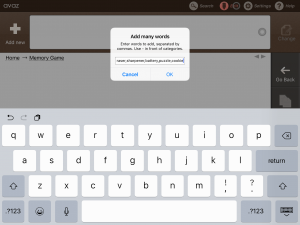
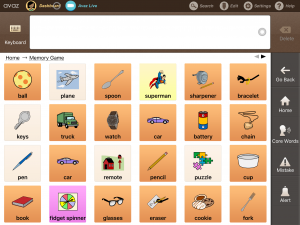 Did you like this game? Please share screenshots or videos of how you played this game with friends and family. You can post them in the comment section below or send them to support@avazapp.com
Did you like this game? Please share screenshots or videos of how you played this game with friends and family. You can post them in the comment section below or send them to support@avazapp.comPlay ‘Who’s the Boss?’ with AAC
 No, this is not a new game we’ve invented. It’s just a more fun name for the old favorite Simon Says! Who wouldn’t love to be the boss and order others around? It’s loads of fun for kids and the bonus is that this encourages AAC use. Because which kid would want to miss out on an opportunity to turn the tables and dictate what parents do. How to Play: When the player prefaces a command with “Simon says’ (or 'The Boss says’ 😎), others simply have to follow the command. Get creative with commands and you’ll have the whole family roaring with laughter during the game. Some examples of commands are: Make a silly face, bark like a dog, mimic a cat, do a crazy dance, sing a gibberish song, etc. Create a folder in your AAC system and add several phrases with audio for the commands. Remember if the player communicates a command without saying ‘Simon says’ and you go on to follow the command, you are out of the game. So, keep your ears open for this one.
No, this is not a new game we’ve invented. It’s just a more fun name for the old favorite Simon Says! Who wouldn’t love to be the boss and order others around? It’s loads of fun for kids and the bonus is that this encourages AAC use. Because which kid would want to miss out on an opportunity to turn the tables and dictate what parents do. How to Play: When the player prefaces a command with “Simon says’ (or 'The Boss says’ 😎), others simply have to follow the command. Get creative with commands and you’ll have the whole family roaring with laughter during the game. Some examples of commands are: Make a silly face, bark like a dog, mimic a cat, do a crazy dance, sing a gibberish song, etc. Create a folder in your AAC system and add several phrases with audio for the commands. Remember if the player communicates a command without saying ‘Simon says’ and you go on to follow the command, you are out of the game. So, keep your ears open for this one. 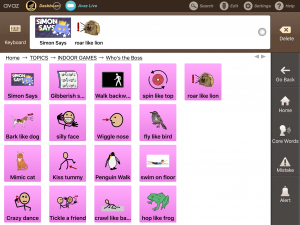 Did you like this game? Please share screenshots or videos of how you played this game with friends and family. You can post them in the comment section below or send them to support@avazapp.com
Did you like this game? Please share screenshots or videos of how you played this game with friends and family. You can post them in the comment section below or send them to support@avazapp.com Autism Acceptance Month Discount: April 1 to 30, 2020
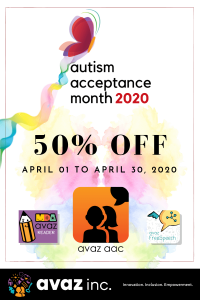 Given the grim circumstances around the world, communication has never been more important. It’s imperative that we as a community stick together, connect, and communicate. We at Avaz Inc, are doing our bit to empower people having complex communication needs, and to support the literacy journey of children staying home due to school closures. April being Autism Acceptance Month, we also want to celebrate people on the spectrum and all forms of neurodivergence. We are offering a FLAT 50% DISCOUNT on all Avaz Products from April 1 to 30, 2020!
Given the grim circumstances around the world, communication has never been more important. It’s imperative that we as a community stick together, connect, and communicate. We at Avaz Inc, are doing our bit to empower people having complex communication needs, and to support the literacy journey of children staying home due to school closures. April being Autism Acceptance Month, we also want to celebrate people on the spectrum and all forms of neurodivergence. We are offering a FLAT 50% DISCOUNT on all Avaz Products from April 1 to 30, 2020! The Discount:
50% off on: Avaz AAC : An award-winning communication app for users with speech difficulties arising from ASD, Cerebral Palsy, Downs Syndrome, aphasia, apraxia, strokes & more MDA Avaz Reader : Education app that enables struggling readers become independent readers using research backed strategies. Avaz FreeSpeech : An education app that makes learning English Grammar fun & easy for children with special needsHelp us Spread the Word
Share this news with loved ones who have been waiting to buy one of our products. Tell that teacher friend of yours who has been eyeing our products for her school. Or that parent who has been waiting for this discount to give her child a voice.Queries?
Our Support team is here to assist! Reach us 24×7 at support@avazapp.com Please note that the discounted prices mentioned below are for the Lifetime purchase of Avaz AAC, MDA Avaz Reader, and Avaz FreeSpeech apps. [ninja_tables id="2354"] You can avail the discount for Avaz FreeSpeech here. You can also purchase all our products at the App store or at the Play Store Learn more about our assistive technology products that empowers users with communication and learning: Avaz AAC MDA Avaz Reader Avaz FreeSpeechAll you Need to Know to Help Children Cope with the CoronaVirus Pandemic
 The Coronavirus pandemic is causing anxiety in people around the globe. Misconceptions and a lack of awareness can only make things worse and it’s important to stay informed. Here are a few resources to help you combat the challenges that arise due to the COVID-19 crisis:
The Coronavirus pandemic is causing anxiety in people around the globe. Misconceptions and a lack of awareness can only make things worse and it’s important to stay informed. Here are a few resources to help you combat the challenges that arise due to the COVID-19 crisis:Talking to Children:
Several schools have closed and children may sense the panic even if they do not grasp the gravity of the situation. Not addressing their fears can heighten their anxieties. So, parents and family members must reassure them and help them make sense of all the furore over the pandemic. Children with special needs may need more support to comprehend how the virus spreads and ways to protect themselves. Trusted adults must have an honest conversation about the pandemic, including as much information as they deem appropriate for the child’s age and cognition. For children using AAC (Augmentative and Alternative Communication), visual supports may help in reiterating the steps to follow to keep themselves safe. You can create visual supports now for free on Smarty Symbols by using the promo code HOMEVISUALS. Here are more links with visual supports and information regarding COVID-19:Wash, Wash, Wash Your Hands
Washing hands regularly is general hand hygiene. But young children are not typically known for their squeaky clean hands, given their tendencies to explore things by physically touching them. UNICEF has emphasized the role of correct hand washing techniques and other safe practices for coronavirus prevention. Humming Happy Birthday twice is suggested as a hack to indicate how long we should be washing our hands for. Not a huge fan of the tune? https://washyourlyrics.com/ is a website that lets you use any song as a Wash-your-hands jingle. This has really caught on with netizens who have generated thousands of posters with song lyrics from artistes including BTS, Shakira, Coldplay, etc. Children seem to love the idea of listening to their favourite songs while washing their hands. https://birthday-hands.glitch.me/ is an app that tells you the celebrities you can sing birthday to while washing your hands. Handwashing need not be a drudgery anymore courtesy of these simple and ingenious ideas. Device Sanitation
Device Sanitation
With cities in lockdown, and experts urging to practise ‘social distancing’, many adults and children may turn to their smartphones for social engagement. However, experts say that devices are hotbeds of germs. For high tech AAC users, this amplifies the risks because they may need their AAC systems at all times for communication. Given the serious consequences, it’s important to regularly sanitize devices and device cases. Samsung is offering free UV-C light sanitation for some of its devices in several of their Samsung experience stores (Check if your local store offers this service). Apple is instructing iPhone owners to use a cloth dampened with water to clean their phones while warm soapy water can be used for the iPhone 11, 11 Pro, and 11 Pro Max. Apple also says that you can use Clorox wipe or a wipe with 70% isopropyl alcohol to clean your iPhones.- What Not to Do:
- What You can Do:
Creating a Supportive Learning Environment
 School closures have led to parents struggling to keep their bored children engaged. More and more school districts are opting for virtual classes. But for young children, online classes may not be effective without active adult supervision. For children with special needs, school closures pose additional challenges beyond learning. Parents are concerned about the possibility of childrens’ progress being stalled due to suspension of therapy sessions or classroom instruction. Parents of beginning AAC communicators too worry about children losing ground on their AAC journey and forgetting the skills they’ve picked up painstakingly over several months. But thanks to the power of the internet, children can continue their AAC learning through virtual therapy sessions. Avaz AAC’s Avaz Live is a powerful feature through which therapists can demonstrate AAC strategies on their systems, or take control of the AAC user’s systems and change vocabulary settings. This way, if the AAC user was on course to get additional vocabulary added or to move to advanced vocabulary, they can do so with the help of the expert. If you want to know more about Avaz Live, please reach out to support@avazapp.com. AccessiByte is supporting remote learning for those who use assistive technology by offering free access to its apps. Here are a few more learning and recreational resources to keep children occupied:
School closures have led to parents struggling to keep their bored children engaged. More and more school districts are opting for virtual classes. But for young children, online classes may not be effective without active adult supervision. For children with special needs, school closures pose additional challenges beyond learning. Parents are concerned about the possibility of childrens’ progress being stalled due to suspension of therapy sessions or classroom instruction. Parents of beginning AAC communicators too worry about children losing ground on their AAC journey and forgetting the skills they’ve picked up painstakingly over several months. But thanks to the power of the internet, children can continue their AAC learning through virtual therapy sessions. Avaz AAC’s Avaz Live is a powerful feature through which therapists can demonstrate AAC strategies on their systems, or take control of the AAC user’s systems and change vocabulary settings. This way, if the AAC user was on course to get additional vocabulary added or to move to advanced vocabulary, they can do so with the help of the expert. If you want to know more about Avaz Live, please reach out to support@avazapp.com. AccessiByte is supporting remote learning for those who use assistive technology by offering free access to its apps. Here are a few more learning and recreational resources to keep children occupied:- Teachers Pay Teachers has a handy resource for practising AAC without an AAC system
- helpkidzlearn.com/ has apps for eye gaze users
- DId You Know That has several interesting facts explained in ASL
- Khan Academy has several resources including daily schedules for children aged 4 to 18
- Shared Tar Heel Reader is a great place for parents to read books with AAC users while modelling core words
- Emily Diaz has a few useful AAC training tips
- Scholastic offers reading and other projects for different grade levels
- Storylineonline.net has a fun collection of children’s books read by celebrities including Al Gore, Oprah Winfrey, Betty White, Kristen Bell etc.
- Mystery Science is supporting remote learning of science by offering access to their full lessons without signups
- BrainPOP is giving schools closed due to COVID free access to its suite.
- Kahoot is offering free access to its premium features to support schools affected by COVID.
- Book Creator has a bunch of ideas for remote learning
- OMazingKids has listed out a bunch of apps now free on the app store
- Zearn is offering entire K-5 curriculum for free
- thesingingclassroom.com/ has fun resources for grades PreK-6
- pernillesripp.com/ has a list of resources for read-aloud stories
- https://www.n2y.com/unique-learning-system/math/
- Growing Book By Book has a list of resources for read-aloud stories
- https://lessonpix.com/sharing?fbclid=IwAR2Z0J4UBj3NSUQTRebPUeuIinfO_QEUb-KlH25oo0rzd1DJzFqfeJIb5pw
- Achieve3000 has several free printable packets for different grade and reading levels.
- Adventuresinfamilyhood.com has a list of virtual field trips
- Facts4me.com gives free access to its resources til APr. 4, 2020 (Username:read Password:read)
Mental and Emotional Health
 The coronavirus crisis can take a heavy toll on the emotional and mental well being of families trapped within their homes. Adults may have to deal with the financial implications of the lockdown and this can put tremendous strain on them. Worrying about the health of family members and caring for young children staying home due to school closures can add to the stress. It’s important to talk about your difficulties openly with friends and family. While isolation is advised, make sure to stay connected to loved ones through social media and messaging platforms. If you feel overwhelmed, seek help immediately. Your unease can affect how children perceive the crisis. Children may experience a wide range of emotions due to the circumstances surrounding the virus outbreak and maybe unable to express them. Especially those with special needs may not be able to communicate their fears or feelings of distress. Adults must encourage them to express what they feel. While it is important to drive home the significance of following safe practices, this needs to be done discreetly so as to not scare the child. Here are a few resources that explain how to take care of mental health: Telegraph’s video about mental health Guardian’s video to deal with cabin fever WHO has this PDF about mental health considerations https://www.eachmindmatters.org/ask-the-expert/stayingconnected/ CDC has a bunch of resource about reducing-stigma and self care SAMHSA has a few tips for social distancing WHO’s Q&A on mental health during COVID-19 If you know of any other resources or links, please share them in the comment section below. We'll keep updating the post as and when we come across authenticated resources
The coronavirus crisis can take a heavy toll on the emotional and mental well being of families trapped within their homes. Adults may have to deal with the financial implications of the lockdown and this can put tremendous strain on them. Worrying about the health of family members and caring for young children staying home due to school closures can add to the stress. It’s important to talk about your difficulties openly with friends and family. While isolation is advised, make sure to stay connected to loved ones through social media and messaging platforms. If you feel overwhelmed, seek help immediately. Your unease can affect how children perceive the crisis. Children may experience a wide range of emotions due to the circumstances surrounding the virus outbreak and maybe unable to express them. Especially those with special needs may not be able to communicate their fears or feelings of distress. Adults must encourage them to express what they feel. While it is important to drive home the significance of following safe practices, this needs to be done discreetly so as to not scare the child. Here are a few resources that explain how to take care of mental health: Telegraph’s video about mental health Guardian’s video to deal with cabin fever WHO has this PDF about mental health considerations https://www.eachmindmatters.org/ask-the-expert/stayingconnected/ CDC has a bunch of resource about reducing-stigma and self care SAMHSA has a few tips for social distancing WHO’s Q&A on mental health during COVID-19 If you know of any other resources or links, please share them in the comment section below. We'll keep updating the post as and when we come across authenticated resources Small Screen, Huge Impact: Avaz AAC now Available on iPhones
Teaching Verb Tenses The Fun Way
What are Verb Tenses?
Verb tenses in English is a combination of Time and Aspect. Time indicates when something happened (past, present, future). Verb aspect indicates whether the actions are repeated, continuous, or happen in a single block of time. Here are the 12 verb tenses:- Present Simple
- Present Continuous/Progressive
- Present Perfect
- Present Perfect Continuous/Progressive
- Past Simple
- Past Continuous/Progressive
- Past Perfect
- Past Perfect Continuous/Progressive
- Future Simple
- Future Perfect
- Future Continuous/Progressive
- Future Perfect Continuous/Progressive
Present, Past, and Future
Let’s analyze how the app helps learn verb tenses: For example, you compose the sentence, ‘She do homework’, the app automatically recasts it to the grammatically correct sentence, ‘She does homework', which is in present tense. If the child is not sure of how to talk about the action in the past tense, all they have to do is to tap on the ‘PAST’ button. The message box immediately displays the sentence, ‘She did homework’. Similarly, tapping on the ‘FUTURE’ button displays the sentence, ‘She will do homework.’More Verb Tenses
If you want to use Present Continuous, use the combination of ‘PRESENT’ and ‘CONTINUOUS’ buttons. If you want to use Present Perfect, use the combination of ‘PRESENT’ and ‘COMPLETED’ buttons If you want to use Present Perfect Continuous, use the combination of ‘PRESENT’, ‘COMPLETED’ and ‘CONTINUOUS’ buttons Similarly, If you want to use Past Continuous, use the combination of ‘PAST’ and ‘CONTINUOUS’ buttons. If you want to use Past Perfect, use the combination of ‘PAST’ and ‘COMPLETED’ buttons. If you want to use Past Perfect Continuous, use the combination of ‘PAST’, ‘COMPLETED’ and ‘CONTINUOUS’ buttons. If you want to use Future Continuous, use the combination of ‘FUTURE’ and ‘CONTINUOUS’ If you want to use Future Perfect, use the combination of ‘FUTURE’ and ‘COMPLETED’ buttons. If you want to use Future Perfect Continuous, use the combination of ‘FUTURE’, ‘COMPLETED’ and ‘CONTINUOUS’ buttons. Here's the app in action powering through all the 12 verb tenses: As you can see, Avaz FreeSpeech provides a simplified way of teaching verb tenses. It makes the task easier for the teacher or parent and lets the child learn at their own pace. What’s more, you can also create custom challenges so that children can get enough practice using all the tenses.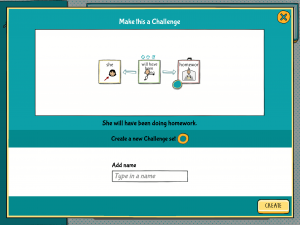 There's a lot more you can do with Avaz FreeSpeech such as negation, questions, and other sentence manipulations. It can also help in expansion and recasting of language. The picture support and audio cues help in multi sensory learning and helps children of all abilities build language. Learn more about Avaz FreeSpeech here.
There's a lot more you can do with Avaz FreeSpeech such as negation, questions, and other sentence manipulations. It can also help in expansion and recasting of language. The picture support and audio cues help in multi sensory learning and helps children of all abilities build language. Learn more about Avaz FreeSpeech here. Avaz AAC User Stories: Why Nishant and his AAC System are Inseparable

Giving Them the Power
Akila says that she didn't have to do much to teach Choice-making to Nishant, who was diagnosed with Autism when he was 3. He had always been particular about the things he wanted and wouldn't settle for anything else. This fit well into the family’s plan for raising an empowered child. Choice-making is an intervention used in children with Autism that allows them to dictate their preferences and have control over the environment. For beginning communicators, providing choices between a much preferred item and something else is a great way to get them to communicate.Paving the Way for Communication
Akila rightly warns about the consequences of parents preempting a child's needs. When parents assume a child’s needs and wants, it can lead to them developing a learned behaviour of showing no communicative intent. Parents should instead encourage the child to express their ideas. To facilitate this, we may have to constantly create communication opportunities around the house. Sabotaging the environment is one of the strategies Akila employs as a motivator for communication. It involves keeping the things that a child regularly uses out of their reach or hidden. This creates a scenario where children reach for their AAC systems to request their favourite things. She also talks about the efficacy of reinforcer checklists, which gives caregivers an idea of things to use for rewarding desired behaviour. Reinforcers can be anything that a child enjoys such as cookies or playtime. Akila has a Effective Reinfocers list that includes Indian snacks and desserts. Here’s another sample reinforcer checklist that parents can use to assess what works for their children.Family that Models Together
 While Nishant is a young adult now, fluent with AAC, and has admirable literacy skills, it was not easy getting here. The family experimented with several speech-generating devices (SGDs) and consulted several professionals to support his AAC journey. Nishant instantly took to Avaz because it gave him a voice. He found symbols easier to communicate with, although he had good language skills.The family consistently modelled on the AAC system which had an instrumental role to play in enabling his AAC proficiency. Getting all family members on board can make a world of difference in how an AAC user perceives the AAC system. Especially for emergent communicators, watching their family members use the AAC system for communication can be a major motivator to explore the AAC device.
While Nishant is a young adult now, fluent with AAC, and has admirable literacy skills, it was not easy getting here. The family experimented with several speech-generating devices (SGDs) and consulted several professionals to support his AAC journey. Nishant instantly took to Avaz because it gave him a voice. He found symbols easier to communicate with, although he had good language skills.The family consistently modelled on the AAC system which had an instrumental role to play in enabling his AAC proficiency. Getting all family members on board can make a world of difference in how an AAC user perceives the AAC system. Especially for emergent communicators, watching their family members use the AAC system for communication can be a major motivator to explore the AAC device.Find fun ideas for using AAC in everyday life here
Respecting Their Emotional Intelligence
One of the myths surrounding people with Autism is that they can be indifferent or that they are devoid of emotion. Akila shares a few anecdotes that busts these misconceptions.- The Sibling Connection
- Source of Solace
Downloadable Low Tech Communication Boards
 Communication boards are an excellent resource to facilitate communication for people with speech and language deficits. Children and adults who have complex communication needs can use these boards to express their wants and needs. It can be used to augment communication in case the user has partial speech or as an alternative mode of communication for those who are non-verbal. You can find COVID-related downloadable communication boards here. You can find story-related Communication boards for shared reading here. Why use Low Tech AAC Boards? People with communication challenges due to Autism, Apraxia, stroke, can use AAC (Augmentative and Alternative Communication) boards to communicate to their loved ones and during social interactions. Even AAC users who use robust high tech AAC systems can use low tech boards in physical environments where high tech AAC use may not be feasible. For a child getting started with AAC, low tech boards can be used to build language as they develop their communication skills. While the boards have their limitations in their range of vocabulary, their low cost and ease-of-use make them handy tools for communication. They can also be easily carried everywhere providing the user access to communication at all times. Here's a great example of how to use low tech boards to encourage AAC use. Hang the low tech board with food vocabulary near the refrigerator or dining table so that the communicator can request the food they'd like to have. Once the AAC user gets familiar with the vocabulary on the low tech board, they can use the same on their high tech AAC systems too.
Communication boards are an excellent resource to facilitate communication for people with speech and language deficits. Children and adults who have complex communication needs can use these boards to express their wants and needs. It can be used to augment communication in case the user has partial speech or as an alternative mode of communication for those who are non-verbal. You can find COVID-related downloadable communication boards here. You can find story-related Communication boards for shared reading here. Why use Low Tech AAC Boards? People with communication challenges due to Autism, Apraxia, stroke, can use AAC (Augmentative and Alternative Communication) boards to communicate to their loved ones and during social interactions. Even AAC users who use robust high tech AAC systems can use low tech boards in physical environments where high tech AAC use may not be feasible. For a child getting started with AAC, low tech boards can be used to build language as they develop their communication skills. While the boards have their limitations in their range of vocabulary, their low cost and ease-of-use make them handy tools for communication. They can also be easily carried everywhere providing the user access to communication at all times. Here's a great example of how to use low tech boards to encourage AAC use. Hang the low tech board with food vocabulary near the refrigerator or dining table so that the communicator can request the food they'd like to have. Once the AAC user gets familiar with the vocabulary on the low tech board, they can use the same on their high tech AAC systems too. 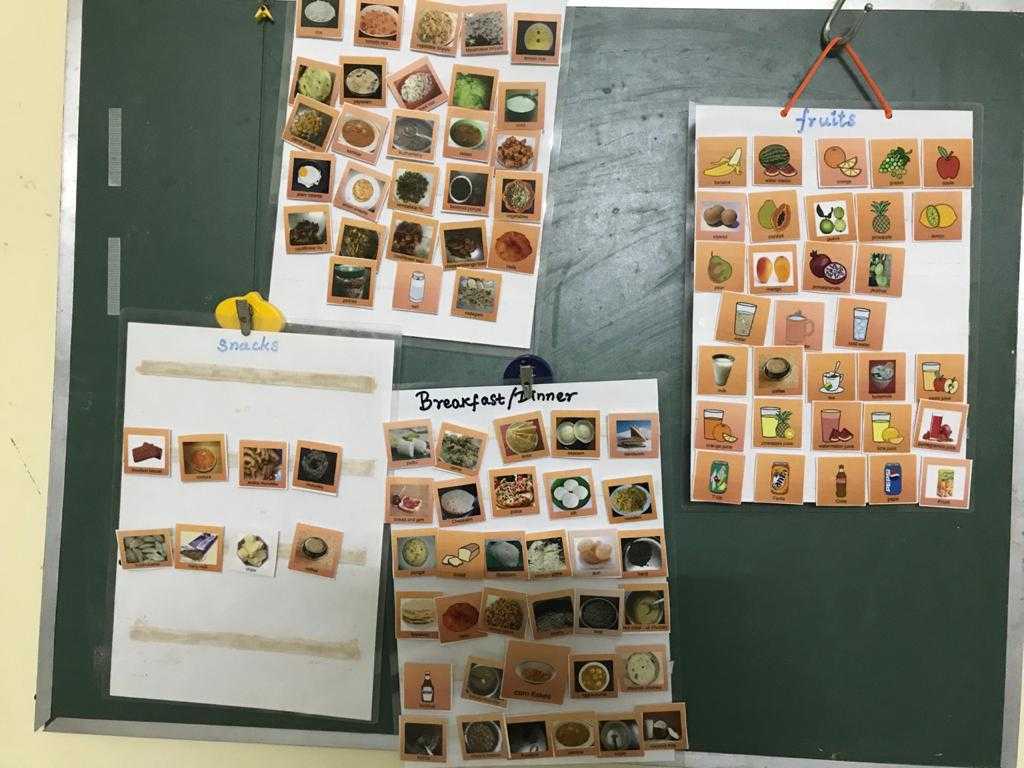 Here are a few downloadable low tech boards of Avaz AAC app. Please note that these boards have a grid size of 40. If you want other grid sizes, you can download them as PDF from Avaz AAC app.
Here are a few downloadable low tech boards of Avaz AAC app. Please note that these boards have a grid size of 40. If you want other grid sizes, you can download them as PDF from Avaz AAC app.Download a free trial version of Avaz AAC here for iOS | Android.
Avaz AAC(English)- Avaz AAC Core Board File size:659 KB
- Avaz AAC Core Vocabulary(More Core Words) File size:1060 KB
- Avaz AAC Feelings File size:1370 KB
- Avaz AAC Questions File size:1240 KB
Download a free trial version of Avaz Francais here.Avaz Francais (French)
- Avaz en Français Mots de Base File size:1277 KB
- Avaz en Français Questions File size:339 KB
- Avaz en Francais réponses et commentaires File size:1180 KB
- Avaz en Francais Rapide File size:3540 KB
Download a free trial version of Avaz India hereAvaz India
- Avaz India_Core File size: 417 KB
- Avaz India_Breakfast File size:356 KB
- Avaz India_Lunch/Dinner File size:1550 KB
Avaz DanishDownload a free trial version of Avaz Danish here
- Centrale Ord Avaz bog File size:340 KB
- mine følelser Avaz bog File size:237 KB
- frokost Avaz bog File size:303 KB
- morgenmad Avaz bog File size:453 KB
- aftensmad Avaz bog File size:371 KB
How Knowing Word Families Helps in Achieving Reading Proficiency
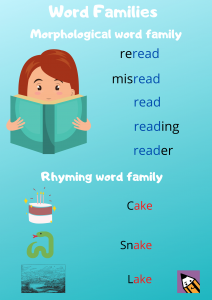 Teaching reading to young children can be an arduous task given that the English language follows numerous patterns and has irregular spelling. Read on to learn about how word families can help simplify reading instruction and improve reading comprehension.
Teaching reading to young children can be an arduous task given that the English language follows numerous patterns and has irregular spelling. Read on to learn about how word families can help simplify reading instruction and improve reading comprehension.What are Word Families?
According to the Oxford Learner’s Dictionaries, word families are a group of related words that are formed from the same word or a group of words with particular features in common. Here are the two word families that are commonly used in reading instruction for beginning and struggling readers:- Rhyming Word Family
- Morphological Word Family
Why Focus on Word Families?
Knowledge of word families helps children build vocabulary. Instead of memorizing spellings and meanings of all words, they learn how to spot patterns, identify root words, and understand their common meanings or sounds. This helps in word recognition leading to the development of their reading fluency. Studies suggest that children learn to connect what they have already learned to what they are currently learning through by observing word similarities. Understanding the concept of root words and their derivatives can help children deduce the meaning of other words in the word family. Experts also say that children tend to read quicker because of the familiarity of the words in word families. They learn to analyze language and understand common grammar rules. For example, knowing that the prefix ‘un’ can indicate negation - this knowledge will help children infer the meaning of words with this prefix, as long as they know the root word. They will understand that ‘unhappy’ is the opposite of ‘happy’ and that ‘untrue’ means ‘not true’. Similarly, understanding that the suffix ‘er’ can indicate more of something, will help them deduce that ‘easier’ means ‘more easy’ and ‘happier’ means ‘more happy’.How to Teach Word Families
Encouraging children to identify rhyming words in a text is at the core of teaching about rhyming word families. Word family charts and games can be useful tools in this effort. For emergent or dyslexic readers, it may not be easy to identify rhyming words. In such cases, the teacher can guide them by emphasizing the similar sounding portions of final syllables in the words being taught. For example, the teacher can take a keyword such as 'cat', and ask the children to find words that end with ‘at’. For morphological word families, classroom instruction should focus on developing the child’s awareness of morphemes, which are the smallest units of language that have meaning. As children grow, they come across academic vocabulary with prefixes or suffixes, such as the prefix ‘hydro’ which means ‘water’ or ‘hydrogen’. So, morphological awareness has a major role to play in comprehension and thus, literacy.MDA Avaz Reader And Word Families
Reading instruction can be a complex process and teachers might not have the bandwidth to attend to each child and customize the lesson plans for their individual needs. Assistive tools such as MDA Avaz Reader can be great teaching aids and assist teachers in providing tailor made instruction. The reading assistance app can also be used at home to help children while they read as part of their homework or while reading as a hobby. [gallery size="medium" ids="4385,4384"] MDA Avaz Reader has several exciting stories that give children their daily reading practice. You can also import a PDF into the app or take a photo of the storybook or textbook the child wants to read. In case the child needs help with a word, they can tap the ‘Hint’ button to get rhyming and prefix/suffix hints. Please note that the app also provides additional hints such as syllable, picture and audio hints to help children comprehend a word effectively. [gallery size="medium" ids="4383,4382,4381"] Word families can accelerate vocabulary acquisition by significantly increasing the number of words children have at their command. To achieve reading proficiency, instruction must also focus on teaching other reading strategies concurrently. More importantly, giving ready access to help with digital assistive tools reassures children. It also encourages them to immerse themselves into reading, resulting in improved reading skills and literacy.Love as a Source of Strength and Joy for Special Needs Families
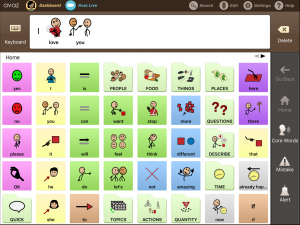 Valentine's Day is upon us. A day to celebrate love - because it is truly what makes the world go round. Special needs families derive strength from the unconditional love they have for their family members. Love comforts and reassures. It invigorates them as they navigate life's various challenges. It is the profundity of love that helps in appreciating the small pleasures of life despite the struggles. With school projects, therapy appointments and other responsibilities consuming your time, you may not have been able to tell your child how much they mean to you. Not just heart shaped balloons, chocolates, flowers, greeting cards, and gifts - there are several ways to show love to people you care about. Here are a few more thoughtful ways to express your love:
Valentine's Day is upon us. A day to celebrate love - because it is truly what makes the world go round. Special needs families derive strength from the unconditional love they have for their family members. Love comforts and reassures. It invigorates them as they navigate life's various challenges. It is the profundity of love that helps in appreciating the small pleasures of life despite the struggles. With school projects, therapy appointments and other responsibilities consuming your time, you may not have been able to tell your child how much they mean to you. Not just heart shaped balloons, chocolates, flowers, greeting cards, and gifts - there are several ways to show love to people you care about. Here are a few more thoughtful ways to express your love:  Handwritten Notes Special needs children may need reassurance and support from family members to deal with their challenges. The more they know how loved they are, the better it is for their confidence. Consider doing a little extra as a family this Valentine’s day, besides the daily ‘I love you’s. Get together as a family and write handwritten notes for each other. No need to worry too much about the choice of words or language proficiency. Simple words suffice to express gratitude and affection. During this activity, you can encourage the child to participate by expressing their love in whichever way they communicate best - be it sign language, a hug, or using their AAC system.
Handwritten Notes Special needs children may need reassurance and support from family members to deal with their challenges. The more they know how loved they are, the better it is for their confidence. Consider doing a little extra as a family this Valentine’s day, besides the daily ‘I love you’s. Get together as a family and write handwritten notes for each other. No need to worry too much about the choice of words or language proficiency. Simple words suffice to express gratitude and affection. During this activity, you can encourage the child to participate by expressing their love in whichever way they communicate best - be it sign language, a hug, or using their AAC system.  Whip Up a Treat Together Know your way around the kitchen? Well, then it's time to put your apron on and get baking. What can profess true love more than home baked cookies or warm scrumptious brownies? Bake something as a family. Each member can pitch in with one aspect of the prep. And children love mixing batter and cutting out cookies. And decorating the baked goods is a fun activity too! Personalize the treats by writing sweet messages with icing or snazz it all up with some frosting & sprinkles :)
Whip Up a Treat Together Know your way around the kitchen? Well, then it's time to put your apron on and get baking. What can profess true love more than home baked cookies or warm scrumptious brownies? Bake something as a family. Each member can pitch in with one aspect of the prep. And children love mixing batter and cutting out cookies. And decorating the baked goods is a fun activity too! Personalize the treats by writing sweet messages with icing or snazz it all up with some frosting & sprinkles :)  Get Crafty DIY gifts are not only easy to make but are easy on your wallet. They also are an excellent way to engage your children in an exciting activity. So get out the glue stick, coloured markers, crayons, glitter and your craft box to create something spectacular together.
Get Crafty DIY gifts are not only easy to make but are easy on your wallet. They also are an excellent way to engage your children in an exciting activity. So get out the glue stick, coloured markers, crayons, glitter and your craft box to create something spectacular together.  Do Their Favourite Activity If your child has an activity that they’ve been pestering you for a while to indulge in, Valentine’s day is the best time to do it. Whether it’s reading their favourite fiction or building a lego toy, there can be nothing more that can delight your child than doing it with you. Watch their favourite movie together or play pictionary, charades, or board games for some family fun.
Do Their Favourite Activity If your child has an activity that they’ve been pestering you for a while to indulge in, Valentine’s day is the best time to do it. Whether it’s reading their favourite fiction or building a lego toy, there can be nothing more that can delight your child than doing it with you. Watch their favourite movie together or play pictionary, charades, or board games for some family fun.  Take a Nature Walk Want to make of the pleasant weather? Go on a nature walk with your family. Research suggests that group nature walks promote social interactions and also relieves stress and anxiety. Your child can also learn about biology and geography during these walks. So, ditch the indoors on Valentine’s day and spend time with nature by watching birds and trees. Avaz Inc. is grateful for all the love you have continued to shower us with. Here’s wishing you all a wonderful Valentine’s Day. May all your days be filled with love, light and loads of laughter.
Take a Nature Walk Want to make of the pleasant weather? Go on a nature walk with your family. Research suggests that group nature walks promote social interactions and also relieves stress and anxiety. Your child can also learn about biology and geography during these walks. So, ditch the indoors on Valentine’s day and spend time with nature by watching birds and trees. Avaz Inc. is grateful for all the love you have continued to shower us with. Here’s wishing you all a wonderful Valentine’s Day. May all your days be filled with love, light and loads of laughter. Have you Backed Up your AAC Vocabulary Yet?
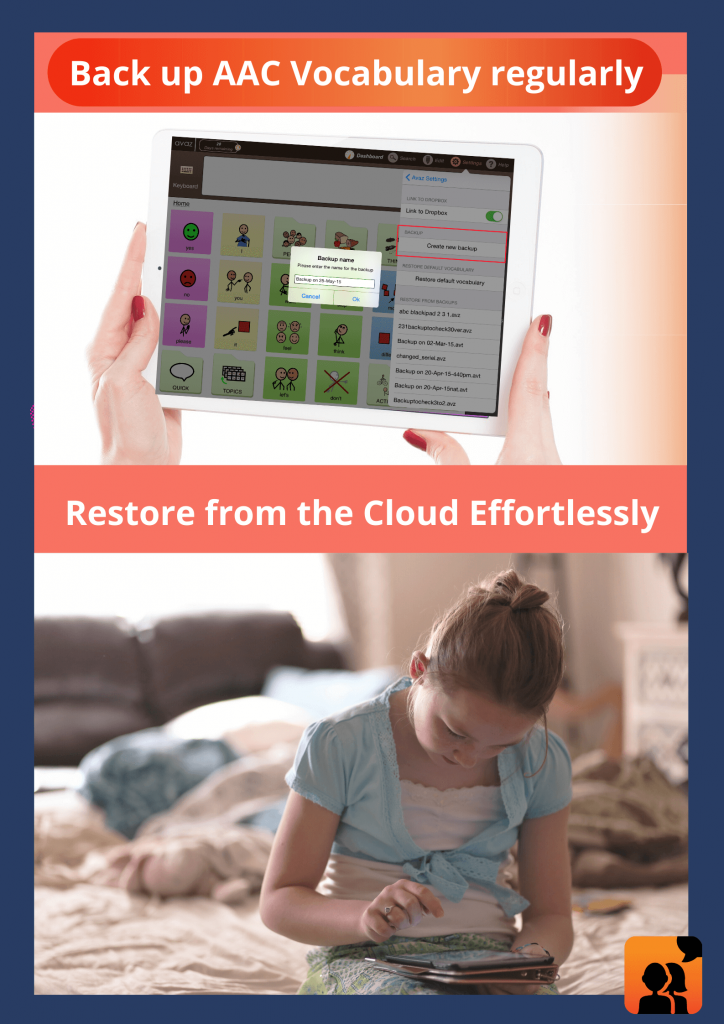 You add personalized vocabulary in the AAC user's system and are happy with the progress they are showing. You add more words as their communication skills develop and have high hopes for them to flourish into proficient communicators. And then one fateful day you learn that their device has died, leaving you and the communicator feeling helpless. Wouldn't it be tragic for the AAC user to lose their voice, albeit temporarily, due to a system failure? It isn't as if we aren't aware that the best of electronic systems can fail. We also know that children, especially, can drop devices, and protective covers can only do so much. To make things worse, such accidents come unannounced and it might take a while before you configure a new system with the necessary customizations. Thankfully, robust AAC systems such as the Avaz AAC app have powerful backup features which help you salvage the situation. Just remember to back up the user's vocabulary periodically. In the event of unforeseen circumstances where their AAC system becomes unavailable, you can restore the vocabulary into another system in a jiffy. The user will continue to have access to their personalized vocabulary and customizations, thanks to your forethought and prior planning.
You add personalized vocabulary in the AAC user's system and are happy with the progress they are showing. You add more words as their communication skills develop and have high hopes for them to flourish into proficient communicators. And then one fateful day you learn that their device has died, leaving you and the communicator feeling helpless. Wouldn't it be tragic for the AAC user to lose their voice, albeit temporarily, due to a system failure? It isn't as if we aren't aware that the best of electronic systems can fail. We also know that children, especially, can drop devices, and protective covers can only do so much. To make things worse, such accidents come unannounced and it might take a while before you configure a new system with the necessary customizations. Thankfully, robust AAC systems such as the Avaz AAC app have powerful backup features which help you salvage the situation. Just remember to back up the user's vocabulary periodically. In the event of unforeseen circumstances where their AAC system becomes unavailable, you can restore the vocabulary into another system in a jiffy. The user will continue to have access to their personalized vocabulary and customizations, thanks to your forethought and prior planning.Reasons You Need to Take a Backup
Without customizations, AAC users can struggle to communicate. Customizations help them with motor planning and also give them quick access to frequently used phrases. Backups are essential to safeguard customized AAC content from being lost. Here are a few scenarios where backups can come in handy- A child forgets to bring their device to school.
- Child Moves to a Different School
- Device Failure
- Inadvertent Deletion of App
- Physical Environment where High Tech AAC use is not Feasible
Effortless Backup with Avaz AAC
The Avaz backup includes the entire environment of the app in its current state. This includes:- the entire picture vocabulary (including custom images added)
- the audio recording (if any)
- all the settings that have been set in the app
- the Saved sentences
- the history of recently spoken sentences
 For iPad: You can transfer Avaz content very easily from one iPad to another via AirDrop. This is the most recommended option to transfer content, since it is much quicker and easier to do this. Besides, this does not require internet connectivity, nor cables to connect between the devices. You can also transfer Avaz content using iTunes or Dropbox.
For iPad: You can transfer Avaz content very easily from one iPad to another via AirDrop. This is the most recommended option to transfer content, since it is much quicker and easier to do this. Besides, this does not require internet connectivity, nor cables to connect between the devices. You can also transfer Avaz content using iTunes or Dropbox.  For Android: You can easily transfer Avaz content from one Android device to another using Dropbox. This saves your backup in the cloud and can be retrieved when needed. Avaz also offers cross-platform compatibility - you can sync content (backups) between your iPad and Android devices seamlessly. If you have customized the app and wish to transfer it to another device, without having to redo the changes, you can do so, using different methods. Note that these methods transfer only the app content (vocabulary and settings).
For Android: You can easily transfer Avaz content from one Android device to another using Dropbox. This saves your backup in the cloud and can be retrieved when needed. Avaz also offers cross-platform compatibility - you can sync content (backups) between your iPad and Android devices seamlessly. If you have customized the app and wish to transfer it to another device, without having to redo the changes, you can do so, using different methods. Note that these methods transfer only the app content (vocabulary and settings). How Often to Take Backup
There is no one backup schedule that can be optimal for everyone. For some users you may add vocabulary more often than others. So, it's always a good idea to back up the AAC app content every time you make significant changes. This way, if you need to restore vocabulary, you'll be able to do so with minimal effort. Regular backing up of AAC content saves you the trouble of having to frantically customize a an user’s AAC system in the event their current AAC system becomes unavailable. It also ensures that the AAC user has continued access to their vocabulary and customizations, thus facilitating uninterrupted communication.Revisiting Most Loved Avaz Features: Phonetic Match to Support Unrestricted Communication
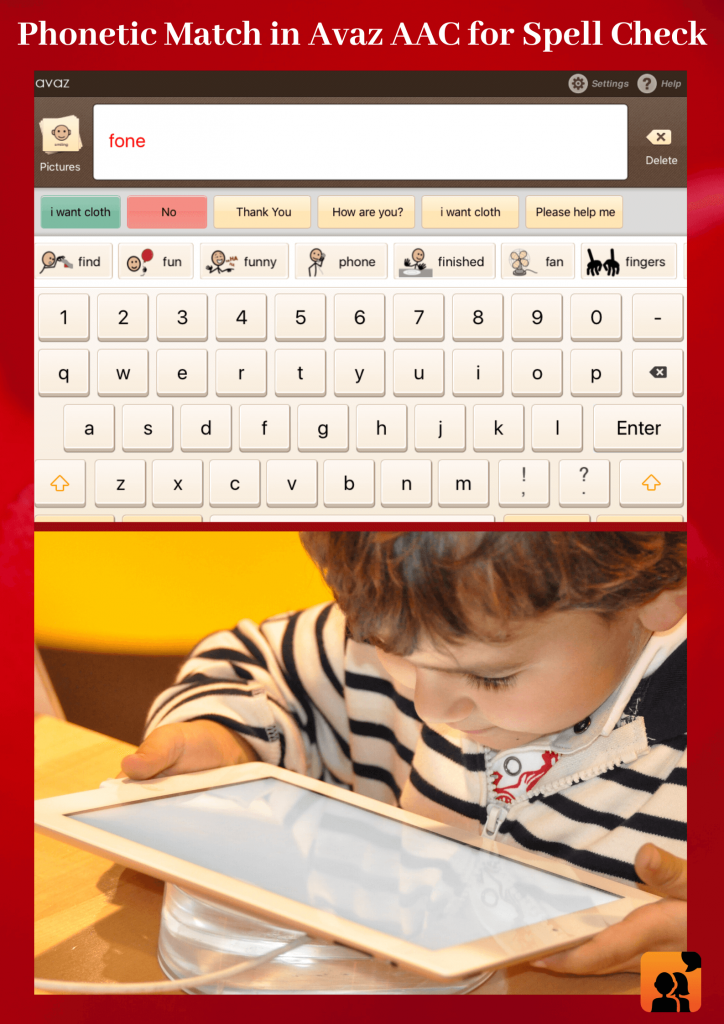 Spelling is an important aspect of the written language and it is essential for accurate expression of your ideas. Misspelt words can often lead to hilarity, confusion, and misunderstandings. But insisting on correct spelling for early learners and people with language deficits can get in the way of communication. Learners might get conscious while communicating if there is overt focus on spelling. This may even discourage them from communicating altogether. At Avaz, we believe that any intervention in this direction needs to be one of nuance and understanding. To enable the user to communicate should be the priority. Other learning objectives will follow organically as a consequence. Avaz AAC app's Phonetic match is an excellent feature that allows users to communicate without their expression being inhibited by a lack of spelling awareness. With Phonetic Match, Avaz AAC app predicts relevant words as the user is typing, even if the typed spelling is incorrect. This feature speeds up communication without the user being forced to rectify their spelling. It also plays an instrumental role in language development because it gives the user the opportunity to play with more words without emphasizing too much on correct spelling.
Spelling is an important aspect of the written language and it is essential for accurate expression of your ideas. Misspelt words can often lead to hilarity, confusion, and misunderstandings. But insisting on correct spelling for early learners and people with language deficits can get in the way of communication. Learners might get conscious while communicating if there is overt focus on spelling. This may even discourage them from communicating altogether. At Avaz, we believe that any intervention in this direction needs to be one of nuance and understanding. To enable the user to communicate should be the priority. Other learning objectives will follow organically as a consequence. Avaz AAC app's Phonetic match is an excellent feature that allows users to communicate without their expression being inhibited by a lack of spelling awareness. With Phonetic Match, Avaz AAC app predicts relevant words as the user is typing, even if the typed spelling is incorrect. This feature speeds up communication without the user being forced to rectify their spelling. It also plays an instrumental role in language development because it gives the user the opportunity to play with more words without emphasizing too much on correct spelling.Importance of Encouraging Invented Spelling
Children and early learners go through several stages of spelling development. They gradually transition from associating sounds with words to learning spelling by paying attention to visual representation. Experts suggest that children can use something called invented spelling as they are progressing through the various stages. Invented spelling is when they create their own spellings depending on their knowledge of sounds, words, and spelling patterns. The significance of invented spelling was not understood until recently. While incorrect spelling was discouraged earlier, it is now seen as a part of the developmental process. According to experts, one of the main benefits of invented spelling is that communication is not stalled due to wrong spelling.Phonetic Match in Avaz AAC App
Avaz AAC app has word prediction features to facilitate faster communication. Phonetic match is a part of the app’s much appreciated prediction capabilities. It is a way to spell check so that the user’s incorrect spelling does not hold back their communication. A user can type the phonetic spelling, which is the spelling based on the correspondence between letters and sounds. The app prompts with related words that are spelled correctly. The user can choose the appropriate word from the prediction bar and continue to communicate. When the user comes across the correct spelling a few times, it increases the chances of them picking up the right way to spell.How to Use Phonetic Match
In the Avaz AAC app, Tap Settings > Prediction and turn ‘Phonetic match’ to ON to enable this.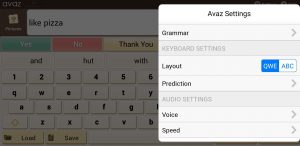
 Here are a few examples of how phonetic match predicts words related to the typed words:
Here are a few examples of how phonetic match predicts words related to the typed words:  Here you can see that when the user types the word ‘joos’, the app prompts the words, ‘just’, ‘justice’, ‘juice’, ‘jasmine’, ‘Jesse’, etc. If the user intended to say, ‘want juice’, then they can tap on the right word instead of having to correct the spelling.
Here you can see that when the user types the word ‘joos’, the app prompts the words, ‘just’, ‘justice’, ‘juice’, ‘jasmine’, ‘Jesse’, etc. If the user intended to say, ‘want juice’, then they can tap on the right word instead of having to correct the spelling. 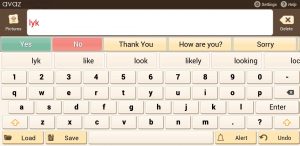 In the above example, you can see that when the user types ‘lyk’, Avaz AAC app prompts with the words, ‘like’, ‘look’, ‘likely’, ‘looking’ etc on the prediction bar.
In the above example, you can see that when the user types ‘lyk’, Avaz AAC app prompts with the words, ‘like’, ‘look’, ‘likely’, ‘looking’ etc on the prediction bar.Phonetic Match and Communication
The importance of spelling cannot be ignored. But it is crucial to make sure that it does not impose any limits on communication. Avaz AAC app prioritizes unrestrained communication and phonetic match is a useful feature that makes way for that. Therefore, it can be seen as a nifty tool that provides opportunities to explore language while ensuring that communication does not suffer due to the scrutiny of spelling.Avaz Inc: Moving Towards an Integrated Vision of Assistive Technology
The Avaz Inc. Logo
We are proud to unveil the new Avaz Inc. logo to accompany brand consolidation. The logo symbolizes all that we stand for as a company. We believe that inclusion and empowerment involve the fulfillment of several components and processes. True inclusion cannot be achieved without laying the groundwork for the same in all spheres of life. The Avaz Inc. logo is a confluence of all the elements that are essential to the achievement of inclusion and empowerment. Here is a breakdown of the logo and what each element represents: [metaslider id=4045]
We believe that inclusion and empowerment involve the fulfillment of several components and processes. True inclusion cannot be achieved without laying the groundwork for the same in all spheres of life. The Avaz Inc. logo is a confluence of all the elements that are essential to the achievement of inclusion and empowerment. Here is a breakdown of the logo and what each element represents: [metaslider id=4045]What this Change Means for Us
Avaz Inc. believes in the power of technological innovation to achieve inclusion and empowerment. All our efforts focus on removing socially imposed barriers to enable people with disabilities to realize their potential. Our company's vision is to create an inclusive society through technology innovation. Our new tagline succinctly captures the essence of the company vision.Innovation. Inclusion. Empowerment.
The new tagline is a call to action. A constant reminder of why we do the things we do. One that pushes us to work harder towards our goals. This encapsulation is at the heart of this brand integration exercise. This effort provides a clear definition of who we are and what we do. It provides a common direction for the company. It allows us to bring together our diverse efforts towards our stated goals under a unified umbrella. Avaz Inc becomes the common thread running through all our products, infusing our shared values and vision into everything we create and do. It enables us to do more of what we do best, with greater impact.What this Integration Means for you
As Avaz Inc. forges ahead with this rebranding, one thing remains unchanged. It is our commitment to our users and stakeholders. As always we will continue to work towards creating world-class, holistic, technology solutions for people with disabilities. All our endeavours will be focussed on developing products that make the world a better place for everyone. For Avaz Inc., our users come first, always. It is your constant love and support that has encouraged us to venture into new territories in assistive technology. The years spent on research on these new technologies has armed us with a deeper understanding of the challenges faced by people with disabilities. It has endowed us with greater empathy and a renewed determination to create better solutions. The integrated vision and voice of Avaz Inc. will not change anything about Avaz AAC, Avaz FreeSpeech and MDA Avaz Reader - the products that you have grown to know and love. If anything, this move enables us to keep working to make your beloved apps even better! The Avaz Inc. team will continue to put our hearts and souls into fine tuning our existing products. We are coming up with several updates and improved solutions because you deserve nothing but the best. Collaborations with governments and other stakeholders are in the pipeline to ensure that no individual is left without access to the resources they need. All of us here at Avaz Inc. look forward to working with you to bring about access, inclusion, empowerment & equality.The Many Benefits of Independent Reading for Young Children
 Regular reading enriches a child’s life. Children learn about ethics and virtues from moral stories while biographies can inspire them to follow in the footsteps of their idols. Fictional books can stir their imagination and spur their creativity while non-fiction books can educate and entertain. Reading independently,especially, can benefit children by improving their reading proficiency. Read this post to learn more about the benefits of independent reading.
Regular reading enriches a child’s life. Children learn about ethics and virtues from moral stories while biographies can inspire them to follow in the footsteps of their idols. Fictional books can stir their imagination and spur their creativity while non-fiction books can educate and entertain. Reading independently,especially, can benefit children by improving their reading proficiency. Read this post to learn more about the benefits of independent reading.What is Independent Reading?
Independent reading is a practice where children read text with very little or no assistance from others. It involves children choosing books that they love to read. Since choice is an integral part of this practice, children can be motivated to read more. Children can read voluntarily as a hobby or as part of their homework, and build their literacy. Teachers and parents can offer them guidance in choosing books according to their reading level, and in constructing responses to the text they read.The Road Map to Better Reading
 Young children get familiar with the print form of language when parents and teachers read to them. Reading aloud helps them get familiar with the concept of words and their associated meanings. In school, children get exposed to shared reading, where the teacher reads a book and encourages them to answer relevant questions. This strategy helps them comprehend text they would have otherwise struggled to understand. In shared reading, the child is actively involved in making predictions or arriving at conclusions about the story being read.
Young children get familiar with the print form of language when parents and teachers read to them. Reading aloud helps them get familiar with the concept of words and their associated meanings. In school, children get exposed to shared reading, where the teacher reads a book and encourages them to answer relevant questions. This strategy helps them comprehend text they would have otherwise struggled to understand. In shared reading, the child is actively involved in making predictions or arriving at conclusions about the story being read.  Guided reading is a strategy where there is more participation from the children while the teacher acts only as a facilitator. The teacher may provide them a basic understanding of the story but children are expected to do most of the thinking and analyzing. The teacher also prompts the children to give appropriate responses to the text. All the above reading strategies support the reader in developing comprehension and fluency, and prepare them for independent reading.
Guided reading is a strategy where there is more participation from the children while the teacher acts only as a facilitator. The teacher may provide them a basic understanding of the story but children are expected to do most of the thinking and analyzing. The teacher also prompts the children to give appropriate responses to the text. All the above reading strategies support the reader in developing comprehension and fluency, and prepare them for independent reading.Benefits of Reading Independently
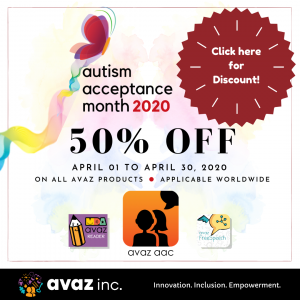 Reading in groups may not benefit all children. Those who are easily distracted can miss key points of the book being read. Children who struggle to decode text also may not be able to keep up with peers. These difficulties can discourage them from reading. Independent reading, on the other hand, gives them enough time to focus on words they are not familiar with. This makes reading a positive experience for them. Reading assistance apps such as MDA Avaz Reader provide reading support and enables children to read independently. Since help is just a tap away, children can choose books that they might have been hesitant to pick. This constant availability of help can be comforting, and make reading a rewarding activity. Here are some of the benefits of independent reading:
Reading in groups may not benefit all children. Those who are easily distracted can miss key points of the book being read. Children who struggle to decode text also may not be able to keep up with peers. These difficulties can discourage them from reading. Independent reading, on the other hand, gives them enough time to focus on words they are not familiar with. This makes reading a positive experience for them. Reading assistance apps such as MDA Avaz Reader provide reading support and enables children to read independently. Since help is just a tap away, children can choose books that they might have been hesitant to pick. This constant availability of help can be comforting, and make reading a rewarding activity. Here are some of the benefits of independent reading:- Cultivates a Reading Habit
- Develops Reading Stamina
- Enhances Comprehension and Fluency
Liking, Sharing, Commenting, and Posting: Benefits of Social Media for AAC users.
 Social media is a dynamic tool that can be used for social activism, movie promotions, business connections, or to simply announce to your followers and friends that you are having a bad day. As the positive and negative impacts of social media are being debated, it is undeniable that it has become an integral part of our lives. While it benefits different people in different ways, social media platforms can provide an especially excellent space for self-expression to AAC users. Here’s a look at some of the benefits of social media for AAC users:
Social media is a dynamic tool that can be used for social activism, movie promotions, business connections, or to simply announce to your followers and friends that you are having a bad day. As the positive and negative impacts of social media are being debated, it is undeniable that it has become an integral part of our lives. While it benefits different people in different ways, social media platforms can provide an especially excellent space for self-expression to AAC users. Here’s a look at some of the benefits of social media for AAC users:Communicative Temptations
Several AAC users are keen on using social media just like their peers do.Young adults, especially, are inclined to know what their friends are up to. They want to comment on their friend’s new profile picture or Instagram story. The thrill of being able to participate in the Facebook, Twitter, and Instagram conversations their friends are having incentivises AAC use for them. The compatibility of high tech AAC systems with messaging platforms has also been a major motivator. AAC users can use the keyboard or use symbols to create messages that can be instantly shared with friends and family.
Societal Participation
Social media has evolved into a place where important discussions about politics, economy, human rights, and other key social issues take place. AAC gives users an opportunity to be part of the social discourse. It allows them to be an active participant in society by letting them register their opinions. It also enables them to become more aware of their social responsibilities which helps them become responsible global citizens.Establishing and Maintaining Relationships
It can get difficult for people with complex communication needs to stay connected to their friends and family. They may miss out on opportunities to engage in conversations due to their speech and language difficulties. People with physical disabilities too may not be able to go out and meet their friends as often as their peers. Social media helps such individuals foster and maintain their relationships by connecting virtually. People with developmental disabilities may have social communication problems which can affect the quality of face-to-face interactions. However, with social media, they may not feel as anxious about saying things that may be considered socially inappropriate. Since they need not worry about picking up social cues, or controlling their responses, they can feel less inhibited while interacting with others.Getting Support
Support groups on social media can be a major help for individuals with communication deficits. For those with accompanying disorders, these groups can be valuable resources for understanding their condition. Although suggestions given by non-experts are frowned upon and cannot be a substitute for expert advice, social media groups can offer emotional and psychological support. Adults with communication difficulties can also find suitable caregivers and get opinions on affordable healthcare plans.Easier Communication
Social media messages are informal and forgiving on spellings and syntaxes. This relieves AAC users with language difficulties of the pressure to construct grammatically accurate sentences. Face-face interaction can also be difficult for those with processing delays. With social media, they get enough time to form their responses without any pressure.Fitting In
Social media can make adolescent and adult AAC users feel included. Communication deficits can make them feel alienated and they can become reclusive. Social media gives them a way to engage with others. Since that’s the way others around them seem to be communicating for the most part, AAC users can feel like they belong while using social media.Controlling the Narrative
 Increased social media visibility of people with disabilities helps them take control of their representation in media and society at large. It helps them present a more accurate picture of their various facets, instead of being defined by their disabilities. People with complex communication needs may not be able to speak. But they can express their humour with memes, convey their protest with hashtags, and show off their multidimensional personalities on social media. AAC users regularly engaging in social media helps in educating others about their rights. It can also spread awareness about disabilities and promote acceptance. Although social media has several advantages, it has its pitfalls that we must carefully consider. It can discourage real-life engagement and result in a lack of personal connection with others. Catfishing and other cybersecurity threats also need to be managed to avoid being duped. AAC users must have necessary privacy settings to avoid having to deal with vile online comments. Since young AAC users may be exposed to more social media risks, parents must ascertain if they are ready for it. They may also have to regularly monitor their social media usage patterns, at least at the outset, to buffer against or prevent negative experiences. Caregivers must enable young AAC users to engage on social media with caution and a bias for self care. Discreet use of social media can provide AAC users a channel for expressing themselves. It can also give them more independence in communication. So, AAC users must be educated and supported so that they can make their voice heard in issues that matter to them.
Increased social media visibility of people with disabilities helps them take control of their representation in media and society at large. It helps them present a more accurate picture of their various facets, instead of being defined by their disabilities. People with complex communication needs may not be able to speak. But they can express their humour with memes, convey their protest with hashtags, and show off their multidimensional personalities on social media. AAC users regularly engaging in social media helps in educating others about their rights. It can also spread awareness about disabilities and promote acceptance. Although social media has several advantages, it has its pitfalls that we must carefully consider. It can discourage real-life engagement and result in a lack of personal connection with others. Catfishing and other cybersecurity threats also need to be managed to avoid being duped. AAC users must have necessary privacy settings to avoid having to deal with vile online comments. Since young AAC users may be exposed to more social media risks, parents must ascertain if they are ready for it. They may also have to regularly monitor their social media usage patterns, at least at the outset, to buffer against or prevent negative experiences. Caregivers must enable young AAC users to engage on social media with caution and a bias for self care. Discreet use of social media can provide AAC users a channel for expressing themselves. It can also give them more independence in communication. So, AAC users must be educated and supported so that they can make their voice heard in issues that matter to them. Avaz Adda: Play, Learn, Communicate!
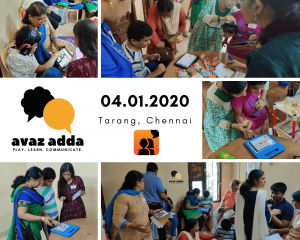 The Idea Behind Avaz Adda
The Idea Behind Avaz Adda
Let's get to the name first. Avaz Adda!! The Indian word ‘Adda’, which found its way to the Oxford English dictionary, means ‘a place where people gather for conversation’. There isn’t a better word that captures the essence of what we intended to do with Avaz Adda. We simply wanted to create a space where AAC users can converse and interact with each other. Between speech therapy, school, and other daily activities, children rarely get time to have an informal conversation with fellow AAC users. Avaz Adda gave them an opportunity to hang out with other AAC users, observe them, interact with them, and pick up valuable skills along the way. We believe that there’s a lot children can learn from being around other AAC users. Many of these learnings may not even be immediately apparent, but are vital nevertheless. Most importantly, such interactions can normalize AAC use, and give AAC users a sense of belonging. Our First Avaz Adda - The First of Many!
Lalitha Nagarajan, our Director of Community Relations, spearheaded the arrangements, meticulously putting together a list of activities where we could incorporate AAC use while making it fun for the children. The Avaz team ensured that there was no stone left unturned to ensure that the event was exciting for the children. [caption id="attachment_3883" align="alignright" width="372"] Avaz low tech board[/caption] Parents were provided with an outline of the planned activities beforehand so that they could prepare their children for the event. The venue was easily accessible. Arrangements were made for an assigned safe space for children to calm themselves in case they got overwhelmed. Low tech boards printed out from the Avaz app were kept handy at various locations so that no communication opportunity was missed.
Avaz low tech board[/caption] Parents were provided with an outline of the planned activities beforehand so that they could prepare their children for the event. The venue was easily accessible. Arrangements were made for an assigned safe space for children to calm themselves in case they got overwhelmed. Low tech boards printed out from the Avaz app were kept handy at various locations so that no communication opportunity was missed.Avaz Adda Activities and AAC Strategies
Since there were a few AAC beginners, there was a brief pre-event session explaining AAC best practices for prompting and modelling. Once we ensured that all the Avaz AAC systems were customized and ready, we kickstarted the event with our first activity. Here is the list of all the fun activities and a brief view on the strategies behind each activity: About Me: [caption id="attachment_3868" align="alignright" width="365"]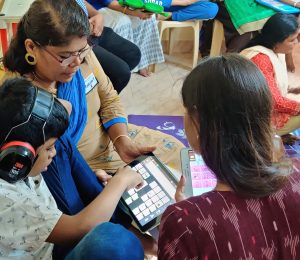 Avaz AAC users introducing themselves to unfamiliar communication partners[/caption] This ice breaker activity was designed for the AAC users to introduce themselves to others. The children had conversations with Avaz volunteers using their respective AAC apps. Here are the AAC strategies behind this activity
Avaz AAC users introducing themselves to unfamiliar communication partners[/caption] This ice breaker activity was designed for the AAC users to introduce themselves to others. The children had conversations with Avaz volunteers using their respective AAC apps. Here are the AAC strategies behind this activity - Generalization of Skills
- Expansion of Communicative Functions (Pragmatics)
- Answering Wh questions such as ‘What’ and ‘Who’.
- Greeting people
- Sharing information
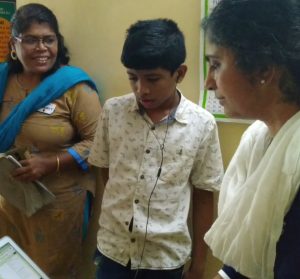 Avaz AAC user enjoying his favourite music played on his request[/caption] For this activity, each child’s favourite music was played on their request. As and when they requested a song using the Avaz AAC app, it was played over their headphones by an Avaz team member. From devotional songs to Beethoven, from flashy Indian movie numbers to classical renditions, the musical tastes of the children were truly diverse. It underscored the fact that each child was their own person, with their individual preferences, ideas, opinions, and thoughts. Here are some of the AAC strategies at play in this activity.
Avaz AAC user enjoying his favourite music played on his request[/caption] For this activity, each child’s favourite music was played on their request. As and when they requested a song using the Avaz AAC app, it was played over their headphones by an Avaz team member. From devotional songs to Beethoven, from flashy Indian movie numbers to classical renditions, the musical tastes of the children were truly diverse. It underscored the fact that each child was their own person, with their individual preferences, ideas, opinions, and thoughts. Here are some of the AAC strategies at play in this activity.- Communicative Temptations
- Expansion of Communicative Functions (Pragmatics):
- Choice making (expressing a preference)
- Requesting
- Commenting
- Asking Questions
- Rejecting - STOP
- Pursuing an activity - MORE
 Children shopping using Avaz AAC[/caption] The children had a chance to play ‘shopkeeper’ and ‘customer’ with the Avaz team guiding them through the activity. This was one of the activities that the children couldn’t get enough of. They used their AAC apps to purchase the items on their list and got to use real money for the transactions. The parents too enjoyed watching their children fill up their totes while learning to shop for essential things such as personal care items and groceries. Here are some of the AAC strategies behind this activity.
Children shopping using Avaz AAC[/caption] The children had a chance to play ‘shopkeeper’ and ‘customer’ with the Avaz team guiding them through the activity. This was one of the activities that the children couldn’t get enough of. They used their AAC apps to purchase the items on their list and got to use real money for the transactions. The parents too enjoyed watching their children fill up their totes while learning to shop for essential things such as personal care items and groceries. Here are some of the AAC strategies behind this activity.- Life Skills
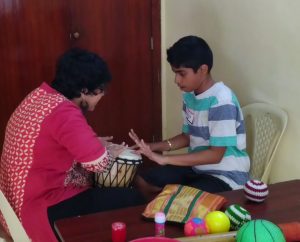 Child playing rhythmic patterns on the Djembe[/caption] Sensory Play Zone Just like we had anticipated, this was an activity that children were very thrilled to participate in. They had fun playing with the sensory toys which they requested using their AAC apps. While some enjoyed blowing bubbles, others showed interest in playing with soft, crocheted balls of various sizes. The Djembe, especially, was a huge hit among the children who were keen to try their hands at playing the musical instrument. There was also an opportunity for interactive play with children taking turns blowing bubbles, and playing rhythmic patterns on the Djembe. Here is why sensory play is important for children with special needs:
Child playing rhythmic patterns on the Djembe[/caption] Sensory Play Zone Just like we had anticipated, this was an activity that children were very thrilled to participate in. They had fun playing with the sensory toys which they requested using their AAC apps. While some enjoyed blowing bubbles, others showed interest in playing with soft, crocheted balls of various sizes. The Djembe, especially, was a huge hit among the children who were keen to try their hands at playing the musical instrument. There was also an opportunity for interactive play with children taking turns blowing bubbles, and playing rhythmic patterns on the Djembe. Here is why sensory play is important for children with special needs:- Emotional Regulation and Stimulation
 Avaz Adda Activity checklist with star stickers for positive reinforcement after successful completion of each activity[/caption] Once we were done with all the activities, and the children were gleefully devouring the snacks (that they had requested with their AACapps), we spoke to the parents of Avaz AAC users. We were delighted to hear the nice things they had to say about the event. “Very useful and informative. Learnt screen arrangements and modelling.” “ I was really scared to join the workshop since the place and persons were new to my child. But at the end I was really happy. We had a good time. Thanks to Avaz team .Looking forward for more such workshops” “Thanks Lalitha and Avaz Team for the initiative and ground work. Thanks friends for making it, it's really a very good exposure.” For a few children, this was the first time they had used Avaz AAC app to interact with a communication partner other than their parent or therapist. While there was some hesitation initially, it was promising to see how they were willing to communicate with others with a little encouragement. This proved that given the right support, AAC users can become confident about using AAC as their mode of communication. More than all these positive signs for AAC use, the happy smiles and joyous laughter at the very first Avaz Adda was what meant the most to our Team! Here are a bunch of photos from Avaz Adda that have captured all the excitement and fun [metaslider id=4103]
Avaz Adda Activity checklist with star stickers for positive reinforcement after successful completion of each activity[/caption] Once we were done with all the activities, and the children were gleefully devouring the snacks (that they had requested with their AACapps), we spoke to the parents of Avaz AAC users. We were delighted to hear the nice things they had to say about the event. “Very useful and informative. Learnt screen arrangements and modelling.” “ I was really scared to join the workshop since the place and persons were new to my child. But at the end I was really happy. We had a good time. Thanks to Avaz team .Looking forward for more such workshops” “Thanks Lalitha and Avaz Team for the initiative and ground work. Thanks friends for making it, it's really a very good exposure.” For a few children, this was the first time they had used Avaz AAC app to interact with a communication partner other than their parent or therapist. While there was some hesitation initially, it was promising to see how they were willing to communicate with others with a little encouragement. This proved that given the right support, AAC users can become confident about using AAC as their mode of communication. More than all these positive signs for AAC use, the happy smiles and joyous laughter at the very first Avaz Adda was what meant the most to our Team! Here are a bunch of photos from Avaz Adda that have captured all the excitement and fun [metaslider id=4103]A Fun, Exciting Read for Children: ‘Trey the Chef’
 In today's post, we want to talk about 'Trey the Chef', a lovely book written by Kira Parris-Moore. This book is inspired by the cooking adventures of the author's son Trey, a curious and playful boy with autism. The riveting story of Trey as a celebrated chef attempts to drive home the point that an autism diagnosis does not necessarily mean a lack of talent or intelligence. Children with autism may struggle with several aspects of their life including social communication and sensory responses.They may also have repetitive behaviours and obsessive tendencies. However, it is wrong to presume that these behaviours can only be detrimental. With the right kind of support, children with autism can overcome their challenges and channel their obsession to hone their individual talents. Trey, for instance, loves the culinary art. Much before he tried his hand at cooking, he enjoyed watching family members put together delicious meals in the kitchen. He diligently pursues his interest in cooking by watching several cooking shows. He is fascinated by elaborate recipes and exciting cooking techniques. His family actively encourages his interest by enrolling him in a cooking class. Focusing on his strengths gives Trey a chance to explore his creativity and potential. It also boosts his self-esteem and motivates him to get better at the skill of his choice.
In today's post, we want to talk about 'Trey the Chef', a lovely book written by Kira Parris-Moore. This book is inspired by the cooking adventures of the author's son Trey, a curious and playful boy with autism. The riveting story of Trey as a celebrated chef attempts to drive home the point that an autism diagnosis does not necessarily mean a lack of talent or intelligence. Children with autism may struggle with several aspects of their life including social communication and sensory responses.They may also have repetitive behaviours and obsessive tendencies. However, it is wrong to presume that these behaviours can only be detrimental. With the right kind of support, children with autism can overcome their challenges and channel their obsession to hone their individual talents. Trey, for instance, loves the culinary art. Much before he tried his hand at cooking, he enjoyed watching family members put together delicious meals in the kitchen. He diligently pursues his interest in cooking by watching several cooking shows. He is fascinated by elaborate recipes and exciting cooking techniques. His family actively encourages his interest by enrolling him in a cooking class. Focusing on his strengths gives Trey a chance to explore his creativity and potential. It also boosts his self-esteem and motivates him to get better at the skill of his choice.  The story of Trey’s exceptional culinary skills serves as a great motivator for all children. It also reminds parents that every child is capable of excellence if they are adequately supported. Get your copy of ‘Trey the Chef’ now at Books2inspire.com. Reading stories such as 'Trey the Chef' enriches a child’s life by stimulating their imagination. For readers who struggle with fluency or comprehension, assistive apps such as MDA Avaz Reader can help discover the joy of reading. By offering reading support such as picture, syllable and word family hints, the app can be a digital reading buddy that motivates a child to expand their vocabulary and enhance their language skills. About the Author: Kira Parris-Moore is a licensed Marriage and Family therapist, with years of experience in the Mental Health field. A mother of two young boys, she is passionate about helping children with developmental and behavioural issues. She loves poetry and has a knack for creative writing. She hopes that her story will provide inspiration to several families that are struggling to deal with the challenges of their children with special needs.
The story of Trey’s exceptional culinary skills serves as a great motivator for all children. It also reminds parents that every child is capable of excellence if they are adequately supported. Get your copy of ‘Trey the Chef’ now at Books2inspire.com. Reading stories such as 'Trey the Chef' enriches a child’s life by stimulating their imagination. For readers who struggle with fluency or comprehension, assistive apps such as MDA Avaz Reader can help discover the joy of reading. By offering reading support such as picture, syllable and word family hints, the app can be a digital reading buddy that motivates a child to expand their vocabulary and enhance their language skills. About the Author: Kira Parris-Moore is a licensed Marriage and Family therapist, with years of experience in the Mental Health field. A mother of two young boys, she is passionate about helping children with developmental and behavioural issues. She loves poetry and has a knack for creative writing. She hopes that her story will provide inspiration to several families that are struggling to deal with the challenges of their children with special needs. Causes, Types, and Management of Stimming Behaviours in Autism
What is stimming?
The term 'stim' is an abbreviation of self-stimulatory. It refers to the repetition of body movements, words, sounds, or movement of objects. Stimming, also called stereotypic behaviour is one of the most obvious characteristics of developmental disabilities, and is one of the diagnostic criteria for autism. How is Stimming Different in those with Autism?
How is Stimming Different in those with Autism?
Neurotypical individuals too can engage in stimming. Biting nails, twirling hair, drumming fingers on a table or jiggling legs are subtler forms of stimming seen in most people. The main differences between typical stimming and stimming in people with autism lie in the quantity, type and the obviousness of the stereotypic behaviours. Behaviours can also be labelled as stimming based on whether they are socially or culturally acceptable. Fidgeting with an object while you are anxious or bored can be considered a more tolerable behaviour than flapping hands or rocking the whole body back and forth. Moreover, people with autism may not be adept at picking up social cues and gauging whether their behaviours are being disruptive. For instance, a neurotypical individual can stop tapping their foot if they notice the negative attention it draws. Those on the spectrum may not only be unaware but also may have less control over their stimming.What Causes Stimming?
The exact causes of stimming are still unknown. There are a variety of emotions that can trigger stimming. Children with autism can stim when they are excited or happy. Boredom, fear, stress and anxiety can also trigger stimming. The intensity and type of stimming can vary from individual to individual. For some, the behaviours may be mild and occasional, while others may engage in stimming more frequently. Some experts are of the opinion that stimming can be a way to stimulate the sensory system when there is a lack of adequate sensory input. Others suggest that people with autism may use stimming as a diversionary tactic for relaxation when they are overwhelmed.Types of Stimming Behaviours
Stimming can involve all the senses including visual, auditory, balance and movement, touch, smell and taste. Here are some of the common types of stimming: Staring at lights. Repetitive blinking. Shaking fingers in front of the eyes. Staring at spinning objects. Gazing at objects such as screen savers ceiling fans. Turning lights on and off. Hand-flapping. Eye tracking. Peering from the corners of the eyes. Flipping through books.
Hand-flapping. Eye tracking. Peering from the corners of the eyes. Flipping through books.- Auditory
- Tactile
- Olfactory
- Proprioception
Should Stimming Be Controlled?
Stimming can be a harmless behaviour that people with autism use for self-regulation. It can help them reduce their anxiety. It can also be a way to calm themselves when they experience a sensory overload. So, many feel that stimming should not be controlled because it can take away a person’s coping mechanism for stressful situations.Understanding Sensory Seeking and Avoiding Behaviours in Autism
 Sensory challenges can cause children to throw tantrums[/caption]
Sensory challenges can cause children to throw tantrums[/caption]Significance of The Eight Senses
If we take a moment to study the world around us, we can notice the different sensory stimuli we are constantly exposed to. These senses dictate how we experience our environment, and help us interpret the space we inhabit. Here are the eight senses and the information they provide about our surroundings:- Visual
- Auditory
- Tactile
- Gustatory
- Olfactory
- Vestibular System
- Proprioception
- Interoception
 Sensory Seeking Behaviours
Sensory Seeking Behaviours
Some individuals with autism may have under-sensitivity, and can seek out sensory input constantly. They can appear to be excitable and very active. They may look for intense sensations but can get disorganized due to random sensory inputs. Their quest for sensory stimulation can make them look clumsy and disruptive. Here are some of the seeking behaviours that can be seen in people with autism:- Visual
- Auditory
- Tactile
- Gustatory and Olfactory
- Vestibular
- Proprioceptive
 Sensory Avoiding Behaviours
Sensory Avoiding Behaviours
Some individuals with autism may have oversensitivity. They can have exaggerated responses, and can respond too much or too soon. They can be resistant to change and may prefer sticking to familiar places and activities. Their avoidance behaviours are a way to reduce the intensity of stimulation they receive. They can have rituals and fixations that help create a predictable environment for them. Here are some avoidance behaviours that can be seen in people with Autism:- Visual
- Auditory
- Tactile
- Gustatory and Olfactory
- Vestibular
- Proprioceptive
Sensory Issues vs Behavioural Issues
Sensory challenges can cause people with autism to indulge in what can be perceived as problem behaviours. Some children may flee a room when they are overstimulated, while others can throw tantrums. Analyzing the cause of such behaviours and identifying triggers can help caregivers to support the child in coping with their sensory issues. Sensory seeking and avoidance behaviours can also interfere with a child’s regular activities and social interactions. Parents and teachers can give the children a ‘sensory diet’, which is a set of activities designed to provide necessary sensory input. Regular sensory diet routines can not only help the child focus on productive tasks, but also help them become more self-aware and confident.Here’s a Fun Way to Engage AAC Users
- Less and more - hyperlinked to the word more
- Turn taking - hyperlinked to the word turn
- Waiting in line - hyperlinked to the word wait
- Same and different - hyperlinked to the word different
- Emotions - hyperlinked to the word sad
Why Should You Prioritize Reading Fluency in Children?
 What is Reading Fluency?
What is Reading Fluency?
Contrary to popular belief, fluency does not necessarily indicate reading speed alone. A child can read fast without being fluent. So, what does fluency really mean? There are multiple, interdependent components to fluency, such as the ability to read with accuracy, reading rate, and meaningful expression. - Accuracy is reading without making too many mistakes.
- Reading rate is how fast your child reads
- Expression is reading with the right stress and intonation.
Why Focus on Fluency?
So what if the child doesn’t read fast? How does it matter if they make a few mistakes while reading? What difference does it make if they don’t read with accurate expression? Fluency has a much bigger impact on a child’s overall reading experience than we might think. When children struggle with reading, they are less likely to enjoy it. This can lead to them look at reading as more of a chore than a fun activity. Fluency also significantly affects reading comprehension. The child might have trouble with making inferences, predictions, and conclusions accurately. Inadequate comprehension also means that the child is unable to make accurate interpretation and evaluation of text. This results in them providing incorrect responses to the text they read.Can Reading More Lead to Fluency?
It’s definitely a good idea to encourage children to read more. For children who do not have trouble decoding text, reading more can immensely improve their fluency. However, for those who have underlying difficulties, more reading may not be an optimal solution. It’s more important to address the root cause of their problems. According to experts, it all boils down to the mental energy spent in reading. Children who spend most of their mental power decoding text might have very little mental capacity left for comprehension. So, reading more without appropriate intervention only results in more time dedicated to decoding text, with very little scope for improvement in comprehension. [caption id="attachment_3763" align="alignright" width="300"] A reading buddy can motivate a child to read[/caption]
A reading buddy can motivate a child to read[/caption]What can You do to Develop Your Child’s Fluency?
Here are a few strategies that can be used to help children become fluent in reading.- Reading aloud to a child and having the child read along.
- Breaking larger text into smaller chunks.
- Encourage the child to track the words they read with a finger so that they don’t skip words.
- Assigning a reading buddy so that the child gets the help they need.
- [caption id="attachment_3762" align="alignright" width="300"]
 Parent assisted reading can help a child become fluent[/caption] Making sure that the child understands the meaning of each word.
Parent assisted reading can help a child become fluent[/caption] Making sure that the child understands the meaning of each word.
- Providing visual representation which helps young children understand the meaning of words better.
- Teaching children to identify phrase boundaries.
- Building a child’s vocabulary. The more words a child is familiar with, the less they get stuck with new words.
- Repeated reading can help the child notice details they may have missed during earlier reading attempts.
The Role of Assisted Reading
Parent assisted reading, peer assisted reading or technology assisted reading can play a major role in improving fluency and comprehension. Assistive technologies, especially, can amplify opportunities for fluency development primarily because of their 24x7 availability. Moreover, the availability of a wide range of reading supports in these technologies pave the way for children to read without difficulty. [metaslider id=3766] Assistive reading apps such as MDA Avaz Reader enable children to read independently. This promotes their confidence and serves as a great motivator. Children find reading to be a positive experience and tend to read more, because they have a digital reading buddy with them all the time. The resultant reading fluency tremendously improves reading comprehension, laying the foundation for their academic success and knowledge expansion.Looking Ahead- 2020

 I would like to begin 2020 with a note of gratitude. Every member of the Avaz team is humbled to have been given an opportunity to play a small yet empowering role in each of our user’s lives. We are eternally grateful to the community of users, parents, educators, SLPs and other caregivers spread across geographies, that believes in us and keeps inspiring us. As Avaz Inc. continues its journey into the new decade, the entire team and I promise that YOU and your priorities will always be at the center of all our work. Be it new features, updates or new product lines, you will forever be our constant.
I would like to begin 2020 with a note of gratitude. Every member of the Avaz team is humbled to have been given an opportunity to play a small yet empowering role in each of our user’s lives. We are eternally grateful to the community of users, parents, educators, SLPs and other caregivers spread across geographies, that believes in us and keeps inspiring us. As Avaz Inc. continues its journey into the new decade, the entire team and I promise that YOU and your priorities will always be at the center of all our work. Be it new features, updates or new product lines, you will forever be our constant.What’s in store for 2020?
As we begin the year with renewed energy and an even stronger sense of focus, here is what we as a team are envisioning for 2020.Breaking Down Accessibility Barriers
Avaz is determined to ensure that language is no longer an obstacle that restricts an individual from expressing themselves. We will continue to work towards providing users access to AAC in multiple languages. We already support 15 on Avaz AAC and will add new ones soon. Did you know that we added 2 very contrasting languages in 2019 - Faroese and Bangla? This is what we love to do and are good at :) We partner with folks from across the globe and work together to create Avaz AAC - which will provide a voice for thousands of people in the language that their loved ones speak. Drop me a note to collaborate with us to support a new language - narayananr@avazapp.com In late 2018, we released the Avaz AAC for Android phones and people loved it. Parents could use it as a companion app while their child used the tablet. Or they could trial Avaz on an Android phone before investing in an expensive tablet. One of our most frequent customer requests has been for an iPhone version of Avaz. I am very excited to announce that we will be releasing Avaz for iPhones in early 2020.Keep getting better everyday
In 2020, and throughout this decade, we will continue to add exciting features to our set of products. In 2019, we released our first product in the space of assistive reading – MDA Avaz Reader. We have received great feedback from our users and will continue to add some state of the art speech and analytics related features to the product in 2020. We have a great set of small yet handy features coming out soon for Avaz AAC – thanks entirely to customers and experts who have shared feedback with us over the years. Keep watching this space for more on that! Leave us a comment if you would like to tell us what we can improve in our products.Empowering Parents as Communication Partners
Communication partner training has been a central focus at Avaz for the last few years and will continue to be so. We are getting closer to an inflection point - a day when modeling AAC will not be “jargon” any more. We did weekly webinars talking about communication and Avaz this year and it was heartwarming to see the response. It helped us spread the word about AAC in the remotest of places! It only strengthened our resolve to scale this further in 2020. Experts play a critical role in spreading the word about AAC in geographies where the awareness is still growing. Hence, collaborating with experts like Lauren Enders, 2020 will see us sharing knowledge in different ways with parents, educators and speech therapists.Beyond AAC
Our vision is to create a world where every learner is empowered to fulfill their entire potential. Having started our journey in the assistive technology space with the Avaz AAC app, we have evolved our product portfolio with newer products over the years. Our portfolio now includes Avaz FreeSpeech for language development, Communication Adventures for communication partner training and Avaz Reader for helping children with reading disabilities. This journey has just started. This year and the coming decade will see many further advances in technology and product development from the Avaz Inc. In 2020, we are actively seeking collaborators to solve some of the hairiest problems in the special education space. Drop me a note here - narayananr@avazapp.com<<My Wishlist to Make 2020 More Inclusive>>
1.Busting myths like “Will AAC impact Speech development?” once and for all! The research says – Definitely No. AAC myths like these are so 2019! 2.An honest conversation about screen time – Yes, WHO has recommended limited screen time for young children. However, if a child can’t communicate their thoughts, their needs – isn’t it unfair to deny them a voice on the assumption that they might get “addicted” to it? Besides, research suggests that not all screen time is bad. It’s important that we distinguish between active screen time which may have positive effects, when compared to passive screen time where children are sedentary. AAC falls under active screen time because there is two-way communication, interaction with a communication partner, and language use. It leads to children being more confident – because they can communicate what they want! They are able to access knowledge the way that they understand best. This is why AAC experts believe that screen time limits should not apply to AAC systems. However, the concern of “addiction” is real. And there are ways in which this addiction can be mitigated. - Let’s not throw the baby out with the bathwater. 3.Can we see more people using AAC in public places? Events like these should be mundane and should not deem a second glance! - 4.India embracing assistive technology to empower children with learning disabilities! The RPwD Act 2016 has been a step forward for India. It will be fantastic to see new policies being crafted and funding being allocated for assistive technologies. The Inclusive Education policies under the Samagra Shiksha Abhiyan are also a great addition. There are encouraging signs with various state governments in India showing interest in including technology interventions to make schools inclusive. We are looking to partner with the government to create policies that will address challenges in the assistive technology space. Here’s wishing you and your family a wonder-filled, adventurous and healthy 2020!! Love Narayanan ________________________________________________ Narayanan “Nadu” Ramakrishnan is CEO, Avaz Inc. He's deeply passionate about making technology work for inclusion and access. A compulsive collector of stationery, lover of long road trips, biryani and podcasts, when not busy coding. Follow him on LinkedIn
Narayanan “Nadu” Ramakrishnan is CEO, Avaz Inc. He's deeply passionate about making technology work for inclusion and access. A compulsive collector of stationery, lover of long road trips, biryani and podcasts, when not busy coding. Follow him on LinkedIn The 2019 Avaz Round-Up
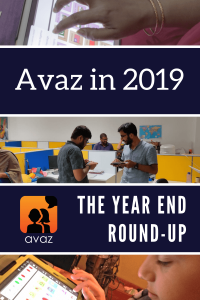 2019 has been a truly eventful year for Avaz. As the year draws to a close, it's time to reflect on all that transpired in the past 12 months. We may be a tech savvy bunch, but our focus is more on the human impact our technology solutions create. This year too, we strove to create better products that meet the high standards our customers have come to expect from us. This customer-centric approach is what we believe makes Avaz a cut above the rest in the AAC & the Special Education tech space. Here are the highlights of year 2019 for Avaz Inc.:
2019 has been a truly eventful year for Avaz. As the year draws to a close, it's time to reflect on all that transpired in the past 12 months. We may be a tech savvy bunch, but our focus is more on the human impact our technology solutions create. This year too, we strove to create better products that meet the high standards our customers have come to expect from us. This customer-centric approach is what we believe makes Avaz a cut above the rest in the AAC & the Special Education tech space. Here are the highlights of year 2019 for Avaz Inc.:New Products, Strengthening Partnerships
Avaz Inc. is a huge proponent of ensuring AAC vocabulary access in users’ own native languages. This year, we were thrilled to release Avaz in two more languages, namely Bangla and Faroese. We also launched MDA Avaz Reader, a reading assistance app that enables children to read better. This is our endeavour to provide reading practice and support to children so that they can discover the joy of reading.- Avaz AAC Bangla
 Our team visited Bangladesh in July 2019. Here we realized the urgent need for a Bangla app that allowed children with complex communication needs to communicate in the language their parents and teachers spoke. We were also inundated with requests from special educators and speech pathologists in Bangladesh for an AAC app with Bangla vocabulary. We released Avaz Bangla in November 2019 to address the needs of Bangla people with communication deficits. Avaz Bangla comes with an extensive Bangla vocabulary that reflects the culture and traditions of the region. It has a powerful Bangla keyboard that equips people with communication challenges to communicate in their native language. This not only expands their communication possibilities, but also breaks down barriers to their literacy. We conducted several training sessions in Bangla speaking regions to educate all the AAC stakeholders including parents, special educators, and speech pathologists. We have a lot more planned in the upcoming months to illustrate the benefits of AAC, including live demos and webinars.
Our team visited Bangladesh in July 2019. Here we realized the urgent need for a Bangla app that allowed children with complex communication needs to communicate in the language their parents and teachers spoke. We were also inundated with requests from special educators and speech pathologists in Bangladesh for an AAC app with Bangla vocabulary. We released Avaz Bangla in November 2019 to address the needs of Bangla people with communication deficits. Avaz Bangla comes with an extensive Bangla vocabulary that reflects the culture and traditions of the region. It has a powerful Bangla keyboard that equips people with communication challenges to communicate in their native language. This not only expands their communication possibilities, but also breaks down barriers to their literacy. We conducted several training sessions in Bangla speaking regions to educate all the AAC stakeholders including parents, special educators, and speech pathologists. We have a lot more planned in the upcoming months to illustrate the benefits of AAC, including live demos and webinars.- Avaz AAC Faroese
 Avaz app with Faroese vocabulary[/caption] Avaz is a firm believer that no individual should be deprived of the opportunity to realize their full potential due to their disabilities. Nor should lack of access to adequate resources be an obstacle. So, when we learnt about the requirement for an AAC app in Faroese, we felt privileged to be part of the AAC journey in Faroe Islands, a North Atlantic territory with a population of around 51,000 people. We released Avaz in Faroese in August 2019, with the support of assistive technology enthusiasts and disability inclusion advocates from Faroe Islands and Denmark. We worked closely with the Faroese team to create extensive vocabulary that included appropriate gender inflections, and other nuances of the Faroese language. We are excited to see people having communication deficits in the region find their voice and express themselves through the Avaz app.
Avaz app with Faroese vocabulary[/caption] Avaz is a firm believer that no individual should be deprived of the opportunity to realize their full potential due to their disabilities. Nor should lack of access to adequate resources be an obstacle. So, when we learnt about the requirement for an AAC app in Faroese, we felt privileged to be part of the AAC journey in Faroe Islands, a North Atlantic territory with a population of around 51,000 people. We released Avaz in Faroese in August 2019, with the support of assistive technology enthusiasts and disability inclusion advocates from Faroe Islands and Denmark. We worked closely with the Faroese team to create extensive vocabulary that included appropriate gender inflections, and other nuances of the Faroese language. We are excited to see people having communication deficits in the region find their voice and express themselves through the Avaz app.- MDA Avaz Reader
 Download exciting stories that motivate young children to read[/caption] Avaz created MDA Avaz Reader in collaboration with the reputed Madras Dyslexia Association (MDA), which has more than twenty years of experience in dyslexia education. MDA Avaz Reader is a reading assistance app that promotes independent reading in children of all ages, and enables them to read better. Reading regularly enriches a child’s life by stimulating their imagination and enhancing their knowledge on various topics. MDA Avaz Reader has exciting stories with rich vocabulary and captivating images, that motivate young children to read. It also offers reading support such as syllable hints, rhyming hints and pronunciation help so that readers do not get stuck on unfamiliar words. Reader also has the option to import PDF or add images of text so that the child can get help with reading texts they are currently studying. Fluent readers typically perform well in academics because reading is an essential component of classroom instruction and standardized tests. MDA Avaz reader incorporates proven strategies that help develop reading fluency and reading comprehension in children, setting them up for academic success.
Download exciting stories that motivate young children to read[/caption] Avaz created MDA Avaz Reader in collaboration with the reputed Madras Dyslexia Association (MDA), which has more than twenty years of experience in dyslexia education. MDA Avaz Reader is a reading assistance app that promotes independent reading in children of all ages, and enables them to read better. Reading regularly enriches a child’s life by stimulating their imagination and enhancing their knowledge on various topics. MDA Avaz Reader has exciting stories with rich vocabulary and captivating images, that motivate young children to read. It also offers reading support such as syllable hints, rhyming hints and pronunciation help so that readers do not get stuck on unfamiliar words. Reader also has the option to import PDF or add images of text so that the child can get help with reading texts they are currently studying. Fluent readers typically perform well in academics because reading is an essential component of classroom instruction and standardized tests. MDA Avaz reader incorporates proven strategies that help develop reading fluency and reading comprehension in children, setting them up for academic success. - Avaz AAC in Tamilnadu
AAC Awareness Activities:
Even with all the advancements in AAC technology, it is disheartening to see that several people with complex communication needs do not get to realize their full potential. There are three main underlying causes for this:- A lack of awareness about AAC
- Unfounded fears and unsubstantiated myths about AAC
- Inadequate access to AAC resources
- Webinar Sessions
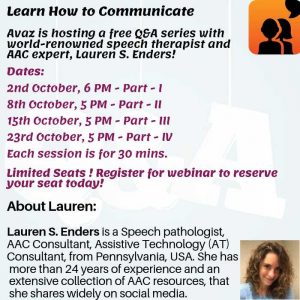 This year, we had a 4- part webinar series with Lauren.S.Enders, world-renowned speech therapist and AAC expert. The well-received webinars contain a wealth of information, with practical examples, and demonstrations of AAC use. Lauren did a splendid job of busting AAC myths, addressing the concerns of AAC beginners, and explaining vital AAC strategies.
This year, we had a 4- part webinar series with Lauren.S.Enders, world-renowned speech therapist and AAC expert. The well-received webinars contain a wealth of information, with practical examples, and demonstrations of AAC use. Lauren did a splendid job of busting AAC myths, addressing the concerns of AAC beginners, and explaining vital AAC strategies. - AAC Awareness Workshops
 We conducted several Avaz workshops across India to spread AAC awareness. We trained parents, special educators, and users in many special schools across India including in Bangalore, Noida, Delhi, Mumbai, Kerala etc. Here are some of the prominent events we were privileged to be part of in 2019:
We conducted several Avaz workshops across India to spread AAC awareness. We trained parents, special educators, and users in many special schools across India including in Bangalore, Noida, Delhi, Mumbai, Kerala etc. Here are some of the prominent events we were privileged to be part of in 2019:- We were part of AAC awareness week events conducted in All India Institute of Speech and Hearing (AIISH), Mysuru during October. We spent an entire day emphasizing the benefits of AAC. We had live interactive sessions with parents, who were thrilled to participate in all the activities. Parents were split into teams and given a few communication scenarios. They were then asked to create relevant folders and icons in Avaz for the same. Parents showed great enthusiasm taking the stage to explain how effortlessly they were able to customize Avaz.
- We conducted workshops for students and members of faculty in several organizations including NIEPMD(Chennai), SR Chandrashekar Institute of Speech and Hearing (Bangalore), CMC (Vellore), V-Excel (Chennai) etc.
- We trained Speech therapists from Speech clinics / organisations like NISHTA (Chennai), Magpie (Bangalore), CFORAT and Therapy Abroad (California, USA).
- We attended the EMPOWER Conference at Delhi where we reiterated the importance of training parents and caregivers for successful implementation of AAC.
App Updates
It has always been our quest to do better, not only for ourselves, but especially for our incredible customers. We constantly look to make improvements so that Avaz users make the best use of the app. Avaz AAC app now displays saved sentences assigned to keys so that the user can easily load these saved sentences. This ensures quick access to frequently used sentences and encourages users to employ them in common scenarios. We have also included an auto clear option so that messages get cleared from the message box after they are spoken out. This speeds up communication without the user having to manually delete previous message before constructing a new one. As we approach yet another exciting year, it’s time to celebrate our successes because they reinforce our faith in team work and diligence. It is also time to look back at things that didn't go according to plan. We choose to remember these as lessons learnt, and forge ahead based on the knowledge gained. Most importantly, it is time for gratitude. We are grateful for your continued support and express our thanks for your constructive feedback. Your confidence in us gives us the impetus to push our boundaries and create even better technologies that enable inclusion, access, dignity, equality & empowerment.The Importance of Classroom Accommodations for Students with Dyslexia
Instructional Materials
 Assistive apps such as MDA Avaz Reader can improve comprehension[/caption] Other ideas:
Assistive apps such as MDA Avaz Reader can improve comprehension[/caption] Other ideas: - Using large font sizes and increasing word spacing of printed text.
- Using audiobooks during reading sessions.
- Using alphabet strips for reinforcing alphabet recognition.
- Providing additional practice activities such as educational games.
- Using number formation prompt strips for independent writing
- Using assistive tools including reading apps such as MDA Avaz Reader, and speech-to-text software to help with writing.
- Providing books for all levels of reading, on varied topics of interest.
Assignments
[caption id="attachment_3640" align="alignright" width="446"] Highlighting keywords helps students focus on important details[/caption] Assignments are essential to reaffirm classroom learning and gauge how much the child has learned on an ongoing basis. Here are some of the ways in which dyslexic students can be supported to do their assignments -
Highlighting keywords helps students focus on important details[/caption] Assignments are essential to reaffirm classroom learning and gauge how much the child has learned on an ongoing basis. Here are some of the ways in which dyslexic students can be supported to do their assignments - - Providing samples of completed assignments to show them what needs to be done.
- Providing a rubric explaining how the assignment will be graded.
- Providing a glossary of words in the assignment.
- Highlighting key words on the worksheets so that the students do not not miss out key information.
- Giving smaller assignments. If the child needs to finish a project, breaking it into smaller assignments so that the child is not discouraged by the huge amount of work to be done.
- Grading the assignments based on comprehension of concepts, ignoring spelling errors.
- Giving them alternate ways to present assignments such as oral reports, or PowerPoint presentations.
Tests
[caption id="attachment_3643" align="alignright" width="407"] Taped tests are a great alternative to written questions[/caption] Tests are another crucial component in the learning process. Here are some ways in which tests can be made more accommodating for dyslexic students -
Taped tests are a great alternative to written questions[/caption] Tests are another crucial component in the learning process. Here are some ways in which tests can be made more accommodating for dyslexic students -- Providing additional time for taking tests.
- Providing a quiet room for taking tests, and blocking out external stimuli.
- Allowing use of tablets and other assistive devices to take tests.
- Giving taped tests, where students can listen to the audio format of the questions.
- Announcing the tests in advance so that the students get enough time to prepare.
Classroom Instruction
[caption id="attachment_3641" align="alignright" width="402"] Learning partners help peers understand the school curriculum[/caption] The classroom can be an intimidating space for a child with dyslexia. If the classroom experience is made dyslexia friendly, dyslexic students can make the most of it. Here is how that can be done -
Learning partners help peers understand the school curriculum[/caption] The classroom can be an intimidating space for a child with dyslexia. If the classroom experience is made dyslexia friendly, dyslexic students can make the most of it. Here is how that can be done -- Giving typed or written notes of lessons before teaching them.
- Using visual representation while teaching new concepts
- Explaining theory using relevant practical experiments, wherever applicable.
- Assigning learning partners and reading buddies so that they can get help from their peers.
- Writing significant terms on the board so that the student pays attention to them.
- Using audiovisual instructional methods to explain the concepts
- Encouraging daily review of lessons so that they can follow the lesson the next day.
All I Want for Christmas.. Is to be Heard!
Christmas Decorations
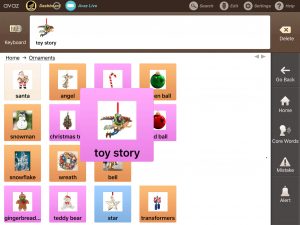 Tree decorating is an art, they say. It's more an art project. And the more help you get, the better. Get your child involved in decking up the tree. Gamify the task so that children are excited about it. Here are 3 fun ideas to use AAC for tree decoration:
Tree decorating is an art, they say. It's more an art project. And the more help you get, the better. Get your child involved in decking up the tree. Gamify the task so that children are excited about it. Here are 3 fun ideas to use AAC for tree decoration:- Create a list of ornaments and load the vocabulary in the child's AAC system. When the child chooses an ornament, the first family member to find the ornament from the box, gets to add it to the tree. This can be an exciting game to play with siblings and cousins. Alternatively, you can also have family members take turns decorating the tree.
- Let your child request their favourite ornaments using the AAC system. Hand them the ornaments one by one as your child requests it, and soon you will have a gorgeous looking tree.
- Pick any ornament from the box. The family member who names it first gets to add it to the tree. Play this game with a limited set of ornaments, so that your child does not have to navigate much in the AAC system to name the ornaments.
Christmas Cards
[gallery size="large" columns="2" ids="3621,3620"] Each family has their own Christmas traditions, be it ice skating outdoors, or visiting a holiday fair. If your family sends out christmas cards every year, how about giving the tradition a nice AAC twist? Create relevant icons in the child’s AAC system so that they can send greetings to loved ones, by sharing them on social media. Your friends and family will be more than thrilled to receive personalized greetings from your child. You can share messages created in Avaz AAC app through several social media and messaging apps including Whatsapp, Facebook, and Hangouts.Christmas Fashion
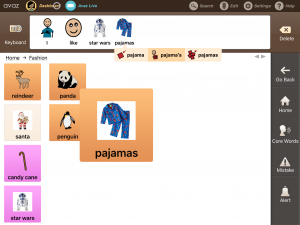 Whether you are one of those families that rock hand knit sweaters or matching pajamas, let your child participate in deciding the family’s Christmas outfits. Candy canes, snowflakes, reindeer, or star wars? Onesies or collared Pjs? These are important decisions that determine your style quotient during Christmas. Make sure that your child gets a say in them through their AAC system. If you prefer shopping online, have your child sit next to you, and pick the pattern and colour the whole family can agree on. Christmas is all about getting together as a family and appreciating life's blessings. This Christmas, switch up the fun by including your child in every holiday activity. If you are hosting a party or attending one, read this post to learn useful tips for a magical Christmas. Team Avaz wishes everyone a Merry Christmas. May love, peace, hope, and joy fill your hearts and homes!!!
Whether you are one of those families that rock hand knit sweaters or matching pajamas, let your child participate in deciding the family’s Christmas outfits. Candy canes, snowflakes, reindeer, or star wars? Onesies or collared Pjs? These are important decisions that determine your style quotient during Christmas. Make sure that your child gets a say in them through their AAC system. If you prefer shopping online, have your child sit next to you, and pick the pattern and colour the whole family can agree on. Christmas is all about getting together as a family and appreciating life's blessings. This Christmas, switch up the fun by including your child in every holiday activity. If you are hosting a party or attending one, read this post to learn useful tips for a magical Christmas. Team Avaz wishes everyone a Merry Christmas. May love, peace, hope, and joy fill your hearts and homes!!! Visual Schedules for Children with ASD
- Clarity
- Makes big tasks manageable
- Independence
- Comprehension
- Supports caregivers
Types of Visual Schedules
There is overwhelming evidence suggesting the effectiveness of visual schedules for children with ASD. However, we see that not many parents and teachers use them regularly. They assume that creating a schedule is a laborious task. But the truth is that schedules need not be complex. You can set up a schedule with very little effort by using simple things lying around the house. Different children respond well to different types of visual representations. You can try out the different types of schedules and choose the one that works best for the child. Here are the common types of visual schedules:- Object Schedules:
- Picture Schedules:
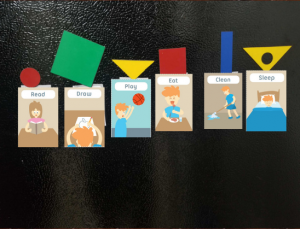 A picture schedule might seem elaborate, and difficult to create. But there are many printable resources available online, and you can easily print out images and arrange them on charts or boards. You can also use real photographs or create your own drawings if you find your child responds to them better. Use magnetic boards and clips, velcro, or binders to hold the pictures. Some children may not be able to make the connection between the picture and the activity at the beginning. However, as you keep using the schedule with them, they may be able to recognize the picture and associate it with the corresponding activity.
A picture schedule might seem elaborate, and difficult to create. But there are many printable resources available online, and you can easily print out images and arrange them on charts or boards. You can also use real photographs or create your own drawings if you find your child responds to them better. Use magnetic boards and clips, velcro, or binders to hold the pictures. Some children may not be able to make the connection between the picture and the activity at the beginning. However, as you keep using the schedule with them, they may be able to recognize the picture and associate it with the corresponding activity.- Written Schedules: [caption id="attachment_3594" align="aligncenter" width="300"]
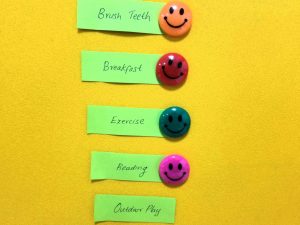 Add smileys or stickers to make the schedule exciting[/caption]
Add smileys or stickers to make the schedule exciting[/caption]
Avaz FreeSpeech: An Exciting Way to Develop Language Skills
Scaffolding:
Scaffolding refers to the use of instructional techniques to help learners achieve better and deeper understanding of language. It involves providing assistance to learners so that they progress and go to the next level in their language capabilities.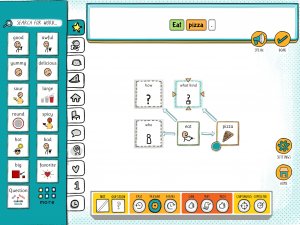 When the learner says, "eat pizza", Avaz FreeSpeech prompts them to add more details by asking the question "What kind?"
When the learner says, "eat pizza", Avaz FreeSpeech prompts them to add more details by asking the question "What kind?"Recasting
Recasting is the corrective reformulation of a learner’s utterances. Evidence suggests that students repeat recasts, thereby learning correct usage of language.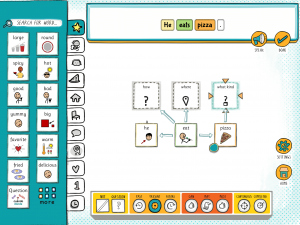 When the learner says, "He eat pizza", Avaz FreeSpeech corrects it to the grammatically correct sentence "He eats pizza".
When the learner says, "He eat pizza", Avaz FreeSpeech corrects it to the grammatically correct sentence "He eats pizza".Bridging
Bridging is the technique of teaching new concepts by building up on the learner’s existing knowledge. For bilingual learners, this helps in developing fluency in a second language, while maintaining their proficiency of native language. [gallery columns="2" size="large" ids="3567,3568"]Gamification:
Gamification is an educational approach that aims to maximize the engagement of learners using fun elements that promote learning. According to research, learners acquire and retain more information through gamification than conventional teaching methods. [caption id="attachment_3569" align="aligncenter" width="474"]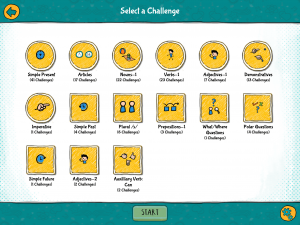 Exciting challenges in Avaz FreeSpeech make learning grammar a fun experience. Parents and teachers can also create custom challenges based on the child's progress.[/caption]
Exciting challenges in Avaz FreeSpeech make learning grammar a fun experience. Parents and teachers can also create custom challenges based on the child's progress.[/caption]Reward System:
Setting small goals motivates people to work towards achieving them. Subsequently rewarding them for successful completion of tasks gives them a sense of accomplishment. It also encourages them to put in more effort and reach for higher goals. [caption id="attachment_3570" align="aligncenter" width="515"]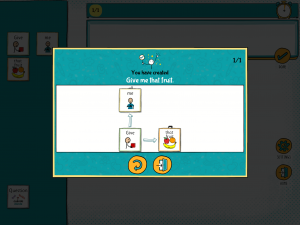 The learner gets instant reinforcement once they ace a challenge in Avaz FreeSpeech[/caption]
The learner gets instant reinforcement once they ace a challenge in Avaz FreeSpeech[/caption]Multi-sensory Learning:
Multi-sensory learning refers to the engagement of more than one sense in learning environments. Since multiple senses of the learner are stimulated, it results in greater understanding. It also gives students of all abilities an alternative way to learn and process information.- Visual Learning
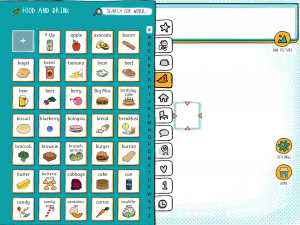 The entire Symbolstix library of 15,000+ symbols in Avaz FreeSpeech promote visual learning. You can also add your own picture and add to the repository of picture vocabulary.[/caption]
The entire Symbolstix library of 15,000+ symbols in Avaz FreeSpeech promote visual learning. You can also add your own picture and add to the repository of picture vocabulary.[/caption] - Auditory Learning
- Tactile Learning
Independent Learning:
Typically, a parent or teacher expands or offers corrective feedback to the learner’s utterances. However, when an individual is able to learn by themselves, it develops their metacognition and self-assessment skills. This instills confidence in them and boosts their self-worth. [caption id="attachment_3573" align="aligncenter" width="512"]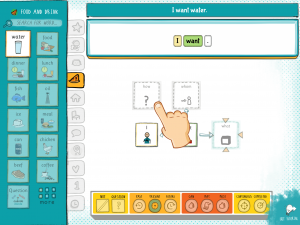 Visual cues and question prompts in Avaz FreeSpeech guide users so that they can learn by themselves.[/caption] Avaz FreeSpeech is a unique app with grammar prediction and errorless modelling. These game changing functionalities help learners develop language skills. It is suitable for any learner who wants to build their language skills, be it a bilingual student or an individual with language impairments. With gamification and picture supports, the app complements conventional methods of language development, while offering a gripping way to improve language competency.
Visual cues and question prompts in Avaz FreeSpeech guide users so that they can learn by themselves.[/caption] Avaz FreeSpeech is a unique app with grammar prediction and errorless modelling. These game changing functionalities help learners develop language skills. It is suitable for any learner who wants to build their language skills, be it a bilingual student or an individual with language impairments. With gamification and picture supports, the app complements conventional methods of language development, while offering a gripping way to improve language competency. Revisiting Most loved Avaz Features: Dashboard for Caregiver Training
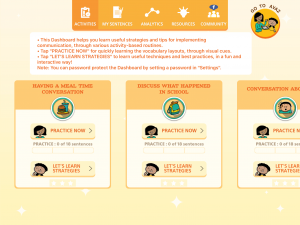 Here are some of the things you can do in the Avaz Dashboard :
Here are some of the things you can do in the Avaz Dashboard :- Practice modelling
- Learn related AAC strategies
- Model any sentence that you wish to model, besides those available for practice.
- Monitor the user's progress
Practice Modelling
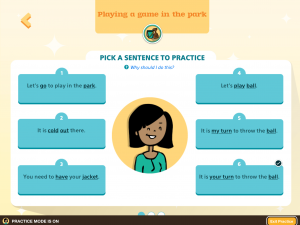 Let’s take a look at ‘Playing a Game in the Park’ scenario. You can practice 18 sentences related to this activity. Let’s choose the 6th sentence ‘It is your turn to throw the ball’, and see how the app guides you to model that sentence. These examples are given so that you get familiar with the layout and folder locations. If the child is a beginning communicator, you may want to model fewer keywords. The number of words you model largely depends on the language competence and the cognitive abilities of the AAC user. [metaslider id=3525] With that, you have just learned how to model keywords of a sentence in the Avaz app. Congrats!!
Let’s take a look at ‘Playing a Game in the Park’ scenario. You can practice 18 sentences related to this activity. Let’s choose the 6th sentence ‘It is your turn to throw the ball’, and see how the app guides you to model that sentence. These examples are given so that you get familiar with the layout and folder locations. If the child is a beginning communicator, you may want to model fewer keywords. The number of words you model largely depends on the language competence and the cognitive abilities of the AAC user. [metaslider id=3525] With that, you have just learned how to model keywords of a sentence in the Avaz app. Congrats!! AAC Strategies
Now that you have learned to model sentences while the child plays at the park, it is important to understand the significant AAC strategies to employ. Understanding strategies will enable you to follow the do's and don'ts of modelling. What kind of questions to ask? How to expand and extend the child's vocabulary? How to encourage the child to communicate? These are some of the things that are covered in the AAC strategies tutorial. [metaslider id=3543]Learning to Model Your Sentences
The 'My Sentences' tab on the Dashboard lets you add any sentence you wish to model. [metaslider id=3537] It must be noted that Avaz AAC app lets you add multiple words to a particular category, at one go. Once all the words in the sentence are added, then the app shows you how to access these words through visual cues.Analytics
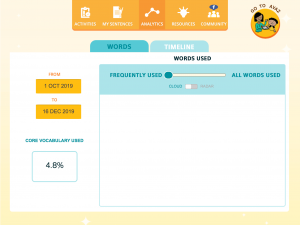 Analytics helps you keep track of the child's progress. You can find out the length of sentences and percentage of core vocabulary used for a given period. The pictorial representation with charts and graphs will help you monitor the usage and make necessary changes for further improvements. Avaz prioritizes caregiver training because it plays a pivotal role in developing the communication skills of children with complex communication needs. For beginners, the tutorials serve as a great tool that introduces them to AAC fundamentals. For Avaz users familiar with the app, Dashboard can provide reinforcement for the strategies they are already employing.
Analytics helps you keep track of the child's progress. You can find out the length of sentences and percentage of core vocabulary used for a given period. The pictorial representation with charts and graphs will help you monitor the usage and make necessary changes for further improvements. Avaz prioritizes caregiver training because it plays a pivotal role in developing the communication skills of children with complex communication needs. For beginners, the tutorials serve as a great tool that introduces them to AAC fundamentals. For Avaz users familiar with the app, Dashboard can provide reinforcement for the strategies they are already employing. Get the Better of Reading Difficulties with MDA Avaz Reader
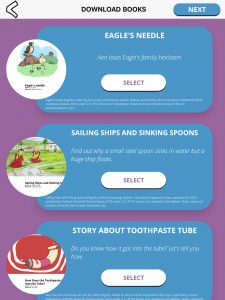 MDA Avaz Reader is a research-based app that incorporates proven intervention strategies to help struggling readers. The features of the app have been designed to address the most common challenges faced by students in schools. With MDA Avaz Reader, you can read any written text, be it from a storybook, magazine, newspaper or school textbooks. The app also allows you to download exciting books with captivating images that motivate children to read. Reading, writing, spelling, and comprehension problems are common in children with Dyslexia. In this post, let’s see how to help a child with reading difficulties with the ‘Hint’ feature of MDA Avaz Reader.
MDA Avaz Reader is a research-based app that incorporates proven intervention strategies to help struggling readers. The features of the app have been designed to address the most common challenges faced by students in schools. With MDA Avaz Reader, you can read any written text, be it from a storybook, magazine, newspaper or school textbooks. The app also allows you to download exciting books with captivating images that motivate children to read. Reading, writing, spelling, and comprehension problems are common in children with Dyslexia. In this post, let’s see how to help a child with reading difficulties with the ‘Hint’ feature of MDA Avaz Reader.Syllable Awareness:
Syllables are the smaller units that make up words and language. A single syllable has a vowel sound with or without accompanying consonant sounds. For example, the word ‘eagle’ has two syllables, while the word ‘time’ has only one syllable. The word ‘friends’ has more letters in it than ‘eagle’, but it has only one syllable. [caption id="attachment_3489" align="alignright" width="225"]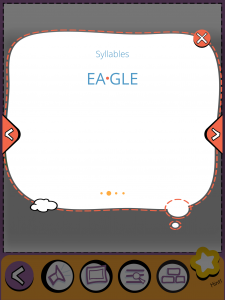 Syllable Hint[/caption] Children with dyslexia may find it difficult to identify the syllables of a word. A parent or teacher can help them by clapping out the individual syllables of the word. How does MDA Avaz Reader help? If the child wants help with a particular word while reading a text, they can tap on the ‘Hint’ button to get syllable hints. This helps them understand how the word is broken down into individual syllables. Since they do not need the assistance of a parent or teacher, the ‘Hint’ feature promotes their independence in reading.
Syllable Hint[/caption] Children with dyslexia may find it difficult to identify the syllables of a word. A parent or teacher can help them by clapping out the individual syllables of the word. How does MDA Avaz Reader help? If the child wants help with a particular word while reading a text, they can tap on the ‘Hint’ button to get syllable hints. This helps them understand how the word is broken down into individual syllables. Since they do not need the assistance of a parent or teacher, the ‘Hint’ feature promotes their independence in reading.Rhyme Awareness:
This is the ability to identify words that have similar or the same sounds in the final stressed syllable. Essentially, the end of the rhyming words sound similar. For example, the word ‘time’ rhymes with ‘lime’, ‘slime’, ‘mime’, etc. [caption id="attachment_3488" align="alignright" width="225"]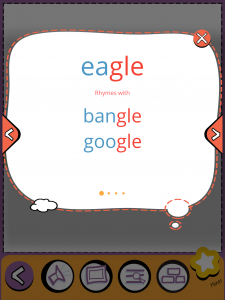 Rhyming words hint[/caption] Children with dyslexia can have trouble recognizing rhyming words. However, they can be taught to focus on the end syllables that sound similar. How does MDA Avaz Reader help? While reading the story, the child can tap the ‘Hint’ button to see words that rhyme with the current word they are reading. The hint even highlights the syllables that have matching sounds. This helps the child gain an understanding of the connection between the syllables and their sounds. As the child develops their rhyme awareness, they can go on to produce rhyming words.
Rhyming words hint[/caption] Children with dyslexia can have trouble recognizing rhyming words. However, they can be taught to focus on the end syllables that sound similar. How does MDA Avaz Reader help? While reading the story, the child can tap the ‘Hint’ button to see words that rhyme with the current word they are reading. The hint even highlights the syllables that have matching sounds. This helps the child gain an understanding of the connection between the syllables and their sounds. As the child develops their rhyme awareness, they can go on to produce rhyming words. Vocabulary Acquisition
Due to the challenges they face, children with dyslexia generally have much less vocabulary at their disposal compared to their peers. One of the best ways to acquire a rich vocabulary is to read. However, children with dyslexia may avoid reading due to the strain it puts on them. The lack of adequate vocabulary affects their comprehension and expressive language. Their difficulties with pronunciation can also prevent them from actively using their existing vocabulary. [caption id="attachment_3490" align="alignright" width="144"]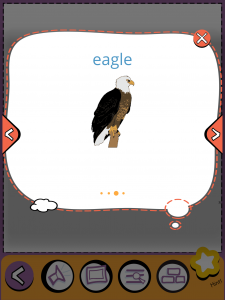 Picture hint[/caption] How does MDA Avaz Reader Help? Research suggests that visual representation is an effective technique for a child to learn new words and recall them. Attractive and colourful images can spark their curiosity, and can be more engaging than plain text. MDA Avaz Reader provides picture hints for words. While reading a word, the child can tap the ‘Hint’ button to see the picture hint. Looking at the image corresponding to the word helps them remember the word and what it represents. MDA Avaz Reader also provides audio clips to teach pronunciation. Children typically learn words with more enthusiasm with such multisensory techniques that include audio and visual clues. [video width="1920" height="1080" mp4="https://www.avazapp.com/wp-content/uploads/2019/12/MDA.mp4" autoplay="true"][/video] Dyslexics who overcome their challenges and become successful in life, recall their traumatic school experiences caused by their reading difficulties. It is unfortunate that many such children do not achieve anything more than basic literacy. Poor academic performance resulting from their challenges stifles their confidence and stresses them out. Without adequate support, many children with dyslexia suffer from low self-esteem, leading to social and emotional issues. MDA Avaz Reader app is a handy tool that enables children to read independently. This boosts their chances of academic success, and elevates their sense of self-worth.
Picture hint[/caption] How does MDA Avaz Reader Help? Research suggests that visual representation is an effective technique for a child to learn new words and recall them. Attractive and colourful images can spark their curiosity, and can be more engaging than plain text. MDA Avaz Reader provides picture hints for words. While reading a word, the child can tap the ‘Hint’ button to see the picture hint. Looking at the image corresponding to the word helps them remember the word and what it represents. MDA Avaz Reader also provides audio clips to teach pronunciation. Children typically learn words with more enthusiasm with such multisensory techniques that include audio and visual clues. [video width="1920" height="1080" mp4="https://www.avazapp.com/wp-content/uploads/2019/12/MDA.mp4" autoplay="true"][/video] Dyslexics who overcome their challenges and become successful in life, recall their traumatic school experiences caused by their reading difficulties. It is unfortunate that many such children do not achieve anything more than basic literacy. Poor academic performance resulting from their challenges stifles their confidence and stresses them out. Without adequate support, many children with dyslexia suffer from low self-esteem, leading to social and emotional issues. MDA Avaz Reader app is a handy tool that enables children to read independently. This boosts their chances of academic success, and elevates their sense of self-worth. How to Develop Emotional Competence of an AAC User
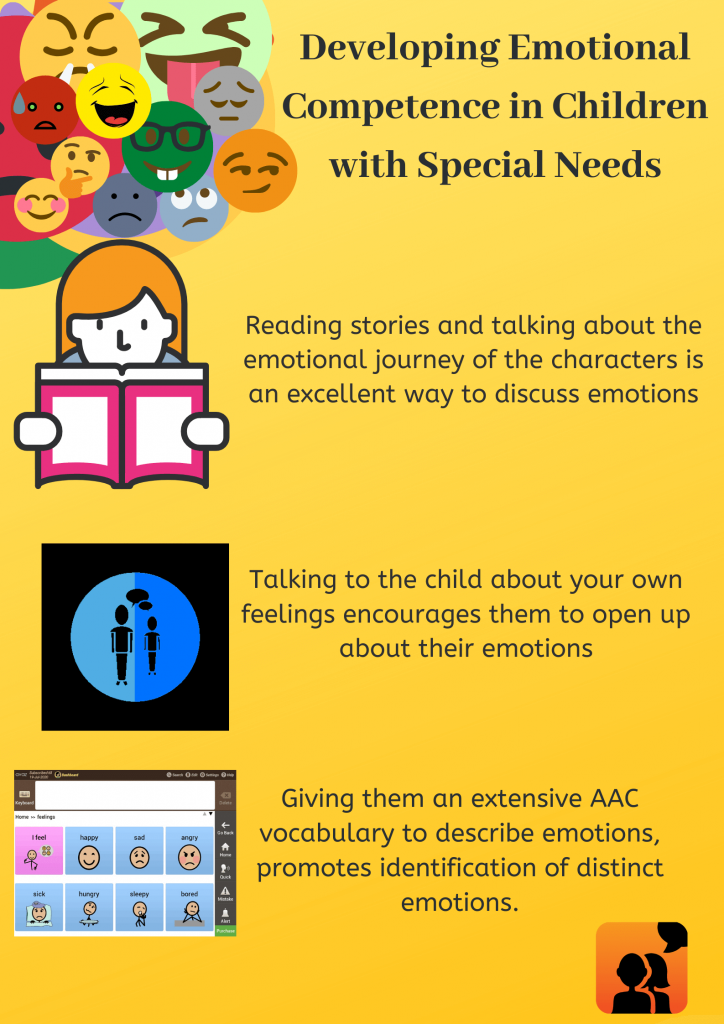 Emotional competence is the ability of a person to express their own emotions with complete freedom. You can convey emotions without words, but you run the risk of your gestures and facial expressions being misinterpreted. Moreover, non-verbal communication of emotions requires that the communication partner is looking at you, and this can limit your expression. Language, therefore, plays an instrumental role in determining a person’s ability to effectively communicate their emotions. Over the course of their lives, children and adults may struggle with communicating their emotions. For a child with complex communication needs, the challenge is greater, because they might not have the literacy to convey their emotions accurately. Therefore, AAC intervention programs need to focus on developing their emotional intelligence and provide them the relevant vocabulary.
Emotional competence is the ability of a person to express their own emotions with complete freedom. You can convey emotions without words, but you run the risk of your gestures and facial expressions being misinterpreted. Moreover, non-verbal communication of emotions requires that the communication partner is looking at you, and this can limit your expression. Language, therefore, plays an instrumental role in determining a person’s ability to effectively communicate their emotions. Over the course of their lives, children and adults may struggle with communicating their emotions. For a child with complex communication needs, the challenge is greater, because they might not have the literacy to convey their emotions accurately. Therefore, AAC intervention programs need to focus on developing their emotional intelligence and provide them the relevant vocabulary.Components of Emotional Intelligence
Emotional intelligence is essentially the ability to identify emotions and use them appropriately. Since emotional intelligence influences the quality of a child’s relationships and their social life, it is important to understand what we really mean by it. Here are the key components of emotional intelligence and the corresponding skills we need to foster in children with special needs:- Self-awareness
- Emotional Regulation
- Self-motivation
- Empathy
- Social Skills
Emotional Intelligence of Special Needs Children
Teaching emotional skills to any child can be tricky. It can be more difficult for children with special needs because physical deficits and cognitive impairments can affect how well they understand and distinguish the various emotions. Here are a few things to do to help them learn to identify, regulate, and express their emotions. Read Stories Reading stories is an excellent way to teach the child to identify the different emotions. As you are reading, talk about the main characters in the story and discuss their feelings. Draw the child’s attention to the change in emotions of the characters throughout the story. If the boy in the story was sad that he couldn’t find his favourite ball, make sure that the child understands the correlation between the event and the emotion. If at the end of the story, the boy is happy that he got a new ball, talk to the child about the shift in the emotional state of the character. Ask the child what they are feeling about the events in the story. Are they sad that the boy lost his ball? Are they happy that the boy got a new ball? Asking them such questions is a good way to teach empathy to the child. Encourage the Child to Talk Children with special needs can get better at talking about their feelings, the more they do it. Asking them questions regularly can help them open up about their emotions. Build on their answers and help them elaborate, and be specific by asking consecutive questions. If you ask ‘How are you feeling now?’, and they answered, ‘Mad’, ask further questions to help them explore their emotions. ‘Why are you mad?” If the child doesn’t know how to answer the question, you can proceed by giving them possible causes. ‘Are you mad because I asked you to stop watching TV or are you mad because the music is too loud for you?’ Continue the conversation until the child is able to recognize the exact cause of their emotion. If they indicate that that they do not wish to talk about it, talk to them about some of your experiences in similar situations. Give Them The Vocabulary ‘I’m excited’ is not the same as ‘I’m happy’. The AAC user should be taught extensive vocabulary to express distinct emotions. The best way for a communication partner to do this is to talk about their own feelings in various situations. If you are taking the child to their favourite movie, you can say ‘I’m excited to watch this movie with you.’ When the child is waiting for his grandparents to arrive, you can say, “Are you excited about seeing grandpa?’ Consistently using the word ‘excited’ both in direct conversation with the child, and conversations with other communication partners familiarizes the child with the word. Modelling the word in the AAC system whenever you use it, can motivate the child to use the word to express their excitement. Adding too many emotion words at the beginning can be confusing and overwhelming for a user. Start slow, and as the child’s emotional intelligence grows, make sure to include additional words that describe the different emotions. Visual supports and role play can also help your child develop their emotional competence. If you know of an upcoming or recurring situation that causes emotional upheaval in your child, discuss it in advance. Having a conversation about the event when the child is calmer, helps them understand the situation better. This can help them regulate their emotional response to the event. Each child has different cognitive abilities and emotional awareness. Hence, while teaching children emotional skills, parents and teachers should exercise their judgment. This will help in choosing the method that best suits the child’s needs.Tips for Shared Reading with an AAC System
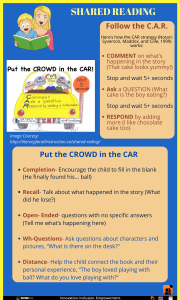 Parents of children with AAC needs are constantly on the lookout for communication opportunities with the AAC system. Shared reading is one such activity that parents can try out with their children. It typically refers to a school instruction method wherein the teacher reads a story aloud with a group of students. Parents can use the same reading strategy at home so that children continue to learn while doing an activity they love. For an AAC user, reading with a parent can be an especially exciting way to enhance their language skills. Stories are also excellent tools for parents to discuss and teach etiquettes, emotions, and other abstract concepts. You can find free downloadable shared reading kits here. Here are the key things to keep in mind while reading with your child:
Parents of children with AAC needs are constantly on the lookout for communication opportunities with the AAC system. Shared reading is one such activity that parents can try out with their children. It typically refers to a school instruction method wherein the teacher reads a story aloud with a group of students. Parents can use the same reading strategy at home so that children continue to learn while doing an activity they love. For an AAC user, reading with a parent can be an especially exciting way to enhance their language skills. Stories are also excellent tools for parents to discuss and teach etiquettes, emotions, and other abstract concepts. You can find free downloadable shared reading kits here. Here are the key things to keep in mind while reading with your child:Pick a Book of Their Choice
Start by asking the child whether they are up for reading. “Would you like to read now?" Give them the choice to say ‘No’. Forcing a child to read when they are not keen on it will make the activity stressful for the parent and the child. If they show interest in reading, the next step is to ask what book they’d like to read. If they have clear favourites, you can let them choose one of their favourite books. “Would you like to read ‘The Hare and the Tortoise’, ‘The Lion and the Mouse’, or some other book?" Once they pick a book, you can start reading with the child.Have a Conversation
It’s not just about asking questions. As much as you want to know how much your child has understood, bombarding them with questions can get monotonous. The child can feel tested while all they wanted was a fun reading session with you. So, give room for casual conversation where you share your thoughts and observations. “I think it is great that the tortoise won at the end.” “I’m happy that the tortoise won the race. Are you happy that the tortoise won?” “The hare lost because it took a nap.” “Hurray! The tortoise won!!” “Look. The tortoise looks happy because it won.” “I think that the hare is upset that it lost.” “Look at all the animals cheering the tortoise and the hare.” “What animals do you see other than the tortoise and the hare?” “Look at the elephant. The big elephant is watching the race.”Be Ready to Model
Reading can be a wonderful opportunity to model. Keep the AAC system nearby as you read the story, so that you don’t miss the chance to model. We have put together some examples of modeling using the classic “Hare and the Tortoise” story. Words in italics are a few words you can model for beginning communicators while reading this story.- Read:
- Like:
- More:
- Turn:
- Happy:
- Run:
Ask Questions
If you are reading the ‘The Hare and the Tortoise’, you can point to the pictures and talk about them. “Look at the hare.” You can draw the child’s attention to the characters so that they can follow the story as it progresses. “What colour is the hare?” Ask ‘wh’ questions related to the story and look expectantly at the child, indicating that you are looking for a response. Children with cognitive deficits and developmental disabilities can take longer to respond. It’s a good practice to pause for a few seconds to give the child time to construct a response. If the child does not respond, you can answer the question to keep the conversation going. “The hare is brown in colour. Look at the hare. It’s brown.” As you read further, you can ask other questions to see if the child has understood what you have read. “What is the hare doing?” Again, pause for a few seconds and look expectantly to encourage the child to respond.Expansion and Extension
Expansion is the process in which you repeat what the child says, and add missing words to make it grammatically correct. Try not to rephrase too much as that can confuse the child. If the child answers, “run” to the question “What is the hare doing?”, then it’s a great opportunity for you to expand the conversation. “Yes! Run. The hare is running.” Show excitement when the child replies and acknowledge their answer. This will motivate them to continue responding to your questions. Extension of language involves providing a little more new information. This information is related to what the child has just said. “Yes! The hare is running. It is running fast” Depending on the child’s fondness for reading, and cognitive abilities, you can build on these strategies and have more elaborate conversations. Shared reading is a great way to encourage interactive communication, while simultaneously developing the child’s vocabulary and AAC proficiency.Equipping Children with Special Needs to Tackle Bullying in Schools
 As a parent, you may feel helpless when your child gets bullied. Your child may lack the necessary emotional skills to deal with all the taunting and teasing. Vulnerable children who are victims of bullying may suffer from depression, or turn to substance abuse to cope with their sense of powerlessness. Given the grave consequences, parents and schools should get together to take on this menace that can potentially cause irreparable damage to a child’s psychological health.
As a parent, you may feel helpless when your child gets bullied. Your child may lack the necessary emotional skills to deal with all the taunting and teasing. Vulnerable children who are victims of bullying may suffer from depression, or turn to substance abuse to cope with their sense of powerlessness. Given the grave consequences, parents and schools should get together to take on this menace that can potentially cause irreparable damage to a child’s psychological health.Bullying and Children with Special Needs
Bullying is a problem that most children face, but those with special needs are easy targets because they may be different. Some children with special needs may be physically weaker, or appear to be weaker. Unfortunately, their lack of physical strength, or physical disabilities, can make them the chosen ones for bullies to pick on. Children who have communication deficits too are often at the receiving end of bullying because they may not have the tools to stand up for themselves. Those with cognitive impairments might be socially inept, and may seem out of place in social settings. This can invite the attention of troublemakers, and put them at risk of being bullied.What can Schools do?
Schools need to have strong anti-bullying programs that educate children about the evil side of bullying. Children must be made aware of the long-lasting effects of the same. At the classroom level, the teacher is the best person to tackle bullying. We see that children hesitate to come forward and report bullying because they may be seen as tattletales. Some teachers inadvertently become a party to the bullying by making callous remarks that suggest that the victims should 'toughen up' or 'let it go'. Hence teachers should be trained to identify signs of bullying and equipped to handle the same. They need to develop an environment of trust and reassurance in the classroom to indicate that no bullying complaint will be trivialized. Children must be taught empathy and how to acknowledge and embrace differences. As can happen with young children, there can be ruffled sentiments that are caused unintentionally. So, teachers must educate the children to be sensitive, discreet, and thoughtful in their actions and words. Counsellors can play an important role in building a school wide understanding of the ill effects of bullying. Classroom learning can be further reiterated by counsellors who should work to inculcate a culture of open communication at school. This will ensure that children feel comfortable opening up about their troubles.What can Parents do?
Parents must ensure that children have a strong sense of self-worth, so that their confidence dosen’t suffer due to bullies who constantly put them down. Children should be encouraged to pursue their hobbies and passions. Hobbies are good stress-busters and are also a good diversion from their anxieties. Parents should encourage the children to talk about their feelings, and to seek help if needed. If they notice the children becoming withdrawn or unusually quiet, they can talk to them to find out if something is wrong. A sudden drop in grades or a diminished interest in going to school may also be indicators of bullying. Children should be exposed to social environments so that they are comfortable when interacting with others. Parents must support their children in their attempts to establish social connections. They can arrange playdates with children of like-minded parents. They can also take them to libraries and NGOs, where the children can participate in fun events.How Can AAC Help?
We would all love to see a child using their AAC system to stand up to their harasser, and end the bullying themselves, right? For a child with complex communication needs, just being able to say 'Stop' and 'No', gives them the power to protest. So, their AAC systems should always be at hand and provide them quick access to such words. The child can also use the AAC system to report the bullying to their teachers and parents. They can also be taught about how to deal with bullying using social stories on the AAC system. A separate emergency folder can be created for times of distress explaining the steps to follow and people to turn to for help. Bullying can cause scars that children may carry well into their adulthood. Children with disability and complex communication needs must be enabled to build strong agency to stand up to bullies. Till such time they can do it themselves , the responsibility falls on the adults in their lives to protect them. So, parents and teachers should join hands to put an end to bullying. This will ensure that schools are nurturing and safe spaces they are meant to be. What do you think about bullying in schools? Please share your ideas in the comment section below.How Assistive Technology for Dyslexia Helps Struggling Readers
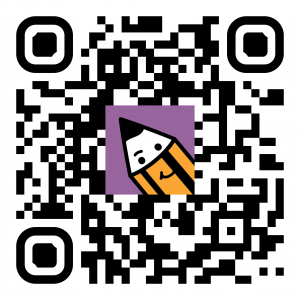 Dyslexia is the most common learning disability, affecting around 10% of the world’s population. People with dyslexia struggle to read independently, and may also have trouble with spelling, writing, and comprehension. Due to the general lack of awareness about the condition, several children and adults do not receive a timely diagnosis. Consequently, they can be presumed to be incompetent and lethargic, despite being intelligent and conscientious. Thanks to assistive technology for Dyslexia including apps that help with reading, writing and spelling, people with Dyslexia can overcome their challenges to achieve academic and professional success.
Dyslexia is the most common learning disability, affecting around 10% of the world’s population. People with dyslexia struggle to read independently, and may also have trouble with spelling, writing, and comprehension. Due to the general lack of awareness about the condition, several children and adults do not receive a timely diagnosis. Consequently, they can be presumed to be incompetent and lethargic, despite being intelligent and conscientious. Thanks to assistive technology for Dyslexia including apps that help with reading, writing and spelling, people with Dyslexia can overcome their challenges to achieve academic and professional success. Why use Assistive Apps?
Several schools have early intervention programs to support children with Dyslexia. They use research-based multisensory instruction techniques to help children with focus. Even as the children receive such targeted help, it is important to supplement school programs with adequate assistance at home. This is where an app such as MDA Avaz Reader comes into play. Assistive apps are handy tools that give children with dyslexia access to reading support at home, so that they can keep up with their peers. In the U.S and U.K, schools have specialized instruction programs for children with dyslexia. But for children in less developed parts of the world, reading intervention programs can be sparse or non-existent. Without proper support, children with dyslexia can be labelled ‘slow, ‘lazy’, and ‘stupid’ which can result in them suffering from low self-esteem. Some may even drop out of school due to their dismal academic performance caused by their reading challenges. Assistive apps can enable such children to perform well in school by helping them read and comprehend written text better. Adults with Dyslexia too can face problems in the workplace due to their reading difficulties. They can have trouble reading and comprehending documents, spreadsheets,and graphs. Assistive apps can help them manage their difficulties, so that their work efficiency is not compromised.Reading Challenges Faced by People with Dyslexia
People with Dyslexia can struggle with several aspects of reading. Here is a look at some of their reading challenges:- Phonemic Awareness
- Phonics
- Fluency
- Vocabulary
- Comprehension
How can Assistive Apps Help?
![]() Apps such as MDA Avaz Reader use evidence-based methods to enable children to learn at grade level, even when their reading, spelling, and comprehension may be below grade level. MDA Avaz Reader is available in Android and iOS.
Apps such as MDA Avaz Reader use evidence-based methods to enable children to learn at grade level, even when their reading, spelling, and comprehension may be below grade level. MDA Avaz Reader is available in Android and iOS.
- Reading Out Written Text
- Improving Focus
- Getting Rid of Distractions
- Reading Hints
- Building Comprehension
Why is Core Vocabulary Important For an AAC User?
 Core words are the small number of words that are used most frequently in our conversations. About 80% of the words we speak are core words. They can be used across contexts, and can have more than one meaning. Pronouns, common verbs, prepositions, and helping verbs are part of core vocabulary. Examples are I, you, help, that, me, mine, stop, go, get, etc.
Core words are the small number of words that are used most frequently in our conversations. About 80% of the words we speak are core words. They can be used across contexts, and can have more than one meaning. Pronouns, common verbs, prepositions, and helping verbs are part of core vocabulary. Examples are I, you, help, that, me, mine, stop, go, get, etc. Significance of Core Words
A decade ago, AAC systems gave users a few core words with a wide range of nouns. For example, the user was given the core word ‘like’ to use with several nouns such as ‘cookie’, ‘red’, ‘football’, ‘rose’, etc. This seemed to be enough for common communicative functions such as requesting. This approach, however, limited the communication ability of the user. Current AAC strategies are based on the realization that teaching core words open up communication opportunities for the users. By understanding the usage of the word ‘like’, the user can use it in different settings and contexts. Focus on teaching core words gives the user greater communication autonomy, which is one of the fundamental goals of AAC.Considerations in Teaching Core Words
We know that teaching core words to AAC users gives them more independence and expands the possibilities of communication. But, when it comes to implementing this strategy, SLPs and special educators are often scrambling to find suitable resources. This is because teaching core words is tougher than teaching nouns. Most nouns are tangible and easier to understand for an AAC user who is learning to communicate. You can show a book to the child while teaching the word ‘book’. The child sees it, and hence can associate the word to the object. Nouns can also be better represented by pictures. This helps the child getting started with symbol-based AAC, easily identify the pictures and learn the corresponding nouns. Core words are more abstract and not represented well by pictures. Adding to the complexity is the fact that core words can be used in multiple ways. For example, look at the word ‘give’ which has different meanings in each of the following usages. Give - to present something to someone Give up - surrender Give out - be exhausted Give it a shot - try Give away - to give things for freeTeaching Core Words - Best Practices
Here are a few things to keep in mind while teaching core words: Choose an AAC system, such as Avaz app, that is designed such that core words are easily accessible. The user should not have to navigate a lot to access the words they use frequently. The AAC app should also allow for inclusion of a huge repository of words. A wider choice of vocabulary imposes fewer restrictions on communication. You can also use core vocabulary boards while getting started.- Modelling
- Setting Realistic Goals
Drawing Inspiration From Celebrities with Dyslexia
Dyslexia is a learning disability that makes it difficult to read, spell, and comprehend written text. Without a proper diagnosis, those with the condition are often assumed to be unintelligent or uninterested. But this cannot be farther from the truth.
Dyslexia does not reflect the intellect or the talent of a person. In fact, there are several famous people who have excelled in their respective careers by conquering the condition. Some of them even credit dyslexia with having put them on the path towards success. Here are some of the celebrities who did not let dyslexia become a stumbling block to their success: Steven Spielberg It can be hard to believe that an accomplished director of his stature had a learning disability, and reading challenges.The Oscar winning filmmaker who reignited our interest in dinosaurs with his 'Jurassic Park’ movies, was not diagnosed with dyslexia until he was in his sixties. He claims that the diagnosis helped him make sense of the struggles he had while reading scripts. However, he feels that although it took longer for him to read a script, the extra time helped him identify interesting parts of the text. Richard Branson This multi-dimensional founder of Virgin Group, had a tough time with standardized tests during his school years. He has been open about his dyslexia, and credits the condition for his venture into entrepreneurship. Conferred with several prestigious awards, he is also a noted philanthropist and is known for his humanitarian endeavours. His glorious achievements are proof that the challenges associated with dyslexia can be easily overcome by perseverance and hard work. Tom Cruise This Hollywood A-lister, who has acted in such hit movies as Mission Impossible and Jerry Maguire was diagnosed with dyslexia when he was seven. He struggled to hide his condition throughout his school years, fearing ridicule from his peers. He was worried that his reading challenges could affect his chances of getting movie roles. However, he learnt to focus on reading and developed his comprehension by getting the right kind of support. He took every step to ensure that dyslexia did not not hold him back from achieving superstardom. Whoopi Goldberg Who can forget the riveting performance of this gifted actress in the Spielberg directorial 'The color Purple', or her Oscar-winning acting in the 1990 movie 'Ghost'? The talented actress, however, was labelled slow and stupid at school due to her dyslexia. Thanks to her mother who constantly supported her by reading to her, Whoopi was able to retain her love for books. She is now a strong advocate for raising dyslexia awareness, and is involved with several programs that help children with learning disabilities. Anderson Cooper It might be surprising to know that this hard-hitting journalist who regularly reads the prompter to deliver news headlines, was diagnosed with Dyslexia as a child. He is grateful to his school for recognizing his reading challenges, and for encouraging him to get help. This enabled him to seek intervention which subsequently led him to do well in academics. Jim Carrey Did you know that this comedic genius who wowed us in rib tickling entertainers such as 'Dumb and Dumber' and 'Bruce Almighty' did not do well at school? It took an insightful teacher at his school to look beyond his disruptive antics and identify his incredible talent. This reinforcement helped him hone his skills instead of languishing with low self-esteem due to his dyslexia and poor academic performance. These celebrity stories reiterate the need for early intervention and support systems, so that children with dyslexia are not left to believe that they are any less than their peers. They also serve as shining examples for those with learning disabilities, demonstrating that no challenge is too difficult to overcome with determination and positive attitude. Did you find these stories of celebrities with dyslexia fascinating? Please share your thoughts in the comment section below.Understanding the Debate Behind the Diagnosis of Social Communication Disorder
What is Social Communication Disorder?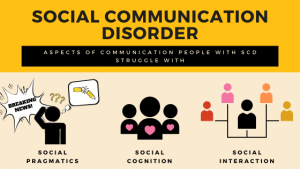
People with SCD have difficulties with the effective use of verbal and non-verbal language to communicate socially. They have trouble understanding the inherent rules of social communication such as waiting for one’s turn in a conversation. They may also not be able to interpret the signals and read the behaviours of others. Here are some of the aspects of communication, people with SCD struggle with: Pragmatics: Social pragmatics is understanding language with respect to the context instead of taking it in the literal sense. It involves not just the words a person speaks, but the gestures and the tone of voice in which they are spoken. For example, when a person says, “She hung in there till the end”, people with SCD might take the phrase ‘hung in there’ literally, instead of understanding it as ‘She didn’t give up even when things got difficult’. Social Cognition: Social cognition is the ability to be aware of one’s own feelings and motives along with the emotional state of others. Those with SCD may seem to lack empathy because they may be inept at understanding how others are feeling. They may also not know how to respond appropriately in social situations, and take the perspective of others. Social Interaction: Social interaction is governed by unwritten rules that dictate human behavioural patterns. It is abstract as to how we figure out these norms and conventions that we follow while communicating with fellow humans. People with SCD can be blatantly unaware of these subtle rules. Hence, they can appear to be rude or indifferent when they don’t follow the guidelines of social interaction, and interrupt or monopolize a conversation.The Stance Against SCD as a Diagnostic Category
Some clinicians have reservations about SCD as a separate diagnosis. They are not convinced that there is enough evidence out there to substantiate this designation. According to them, considerations like culture, personality, language proficiency, and several other factors influence social communication. Diagnosing a person with SCD without taking such factors into account could prove detrimental to them in the long run. SCD can have co-occurring conditions including developmental, intellectual and learning disabilities, attention-deficit/hyperactivity disorder (ADHD), aphasia, and dementia. So, clinicians feel that meticulous care must be taken to rule out other conditions before diagnosing a person with SCD. They also contend that people receiving SCD diagnosis are often left in a quandary, because there are not many resources available that can support them.The Argument for a Distinct Diagnosis
The primary symptoms of SCD are social disengagement, and difficulties picking up non-verbal cues in social interactions. Since a lot of the symptoms of SCD overlap with those of ASD, the chances of a misdiagnosis are high. However, Social Communication Disorder does not include restricted interests and repetitive behaviors, which are typical ASD behaviours. So, labelling a person with SCD as having autism, can result in them receiving suboptimal therapy. Experts in favour of a distinct diagnosis for SCD assert that it will help researchers dig deeper to better understand the condition. Consequently, focussed therapy plans can be formulated to enable people with SCD to overcome their social challenges and become successful in their lives.9 Essential Life Skills for Special Needs Children
 Teach students with special needs about the importance of balanced diet, exercise, good dietary habits, and proper nutrition. Focus on developing personal hygiene habits and provide required support to ensure they practice them regularly. Talk to them about how to get healthcare and deal with their illnesses such as fever, allergies, and the common cold. Train them to get dressed and make themselves look presentable.
Teach students with special needs about the importance of balanced diet, exercise, good dietary habits, and proper nutrition. Focus on developing personal hygiene habits and provide required support to ensure they practice them regularly. Talk to them about how to get healthcare and deal with their illnesses such as fever, allergies, and the common cold. Train them to get dressed and make themselves look presentable.  2.Essential Math Teach children to count money, make correct change, tell time, and make a personal budget. They can be taught how to safeguard their money, and to take responsible financial decisions. Encourage them to learn to manage their finances and monitor their spending. Talk to them about good spending habits and about the importance of savings. Teach them how to manage a bank account and keep track of their transactions, and to pay taxes and all their bills on time. 3.Household Skills
2.Essential Math Teach children to count money, make correct change, tell time, and make a personal budget. They can be taught how to safeguard their money, and to take responsible financial decisions. Encourage them to learn to manage their finances and monitor their spending. Talk to them about good spending habits and about the importance of savings. Teach them how to manage a bank account and keep track of their transactions, and to pay taxes and all their bills on time. 3.Household Skills People with special needs can be trained to have practical living skills such as maintaining the safety of a house. They can also learn how to get their house repaired, and to service the heating/cooling systems, and other appliances, if and when necessary. Discuss with them about how to rent or lease a house, and renew or cancel the corresponding agreements. Cleaning the house and shopping for groceries are some of the things they can be taught to do. They can also learn how to store food properly, and check the expiration date of meat, canned food, and other edible items.
People with special needs can be trained to have practical living skills such as maintaining the safety of a house. They can also learn how to get their house repaired, and to service the heating/cooling systems, and other appliances, if and when necessary. Discuss with them about how to rent or lease a house, and renew or cancel the corresponding agreements. Cleaning the house and shopping for groceries are some of the things they can be taught to do. They can also learn how to store food properly, and check the expiration date of meat, canned food, and other edible items.  4.Essential Reading Since the internet has become an indispensable part of our lives, people with special needs can be taught how to use search engines to look up information. They can also be trained to read maps and signs, so that they can travel within the community by themselves. They can also learn to read and understand important documents. 5.Leisure and Recreation
4.Essential Reading Since the internet has become an indispensable part of our lives, people with special needs can be taught how to use search engines to look up information. They can also be trained to read maps and signs, so that they can travel within the community by themselves. They can also learn to read and understand important documents. 5.Leisure and Recreation Every individual should be encouraged to pursue their passions and develop their talents. Even as you teach them important job skills, you can also guide them to participate in social events. Whether they like music or movies, they can learn how to get access to their favorite form of entertainment. They can also be taught about how to plan and enjoy vacations.
Every individual should be encouraged to pursue their passions and develop their talents. Even as you teach them important job skills, you can also guide them to participate in social events. Whether they like music or movies, they can learn how to get access to their favorite form of entertainment. They can also be taught about how to plan and enjoy vacations.  6.Community Living Focus on giving them an education that imparts knowledge of citizens' rights, the law, and how to abide by it. Teach them how to report a crime, get emergency care for themselves or those around them, and get legal aid. They can be taught how to be a responsible citizen and follow the rules. Encourage them to observe political developments and exercise their right to vote. 7.Safety
6.Community Living Focus on giving them an education that imparts knowledge of citizens' rights, the law, and how to abide by it. Teach them how to report a crime, get emergency care for themselves or those around them, and get legal aid. They can be taught how to be a responsible citizen and follow the rules. Encourage them to observe political developments and exercise their right to vote. 7.Safety Teach them about safety signs and their meanings. They should be aware of fire and other safety hazards, and ways to get themselves to safety in case of an accident. In the event of building evacuation, they should be aware of the exit pathways.
Teach them about safety signs and their meanings. They should be aware of fire and other safety hazards, and ways to get themselves to safety in case of an accident. In the event of building evacuation, they should be aware of the exit pathways.  8.Self-Awareness and Self-Confidence Children with special needs should be able to identify their emotional, physical, and psychological needs. Encourage them to acknowledge and receive praise and criticism. Focus on developing their sense of self-esteem. 9.Occupation Skills
8.Self-Awareness and Self-Confidence Children with special needs should be able to identify their emotional, physical, and psychological needs. Encourage them to acknowledge and receive praise and criticism. Focus on developing their sense of self-esteem. 9.Occupation Skills Schools should prepare them to look for job opportunities and recognize the requirements of each job. They can be taught about the need for financial independence and the value of having an occupation. Teach them about expectations in a work environment and how to adapt to work demands. They can also be taught how to be professional at the workplace. They can be coached to follow directions and how to work as a team. They must be ready to accept supervision and be aware of safety procedures.Teach them about the importance of attendance and maintaining performance standards. Pre vocational training should be part of their curriculum and opportunities must be created for simulating work experiences in the school. They should also receive vocational training and on-the-job training depending on their specific abilities. Parents of children with special needs dedicate a huge amount of their time and energy doing their best for the children. But the most precious gift they can give their children, and themselves, is their children’s self-dependence. So, they must actively supplement the skills training received from school. They should consistently motivate their children to do everyday activities with little or no assistance. Such an approach will impress the merits of being independent upon them. Do you have any ideas about useful life skills for special needs children? Please share your thoughts in the comment section below.
Schools should prepare them to look for job opportunities and recognize the requirements of each job. They can be taught about the need for financial independence and the value of having an occupation. Teach them about expectations in a work environment and how to adapt to work demands. They can also be taught how to be professional at the workplace. They can be coached to follow directions and how to work as a team. They must be ready to accept supervision and be aware of safety procedures.Teach them about the importance of attendance and maintaining performance standards. Pre vocational training should be part of their curriculum and opportunities must be created for simulating work experiences in the school. They should also receive vocational training and on-the-job training depending on their specific abilities. Parents of children with special needs dedicate a huge amount of their time and energy doing their best for the children. But the most precious gift they can give their children, and themselves, is their children’s self-dependence. So, they must actively supplement the skills training received from school. They should consistently motivate their children to do everyday activities with little or no assistance. Such an approach will impress the merits of being independent upon them. Do you have any ideas about useful life skills for special needs children? Please share your thoughts in the comment section below.Encouraging Autonomy in AAC Communication
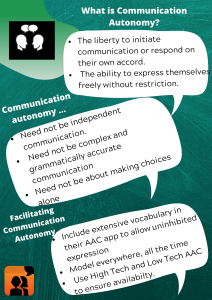 What is Communication Autonomy?
What is Communication Autonomy?
Communication autonomy for AAC users means the ability to express themselves freely. It also means that the user gets to dictate when and what they choose to communicate. An AAC user should have the liberty to initiate communication or respond on their own accord. There is a tendency to confuse communication autonomy with ideas that do not denote autonomy. Having clarity about what communication autonomy is not,will help in understanding this concept better.- It Need Not be Independent Communication
- It Need Not be Sophisticated
- It Need Not be About Choice-making
Factors Affecting Communication Autonomy
Accessibility You may not carry the AAC system while going to the park, because you think the child is going to be running around anyway. But what if they wanted to tell you about the butterfly they saw by the swing, and the vibrant colours that caught their attention. Shouldn’t the child always have the means to express their delight, distress, and all the emotions that lie in between? This is why accessibility is vital. Encourage multimodal communication and use a combination of high tech apps with low tech strategies to ensure that child has access to a communication tool at all times. Vocabulary Each child is different and has varied interests and passions. Their vocabulary in the AAC system should be extensive and include words related to their specific interests and surroundings. A neurotypical child would choose any word they want to speak from their verbal repertoire. Similarly, AAC users should be given the opportunity to choose from a huge repository of words that matches their vocabulary so that their expression does not get restricted. Communication Partner A communication partner must be willing to listen and must be open to all forms of communication. They should presume that the child is trying to communicate something meaningful and attempt to figure out the intent. Knowing that their ideas are valued will encourage the child to express themselves with confidence. The communication partner’s inclination to listen to what they have to say also boosts their self-worth, and gives them the reinforcement to form opinions and convey them without hesitation. AAC Proficiency For a child with communication challenges, the AAC system is their voice. So, the child must be taught how to use the AAC system using Aided Language Stimulation, also known as modelling. It might take an AAC beginner a while to master the device. Parents and teachers must be patient and model consistently until the child gets a grasp of the AAC system and its features. Their proficiency can be a major factor in how effective and diverse their communication is. Neurotypical children develop their language skills by listening to words spoken around them all the time. These utterances are not planned and happen naturally. We must strive to create a similar immersive environment for AAC users too. While modelling language, we must make sure they the child is exposed to as many instances of modelling as possible. While creating modelling opportunities can be a good approach, we must also focus on unplanned communication. All the AAC communication partners should be in sync, and prioritize communication autonomy for the child. This ensures that their spontaneity and creativity is not inhibited. This in turn will lead to the child’s communication being as rich and dynamic as their potent minds.Avaz Flash Sale For ‘International Day of Persons with Disabilities’
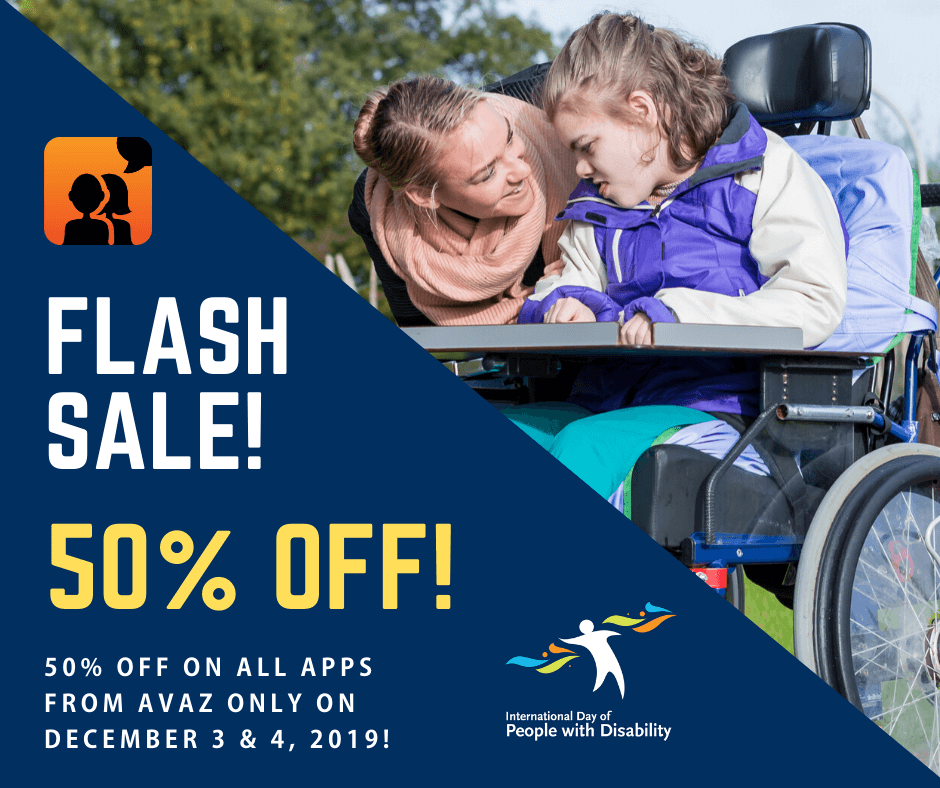 At Avaz, we know that AAC is a potent tool that gives people with developmental disabilities the confidence to voice their minds. So, we’d like to show our commitment to their inclusivity by offering a huge 50% discount on all our products, only on December 3, 2019 and December 4, 2019. We are slashing our prices to honour what December 3 stands for. So that no person with disabilities is held back from achieving excellence! The Date: Dec. 3, 2019 and Dec. 4, 2019 The Discount: 50% off on:
At Avaz, we know that AAC is a potent tool that gives people with developmental disabilities the confidence to voice their minds. So, we’d like to show our commitment to their inclusivity by offering a huge 50% discount on all our products, only on December 3, 2019 and December 4, 2019. We are slashing our prices to honour what December 3 stands for. So that no person with disabilities is held back from achieving excellence! The Date: Dec. 3, 2019 and Dec. 4, 2019 The Discount: 50% off on:- All Avaz AAC products
- Avaz Freespeech
- MDA Avaz Reader for Dyslexia.
Understanding Different Types of Dyslexia
 Dyslexia encompasses a wide range of reading challenges. Though it is not officially divided into any categories, classification may help in understanding the nature of an individual’s reading challenge. This, in turn, can help them receive targeted support. A person with Dyslexia can have more than one reading difficulty and hence can have symptoms associated with more than one type of Dyslexia. Please note that dyslexia types are a convenient way to understand the varied reading and learning challenges faced by an individual. This should not be considered a definitive classification. Here are the common types of Dyslexia that you can come across in discussions:
Dyslexia encompasses a wide range of reading challenges. Though it is not officially divided into any categories, classification may help in understanding the nature of an individual’s reading challenge. This, in turn, can help them receive targeted support. A person with Dyslexia can have more than one reading difficulty and hence can have symptoms associated with more than one type of Dyslexia. Please note that dyslexia types are a convenient way to understand the varied reading and learning challenges faced by an individual. This should not be considered a definitive classification. Here are the common types of Dyslexia that you can come across in discussions:Phonological Dyslexia
Surface Dyslexia
Rapid Naming Deficit
Double Deficit Dyslexia
Addressing the Different Reading Challenges
Teachers and parents can provide tailor-made solutions once they understand the specific combination of reading challenges faced by an individual. They can use apps such as MDA Avaz Reader which can help with phonological awareness, which is the ability to recognize and manipulate sounds in a word. The app can also help with reading comprehension by providing hints for conceptual understanding. People with Dyslexia can be demotivated by their challenges and may find reading unenjoyable. Learning solutions that let them focus on a single sentence can make reading stress-free. This can be particularly useful for those who can find viewing the entire page intimidating. Children with different types of Dyslexia can underperform in schools due to their reading difficulties. Their challenges can be a roadblock to their academic progress if the do not receive adequate support. Early intervention and focussed educational approaches can enable the children to read better and allow them to reach their full potential.5 Ways to Make Thanksgiving a Fun Experience for Children with Special Needs
 Thanksgiving is a time when families get together and express their gratitude for life’s many blessings. While it is a favorite holiday for many, the hectic activities surrounding the day can be stressful for children with special needs. However, with a little planning, you can make Thanksgiving an enjoyable holiday for all children.
Thanksgiving is a time when families get together and express their gratitude for life’s many blessings. While it is a favorite holiday for many, the hectic activities surrounding the day can be stressful for children with special needs. However, with a little planning, you can make Thanksgiving an enjoyable holiday for all children. Serve Them the Meal They Love
Several families have family traditions such as a feast that includes turkey, stuffing, cranberry sauce and sweet potatoes. Your child’s not a fan of turkey and cornbread? Include their favourite Mac and Cheese in the menu. This way, you can ensure that your child truly enjoys the Thanksgiving dinner. Accommodate your child’s specific dietary needs in your holiday planning. Make a shopping list ahead of time and remember to include your child’s favourite drink and dessert in the menu too. Some children with special needs may not do well with change in routines. In such cases, discuss the menu with your child in advance so that they know what to expect during dinner.Give Them a Task To Do
You can include your child in the holiday planning by assigning them a task. If your child loves baking, put them in charge of cookie cutting. Take your child to the grocery store and ask them to look for the items in your shopping list. You can also ask them to help you with the decorations. Ask your child how they’d like to help. Give them a few options so that they can pick a job they are comfortable doing. Entrusting them with a responsibility gives them a sense of pride when they complete the task.Talk to Them About Gratitude
Sit together as a family and take turns talking about what you are grateful for. If your child is uncomfortable participating while the guests are present, plan this activity for after the guests leave. Encourage your child to share the things they are thankful for. If your child has trouble coming up with a verbal response, you can ask them to write or type out Thank You notes instead. Some children with special needs can respond better to visual representation. Show them pictures of vacations and fun events that they enjoyed. You can also add these images to your child’s AAC app and talk about them. This can help them recall fond memories of those events and motivate them to express their gratitude.Identify a Safe Space
Whether you are hosting the dinner or celebrating Thanksgiving at a friend’s home, it is important that you find a safe space for your child. Unfamiliar people and boisterous conversations can overwhelm children with special needs. If they feel distressed and experience a sensory overload, whisk them away to the safe space you had already identified. If the loud music gets too much for them, give them a pair of noise-cancelling headphones that can help in calming them. Carry their favourite toy or book and keep it handy. Reading their favourite story or playing with a familiar toy can distract them and help them relax. If the child insists on leaving, oblige and take them away from the place immediately.Have a Socializing Plan in Place
Social gatherings can cause anxiety in children with special needs. Enlist the help of a family member who the child feels at ease with, like their grandparent or aunt. So, when you are busy entertaining the guests, the family member can make sure that your child is relaxed. Talk to your child about the guests you are expecting. Thanksgiving can be a time to teach them social etiquette. You can discuss with your child about greeting the guests. You can also load phrases in the aac app that the child can use to welcome the guests, so that they do not have to worry about remembering what to say. Even a well thought-out plan can go out for a toss, especially when the Thanksgiving party has people of all ages in the mix. That doesn’t mean you shouldn’t plan! Have snacks and surprise goodies that can brighten up your child’s mood. Remember to follow their lead during the party, and make sure they are comfortable at all times. By following these simple tips, you can make Thanksgiving a holiday to remember for you and your family. A heartfelt thanks for your continuous support. Team Avaz wishes you a Happy Thanksgiving and all the joy and abundance the holiday season brings.A Comprehensive Look at Echolalia Definition, Types, and Purposes
Echolalia in Autism
An individual with echolalia repeats or imitates words or phrases they hear. Verbal repetition is seen in all young children as they begin to communicate. In fact, it is a vital part of their language learning and development. But, as they grow older, children generally start expressing their own thoughts through their words, in addition to verbal imitation. Children with ASD, on the other hand, tend to have echolalia longer than typical children. Echolalia used to be dismissed as a behaviour with no communicative intent. But, recent studies have shown that it may be a part of the child’s attempt to have a meaningful exchange. A growing number of experts reiterate the need to understand a child’s echolalia. They believe that parents, teachers, therapists and other caregivers should attempt to figure out what the child is trying to communicate through verbal repetition.What is Echolalia
Children with ASD can learn language as phrases or a string of words, and associate them with situations. They may do so without understanding the meaning of individual words. This may lead them to utter phrases that might seem out of place. But on careful observation, you may be able to understand the communicative intent behind their random utterances. For example, the child may say, “Is this your sister?”, while meaning to say “This is my sister.” Similarly, the child may utter phrases from movies or TV shows they have been watching. For instance, the child may say, “Okay,bye” when they did not get to play with their favourite toy. This might seem irrelevant to those who are unfamiliar with the TV show or movie. But that may be the child’s way of expressing their disappointment, because a character in a movie they watched used the exact phrase to convey their disappointment. Repeating words right after hearing them is known as immediate echolalia. Repeating words at a later time is known as delayed echolalia. Delayed echolalia may be harder to comprehend by others, because people might not be able to make the connection to the phrases, words, or sentences uttered, due to the delay.Interactive Echolalia and Non-interactive Echolalia
Delayed echolalia is categorised into interactive echolalia and non-interactive echolalia. Interactive echolalia, also called functional echolalia, is an effort to communicate with another individual. Non-interactive echolalia maybe for personal use and generally lacks communicative intent. You may be unable to ascertain if the echolalia is interactive or non interactive unless you are familiar with the individual. Since echolalia may involve information referenced from the individual’s personal life, a stranger might not be able to deduce the connection and identify interactive echolalia.Purposes of Interactive Echolalia
Here are some of the ways and purposes for which interactive echolalia may manifest. This may help you identify similar cues in your child, or those you work with. Requesting The child may say “Would you like a sandwich?” around lunchtime. It might look like the child is just repeating what they heard earlier. But that may be the child’s way of requesting a sandwich. Initiating Interaction The child may say, “Ahh..This chair is just right” if they wanted someone to read them the story of ‘Goldilock and the three bears’. Showing Approval or Disapproval The child may say, “Don’t you want to play now?” instead of saying, “I don’t want to play now’. Similarly, if the child is asked, “Did you like the movie?”, they may repeat the question to say that they liked the movie. Giving information: A child may sing, ‘Hush little baby’ to say that they want to go to sleep. A parent may be able to make the connection because they sing it to the child while putting them to bed. Seeking Attention The child might repeat any gibberish or phrases that drew the attention of their parents or teachers earlier, to get their attention again.Purposes of Non-interactive Echolalia
Non-interactive echolalia may not have a communicative intent. But it is important to the child in their process of making sense of the world around them. Here are some ways in which children may use this. Non-focussed The child sings a song or repeats dialogues from a movie they watched earlier. These utterances are generally not intended for communication and maybe for self-stimulation. Situation association: The child’s utterances might be because an object, event, or a person caught their attention. For example, when they see an apple in the local supermarket, they may sing a song from the apple juice TV commercial. Rehearsal: The child may repeatedly whisper a phrase to themselves before uttering the same in a normal voice. This may be a way of preparing themselves for the upcoming interaction. Self-direction: The child may instruct themselves as they perform an activity. For example, if the child wants to put away the toys, they might say, “Pick up the truck, then pick up the car, put them in the toy box.” Labelling The child may point out to random objects or actions and label them repeatedly. For example, the child may notice a fruit and repeatedly say, “Fruits. Fruits are healthy.” The child may do so without intending to request a fruit. This may be the child’s way of using words to learn language.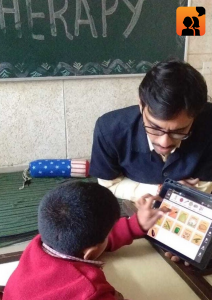 Echolalia Intervention
Echolalia Intervention
The child's use of echolalia may be because they do not know the correct response. Training them to say, “I don’t know” can help in them using the phrase when they do not know the answer to a question. Another approach is to teach them the appropriate response. For example, you can ask, “How are you doing?", and say, “I’m fine.” immediately. This will help the child understand the correct response to the question. AAC (Augmentative and Alternative Communication) solutions such as AAC apps can be useful in augmenting the language of verbal communicators and help mitigate echolalia. The app can help them break down phrases into meaningful words and enable them to develop language that reflects their thoughts. AAC strategies can also help them learn new words and understand their meaning. With consistent AAC use, children can learn to use language for autonomous communication instead of giving scripted responses. Children who repeat words without understanding their meaning can go on to alter the same phrases, indicating comprehension. They may also use more flexible language, suggesting independent thought. Though the child may occasionally use echolalia for self-stimulation when distressed or exhausted, they might begin to use phrases and sentences appropriately as they begin to understand language better. Echolalia can therefore be looked at as a positive step in language development, rather than a purposeless habit. Hope you find this post on echolalia definition and purposes useful. Please share your ideas on echolalia in autism in the comment section below.AAC and Smart Assistants: A Productive Partnership
 When the whole world gets to use smart technology to simplify their lives, why should AAC users be left out? Alexa, Siri, or Google Assistant, AAC’s friendship with smart assistants is rewarding and is here to stay. It’s not breaking news that smart technology has become a part of the everyday lives of several families across the globe. We’ve seen viral videos of children asking Alexa for help with their homework, and toddlers having serious exchanges with Google Home. This trend is proving to be fantastic for AAC users! Smart technology is an exciting way for AAC users to use their AAC devices.It is indeed heartwarming to see that AAC users are increasingly embracing smart technology and joining in on the fun.
When the whole world gets to use smart technology to simplify their lives, why should AAC users be left out? Alexa, Siri, or Google Assistant, AAC’s friendship with smart assistants is rewarding and is here to stay. It’s not breaking news that smart technology has become a part of the everyday lives of several families across the globe. We’ve seen viral videos of children asking Alexa for help with their homework, and toddlers having serious exchanges with Google Home. This trend is proving to be fantastic for AAC users! Smart technology is an exciting way for AAC users to use their AAC devices.It is indeed heartwarming to see that AAC users are increasingly embracing smart technology and joining in on the fun. How About a Little Banter?
There is no denying that there can be a learning curve for AAC and some beginners may be uninterested in exploring the app or device at the start of the journey. Parents can also struggle to get their children to use AAC. Forcing the child will only end up being counter-productive as the child will look at it more as a chore. Children who learnt to use AAC can also discontinue using it due to several factors such as unavailability of the device in classrooms, or simply because they lose interest over time. Smart assistants, thankfully, have enough pizzazz to fascinate them. The ability of AAC apps to speak to Alexa or Google Assistant gives them the impetus to reach for their AAC device. They too want to interact with this digital ally in the living room that everyone their age seems to be connecting with. Asking Alexa for a joke, or Google Home for a riddle are all fun activities for children. The bonus for parents is that these are also opportunities for the AAC users to use and learn language.A Good Communication Partner?
It is an undeniable fact that a good communication partner can motivate the AAC user to continue using AAC. The communication partner needs to be patient and should not make the user feel pressured to communicate. The availability of the communication partner is also a major factor. Parents and caregivers have the best intentions but they are only human. They may not be able to devote time for modelling AAC as much as they’d like, while juggling multiple responsibilities. Smart assistants cannot substitute the human experience. Nor can they read non-verbal cues or gain the understanding the parent has of their child. However, they oblige and respond to an AAC user’s request at all times. This 24/7 availability of digital assistants is definitely a motivator for AAC use despite their other shortcomings as communication partners.The Gateway to a Wealth of Information
The internet is a treasure trove of information and smart assistants can give AAC users access to abundant information. It helps to have an unpretentious know-it-all at home, right? Parents having a tough time answering the questions of children curious about why the sky is blue, and why leaves fall in autumn, can redirect the children to the digital assistants. This can help the child acquire knowledge about a variety of subjects, with just a few taps on the AAC device. Parents can incorporate smart assistants into the child’s learning strategy if they prefer listening to information, than reading it. They can also load questions and phrases in the child’s system related to the child’s favourite topic. For example, if the child is interested in space, parents can add relevant questions into the child’s system and let the child use AAC to get answers from the smart assistants.Independence and Control
Smart technology is not only fun and games. From controlling the temperature in your home to checking mails, there is a lot more you can do if you have the compatible devices. Smart appliances such as air conditioners, water purifiers, and heating systems have redefined comfort and convenience for everyone. For AAC users, however, independence is probably the primary benefit. The ability to control their surroundings without help from others can be truly liberating. AAC users can also request news headlines, play music, set alarms and make calls using smart assistants. The element of self-dependence in the use of smart assistants can also boost their self-esteem. Digital assistants can also help in receiving emergency care and medical attention. Parents must create a separate folder for emergency use so that the user can call a professional or a caregiver in times of distress. They should also explain to the child how to navigate to the folder and go over probable scenarios when they may need it. As smart as they are, digital assistants are nowhere near being perfect. They may have trouble comprehending different accents and phonologies of natural speech, and the results can be often hilarious or exasperating, depending on your request. The same can be true for voice output from AAC apps. So, it is better that parents guide young AAC users as they interact with the smart assistants. Minor glitches aside, this coalition between AAC and smart technology spells success for AAC users by broadening the scope of accessibility.Assistive Technology for Autism: AAC as a communication solution
 People with Autism can have difficulties with speech, language, and communication. Read on to learn how assistive technology for autism such as AAC can help in addressing some of the challenges faced by those with ASD.
People with Autism can have difficulties with speech, language, and communication. Read on to learn how assistive technology for autism such as AAC can help in addressing some of the challenges faced by those with ASD.AAC and Autism
Autism Spectrum Disorder (ASD) or Autism refers to a range of conditions including Asperger’s Syndrome and Pervasive Developmental Disorder Not Otherwise Specified (PDD-NOS). Social, behavioural, and communication challenges are common amongst those with ASD. The extent of these challenges can vary from person to person depending on the specific condition and the severity of symptoms. While some people on the spectrum may have exceptional abilities and speak well, others may have limited speech and language abilities. A lack of speech, or deficit in language does not necessarily mean that the person has low intellect. So, it is important that people with ASD receive appropriate communication interventions such as AAC (Augmentative and Alternative Communication). Such interventions also give them the best possible chance at gaining literacy and social communication skills.Why is Communication Intervention Important?
Communication is the bedrock of social interactions. So, for those with ASD, communication deficits can compound their troubles with making conversations in social situations. Communication also helps children with ASD connect to their parents, siblings, and teachers. It allows adults on the spectrum to foster significant relationships and participate actively in society. According to experts, perceived problem behaviours in those with ASD may also be a way of communicating. When there is a lack of proper communication outlet, people with ASD may resort to disruptive behaviours to convey their irritability or disagreement. Providing them with an effective communication strategy such as AAC can help manage their emotions better. As is evident, enhancing communication skills enables people with ASD to deal with their other difficulties such as social and behavioural challenges.Gives Them Control
There has been increasing autism awareness and acceptance over the years. But there is still a long way to go in terms of fully comprehending the disorder and its broad range of characteristics. With people on the spectrum, the emphasis sadly tends to be on controlling their atypical behaviours rather than giving them a sense of control. Without communication interventions, non-verbal and minimally verbal children on the spectrum have no way to clearly express their opinions, preferences, misgivings, and grievances. Their ideas are taken for granted and choices are made for them. With AAC, they can learn to manipulate their surroundings and be an active participant in decision-making.Promotes Self-Advocacy
Self-advocacy is essentially “speaking for yourself”. Parents must encourage self-advocacy in their children with autism because it can positively impact their self-esteem. It lets the child know that their ideas are valued and gives them the confidence to voice their opinions in social settings. Since people on the spectrum can require the support of others, including parents, carers, and professionals, their independence can be undermined. So, parents must listen to the children and respect their right to disagree, refuse, or challenge their choices. The children should have easy access to icons in the AAC system through which they can say Yes or No, and express their approval or disapproval. Moreover, children must be encouraged to discuss, negotiate and present their ideas emphatically. Self-advocacy also deters abuse and mistreatment of people with disabilities. Adults with ASD can use AAC to report their dissatisfaction with the care they receive. Consequently, it allows them to dictate the standard of support they get instead of settling for suboptimal care. Self-advocacy also helps reframe the public opinion of people with ASD and gives them the power to control the narrative.Ways AAC Systems can Help Children with ASD
Providing symbol-based AAC to children with ASD can help them develop their vocabulary. This is because they respond better to visual information. AAC apps that allow symbol-based and text-based communication can help expand their language abilities when they are ready for it. AAC systems can also help with a child’s comprehension of language. Since children with ASD can also have intellectual disabilities, they can take longer to process language and understand words. Besides, they may not be able to understand non-verbal communication. Communication with AAC is typically slower than speech. Therefore, it gives the child more time to understand and respond to the information. The access to visual representation of the information allows them to construct appropriate responses at their own pace. This helps in stress-free communication for both them and their communication partners. Several people with autism lead successful lives by learning to manage their symptoms. AAC is an important intervention strategy that ensures that they are not defined or limited by their communication deficits. Besides, early access to AAC gives them the tools to combat their challenges and lets them focus on their individual strengths and talents. What are your thoughts on assistive technology for autism? Please share your ideas about AAC and autism in the comment section below.Family Caregiver Support: The Role of AAC in Narrowing the Communication Gap
 Caregivers are the unsung heroes who spend their time and energy making life easier for those they look after. Caring for a person with complex communication needs requires a lot of dedication and patience. In many cases, family members act as caregivers and tend to ignore their own emotions and needs for the sake of their loved ones. So, It is important that we prioritize caregiver support and rally around them as a society by providing them with the necessary resources. Most discussions on assistive technology (AT) revolve around how it can help people with disabilities. In this post, we’d like to shift the focus to how AT including AAC (Augmentative and Alternative Communication) can lighten the load of caregiver responsibilities. Evidence suggests that AAC helps caregivers by giving them a better understanding of the needs of people with communication difficulties.
Caregivers are the unsung heroes who spend their time and energy making life easier for those they look after. Caring for a person with complex communication needs requires a lot of dedication and patience. In many cases, family members act as caregivers and tend to ignore their own emotions and needs for the sake of their loved ones. So, It is important that we prioritize caregiver support and rally around them as a society by providing them with the necessary resources. Most discussions on assistive technology (AT) revolve around how it can help people with disabilities. In this post, we’d like to shift the focus to how AT including AAC (Augmentative and Alternative Communication) can lighten the load of caregiver responsibilities. Evidence suggests that AAC helps caregivers by giving them a better understanding of the needs of people with communication difficulties.Prevents Caregiver Burnout
Caregivers can get overwhelmed by the demands of providing long-term care. They can experience burnout which is a state of physical, mental and emotional exhaustion. It is, therefore, important to ensure that the family member often gets to take a break from caregiver duties, and indulges in self-care. In the absence of AAC, people with communication challenges may be understood only by a few. This results in them developing a heavy reliance on the primary caregiver as they may be the sole provider of physical and emotional support. This constant dependence can put enormous strain on the caregiver. AAC helps with comprehension and expands the possibilities of interaction with a wider range of communication partners. It also enables those with communication challenges to develop independence while they foster and maintain a variety of relationships. This allows the caregiver to enlist the help of other family members or friends who can share their responsibilities.Enables Better Connection 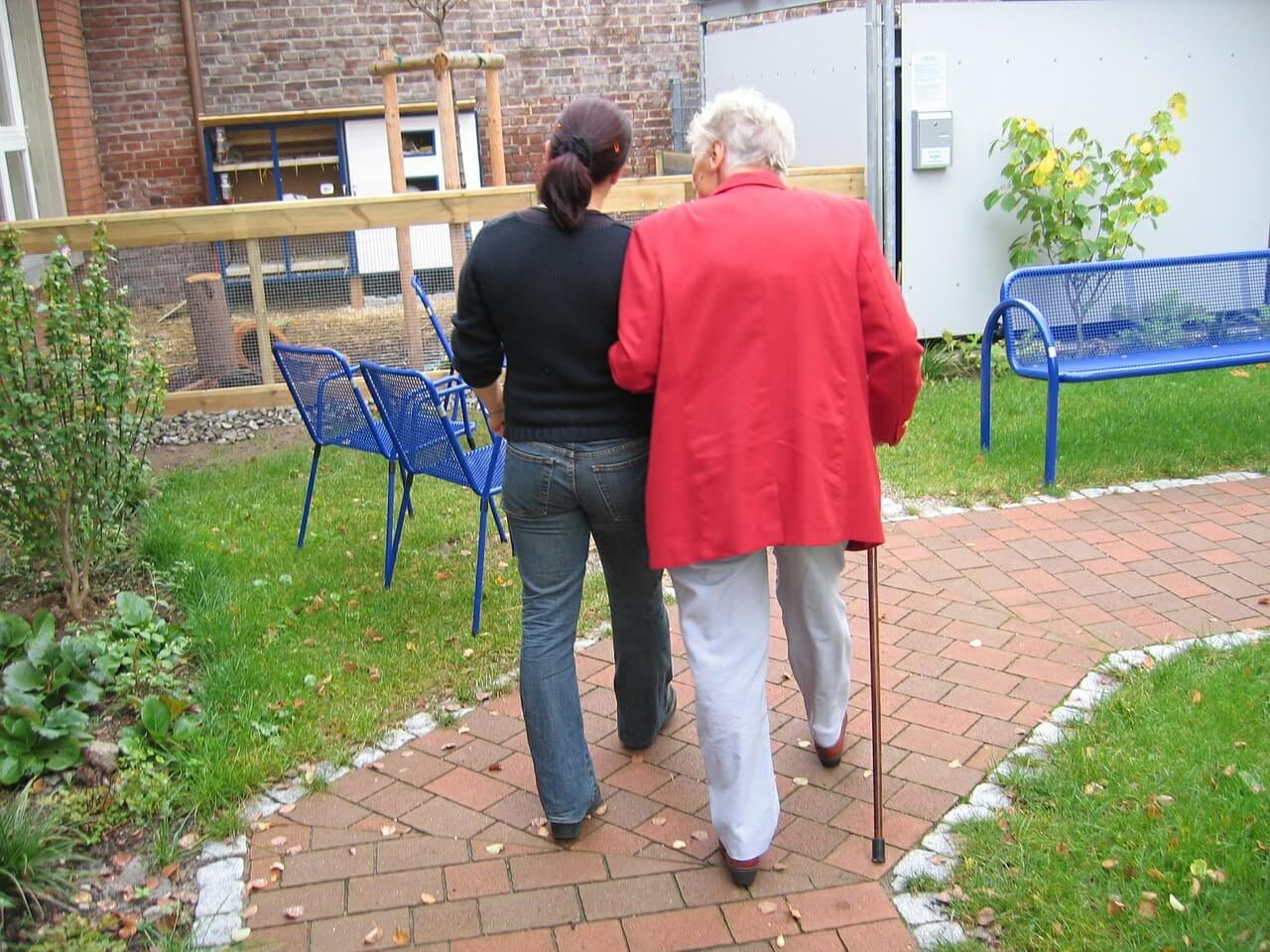
Children taking care of elderly parents who have lost communication abilities later in life due to stroke or other conditions, can struggle to cope with the decline in the quality of their interactions. The same applies for spouses of older people with communication challenges. AAC can help them have meaningful exchanges which make caregiver duties less stressful and more rewarding. AAC promotes mutuality which is defined as the maintenance of a positive relationship between the caregiver and the care-receiver. Love, shared pleasurable activities, shared values, and reciprocity are the four factors that affect mutuality. Mutuality is said to reduce role strain of the caregiver and enhance the quality of care they provide. With AAC, people with communication challenges can be part of family activities and actively participate in conversations. They can share their stories and talk about common interests. This reciprocal nature of the relationship can reduce fatigue caused by caregiver duties.Facilitates Caregiver Preparedness
The support required for people with complex communication needs may vary over the course of time. Preparedness is defined as the perceived knowledge about the different dimensions of caregiver responsibilities such as providing physical care and emotional support, and the readiness to deal with impending changes. When there is a lack of communication, caregivers have a hard time monitoring the health of those who receive care. They can find it difficult to assess medication side-effects and evaluate the extent of support needed. With AAC, people with complex communication needs can report their discomfort or the improvement in their symptoms more clearly. This enables the caregiver to make the necessary changes in the medical care or arrange for additional support systems if required.Helps in Making Optimal Choices
It can be stressful to care for a loved one who is in need of continuous support. Communication difficulties add to the problem because people with communication challenges can get frustrated when they don’t have a say or are being misunderstood while decisions or choices are being made for them. This can cause anxiety and may also increase the workload of the caregiver. Without proper communication, the caregiver feels a lack of control. They may feel guilty about not being able to understand the needs and wants of their loved ones. This unrealistic demand they put on themselves can ultimately wear them down. AAC enables people with speech and language difficulties to communicate their preferences and opinions clearly. This helps take the guesswork out of the equation. Consequently, it reduces the burden on the caregiver by freeing them from the responsibility of making everyday choices on behalf of their loved one. Family caregivers, also known as informal caregivers provide care that can match professional care provided by hospitals and nurses. However, a lack of expert guidance and knowledge can affect their care giving skills. Therefore, they must be equipped with relevant information, tools like AAC, and a reliable support system that they can fall back on at all times. What are your ideas about caregiver duties and responsibilities? Do you think being part of caregiver support groups can help? Please share you opinions in the comment section below.AAC Apps for Adults with Acquired Communication Disorders
What are Acquired Communication Disorders?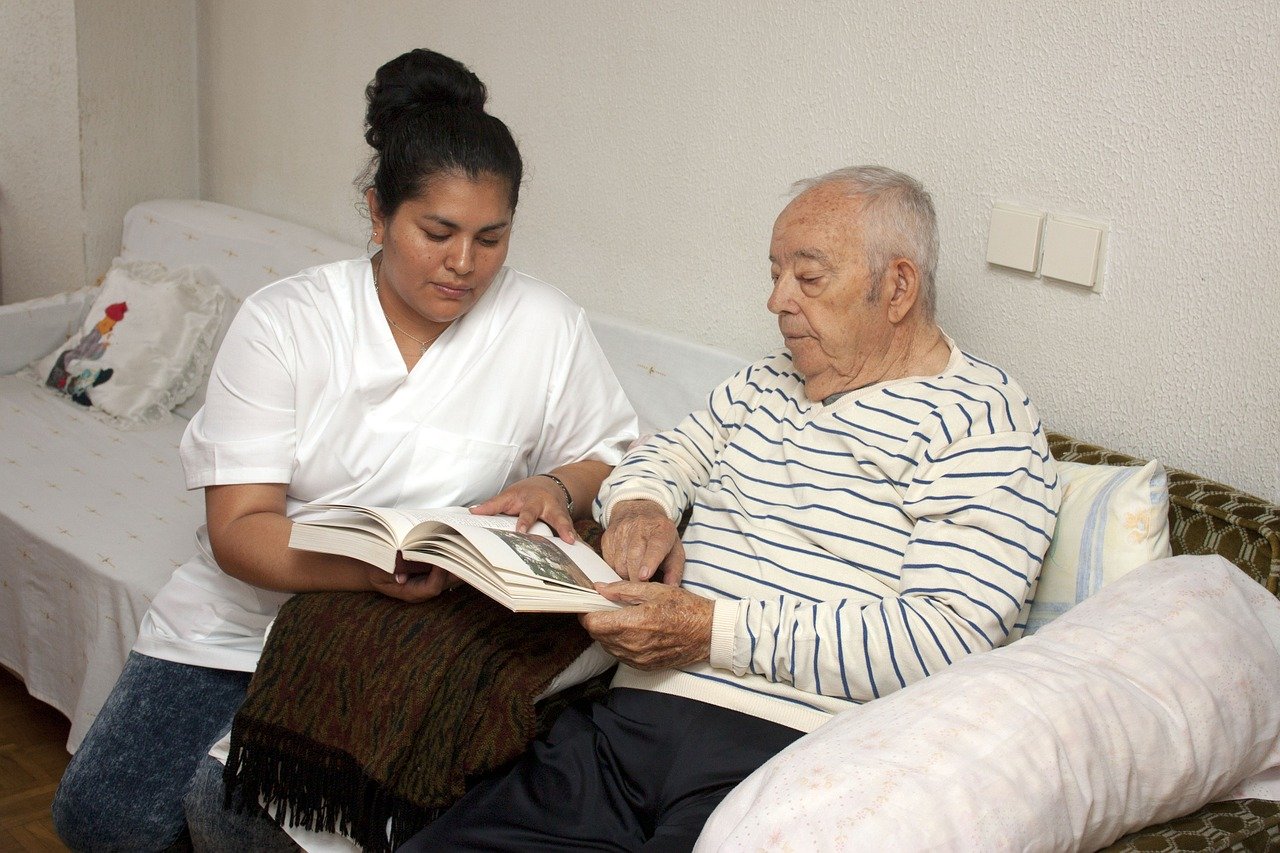
Adults with normal speech, communication, and cognition skills can lose some or all of their abilities due to a severe illness or an accident. Some of the common causes of acquired communication disorder are:- Traumatic brain injury due to falls, motor accidents, or assaults
- Dementia
- Motor neurone disease
- Parkinson’s Disease
- Stroke
- Head and neck cancer
- Other neurological conditions
Skills Affected by Communication Disorder in Adults
There are several components of communication such as speech, receptive and expressive language, and cognition that can get affected by communication disorders. Family members may have a hard time understanding the difficulties their loved ones face while communicating. All this may also cause them to withdraw from socializing or avoiding social contact altogether. They may undergo changes in personality due to the emotional trauma resulting from the physical deficits. Learning about the exact nature of communication impairment can help in arranging targeted treatment and therapy.Common Types of Communication Disorders in Adults
Here are the common types of communication disorders adults can acquire over their lifetime:- Aphasia A loss of the ability to produce or comprehend language. Stroke in the left side of the brain is a common cause of the disability. Adults with Aphasia may have trouble with reading, writing, using numbers, drawing, sign language, using gestures, and expressing their thoughts using the right words.
- Dysarthria A speech disorder resulting from damage to parts of the brain controlling muscle movement. Adults with the disability can have slowness, weakness or poor coordination of speech. The severity of the disability and extent of speech impairment may vary from person to person. Speech may seem mumbled in adults with mild dysarthria while it may be more slurred and unintelligible in others.
- Apraxia of Speech An oral motor disorder where the individual is unable to make the necessary motor plans involving voice, lips, and tongue to produce speech.
- Cognitive-Communication skills Communication disorders that affect attention, judgement, memory, perception, reasoning, and other cognitive abilities. Trauma due to falls, automobile accidents or a stroke in the right side of the brain can cause these communication deficits.
Why Use AAC
What AAC system to use
Adults with communication deficits may or may not have accompanying physical or cognitive impairments. So, SLPs need to evaluate each individual to decide which AAC will be the right fit for them. As with all augmentative communication solutions, there cannot be a one-size-fits-all approach. Here are a few factors to consider while choosing an AAC system:- Motor Skills Patients affected by stroke and certain neurological disorders may have physical impairments in addition to communication challenges. So, the choice of AAC devices for adults should depend on whether they will be able to navigate the system without difficulty. For ambulatory patients, a portable and reliable system such as a robust AAC app whose features support specific motor issues might be the best option. For those who may have trouble swiping the screen, or touching and selecting smaller buttons, it is important to choose apps where icon sizes, speed, navigation options, and screen parameters can be customized easily.
- Communication Abilities and Preferences Since communication disorders can affect cognition, visual supports may be more helpful for certain adults. Low tech AAC such as picture cards can help them with remembering things and initiating conversations. If they prefer high tech solutions such as an AAC app, it is advisable to choose one that supports multiple modes such as symbol-based and text-based communication. This is important because symptoms can worsen over time with in case of degenerative diseases. So, it is wise to choose an AAC solution that can adapt to the user’s changing needs.
- Ease of Learning The cognitive abilities of an individual determines the system they are capable of learning to use. Ease of learning is an important feature to look for because it can influence the continuous use of AAC by a user. Complicated design can discourage the user and can result in a lack of motivation to use AAC for communication.
- Accessibility It is crucial to ensure that AAC is available at all times to anyone who needs it. Users who are dependent on high tech systems can be left with no means of effective communication if the AAC device runs out of charge or is not functional. So, they must be encouraged to use multiple strategies such as sign language if the individual is capable of it, or low tech AAC such as symbol charts, along with their AAC apps.
Teletherapy: A smart way to facilitate remote speech therapy for adults and children
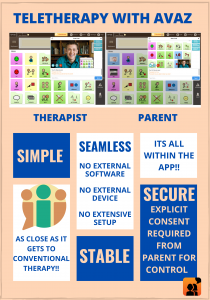 What is Teletherapy?
What is Teletherapy?
Speech teletherapy or telepractice is the online delivery of therapy services implemented by taking advantage of state-of-the-art telecommunication technologies. It was duly approved by American Speech-Language-Hearing Association (ASHA) in 2005. Since then, it has been growing in popularity in the U.S and has emerged as a game changer in the field of speech and language pathology. With the Corona virus pandemic sweeping the globe, teletherapy has turned out to be the go-to mode of delivering therapy services to people in all parts of the world. Teletherapy breaks down distance barriers and opens up access to the best experts, defying all geographic limitations. It is very similar to traditional speech therapy except that the sessions happen virtually. Teletherapy can be used for consultation, assessment or evaluation, intervention, and regular follow-up of the client. Avaz and Remote Therapy
Avaz recognizes the need for employing modern technologies to ensure access of speech therapy to everyone. Avaz Live is a feature of Avaz AAC app that families and schools can use to seek remote therapy services from experts. There is no additional equipment that you need to buy other than the iPad or the Android tablet that you generally use. Besides, you don’t need to browse for, purchase, install, or update additional software for video conferencing. Avaz Live is, therefore, a seamless solution for Teletherapy.Try out Avaz Live by downloading a free version of Avaz AAC here.
The connection is completely secure because the parent has to explicitly grant access for the therapist to get control of the user’s screen. This ensures confidentiality which is of paramount importance. With Avaz Live, remote therapy is not restricted to discussions alone. 1. The SLP/therapist can take over an Avaz user’s device and tweak settings to change pictures per screen or caption size. 2. They can add/remove vocabulary depending on the user's communication goals. 3. They can demonstrate AAC strategies such as modelling. When the therapist taps on an icon in their app, user can see animation of the same icons in their device. This gives users visual reinforcement. 4. Avaz Live also allows therapists to evaluate how well the user has been using the AAC sytem and recommend steps for further development.How to use Avaz Live for Remote Therapy?
Here are a few screenshots that give you step by step instructions on how to use Avaz Live: [caption id="attachment_4069" align="aligncenter" width="2500"] Therapist's screen[/caption] [caption id="attachment_4070" align="aligncenter" width="2500"]
Therapist's screen[/caption] [caption id="attachment_4070" align="aligncenter" width="2500"] User's Screen[/caption] [caption id="attachment_4073" align="aligncenter" width="2500"]
User's Screen[/caption] [caption id="attachment_4073" align="aligncenter" width="2500"] Therapist's screen[/caption] [caption id="attachment_4071" align="aligncenter" width="2500"]
Therapist's screen[/caption] [caption id="attachment_4071" align="aligncenter" width="2500"] User's screen[/caption] [caption id="attachment_4074" align="aligncenter" width="2500"]
User's screen[/caption] [caption id="attachment_4074" align="aligncenter" width="2500"] Therapist's Screen[/caption] [caption id="attachment_4072" align="aligncenter" width="2500"]
Therapist's Screen[/caption] [caption id="attachment_4072" align="aligncenter" width="2500"] User's Screen[/caption]
User's Screen[/caption]Why Teletherapy is Here to Stay?
Teletherapy is a viable alternative to traditional therapy because access to therapists is not limited by geographic distance. This means that schools and families in districts where the SLP shortage is acute, can avail of therapy services from experts based in other districts. Moreover, it can also serve as a means for people in rural and remote areas to avail of expert help and guidance. There is also a staggering shortage of speech and language pathologists in several parts of the world. This results in the denial of much required speech therapy services in those regions. It is particularly devastating to see how the lack of access to early intervention programs affects several young children across the globe. Teletherapy, even with all its shortcomings, has proven to be a huge blessing for such children.Advantages of Teletherapy
Here are some of the benefits of teletherapy:- Cost-effective : Since there are no transportation expenses involved, teletherapy costs less when compared to traditional therapy sessions.
- Time-saving : Since you can attend the therapy sessions without leaving your home, it saves time that would have otherwise been spent on commuting.
- Flexibility : There are several experts licensed in telepractice speech therapy who offer their services at different time zones and schedules. So, parents and caregivers can fix appointments based on their convenience and availability.
- Convenience : For those with motor disabilities, travelling to a therapist’s office can be an inconvenience. People on the autism spectrum can also feel anxious about unfamiliar places and can find the therpaist’s office uncomfortable. Teletherapy enables such clients to connect with the therapist from the comfort of their homes, with their parents or caregivers by their side.
- Wider Choice of Experts : Schools and families in small towns and villages can get the services of the most renowned and accomplished therapists. They are no longer left to rely on the services of the local professionals who may not have the necessary credentials or expertise.
Why Communication is Key to a Meaningful Existence?
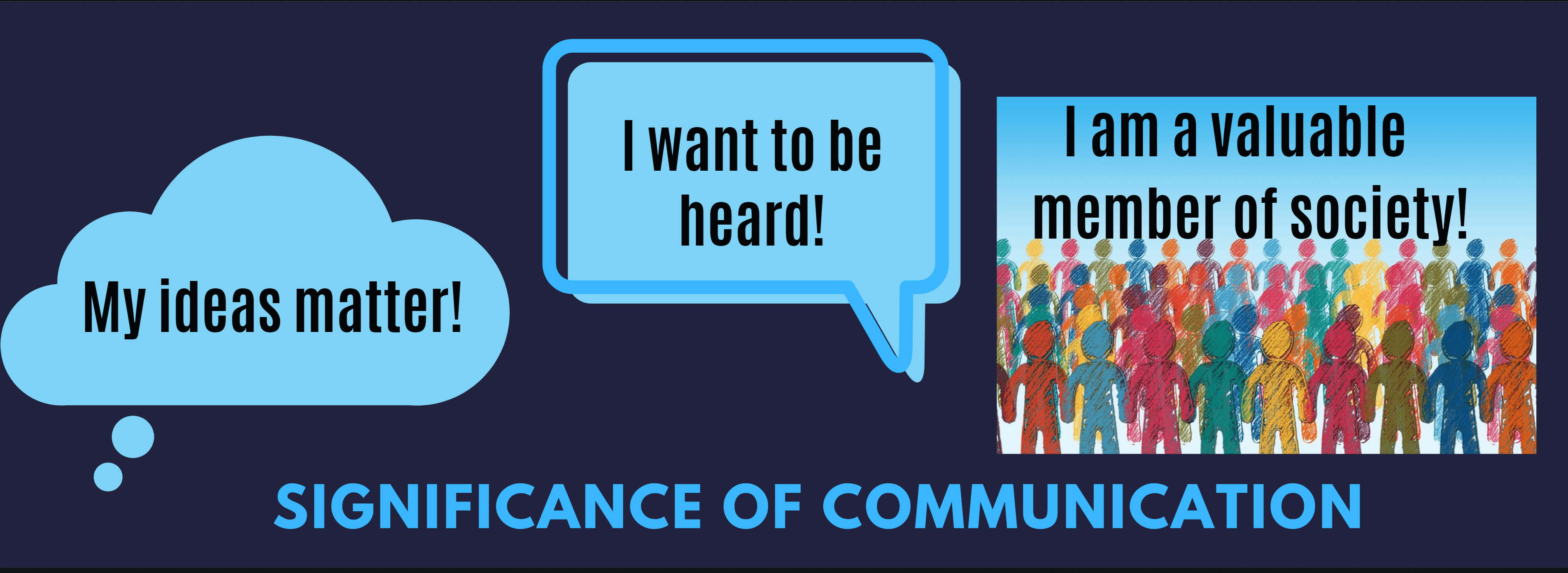 Every person who breathes must communicate. It’s not only a primal need, it’s every person’s right. Read on to find out why communication is key to living a purposeful life. Imagine a world where we didn’t communicate with each other. If that idea seems far fetched, just imagine not communicating with anyone for a whole week. Do you think we will have the same control over our life and surroundings as we had earlier? What impact would it have on our relationships? It doesn’t take much pondering to figure out that communication plays a pivotal role in shaping our lives. Now, think about people with communication deficits due to conditions such as autism, cerebral palsy, or neurological conditions. Their impairments can limit their experiences and inhibit them from reaching their full potential. Thankfully, AAC (Augmentative and Alternative Communication) does a stellar job of equipping people that have speech and language difficulties with vital communication skills that can substantially improve their quality of life.
Every person who breathes must communicate. It’s not only a primal need, it’s every person’s right. Read on to find out why communication is key to living a purposeful life. Imagine a world where we didn’t communicate with each other. If that idea seems far fetched, just imagine not communicating with anyone for a whole week. Do you think we will have the same control over our life and surroundings as we had earlier? What impact would it have on our relationships? It doesn’t take much pondering to figure out that communication plays a pivotal role in shaping our lives. Now, think about people with communication deficits due to conditions such as autism, cerebral palsy, or neurological conditions. Their impairments can limit their experiences and inhibit them from reaching their full potential. Thankfully, AAC (Augmentative and Alternative Communication) does a stellar job of equipping people that have speech and language difficulties with vital communication skills that can substantially improve their quality of life.Understanding Communication
Communicative functions, also called purposes of communication can be classified into the following- Regulation
- Social Interaction
- Shared Attention
Conditions that affect communication
Communication disorders can affect articulation, fluency, voice, or language of an individual. Some of the common causes of communication problems are- Autism, Cerebral Palsy, Down’s Syndrome , PDD-NOS
- Voice problems such as Dysphonia
- Speech problems like stuttering
- Developmental disabilities
- Learning disabilities
- Brain injury
- Stroke
- Hearing impairments
Solutions and strategies
People with complex communication needs use several strategies to make themselves understood. Some of the common solutions used are- No Tech AAC such as Sign language
- Low tech AAC including pen and paper, dry-erase boards picture boards or mini cards, communication charts
- Mid Tech AAC devices with a limited set of pre-recorded phrases with corresponding buttons
- High Tech AAC including Speech generating devices and AAC apps.
Why Comprehension is Key to Communication?
Communication is only productive if your message is conveyed effectively to the communication partner. Sign language can be very helpful but it is not understood by everyone. Gestures and body language too may be understood by caregivers and parents, but can be misinterpreted by those not familiar with the communicator. This is exactly why AAC is recommended to people with communication deficits even if they are minimally verbal. Augmentative tools such as an AAC device can supplement a person’s natural speech and improve their comprehension. Comprehension is important because it broadens the scope of societal participation. It also helps in having earnest social interactions which can be the foundation for building meaningful relationships and a rewarding life. Do you agree that communication is key to leading fulfilling lives? Please share your ideas on communicative functions in the comment section below.AAC Apps: Tips to Choose the Best One for Your Child
Is Learning How to Use the App Easy?
See if the app has built-in tutorials aimed at teaching parents how to use AAC. This is an important feature because parent / communication partner education is vital to ensure the effective use of AAC. Parents / caregivers of children with special needs can have their hands full with their responsibilities. A well-planned tutorial can provide guidance and increase comfort levels with app use. The parent’s comfort in using the app can, in turn, encourage the child to use it consistently.Does it Have a Low Tech Version?
Many parents can overlook the importance of this feature. However, using low-tech solutions along with a high-tech one can make sure that the child has access to AAC at all times. For example, if your child likes playing basketball, carrying an iPad or an Android tablet while playing the sport is not feasible. So, you can give them picture cards for requesting help going to the bathroom or to communicate that they need a break. Choose apps that have a print feature with which you can take a printout of your child’s customized vocabulary instantaneously from the app and create these cards.Does it make Communication Effortless?
Visit the app maker’s website and learn about whether there was any research involved during their development process. Here are a few things to look for:- Core Words:
- Keyboard Mode:
- Prediction:
 Phonetic match in Avaz app[/caption]
Phonetic match in Avaz app[/caption]How Easy is it to Customize and Personalize?
Customization is important and can influence how comfortable the user is with the app. Each child has words that they need to use frequently, and those words should be easy to navigate to. You should also be able to personalize the app by adding your own images or voice for icons. Getting relevant images from the web and adding multiple words or images at one go can also make personalization easier.Does it Support the Child’s Progress?
Many children who start out with pictures soon get comfortable with the keyboard mode. Single-word communicators can expand their vocabulary and increase their sentence length. The app should, therefore, allow the child to grow and develop their communication skills. Make sure that the child’s communication is not limited to only requests. The app must allow a wide range of communication pragmatics including commenting, protesting, expressing opinions, agreeing or disagreeing, and sharing their feelings. [caption id="attachment_2569" align="aligncenter" width="595"]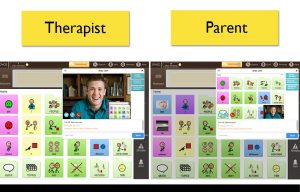 Remote therapy session using Avaz Live[/caption] There are several other features such as Remote Therapy and Analytics that can help monitor your child’s usage. So do take those into consideration as well. Above all else, make sure you consult a Speech and Language Pathologist for a feature match before choosing an app. A well-built app can become your child’s best ally in their communication efforts. So, take your time to analyze the different AAC apps to pick the best app for your child.
Remote therapy session using Avaz Live[/caption] There are several other features such as Remote Therapy and Analytics that can help monitor your child’s usage. So do take those into consideration as well. Above all else, make sure you consult a Speech and Language Pathologist for a feature match before choosing an app. A well-built app can become your child’s best ally in their communication efforts. So, take your time to analyze the different AAC apps to pick the best app for your child. Useful Tips for Raising a Child with Autism – Part II
 Here are 9 simple ideas on how to help children with ASD flourish
Here are 9 simple ideas on how to help children with ASD flourish1.Be specific and concise with directions
For children with difficulty understanding language, instructions in simple terms are easier to follow. Direct and concise messages are hence more effective. Showing them a picture or a visual demonstration of the behavior you want to see, can also be helpful. For example, if your child is throwing food at the table, saying, “Be good at the table.” or ”Would you stop with that?” would be vague. Instead, saying, “Please eat your food.” would give them a clearer sense of direction. Concise instructions specify what is expected of them and what behaviour will not be accepted.2.The ’First/then’ method
The ‘First/then’ method is used to present what’s needed to be done now (first) and what’s needed to be done next (then). You can do this in the form of writing, pictures or even an app. The idea is to use their favourite activity or toy to motivate them to complete the activity they are not so keen on doing. You can say, “First finish your homework, then we’ll go to the park.” This simple phrase helps provide structure in their minds. It also encourages them to follow the directions at hand.3.Sticking to a schedule
Children with an autism diagnosis usually prefer following a schedule. So, plan a daily schedule of routine tasks. You can also prepare a schedule or to-do-list on an AAC app such as Avaz. Incorporating pictures of the task can add an element of fun to it. In case of unavoidable changes, have a backup plan. For instance, if you got stuck in traffic for longer than expected, use the child’s favourite activity, story, or toy to redirect their attention.4.Pay attention to sensory experiences
Many children with ASD have strong reactions to sensory experiences. They can be fascinated or be overwhelmed by certain noises, visuals, textures, etc. Pay attention to what triggers a negative reaction and what evokes a positive reaction. For instance, using noise-cancelling headphones in a noisy classroom can help prevent your child from feeling overwhelmed.5.Creating safe spaces at home
Create safe spaces at home where your child can feel relaxed, secure and calm during a meltdown. A safe space is vital to their mental health. Don’t force entry into the safe space. Give the child the choice to enter the space. Make sure that the safe space does not have anything that can cause a sensory overload.6.Provide choices
Providing children with choices gives them a sense of control over their world. However, limit the choices to three or four options depending on the child's abilities. Keep in mind that too many choices can overwhelm the child. Examples of choices are: What would you like to eat? Ice cream , pizza, or something else? Presenting ‘something else’ as a choice is important because it does not restrict the child to choose only among the options you have picked for them. For children with language difficulties, show images of the options on an AAC app such as Avaz to help them make choices with the tap of a button.7.Consistency is Key
Children with ASD experience difficulty applying what they have learnt in one setting, to another one. For instance, your child may be learning sign language at school but may not use it at home. Creating consistency in your child’s environment helps reinforce learning. Caregivers can try incorporating exercises and simple techniques used by the speech therapist at home. Using AAC apps to extend speech therapy at home is a great way to hone their communication skills.8.Join an autism support group
Joining a support group for those with ASD is a great way to meet other families who share similar challenges. Parents can share information, stories, advice and lean on each other for emotional support. Just being around others who share similar experiences can help parents feel that they are not alone in their struggles and foster a sense of community.9.Prioritize self-care
As a parent of a child with ASD, your day can be stressful. Most children with autism are sensitive to their parents’ anxieties, which intensifies their own reactions. Caregivers shouldn’t feel guilty about taking time from their hectic schedule to focus on themselves. Pursuing old hobbies, meditating, catching up with old friends, reading a novel etc. can be a great way to rejuvenate. Lastly, remember that it’s alright to ask for help, because a bit of support from those who care can go a long way in making your life easier. Every child experiences different symptoms of varying severity, and there is no single rulebook for raising a child with autism. Hence, it’s important to take the time to understand each child and their specific needs to help them overcome their challenges. Help a friend or family member diagnosed with autism get started on their journey by sharing this article with them! And if you have a tip that could help others, don't hesitate to share in the comments down below!Useful Parenting Tips for Autism – Part I
1.Educate yourself about Autism Spectrum Disorder
Learning more about Autism Spectrum Disorder will make you better equipped at making informed decisions. There are several excellent online resources and books on autism that can help you with this. Ask questions and exercise discretion while making therapy decisions. Observe your child and try to understand what triggers certain behaviour. This can prevent your child from being put in uncomfortable situations.2.Pay attention to non-verbal cues
Your child may not speak, but they are still communicating with you through non-verbal cues. Pay attention to your child’s facial expressions, gestures, and noises. They can communicate their hunger, fatigue, or other needs through these non-verbal cues. Similarly, you can also convey your message to your child using your tone of voice, by touch, body language and by the way you look at your child.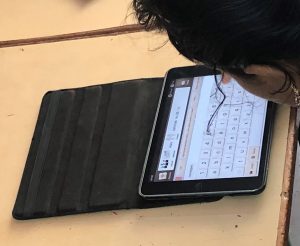 Children with autism may have their own way of communicating their frustration and needs. You may be clueless about how to deal with their meltdowns in the beginning. Try figuring out the reason behind their tantrums. Provide AAC to them as early as possible. Research suggests that AAC helps children express their wants and needs and enables them to communicate better.
Children with autism may have their own way of communicating their frustration and needs. You may be clueless about how to deal with their meltdowns in the beginning. Try figuring out the reason behind their tantrums. Provide AAC to them as early as possible. Research suggests that AAC helps children express their wants and needs and enables them to communicate better. 3.Use timers to decrease transitional tantrums
How often has your child thrown a tantrum, refusing to leave their favourite park? Some children have trouble leaving preferred places or activities. Given their aversion to sudden changes, this is especially true for children with autism. Using a timer on your phone to set warnings before a change can help your child prepare for the transition. For example, setting a 5-minute warning to leave the playground or a 2-minute warning before a bath. This gives your child a sense of control. This way, they have time to prepare for the change and transitions can be made much easier.4.Early intervention
Children who receive relevant education at key developmental stages are more likely to gain essential social skills. Research proves that with adequate support, they learn to interact better with others in society. For children with speech impairments, using AAC apps such as Avaz can help develop communication and social skills. Their ability to communicate helps reduce frustrations that result from an inability to express themselves.5.Focus on strengths
Despite their challenges, some children on the autism spectrum may have extraordinary capabilities. Some have detailed long-term memory and strong visual and auditory learning capabilities. Others excel in Maths, music, and arts. Focus on your child’s unique skills because it can provide them with a sense of achievement. This lets the child know that they have valuable skills and contributes to their self-worth. By shifting the focus on the child’s talents rather than the disorder, you are sending a strong message to the child that you trust in their abilities. This encourages them to invest their time and energy in their hobbies and passions. Acquiring and honing these skills not only keeps them engaged but also boosts their self-esteem.6.Make time for fun
The frequent visits to the doctor and long sessions at the therapist’s can stress your child. Remember that your child needs time for fun and leisure just like any other child. Look for activities your child enjoys such as swimming, music, animal therapy, etc. Set up playdates with other children where you can monitor them. You can also use Avaz in fun activities such as storytelling during bonding sessions with your child. Add images related to the story in advance and ask questions related to the pictures during narration.7.Positive reinforcements
Positive reinforcement is widely used for behavioural interventions. It is done by rewarding your child when they learn a new skill or when they behave well . However, it is important to be very specific about what behaviour you are praising your child for. Instead of punishing undesired behavior, the focus should be on recognizing and appreciating their good behaviour. The positive reinforcer need not be a toy or candy. You may find that children respond well to positive attention and verbal praise. Choose the reinforcer according to what has motivated the child in the past. Children with autism can have behavioural problems. By being observant and persistent, you can help them face their challenges. As parents, you play a major role in the lives of your children, So, being in the know of useful strategies and interventions can enable your children manage their difficulties better. Help a friend or family member diagnosed with autism get started on their journey by sharing this article with them! And if you have any parenting tips for autism that could help others, don't hesitate to share in the comments down below!High Tech and Low Tech AAC: How to Effectively use both
With high tech AAC devices, the possibilities are truly endless when it comes to providing a voice to those with communication deficits. From remote therapy (teletherapy) to literacy supports, high tech AAC seems to have it all. It makes you wonder if low tech AAC devices are still relevant and useful for children with communication challenges.
AAC (Augmentative and Alternative Communication) helps people with speech and language difficulties communicate with others. Phenomenal technological developments in recent years have broken several barriers and revolutionized the way high-tech AAC is being used. Low-Tech AAC might not be as flamboyant as its high tech counterparts. But it can still serve as a beneficial tool that aids your child’s communication. And the interesting fact is that you can use a combination of high tech and low-tech AAC to enhance your child’s communication skills. Read on to find out how.
Get free communication boards for food, emotions, and shared reading here
Get free Language Builder Resources here
What is Low Tech AAC?
Low-Tech AAC comprises of tools and strategies that do not involve electronics and do not require batteries. Examples of Low-tech AAC are PECS (Picture Exchange Communication System), symbol charts, communication boards, communication books, etc. The user selects letters, words, or phrases from the communication charts to convey their message. Users can use a body part such as their finger or toe, a head pointer, eye gaze, mouth stick, light pointer or a hand-held pointer for the selection. People with severe motor and communication impairments may require assistance for using the picture boards or alphabet charts. Partner-assisted scanning is a method where a communication partner scans or presents the messages, letters, or pictures sequentially and the user makes their choice by answering Yes/No questions or with facial expressions.Low-Tech Vs High-Tech AAC
High-tech AAC comprises of tools and strategies that use electricity, electronics, and batteries. High-tech systems might have a clear edge over low-tech AAC when it comes to the extent of communicative functions they are capable of providing. But low-tech AAC can come in handy in certain physical environments and situations. High Tech AAC Pros:- Easier to customize and personalize according to preferences. You can change voices, symbols, and vocabulary level according to the user's requirements.
- Ability to add vocabulary as per the user's progress
- Auditory feedback serves as cue for the user to learn language
- Facilitates communication autonomy by giving the user a wide choice of vocabulary
- Ability to instantaneously download pictures from the web for symbol-based communication
- Compatibility of high tech AAC devices with social media and messaging platforms
- More independence for the user with less reliance of the communication partner
- Less expensive than high tech AAC options
- Easier to create alphabet charts or low tech boards
- Can be used in most physical environments including swimming pools, beaches, bath tubs etc. Laminated communication charts can be used under all weather conditions.
- Does not require charging
Why Accessibility is Key?
Although Low Tech AAC has fewer advantages over high-tech AAC, accessibility is a major attribute that makes you reach for low-tech AAC in certain settings. And accessibility is vital. People with communication deficits may be dependent on AAC to have their needs met. Stripping them off their ability to express their wants and ideas can make them feel powerless. So, it is important to make sure that they have a way to communicate in all environments, at all times.Why a Multi-Pronged Approach Might be the Right Formula
[caption id="attachment_3663" align="alignright" width="335"]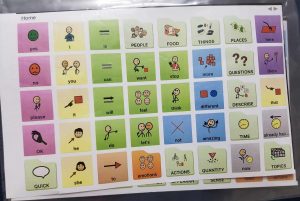 Laminated AAC vocabulary[/caption] Communication is complex and we constantly use several modes of communication to get our message across to others. We use facial expressions, gestures, and body language in addition to our speech to communicate. Similarly, people with communication challenges could potentially use multimodal communication to convey their messages. Low-tech AAC, including laminated communication charts, is useful in demanding environments like pools and beaches.You can also use low tech AAC as a backup communication mode in case the high tech AAC devices run out of charge, or are not functional. You can take a printout of your child’s vocabulary and keep it in your bag or car for quick accessibility. Avaz AAC app for instance, has a handy feature where you can print out a child’s personal vocabulary from the app itself. By using a combination of low-tech and high-tech AAC, people with communication difficulties can have the best of both worlds. Taking away their means to communicate can leave people feeling helpless and frustrated. So, users must be encouraged to choose multiple modes of communication that enable them to communicate across all environments. When used in conjunction with high tech systems, low tech AAC devices can be a powerful communication solution. It can play a pivotal role in enabling communication in people with speech and language difficulties by ensuring all round accessibility.
Laminated AAC vocabulary[/caption] Communication is complex and we constantly use several modes of communication to get our message across to others. We use facial expressions, gestures, and body language in addition to our speech to communicate. Similarly, people with communication challenges could potentially use multimodal communication to convey their messages. Low-tech AAC, including laminated communication charts, is useful in demanding environments like pools and beaches.You can also use low tech AAC as a backup communication mode in case the high tech AAC devices run out of charge, or are not functional. You can take a printout of your child’s vocabulary and keep it in your bag or car for quick accessibility. Avaz AAC app for instance, has a handy feature where you can print out a child’s personal vocabulary from the app itself. By using a combination of low-tech and high-tech AAC, people with communication difficulties can have the best of both worlds. Taking away their means to communicate can leave people feeling helpless and frustrated. So, users must be encouraged to choose multiple modes of communication that enable them to communicate across all environments. When used in conjunction with high tech systems, low tech AAC devices can be a powerful communication solution. It can play a pivotal role in enabling communication in people with speech and language difficulties by ensuring all round accessibility. How to Plan a Stress-Free Halloween for Children with Special Needs?
Adaptive Costumes
[caption id="attachment_2489" align="aligncenter" width="471"]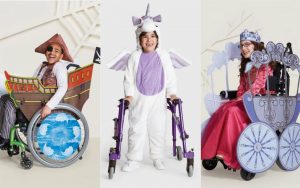 Adaptive Costumes launched by U.S retailer Target[/caption] Choosing a Halloween costume can be tricky for children with special needs. Regular costumes might not be wheelchair friendly and few children can also have sensitivity to certain fabrics. So, parents usually go for DIY (Do-It-Yourself) costumes to accommodate the child's individual needs. But in recent times, we see that retailers are waking up to the idea of inclusivity. There are a lot more adaptive costumes available on the market now. These costumes are tagless and have flat seams. Some costumes include wheel chair covers that match the theme of the costume. Adaptive costumes ensure that your child does not have to compromise on style for their convenience. Children with special needs can choose to dress up as a pirate, a Disney princess, or their favourite superhero and show off their costumes just like other children.
Adaptive Costumes launched by U.S retailer Target[/caption] Choosing a Halloween costume can be tricky for children with special needs. Regular costumes might not be wheelchair friendly and few children can also have sensitivity to certain fabrics. So, parents usually go for DIY (Do-It-Yourself) costumes to accommodate the child's individual needs. But in recent times, we see that retailers are waking up to the idea of inclusivity. There are a lot more adaptive costumes available on the market now. These costumes are tagless and have flat seams. Some costumes include wheel chair covers that match the theme of the costume. Adaptive costumes ensure that your child does not have to compromise on style for their convenience. Children with special needs can choose to dress up as a pirate, a Disney princess, or their favourite superhero and show off their costumes just like other children.Halloween Social Story
[caption id="attachment_2502" align="aligncenter" width="502"]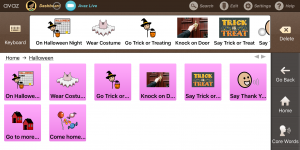 Halloween Social Story created on Avaz AAC app[/caption] Any change from their set routines can unsettle children with special needs, especially those on the autism spectrum. Creating a Halloween social story is a technique that can prepare them for the big day. Here is a sample of a Halloween social story we created for you. Feel free to tweak this story or make up your own to suit your child’s needs. You can make the story as simple or as elaborate as you deem fit for your child. You can also use this folder while taking the child trick-or-treating. Icons to be Added
Halloween Social Story created on Avaz AAC app[/caption] Any change from their set routines can unsettle children with special needs, especially those on the autism spectrum. Creating a Halloween social story is a technique that can prepare them for the big day. Here is a sample of a Halloween social story we created for you. Feel free to tweak this story or make up your own to suit your child’s needs. You can make the story as simple or as elaborate as you deem fit for your child. You can also use this folder while taking the child trick-or-treating. Icons to be Added- On Halloween Night
- Wear Costume
- Go Trick or Treating
- Knock on the Door
- Say Trick or Treat
- Say Thank You
- Go to more Houses
- Come Home and Eat One Treat
Halloween Treat Bucket
[caption id="attachment_2490" align="aligncenter" width="247"] Blue Halloween Treat Bucket[/caption] There has been overwhelming support for a parent from the U.S who has recently proposed that children with special needs carry a blue treat bucket to signify that they have disabilities. Although the idea has its fair share of critics, this emphasizes the need for greater awareness about making Halloween more inclusive. Children with special needs may have different needs including intellectual, language, or physical ones. When every child is expected say ‘Trick or Treat’ out loud, it can lead to many awkward moments for children with complex communication needs and their parents. Children who are non-verbal or minimally verbal may find it nerve-wracking when there is a pause and delay before they get the candy. The blue bucket idea is useful because it denotes to those giving out the treats that the child has special support needs. You can also choose to hand out notes with a brief explanation of your child’s disability.
Blue Halloween Treat Bucket[/caption] There has been overwhelming support for a parent from the U.S who has recently proposed that children with special needs carry a blue treat bucket to signify that they have disabilities. Although the idea has its fair share of critics, this emphasizes the need for greater awareness about making Halloween more inclusive. Children with special needs may have different needs including intellectual, language, or physical ones. When every child is expected say ‘Trick or Treat’ out loud, it can lead to many awkward moments for children with complex communication needs and their parents. Children who are non-verbal or minimally verbal may find it nerve-wracking when there is a pause and delay before they get the candy. The blue bucket idea is useful because it denotes to those giving out the treats that the child has special support needs. You can also choose to hand out notes with a brief explanation of your child’s disability. Notes for Those Handing out Treats
Some might prefer staying home and handing out candy to the trick or treaters. Here are a few things to keep in mind if a child with special needs knocks on your door:- Do not focus on the child’s disability. You may have the best intentions, but making it about their disability can make the child feel uncomfortable.
- Always, always say something nice about the child’s costume. Halloween costumes are a big deal for every child. Especially for children with special needs, wearing a new costume can be overwhelming. So, make sure to appreciate their effort.
- Some children with special needs can take longer to speak their words. If you see them using an AAC app, wait patiently while they type.
- Some children may be non-verbal and may not be able to say ‘trick or treat’. So, it is better to hand out treats or toys to them without waiting.
- Do not expect eye contact as children on the autism spectrum might avoid making eye contact.
- If you have a trick planned to spook the children, please refrain from doing so unless you're sure that the child at the door will be okay with that.
- If you have scary music or lighting in your house that seems to trigger anxiety in a child, please put the child at ease by turning them off.
How to Make Diwali Enjoyable for Children with Special Needs
Explaining the Essence of Diwali
Regardless of which part of the world you are celebrating Diwali in, we can all agree that the festival is essentially about the victory of good over evil. So, Diwali can be an excellent opportunity for you to talk about the story of the Ramayana. You could also have a discussion around the concept of ‘good’ and ‘bad’, if suitable for the child’s level of understanding. Talk to your child about how goodness or good behaviour is celebrated while bad behaviour is punished. Children with special needs may have varying comprehension capabilities. For those who are into mythological stories, you can read a children’s book about the festival. If your child understands pictures better, you can create folders in the AAC app with relevant images. Customizing folders and adding images from the web can be done effortlessly in Avaz AAC app.Diwali Social Story
[caption id="attachment_2497" align="aligncenter" width="481"] Diwali Social Story on Avaz AAC app[/caption] Creating a social story can help prepare your child for all challenges that Diwali day throws at them. Planning ahead enables them to be ready for the day when it arrives. It also helps them relax and enjoy the day more. The challenges of each child with special needs are unique. And so are the Diwali traditions in each household. So, there cannot be one story that works for all children. However, here is an example of a Diwali social story that you can customize according to your child’s abilities- Icons to be Added
Diwali Social Story on Avaz AAC app[/caption] Creating a social story can help prepare your child for all challenges that Diwali day throws at them. Planning ahead enables them to be ready for the day when it arrives. It also helps them relax and enjoy the day more. The challenges of each child with special needs are unique. And so are the Diwali traditions in each household. So, there cannot be one story that works for all children. However, here is an example of a Diwali social story that you can customize according to your child’s abilities- Icons to be Added- On Diwali Day
- Wake up at 7 AM
- Wear New Clothes
- Have Breakfast
- Guests Arrive
- Wish Everyone Happy Diwali
- Fireworks
Sharing Diwali Anecdotes
Conversation is an important form of communication. In fact, experts suggest that when you share things about yourself, it encourages the child to express their views and opinions. So, have a conversation with your child reminiscing about how you celebrated Diwali as a child. You can talk about the Diwali traditions that you followed or the aspect of the holiday you like the most. Talk to them about your favourite Diwali snack. You can also show them corresponding pictures on the AAC app. Diwali is all about getting rid of darkness by spreading the light of happiness and hope. Follow these simple ideas to make sure that your child’s face lights up with joy on Diwali day. Wishing you and your family a Happy, Inclusive Diwali and all the prosperity the festive day brings!!!AAC Communication Device: Importance of A Communication Partner
You analysed all the AAC apps in the market and have introduced the best app to your child. You're thrilled that they are using the app to communicate with you. You are looking forward to your child developing communication skills by exploring the app. But did you know that learning how to be a good communication partner is as important as your child learning to use the AAC Communication device?
Communication is essentially an exchange of information. Its efficacy depends on the communication skills of all parties that are part of the interaction. Your ability to be a good communication partner can substantially influence your interaction with an AAC user. Therefore, it is important that people who regularly interact with children using AAC apps focus on acquiring skills that enable them to communicate efficiently. Here are a few strategies you can practice to become a more effective communication partner -Modelling
Modelling is an important aspect of communication through AAC. Model consistently to show the child how the AAC system can be used. Creating opportunities to model motivates the children to learn how to use the AAC devices. Focus on modelling the keywords or core words when you are getting started. Once the child gets familiar with AAC, you can expand their vocabulary by modelling more words. Ignore the grammatical errors as long as they don’t affect the meaning of the messages. You can correct the grammar when the children are ready for it. Avaz has an useful feature wherein you can print your child's vocabulary from the app. That way, you can easily continue modelling in settings where you cannot carry the device.Making Conversations
When the child is just getting started with the AAC system, you may ask simple questions to encourage the child to use the AAC system. However, communication is complex and involves more than asking Yes/No questions. Make sure your conversation with the child includes making observations and expressing opinions. By asking only questions, you are controlling the conversation. This leads to the child having no say on the topic chosen and they end up having to take a backseat in the conversation. The child is merely responding and does not have the opportunity to initiate conversations. Talk about topics that may interest the child. Their favourite TV shows or books, perhaps. Use AAC devices to describe how your day at work was, or talk about what you are planning to make for dinner. Discussing everyday things such as food and clothes with the child enables the child to talk about their preferences. Talking to your child about diverse scenarios also paves the path for them to use language for real communication. This increases the chance of them having meaningful conversations and fostering significant relationships.Giving Them Time
A child new to AAC can take time to respond using AAC apps. Therefore, it is important to be patient. Don’t get discouraged by their lack of response. Some AAC users may take longer to process your input. If you asked a question or made a comment, pause before proceeding with the next input. Typing messages using AAC devices takes time. Communication partners must be instructed to wait for the AAC user’s response.This includes siblings and peers at school. Rushing them to respond immediately or moving on without waiting for their response can be counterproductive.Prompting
Prompting is a way of urging children to use AAC apps for communication. While prompting can motivate the child to interact using AAC, it is also important to be prudent about the number of prompts used. Keep in mind that too much prompting can make the child rely heavily on you for communication. There are three types of prompts, namely, verbal, gestural, and physical prompts. Different children may respond to different prompts. So try a mix of these and choose prompts that work best for your child. It is also important to be mindful of the amount of information given through a prompt. Use more prompts while introducing new concepts or features of the AAC system. Engage fewer prompts once the child has enough understanding of the concept / feature.Planning Your Response
Respond to the intent of the child by acknowledging the communication. The quality of your response can affect the quality of communication. Therefore, think of appropriate responses when your child interacts with you through AAC device. If the child says, ‘no cookie”, to indicate that there are no cookies at home, do not just say Yes. Instead, you can respond by saying that you have plans to go to the store to buy cookies.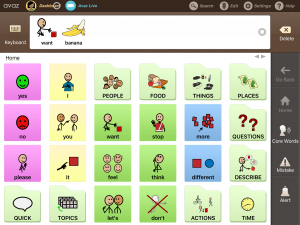 When the child speaks a word through their AAC system, you can try to further build their language skills. For example, if the child types “banana” on the AAC communication device , ask “Do you want a banana?” by modelling the words ‘want’ and ‘banana’. You can also rephrase the child’s message to let the child learn the different ways to convey a message. Be it at home or at school, every communication partner of an AAC user has a major role to play. The more mindful the partners are in their thought and practice, the greater the ease of the children with the AAC devices. Even when you do not fully comprehend a child’s message, assume that the child had said something meaningful, and respond accordingly. This can instil confidence in the child, and encourage them to consistently use AAC for their social interactions.
When the child speaks a word through their AAC system, you can try to further build their language skills. For example, if the child types “banana” on the AAC communication device , ask “Do you want a banana?” by modelling the words ‘want’ and ‘banana’. You can also rephrase the child’s message to let the child learn the different ways to convey a message. Be it at home or at school, every communication partner of an AAC user has a major role to play. The more mindful the partners are in their thought and practice, the greater the ease of the children with the AAC devices. Even when you do not fully comprehend a child’s message, assume that the child had said something meaningful, and respond accordingly. This can instil confidence in the child, and encourage them to consistently use AAC for their social interactions. Rett Syndrome Facts: Causes, Symptoms, and Treatments
What is Rett Syndrome?
Rett Syndrome (RTT) is a rare neurodevelopmental disorder. For infants with Rett syndrome, the development is normal until the age of 6 to 18 months.The infants then go through developmental regression and lose their acquired abilities. Communication difficulties are common in people with RTT. However, with adequate support and intervention using Alternative and Augmentative Communication (AAC), people with Rett Syndrome can manage their symptoms and learn to communicate better.What are the Causes of Rett Syndrome?
The most common cause of RTT is a mutation in the methyl CpG binding protein 2 (MECP2) gene. The MECP2 gene plays a major role in the synthesis of Methylcytosine binding protein 2 (MeCP2). The brain needs MECP2 protein for its development. Moreover, the MECP2 protein also controls gene expression of other genes, regulating their protein production. It is important to keep in mind that all individuals with MECP2 mutation do not necessarily have Rett Syndrome. Scientists are investigating other causes of Rett Syndrome. They have observed mutations in the CDKL5 andFOXG1 genes in people with atypical or congenital Rett syndrome. They are also considering partial gene deletion as a possible cause of RTT. Given that it is a genetic disorder, attempts are being made to identify other genes that may be responsible for RTT.Why does Rett Syndrome mostly affect females?
Rett Syndrome is often misdiagnosed or undiagnosed. So, researchers do not have the exact numbers of those affected. However, according to estimates, Rett Syndrome affects approximately 1 in 10,000 females worldwide. RTT is seen in males, but very rarely. Understanding the Rett Syndrome facts and genetic links will shed light on why the majority of those affected by RTT are females. The MECP2 gene mutation, the primary cause of RTT is found on a person’s X chromosome. Females have two X chromosomes, although only one is active. So, the severity of symptoms in females with Rett syndrome is largely dependent on the percentage of the cells that have an X chromosome with the normal MECP2 gene turned off. Males, on the other hand, have one X and one Y chromosome. So, if their X chromosome has the defective MECP2 gene, they do not have a back-up X chromosome. This means that although RTT is rare in males, symptoms in males may be more severe than in females if it occurs.Is Rett Syndrome hereditary?
Despite being a genetic disorder, Rett Syndrome is not hereditary. In about 99% of the diagnosed RTT cases, scientists have found the mutation to be a random occurrence. The percentage of those with RTT inheriting the mutated gene is less than 1%. There are females in families of individuals with RTT who are asymptomatic carriers. They have the MECP2 gene mutation but do not have clinical symptoms of the disorder.How to Diagnose Rett Syndrome?
The diagnosis of RTT involves close monitoring of developmental milestones. Decreased head growth can be a red flag, although it may be a sign of other disorders too. Taking a blood test can identify the MECP2 gene mutation. However, gene mutation alone is not enough for an RTT diagnosis. Doctors must rule out the presence of Traumatic Brain Injury, Neurometabolic disease, or infections before confirming RTT diagnosis. Here are the Rett Syndrome facts regarding the most common diagnostic criteria- Loss or impairment of fine motor skills
- Loss or decrease of verbal speech
- Gait Abnormalities such as toe-walking
- Repetitive hand movements including wringing, rubbing or clapping
What are the Signs and Symptoms of Rett Syndrome?
Hypotonia or loss of muscle tone is generally the first sign of Rett Syndrome. There is a range of symptoms, the severity of which can vary from person to person. There are four stages of Rett Syndrome and the symptoms present themselves differently in each stage.Stage I
Stage I generally begins between 6 and 18 months of age. A gradual slowing of development is noticed. This stage is called early onset and the following symptoms may be present but not be quite apparent.- Less eye contact
- delays in sitting or crawling.
- Hand-wringing
- Decreasing head growth
Stage II
Stage II typically begins between ages 1 and 4. This stage is called the rapid destructive stage. Common symptoms during this stage are- Repetitive hand movements such as wringing, clapping, or tapping
- Breathing irregularities
- Autistic-like symptoms such as lack of social interaction and communication deficits
- Unsteady walking
- Slowed head growth which is noticeable
Stage III
Stage III typically begins between ages 2 and 10. This stage is called the plateau or pseudo-stationary stage. Most prominent symptoms are- Apraxia
- motor problems
- seizures
- This stage may also see improvement in behavior and communication
Stage IV
Stage IV can last for several years. This stage is called the late motor deterioration stage, Prominent symptoms include- Reduced mobility
- Curvature of the spine
- Muscle weakness, rigidity
- Communication and cognition generally do not decline in stage IV.
- Occupational therapy, speech therapy, and physical therapy
- Management of gastrointestinal issues
- Evaluation of Scoliosis
- Antipsychotic medications
- Resources for Parents
Getting Started with AAC Device at Home
Setting Expectations
Many parents may have unrealistic ideas of how AAC works and the potential timeline of results. As effective as AAC is, it is far from being a magical potion that gives instant results. Therefore, it is important to understand that you need to be patient to see success with AAC.Choose the best AAC App
This is one of the most important steps in AAC implementation. Assess the suitability of the app according to your child’s current language, comprehension, cognitive, and physical abilities. Your child’s SLP can provide valuable inputs to help you choose the right app. Certain apps have advanced features with vocabulary that grows with your child. Easy personalization is also an important aspect to look out for. You don’t want to spend hours trying to customize the app for your child. Avaz AAC app has a remote feature which is particularly helpful because an SLP can guide your child even if they are not physically present with the child.Talk to the Child About How an AAC Device Can Help
Be it getting a dog for the family or buying a new car, parents typically discuss major decisions with children so they are not caught unawares. Similarly, talk to your child about what AAC is. Tell them how AAC can help with social interactions. This will prepare the child for the introduction to the AAC system.Embrace AAC as a Family
All children learn language from hearing people around them talk. The more they listen to words and are encouraged to speak (mistakes and all!), the more likely they are to pick up the vocabulary and other language skills. The same holds true for children with autism and other learning disabilities. Get together as a family and get educated about the AAC system. Your ease with the system and frequency of usage encourages the child to get familiar with AAC. Using AAC as a family helps the child readily express their views and ideas.Get Help from Experts and AAC Users
Having a groundbreaking app is no use if you don't know how to use it. Parent training is important to ensure optimal use of AAC. AAC concepts and strategies may seem foreign to many parents new to AAC. SLPs can offer guidance on how to use an AAC system. Unfortunately, SLPs may not be always available. In some countries, parents may not have access to SLPs. It is to address this issue that Avaz AAC App has a training module integrated into its app. The module incorporates best practices recommended by AAC experts and gives detailed instructions on how to use the app. If you need additional help, reach out to the community. Many AAC parents will be more than glad to be of help. Many AAC app makers are also happy to support you through the learning process.Modelling
Modelling is the best way to get your child to use AAC. While interacting with the child, model core words as often as possible. Core words are high-frequency words that we use in about 85% of our communication. The best AAC device is the one with apps designed to provide easy access to the core words. With consistent modelling, the child will begin to follow your lead and start using the AAC system. Continue to model even after the child gets comfortable with AAC. Adding more words regularly will strengthen the child’s vocabulary.Create Opportunities to Use AAC
Seek out opportunities where you can use AAC. Whether it is discussing breakfast or talking about a picnic plan, there are so many instances throughout the day where you can use AAC. Using AAC in different settings lets the child know that AAC can help communication in many environments. If your child is into music, talk about the current chart-topper. Talk about the latest superhero movie coming up if your child is a comics fan. Talking about the child’s favourite topics is a great way to get your child to use the AAC system.Ensure Consistent Availability of Device
Make sure the AAC device is charged and always available for use. Carry the device wherever you can. That way, the child’s use of AAC is not restricted to home or school. You can give them picture boards or other forms of low-tech AAC when in places like swimming pools where high tech AAC cannot be used. Avaz AAC app has a PDF option where you can print the child’s vocabulary at the tap of a button and use it in such places. If you are thinking of purchasing an AAC app, do not hesitate. AAC is easy to use. And there is enough support available on AAC for you to get started easily and handhold you through the journey. Empower your child by giving them the gift of communication through AAC. Do you have any ideas about getting started with a AAC device at home? Please share your thoughts in the comment section below.5 Things People with Autism Want You to Know

We Want to Communicate, Even If We May Not Be Able to Do It Well
Communication is a basic human need. We like to make our preferences and opinions known. However, we may take longer to process information. Therefore, wait for us to respond. If we use communication apps for autism, be patient - because typing is slower than speaking. Most people with autism have communication challenges. It means that we might have to work harder at what comes naturally and effortlessly to you. Language and speech difficulties are also common among us. Some of us cannot speak while others can speak and write so beautifully. We might also have delays in developing language skills when compared to our peers. We are not adept at understanding non-verbal cues or reading between the lines. Therefore, do not get offended if we have misunderstood you. Show interest in what we have to say because it matters to us. Please, respond to our efforts to communicate and always acknowledge. We are capable of having meaningful conversations even if we use communication apps for autism to express ourselves. So, don't limit the communication to only asking simple questions.We Have Self-Stimulating Behaviours. So, Please Don’t Stare at Us
Everybody engages in Stimming or Self-stimulating behaviours. You may bite your nails or crack your knuckles when you are bored or anxious. But, stimming in people with autism is more obvious. You may see us flapping our hands or rocking back and forth. Please let us continue doing so unless it gets disruptive or dangerous. We may stim to reduce sensory overload or to calm ourselves. Stimming may be our way to cope with unfamiliar situations. We can stim when we get frustrated or to deal with our anxiety. Controlling our stimming behaviours is not only difficult but also can cause more distress. So, please don’t make us feel uncomfortable by expecting us to suppress our physical movements. Or conform to some misplaced social norms.Most of Us Have Sensory Challenges. So, Please Be Considerate
Most of us have sensory challenges. That said, the stimuli we are sensitive to can vary greatly. Some of us get irritated by loud noises, while others might be unperturbed by them. Each person with autism can have unique noises that bother them. So, avoid yelling or playing loud music around us. For some of us, the sensitivity to these noises can get better as we get older. We may be amused by bright lights but might struggle with sudden light flashes. We can also be sensitive to certain smells, tastes, and textures. Younger children with autism can experience sensory overload more often than their peers. Using sensory toys or appropriate vestibular sensory input can help in calming them.We Do Not Lack Empathy. So, Don't Be Judgemental
This is one of the most damning misconceptions about us. We might not express our empathy the way you expect us to. That doesn’t mean we are devoid of emotion. We can have trouble deciphering body language and facial expressions. Consequently, we might not be able to read a situation as well as our peers. If we do not seem compassionate, it may be due to our cognitive challenges and communication deficits. So, please think twice before propagating the idea that we cannot be empathetic. Misinformation about the disorder can substantially affect our social interactions.Don’t Club Us All Together. Each One of Us Has Unique Traits and Challenges
Don’t try to fit us all under one label. It may be convenient for you but it trivializes our individuality. Don’t assume that all of us have the same cognitive, motor, communication, and intellectual capabilities. Some of us are non-verbal and may use communication apps for autism to interact with others. Others can speak so eloquently and seemingly lead normal lives. There are also celebrated poets, actors, singers, musicians, and many other accomplished professionals amongst us. So, recognize that each one of us has a distinct set of abilities and impairments, just like you! If you have any ideas on this topic, please share them in the comment section below !!! We encourage healthy discussions within the community because they open the door to exchange of information and learning.Photo Credit: Nathan Anderson
Cerebral Palsy: Causes, Types and Treatment
What is Cerebral Palsy?
Cerebral Palsy (CP) is a group of neurological disorders that affect movement, balance, and posture of individuals. The term ‘Cerebral’ refers to the brain and ‘Palsy’ refers to impairment of motion. CP is the most common condition causing motor impairments in children. People with Cerebral Palsy can also experience communication challenges along with difficulties in thinking, feeling, and learning.Causes of Cerebral Palsy
Cerebral Palsy is caused due to abnormal development of the brain or damage to parts of the brain. These abnormalities or damage may occur during pregnancy, childbirth, or after birth. In most cases, the children have Congenital CP, which means that the brain damage happened before or during birth. CP caused due to brain damage that happens more than 28 days after birth is called Acquired CP.Congenital CP Risk Factors
The following risk factors are reasons that can increase the chances of CP. Presence of risk factors does not mean that a child will have CP- Low Birth Weight
- Premature Birth
- Multiple Birth Pregnancy
- Assisted Conception Methods
- Infection During Pregnancy
Acquired CP Risk Factors
The risk factors for Acquired CP are- Meningitis or encephalitis during infancy.
- Brain injuries due to motor vehicle crashes or falls,
- Cerebrovascular accidents such as stroke
- Birth defects of the central nervous system
Diagnosis of Cerebral Palsy
Diagnosis of Cerebral Palsy generally happens during the first or second year after birth. But if the child has mild symptoms, the diagnosis can be difficult and doesn't happen until the child is older. Early diagnosis ensures that the child receives the necessary support. Therefore, it is important to be aware of the common signs of CP. Doctors generally track movement goals in a child from birth to five years. These goals include rolling over, sitting up, standing, and walking. Delay in reaching these milestones is an early sign of Cerebral Palsy. It is worth noting that many children without CP also can have some of these signs. So, it is better to consult a medical professional if you have concerns.Types of Cerebral Palsy
The four main types of CP are- Spastic Cerebral Palsy
- Dyskinetic Cerebral Palsy
- Ataxic Cerebral Palsy
- Mixed Cerebral Palsy
Cerebral Palsy Treatment
The common types of treatment for CP are- Physical Therapy
- Speech and Language Therapy.
- Assistive Technology for Cerebral Palsy
- Medication
- Surgery
Overview of the Causes, Treatment, and Signs of Dyslexia
What is Dyslexia?
Dyslexia is a learning difficulty that affects the reading and writing skills of individuals. People with Dyslexia struggle with spelling and fluency in reading. These difficulties, however, are not a reflection of their intellectual capabilities. Dyslexia affects only certain aspects of learning. So, children with dyslexia can perform well in school if they receive adequate and timely support. Although it is mostly noticed in children, many adults also get diagnosed with the condition. Adults with dyslexia can struggle with understanding reports and writing down messages. Lack of evidence-based intervention can lead to emotional issues and low self-esteem in both children and adults. So, it is important to provide a supportive environment for people with dyslexia so that they can lead fulfilling lives.What Causes Dyslexia?
Researchers are not entirely sure of exactly what causes dyslexia in adults and children. However, Dyslexia has been found to run in families. Therefore, studies are exploring the possibility of genetic links to the condition. Reading difficulties experienced with Dyslexia are also said to be linked to differences in how the brain processes the information. A rare type of Dyslexia is Acquired Dyslexia or Trauma Dyslexia where illnesses or brain injury cause learning difficulties.What are the Symptoms and Signs of Dyslexia?
Children and adults with Dyslexia can have a range of symptoms. Even among children, the symptoms can vary according to age. Here are some of the common symptoms of Dyslexia by ageSymptoms of Dyslexia in Preschoolers
- Delayed onset of speech.
- Trouble remembering letters of the alphabet.
- Difficulty identifying letters.
- Difficulty recognizing rhyming phrases.
- Mispronouncing familiar words.
Symptoms of Dyslexia in Children Aged 5 and 6
- Difficulty understanding that words are broken into sounds.
- Trouble understanding the correlation between words and sounds.
- Finding reading laborious.
- Difficulty with pronunciation.
- Trouble with sounding out simple words.
Symptoms of Dyslexia in Children Aged 7 to 12
- Slow reading.
- Difficulty learning new vocabulary.
- Confusing similar sounding words.
- Mispronouncing complicated and unfamiliar words.
- Difficulty comprehending words they read.
- Complaining of words jumping around as they read.
- Trouble remembering and following instructions.
Symptoms of Dyslexia in Young Adults
- Trouble finding the right words during conversations.
- Making frequent spelling and grammatical errors.
- Delay in responding to questions.
- Not doing well on written tests in spite of being intelligent.
- Difficulty remembering and recalling names.
Symptoms of Dyslexia in Adults
- Difficulty with time management and organization.
- Difficulty in reading and writing reports.
- Trouble focussing while reading.
- Hesitation to read out loud in front of others.
- Experiencing visual problems with the colour of paper or fonts.
- Lack of interest in reading.
Dyslexia Therapy and Treatment
Treatment for Dyslexia in children mainly focuses on educational techniques that help them with their learning difficulties. Here are some strategies that help individuals with Dyslexia- Multisensory Instruction methods that teach children to use all of their senses while learning.
- Special educational programs that help the children identify the sounds associated with words.
- Reading aloud to the child to improve fluency and accuracy.
- Using fonts, background colours and paper colours that make reading easier for people with Dyslexia.
- Schools and offices can include accommodations such as audiobooks, additional time to finish tests or text-to-speech technology for people with Dyslexia.
- Using Dyslexia Apps like the MDA Avaz Reader that provide research-based support and hints to enable individuals with Dyslexia to read independently.
 MDA Avaz Reader for Dyslexia[/caption] Some individuals with Dyslexia can have exceptional creativity due to their ability to look at the world differently. Putting more emphasis on their slow reading or spelling errors can make them feel inferior. So, parents, teachers and caregivers must focus on the strengths of children. Access to necessary tools and resources also help people with Dyslexia manage their condition better and become successful in their lives. Do you have any information you want to add about causes and signs of Dyslexia? Please share your ideas in the comment section below.
MDA Avaz Reader for Dyslexia[/caption] Some individuals with Dyslexia can have exceptional creativity due to their ability to look at the world differently. Putting more emphasis on their slow reading or spelling errors can make them feel inferior. So, parents, teachers and caregivers must focus on the strengths of children. Access to necessary tools and resources also help people with Dyslexia manage their condition better and become successful in their lives. Do you have any information you want to add about causes and signs of Dyslexia? Please share your ideas in the comment section below.Thanks for choosing us!
Congrats on your purchase!
Thank you for choosing us. We are excited as you begin your communication & learning journey with us.
You will receive all details regarding subscription and login credentials within 8 hours.
The Avaz brand is synonymous with quality and trust - hence you can be confident that you have made the right choice. All our products have been built based on extensive research to empower our users with better communication and learning.
While you explore our product, our support team will be more than happy to assist with any queries. You can always reach out to us at support@avazapp.com
Happy with your purchase? Please help us by reviewing & rating us on the App Store & Play Store. Spread the word by sharing information with anyone who can benefit from our products!
What is AAC(Augmentative and Alternative Communication)? : A Detailed View
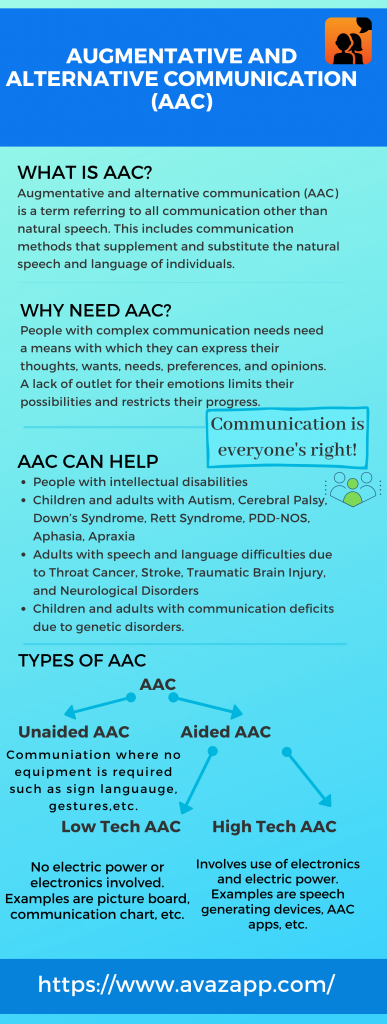 AAC has proven to have positive effects on people with communication deficits. What is AAC? And how can it help people with communication and language difficulties? Read on to find out more: Augmentative and alternative communication (AAC) is a term referring to all communication other than natural speech. This includes communication methods that supplement and substitute the natural speech and language of individuals. For people with communication challenges and comprehension difficulties, AAC devices are a way to express their feelings, opinions, needs, and wants. Communication is complex in nature and involves more than one form of expression. We regularly use gestures, body language, and facial expressions, in addition to written and spoken language, to effectively convey our intent. AAC is one such mode of communication that allows people with language and speech difficulties to make themselves understood.
AAC has proven to have positive effects on people with communication deficits. What is AAC? And how can it help people with communication and language difficulties? Read on to find out more: Augmentative and alternative communication (AAC) is a term referring to all communication other than natural speech. This includes communication methods that supplement and substitute the natural speech and language of individuals. For people with communication challenges and comprehension difficulties, AAC devices are a way to express their feelings, opinions, needs, and wants. Communication is complex in nature and involves more than one form of expression. We regularly use gestures, body language, and facial expressions, in addition to written and spoken language, to effectively convey our intent. AAC is one such mode of communication that allows people with language and speech difficulties to make themselves understood.The Need for AAC
As a society, we take communication for granted. Speech and language problems can affect an individual’s quality of life because they restrict communication. The lack of an outlet for feelings and thoughts can lead to frustration, disillusionment, and behavioural problems. This, in turn, can affect the standard of support they receive from their families and caretakers. Here are some of the ways speech and language impairments affect individuals:- People with speech difficulties are not able to make themselves heard.
- Mingling with friends or attending regular school becomes tough. Their inability to mix with peers leads to poor self-esteem and a life of exclusion and loneliness.
- Their preferences are often taken for granted and intentions are second-guessed. People's expectations of them are generally lower, for no fault of theirs.
- This leads to poor self-esteem and confidence. This further prevents the individual from leading an inclusive, fulfilling life and reaching their potential.
Who can Benefit from AAC?
AAC can help anyone with communication deficits. The communication challenges may be present in early childhood or may have developed later in life due to neurological and other conditions. Such communication problems must be addressed immediately. Delays in intervention can cause anxiety, annoyance, and exasperation in addition to deep-rooted behaviour issues. Many people can benefit from AAC, including (and not restricted to):- Children and adults with speech and intellectual disabilities - non-verbal, partially verbal and single word communicators.
- Children and adults with Autism, Cerebral Palsy, Down’s Syndrome, Rett Syndrome, PDD-NOS, Aphasia, Apraxia or any other condition that affects speech.
- Adults with speech difficulties due to Throat Cancer, Stroke, Traumatic Brain Injury, and Neurological Disorders
- Children with delayed development indicators
- Other genetic disorders that affect speech
How Does AAC help?
The primary function of AAC is to enable the user to be understood. For nonverbal users, it can mean a way to replace speech. For those who are minimally verbal, it is a supplemental method to improve their comprehension. AAC acts as a communication bridge. It connects users to their support system, which includes their families, friends, therapists, and Speech and Language Professionals (SLP). It helps the user foster functional relationships. It also offers them the confidence to be a valuable member of society. The broader societal benefit of enabling children with speech difficulties to "speak for themselves" is a step towards a more inclusive society. This leads to equal educational and economic opportunities for them. The benefits of AAC include:- Gives the ability to communicate
- Reduces anxiety
- Reduces tantrums and behavior issues
- Increases independence
- Boosts self-confidence, self-esteem
- Provides access to education by helping class participation and academic progress
- Improves attention
- Provides access to equal opportunities at education and work
- Empowers the individual and helps achieve one’s goals
- Improves social relationships
- Improves overall Quality of Life by living a life with Dignity and Inclusion
 Sign Language[/caption]
Sign Language[/caption]Types of AAC
No conversation about AAC can be complete without a discussion about the different kinds of AAC. AAC can be broadly categorized into aided and unaided systems- Unaided AAC No equipment is involved in unaided AAC. Communication generally happens through sign language, vocalizations, gestures, body language, and facial expressions. Aided AAC Aided AAC is where the user communicates using external tools. The tools can be further classified into low-tech and high-tech AAC.- [caption id="attachment_3660" align="alignright" width="340"]
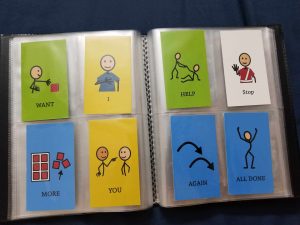 Communication book[/caption] Low Tech AAC The use of simple tools such as a picture board falls under the low-tech category. These tools do not require electric power or electronic components for their functioning. The user’s method of conveying a message through the communication boards or books largely depends on their motor skills and physical abilities.
The user selects appropriate phrases, pictures, letters, words, and symbols listed on the communication boards to construct their message. The user selects using a body part, eye-gaze direction, pointer, or a head/mouth stick. In some cases, the user also communicates by answering Yes or No questions as a caretaker goes through the options on the board. You can download Avaz's low tech communication boards here.
Communication book[/caption] Low Tech AAC The use of simple tools such as a picture board falls under the low-tech category. These tools do not require electric power or electronic components for their functioning. The user’s method of conveying a message through the communication boards or books largely depends on their motor skills and physical abilities.
The user selects appropriate phrases, pictures, letters, words, and symbols listed on the communication boards to construct their message. The user selects using a body part, eye-gaze direction, pointer, or a head/mouth stick. In some cases, the user also communicates by answering Yes or No questions as a caretaker goes through the options on the board. You can download Avaz's low tech communication boards here. - High Tech AAC High Tech AAC comprises of strategies involving the use of electronics and other technologies. This includes computers, speech-generating devices, and tablets. A communication app for iPad or Android with pictures and text is an example of high-tech AAC. [caption id="attachment_2219" align="alignright" width="413"]
 A child with special needs using high tech AAC[/caption]
A child with special needs using high tech AAC[/caption]
Avaz – AAC Awareness Month Discount Extended
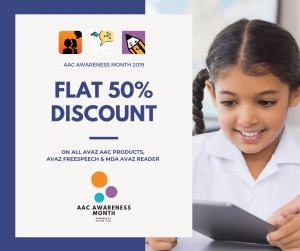 All Avaz products will be available at a FLAT 50% DISCOUNT till October 31, 2019! Yes, you read that right! Communication for all will be a reality this October! Note: This table has been edited to display the full price instead of the discount prices that were valid till October 31, 2019. [ninja_tables id="2354"] The discount is applicable to:
All Avaz products will be available at a FLAT 50% DISCOUNT till October 31, 2019! Yes, you read that right! Communication for all will be a reality this October! Note: This table has been edited to display the full price instead of the discount prices that were valid till October 31, 2019. [ninja_tables id="2354"] The discount is applicable to:- Avaz AAC products
- Avaz FreeSpeech
- MDA Avaz Reader for Dyslexia.
Rethinking the Symptoms of Autism in Girls
Why can Symptoms be Missed in Girls?
There are primarily three reasons why parents and doctors fail to notice symptoms in girls, which are:- Looking for telltale signs of autism by using the same diagnostic criteria as boys. However, the symptoms may present themselves differently in boys and girls.
- Girls are brought up to be better at masking their difficulties. They can go about their lives showing little indication of their struggles in socializing.
What are the Possible Symptoms of Autism in Girls?
There is no definitive list of symptoms that can qualify for an autism diagnosis. Some girls can exhibit typical symptoms, but with less severity. If the symptoms do not substantially affect the quality of a girl’s life, chances are that she might not have autism. It is therefore wise to carefully consider all aspects of development before making an assumption. It is always better to get an expert evaluation if you have concerns.Some of the obvious symptoms girls can exhibit include:
- Substantial speech and language difficulties.
- Self-stimulating behaviours such as hand flapping, repetitive behaviours, spinning, rocking etc.
- Lack of adequate social communication skills.
- Severe cognitive challenges.
- Obsession over a particular subject and interests limited to a few topics.
- Atypical sensory responses to stimuli such as loud noises, bright lights, and certain textures. Keep in mind that sensory challenges can also be a sign of other disorders.
- Unusual passivity. Girls with autism can refrain from expressing their opinions because they are uncertain about the right thing to say. While passivity may be one of the symptoms of autism, it must be noted that there are people with autism who are quite assertive.
- Being withdrawn and unusually quiet. Many girls can be inherently shy because it is a part of their personality. Therefore, it is important to consider the extent of the child’s shyness and how much it impacts her social life.
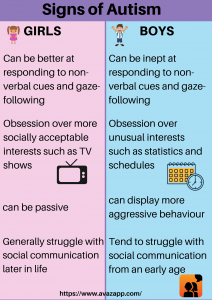 How can the Signs of Autism Differ in Boys and Girls?
How can the Signs of Autism Differ in Boys and Girls?
Researchers have found that while many symptoms are common between both genders, the key difference may lie in how they manifest in boys and girls. There are also certain fundamental differences in how girls carry their impairments that make them difficult to detect. Some of these are:- Girls can be better at responding to non-verbal cues and gaze following.
- Girls can be capable of focussing more and are less likely to be distracted
- Boys can struggle with social communication from a very early age. Girls, on the other hand, tend to be more adept at dealing with social challenges during childhood. They might find it tougher to tackle social obstacles as they enter their teens.
- Both girls and boys with autism can have obsessive tendencies. The extent of the repetitive and restricted behaviours may be lower in female children than their male counterparts. That said, the topics of interest in the case of girls may not stand out as much as they do among boys.
- Girls tend to display less aggressive behaviour than boys. In fact, girls with autism can be very passive. However, since society considers passivity an acceptable trait for girls, such symptoms might go unnoticed.
Why is it Important to Diagnose Early?
According to clinical neuropsychologist to Dr. Susan F. Epstein, girls with autism can suffer from poor self-esteem, depression and can become vulnerable to bullying because they may feel like they feel different than their peers. Read more about how early diagnosis can help and about therapies for autism in this article by Autism Parenting Magazine. Early diagnosis helps girls learn the skills and coping mechanisms required to lead a fulfilling life. It also gives them the emotional support and understanding necessary from family members and friends. Getting diagnosed as a teen or adult can put them at a disadvantage because they may have to make up for the lost time. However, it may be heartening to know that several young women diagnosed later in their lives have been able to successfully deal with their social challenges by consulting experts and undergoing recommended therapies. Do you have any ideas to share about symptoms of autism in girls? Please express your views in the comment section below. We would love to hear from you!!Source: https://www.verywellhealth.com/differences-between-boys-and-girls-with-autism-260307
AAC Awareness Month Discount Extended
 All Avaz products will be available at a FLAT 50% DISCOUNT till October 31, 2019! Yes, you read that right! Communication for all will be a reality this October! [ninja_tables id="2354"] The discount is applicable to:
All Avaz products will be available at a FLAT 50% DISCOUNT till October 31, 2019! Yes, you read that right! Communication for all will be a reality this October! [ninja_tables id="2354"] The discount is applicable to:- Avaz AAC products
- Avaz FreeSpeech
- MDA Avaz Reader for Dyslexia.
Supporting Special Needs Children During a School Crisis
Child Assessment
Teachers must make sure that they assess each student to formulate a plan that serves their individual needs. A chart can be prepared for each student, listing attributes that can help or hinder their safety. This will help in coming up with a plan that best suits the student’s abilities. For children who use AAC apps for communication, the safety plan can be explained through the app they use. Teachers can customize the app to familiarize children with safety routines. This will ensure they know what to do during an emergency. The school can distribute copies of the finalised individual plan to teachers, parents, and counsellors to keep them informed of the safety procedure to be followed. It is also important to update the plan constantly to keep up with the changing requirements of children with special needs.Awareness of Parents
Most parents assume that their school district has a strategy outlined to help children with disabilities during a school crisis. However, in the absence of a well-defined nationwide plan, teachers are often left to their own devices. Parents need to talk to the schools about the drill schedules and lockdown procedures. Discussing the child’s individual needs and how they can be addressed is crucial. Once a plan has been devised, parents can talk to their children about the routines they need to follow. Reminding the kids often will enable them to follow instructions and get themselves to safety.Navigating the Physical Environment
The school should identify shelters or hiding spots which are conducive for children with disabilities. These shelters should be able to accommodate any assistive technology or device they use, including wheelchairs and crutches. Teachers can encourage children to get to the hiding spots during practice drills by rewarding them with stickers or toys. This will ensure the compliance of the children during a crisis. In case of natural disasters, or danger from within the building, blocked hallways can pose a problem. Therefore, it is important to be aware of alternate routes to safety. Teachers and other staff must also train themselves to move furniture out of the way as these could block the path(s) to assigned shelters.Building an Emergency Kit for Special Needs Children
Children with special needs may experience a sensory overload due to loud noise from fire alarms and shouting during lockdowns or evacuation. Having an individual emergency kit for each student helps in such cases and should be a compulsory part of the safety plan. Here are some suggestions for what such a kit for children with special needs could containMedication
The emergency tool bag must contain nebulizers or masks for children with respiratory illnesses, medicines for children with diabetes, and medication for children prone to allergies and epilepsy.
Stress Busters
The emergency kit must include a toy or a book that can comfort the child and keep them engaged during the lockdown. Music players with headphones can reduce anxiety in children with special needs. For kids with sensory needs, including sensory toys such as chewelry (chewable medical grade jewellery) and stress balls can help them control their vocalizations.Communication and AAC Apps
For kids who use iPads or other AAC devices for communication, having such devices in the bag can help them communicate to first responders if needed.
Food and Activities
Packing the favourite snacks and treats of the children along with colouring books and crayons can keep them occupied and calm during the lockdown.
Strategies for Implementing AAC in the Classroom
Kids spend a sizeable number of their waking hours at school. It is likely that they will have many more opportunities for social interactions at school than at home. So, employing efficient augmentative and alternative communication strategies can help a great deal in improving their communication skills and social development.
Introducing AAC in classrooms requires a lot of coordination because there are so many moving parts to the process. With some forethought, measures can be taken to include strategies for implementing AAC in the classroom.Team Work, Planning & Coordination
It takes diligent planning to introduce AAC systems in school. Making sure that all the members of the team are on the same page, goes a long way in effective implementation. Discussing the curriculum and proposed schedules can ensure that the efforts of the team are not diluted by miscommunication. Having a definitive organizational policy gives clarity on the mode of implementation and the rules if any. Setting up in-house systems for troubleshooting and technical support would be helpful for team members. Do reach out to the support team of whichever AAC system you are using to get the most out of it. Avaz AAC app, for instance, has a dedicated 24x7 support team that can enable your team to make the AAC implementation a success!Teacher Education
Most teachers are willing to try new technologies and systems if they are convinced about that system’s effectiveness. However, enthusiasm alone will not equip them with the necessary knowledge to teach using AAC apps. It is important that teachers are adequately trained in the chosen system and the strategies for implementing AAC in the classroom. In a classroom setting, children look up to their teachers for guidance. And modelling is a key aspect of AAC learning. Hence, the teacher’s comfort with the device can greatly influence the confidence and usage patterns of the students. Familiarity with the device or AAC app can also help the teacher come up with creative ways to use the system. Since each child has his/her unique set of preferences and abilities, the teacher can play around with the features of the AAC system to best suit the needs of the child.
Preparing the Child
There may be children in the classroom with prior exposure to AAC devices at home or at therapy. Such children may require minimal instruction. On the other hand, students new to AAC apps might need more preparation before they are introduced to the system. Teachers need to talk to the students about why they will be using AAC at school and how it can help them. Since some kids may be less receptive to new ideas than others, the reassurance of the teacher can be vital in how quickly a child takes to the AAC app and system.Talking to Parents
Having a chat with parents about AAC use in classrooms is essential because families need to be on board with the idea. Efforts must be made to educate parents about AAC apps. If there are any apprehensions, those should be addressed at the very outset. Talking with parents can also shed light on their aspirations regarding their child’s development. Teachers and SLPs must ensure that families have realistic expectations. This helps to avoid discouragement if they don’t see immediate results. It is essential that families are also trained in using an AAC app with symbols and text, helping them to actively participate in the child’s communication intervention. This will effectively supplement the therapist’s efforts at home and enable the child to get the most out of the communication system.Assessing Potential Barriers and Solutions
The foremost goal of AAC is that the children reach for the device every time they have anything to communicate. So, it is important to ensure easy access to the device at all times. The child should be encouraged to seek the device when they need to communicate. Fortunately, the barriers impeding the use of AAC apps in a classroom or even at home can be dealt with easily if you have a solid plan in place. For instance, if a child has trouble bringing the device to school due to physical limitations, providing a case with a strap can help in carrying the device without difficulty.Making it Fun is One of the Vital Strategies for Implementing AAC in the Classroom
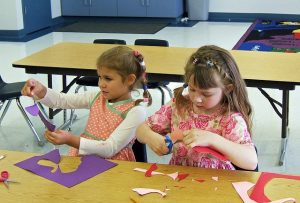 A fool-proof strategy for AAC implementation is of no use if the child is completely disinterested! Given the limited attention spans, you need to be at the top of your game to stimulate their curiosity. Devise fun augmentative and alternative communication strategies such that the child cannot wait to use the device! Plan exciting games and activities to include the AAC system even in their leisure time. For kids inclined towards art, music, or sports, using AAC apps as part of the activities they love and enjoy can serve as a great motivator. Endowing children with the ability to freely communicate early in life can enable them to overcome their inhibitions. It also opens up possibilities of interaction with others, outside of the home and classroom. Some children may be inspired by seeing their peers using communication devices. Use of AAC apps and systems in classrooms can thus enhance the independence and boost the self-esteem of children. Do you have any other suggestions or strategies for implementing AAC in the classroom? Please share your ideas in the comment section below.
A fool-proof strategy for AAC implementation is of no use if the child is completely disinterested! Given the limited attention spans, you need to be at the top of your game to stimulate their curiosity. Devise fun augmentative and alternative communication strategies such that the child cannot wait to use the device! Plan exciting games and activities to include the AAC system even in their leisure time. For kids inclined towards art, music, or sports, using AAC apps as part of the activities they love and enjoy can serve as a great motivator. Endowing children with the ability to freely communicate early in life can enable them to overcome their inhibitions. It also opens up possibilities of interaction with others, outside of the home and classroom. Some children may be inspired by seeing their peers using communication devices. Use of AAC apps and systems in classrooms can thus enhance the independence and boost the self-esteem of children. Do you have any other suggestions or strategies for implementing AAC in the classroom? Please share your ideas in the comment section below.Here’s what you need to know when interacting with an AAC user
1. Communication requires effort, be patient while listening
Typing is slower than speaking. While a person speaks an average of 140-170 words a minute, the average person types a mere 38-40 words. Some AAC users experience mobility issues that hinder typing. Some users could take time to respond. Communication takes effort. Hence being patient and giving ample time to respond and listen is crucial in enabling them to feel understood, included and heard.2. Communicate with the person, not the system
During interactions, make eye-contact with the AAC user instead of watching their system when the message is played. It takes time for the user to communicate their message by forming it first on the system and then activating speech. Hence AAC users use facial expressions and gestures after typing and while the final message is being played. Watching the user’s gestures and other non-verbal cues helps in understanding the conversation better and prevent misunderstandings.3. Help manage noise
AAC users might find it difficult to communicate in a noisy environment such as a busy street, loud classroom, crowded cafe etc. Unlike human voices which can modify volume, pitch and tone for each word in a sentence; volume on an AAC system can’t fluctuate easily and might get drowned in the noise. Some users such as those on the autism spectrum, might be sensitive to loud noises. In such instances, one can aid communication by planning ahead and managing noise levels by shifting to a quieter setting. Switching to an electronic platform such as email or text messages can also be considered.4. Take care not to dominate the conversation
A conversation is meant to be an exchange with both parties contributing. However, it can become easy to dominate the conversation as a non-user of AAC. Be patient as the user responds. Refrain from guessing words and interrupting mid-way to finish their lines. It is frustrating to be cut off mid-way when speaking and wrong guesses may make one feel misunderstood. Users on the autism spectrum may take time to respond, so avoid changing the topic without ensuring that they’ve finished conveying what they wanted. Lastly, when you don’t understand or get lost in the conversation, ask and clarify before moving ahead.5. Don’t presume incompetence
An AAC user on the autism spectrum may take longer to process speech or may experience other challenges, but they can be more perceptive in other ways. Often users can understand what’s spoken but may have trouble expressing themselves. Engage in a sensitive manner and treat users age-appropriately by using an atypical tone of voice and not limiting conversations. Don’t assume incompetence and speak directly to the user instead of approaching their support person. Remember to ask before giving your assistance and let them tell you what may be useful.6. Ask before touching their AAC system and respect screen-privacy
An AAC system is extremely personal to its user. Not only does it serve as a window to their communication with the rest of the world, but also is a window for the rest of the world to access their lives. It is their digital voice and contains private data such as message histories, personalized vocabulary, customized settings etcetera. Hence permission must be sought before touching or handling the user’s system. The screen privacy of the user must be respected by not looking at their screen without consent. AAC users arrange their thoughts and construct messages on their system. They don’t get to view our thought process before we communicate and neither should we. -------- Is there anything else that should be kept in mind while communicating with an AAC user? Do share your thoughts and experiences in this regard in the comments below. We look forward to hearing from you!Peer-Mediated Intervention to Increase Social Interaction
What is Peer-Mediated Intervention? Peer-mediated intervention (PMI) is an approach where peers of children needing communication and interaction interventions are trained to provide the required support and handholding. This includes tutoring in educational, behavioral and/or social interactions. They are also trained to mediate and closely observe during mediation. The peer tutors are typically the same age as the children requiring support.
 One such intervention involving peer tutors is Stay, Play, Talk. It is designed to increase the social interactions of preschool children. Typically developing peer tutors are taught three key skills:
One such intervention involving peer tutors is Stay, Play, Talk. It is designed to increase the social interactions of preschool children. Typically developing peer tutors are taught three key skills:- Stay near their partner
- Engage with the partner
- Talk with the partner by commenting on the activities and respond to their partner’s communicative efforts.
How to implement Stay, Play, Talk? As a thumb rule, ensure to select peer tutors who exhibit age-appropriate play and social skills. They should also have high levels of compliance with teacher directions. When grouping your target child with a peer tutor, consider the children’s social history and shared interests. Shared interests are a positive indicator that more interaction might occur. Peer training may require 1-2 instructors and will require multiple sessions. You might want to conduct the sessions with the target child to allow the peer tutors to practice with the child they will be working with. Teachers can use visuals associated with corresponding skills during peer training that can be referred to during sessions to remind the peer tutors what to do.
- Introduce each skill one at a time.
- Associate each skill with a simple visual you can refer back to when implementing.
- Model each skill for children and allow them to practice.
- Provide positive and constructive feedback for the children.
- Allow peer tutors and target children to practice each skill with their partners.
While this has been suggested in a classroom setting, it can also be tried at homes where siblings are of similar ages. So if you are a parent looking for techniques to have siblings help out, this might be one that you can look to tweaking and trialing. Do you have any other method that you have already tried in your classroom? Let us know in the comments section below! We are always on the lookout for more useful methods that enables our community :) REFERENCE: http://ebip.vkcsites.org/stay-play-talk-procedures/
5 Creative Ways of Using an AAC Device
 In the long run, an AAC device serves as the voice of a child while also enabling them to learn new skills that are beneficial in the long run. So, what are some strategies to creatively use AAC devices and apps? Here are some fun-filled ways to encourage learning and improve the use of the device.
In the long run, an AAC device serves as the voice of a child while also enabling them to learn new skills that are beneficial in the long run. So, what are some strategies to creatively use AAC devices and apps? Here are some fun-filled ways to encourage learning and improve the use of the device.Create a Photo Album
A fun way to kick-start your AAC journey would be to create a photo album that contains photos of all your family members with their names. You can also include a family tree to explain to your child about how they are related to each person. You can also use this opportunity to share some stories about the family while talking about each person, their interests and so on.Favorite TV Shows
Create a list of cartoons, TV shows and web series that your child likes. You can also add their favorite characters. Use these lists as part of daily conversations and as conversation starters. Extend the conversation by adding the theme song/music or record the voice of the character’s unique catchphrase from each show. This will pique their interest in further conversation. You could also talk about why your child likes that particular character and ask them how they feel when they watch the show.Favorite Food Items
Nothing makes a person happier than a delicious meal, doesn’t it? :) Come up with a list of your child’s favorite food items and deliberately add one or two items they don’t like. You can start the conversation by choosing one item on the list and talk about how you can prepare the meal together. Add the ingredients, the taste and what your child likes or dislikes about it and so on.Read a Book Together
For this activity, you might have to do some prework. Pick any storybook. Add a series of images related to the story in the book and arrange them in sequential order. Once you are done with the prework, sit with your child’s favorite storybook and read it out loud. As each character is introduced, show your child the list of images that were already loaded on the device. Ask them to choose the appropriate image that matches the character. Continue to build on the story in this fashion. As you build the story, you can also include words preloaded on the AAC system to teach core words and more.Discuss Routines
Expecting the expected is something most children on the spectrum enjoy. Create a list of daily routines and talk about each activity – the timeline, things required for each activity and so on. For instance, you can set up a timeline of 15 minutes for brushing and include images of toothpaste, brush, water, and other relevant items. This is also an effective way to include a new habit in your child’s routine. Such a technique of practice will enable them to learn the process quickly.Community learning and idea exchange is the best kind of learning and we are always looking forward to learning from you! You may already be using some creative strategies of your own with great success. Or you may use these ideas as a springboard for some incredibly creative ideas of your own. We’d love to hear about the different ways of using an AAC device and app in a more engaging manner. Share these in the comments below so that our readers from across the world may benefit from the same! Sharing is caring! Do share this blog post with those who might benefit from these ideas!
Avaz’s Top 3 – Google Accessibility Updates 2019
Project Euphonia Most aspects of our lives involve communicating with others and in turn, being understood by others as well. This ends up being taken for granted by most of us. Indeed this is something that could be extremely challenging for those with speech disabilities arising from various conditions. To support those with speech disabilities, Google is working on a fix that can train computers and mobile phones to understand them better. This project is being developed in partnership with the ALS Therapy Development Institute and the ALS Residence Initiative. One of the things being done for this is the recording of voices of people who have ALS and combining it with AI. The AI algorithms that are currently under development work only for English speakers and for challenges typically associated with ALS. However, Google hopes the research can be applied to larger groups of people with different speech impairments in the near future.
 Live Transcribe Live Transcribe is easily one of the best features Google is developing. This feature will enable people who are deaf to follow what is being said when someone is speaking, in real time. The app will transcribe everything it hears so that anyone hard of hearing can follow the conversation and reply. Live Transcribe will be made available in beta version soon, first on Pixel 3 and then on other devices. Live Relay Live Relay enables people who are deaf or hard of hearing to make and receive phone calls. This feature uses on-device speech recognition and text-to-speech conversion. Further, it allows the phone to listen and speak on the user’s behalf while they type. As the responses are instant and use predictive writing suggestions, the typing is fast enough to hold asynchronous phone call. It can also be used by people who may be in a meeting or can’t take a call, but are able to type instead. To read up about these updates and the others in greater detail, you can visit here. 2019 promises to be an exciting year for Google. The accessibility updates have given us a lot to innovate and build on.
Live Transcribe Live Transcribe is easily one of the best features Google is developing. This feature will enable people who are deaf to follow what is being said when someone is speaking, in real time. The app will transcribe everything it hears so that anyone hard of hearing can follow the conversation and reply. Live Transcribe will be made available in beta version soon, first on Pixel 3 and then on other devices. Live Relay Live Relay enables people who are deaf or hard of hearing to make and receive phone calls. This feature uses on-device speech recognition and text-to-speech conversion. Further, it allows the phone to listen and speak on the user’s behalf while they type. As the responses are instant and use predictive writing suggestions, the typing is fast enough to hold asynchronous phone call. It can also be used by people who may be in a meeting or can’t take a call, but are able to type instead. To read up about these updates and the others in greater detail, you can visit here. 2019 promises to be an exciting year for Google. The accessibility updates have given us a lot to innovate and build on.What do you think of some of these updates and what do you think of the possibilities these bring? Any particular update that caught your eye? We would love to hear from you on support@avazapp.com or in the comments below! Let us work together in Making Every Voice Heard! Picture Credits – Google
Vocabulary that Grows with Your Children
Understanding Moms – A Glance into their World
 That said, a mother’s job is tough. Involving many a sacrifice and tireless work. And many a time, thankless. A more fitting honor for her would be to create support systems that make her job easier every day. To find out more about the kind of support a mother wishes she has, we interviewed Priya. Our regular readers might recognize Priya, an active advocate of autism and a qualified Special Educator. She is the mother of Pranav, a 14-year-old musician who is on the autism spectrum. If u have anything to share, Drop a comment or write to us at support@avazapp.com
That said, a mother’s job is tough. Involving many a sacrifice and tireless work. And many a time, thankless. A more fitting honor for her would be to create support systems that make her job easier every day. To find out more about the kind of support a mother wishes she has, we interviewed Priya. Our regular readers might recognize Priya, an active advocate of autism and a qualified Special Educator. She is the mother of Pranav, a 14-year-old musician who is on the autism spectrum. If u have anything to share, Drop a comment or write to us at support@avazapp.comUsing Games to Make Learning with AAC More Fun!
 Indeed, the initial phases of AAC usage (or any new skill for that matter) can be a bit challenging. In such situations, we have found that many parents and caregivers have used games with great success. Games have been used to pique children’s interest in learning to use AAC. Many caregivers have also found that games aid language development in a much more efficient way.
Indeed, the initial phases of AAC usage (or any new skill for that matter) can be a bit challenging. In such situations, we have found that many parents and caregivers have used games with great success. Games have been used to pique children’s interest in learning to use AAC. Many caregivers have also found that games aid language development in a much more efficient way. 5 Simple and Powerful Ways to Show You Care
Stepping Towards an Inclusive Society
An inclusive society is about the dignity and worth of every person. This is the backbone of ALL human rights. Though there have been some improvements in our society over the last few years, disabled people and their families still confront isolation and exclusion. They continue to be pushed to the fringes of society.
To overcome this incongruous situation, we as a society need to change our attitude, begin a shift in perspective even. An inclusive attitude and behavior enable us to overthrow prejudices and raze down barriers that we have created overages.
Inclusive Society – What is it?
A socially inclusive environment is a place where everyone is welcomed. It is one where one feels comfortable enough to realize their identity and express their feelings. Social inclusion assures that one’s opinions are honored, just like anyone else’s.
Why is an Inclusive Society important?
Social inclusion plays a crucial role in determining the health of a person. Without inclusion, people are more prone to poor mental health, loneliness, isolation, and poor self-esteem.
Social inclusion enables a more positive and healthier human experience.
Social inclusion enables people:
- To feel a sense of belonging.
- To feel worthy of their roles in the community.
- To be an active participant of the community.
- To have peers/companions and not feel being left out.
- To build social relationships.
Some crucial ways to nurture a more inclusive society:
Here are some of the ways through which greater inclusivity can be brought about. If each one of us can stay aware of these steps and keep pushing for them wherever we are, an inclusive world would no longer remain just a dream.
Employment Opportunities for People with Disabilities
Providing equal opportunities for people with disabilities would enable in creating a more inclusive society. However, the disability community is still discriminated against at work from being refused a job or denied a final interview. This can be overcome by training the staff and creating awareness among the employers to view the person as an asset and not a liability.
Increase Disability Representation in Political Setting
People with disabilities encounter architectural, attitudinal and technological barriers when exercising their right to vote, including, no automatic door openers, narrow doorways, and inaccessible voting machines to name a few.
We need to encourage our younger generations with disabilities to become politically involved. Political parties need to encourage persons with disabilities in their cadre and eventually give them platforms to contest in elections. All this would help to create a more inclusive political setting.
Integrate Disability History in School Curriculums
Disability history needs to be integrated within the school system so that the disability community will be fully acknowledged. With the inclusion of disability history, the community can be embraced by everyone and it enables mutual respect and empathy towards each other.
Promote Social Inclusion in Schools
As a society, we have the responsibility to promote the inclusion of our differences and it should be instilled in young minds. We should celebrate our peers for their differences and it should be taught at a young age. This will result in less discrimination and more social inclusion.
Provide College Scholarships to Athletes with Disabilities
Athletes with disabilities should be scouted and receive scholarships based on their athletic abilities. People should be acknowledged for their abilities rather than their disabilities and should be encouraged to participate in more events.
Realize that People with Disabilities are Humans
The most essential change that is needed in society is to see a person with a disability as a person and realize that their disability does not define who they are and it is only a part of their life.
People with disabilities have desires, skills, talents, heartache, and emotions, just like everyone else. This should be the basis of every person’s understanding and interaction with people with disabilities. That we all share these similarities which include people with disabilities as well.
Creating an inclusive society may not happen in a year or a decade, but it is not impossible to attain. Taking the first step and moving towards creating an inclusive society will bear fruits for the coming generations. With proper training, awareness, and acceptance, an inclusive society is certainly achievable.
Do share your thoughts on this subject with us, in the comments section below. We look forward to hearing from you :)
Teaching Children Self-Advocacy
Quite often, young people with disabilities need additional support with things that peers their age can do by themselves. This love and support that they receive should be given in a way that empowers them to be as independent as possible. It should be the kind that reaffirms their individuality, personal dignity, and agency. And this is where the idea of self-advocacy comes in.
What is Self-advocacy?
Self-advocacy is to feel empowered to make and express one’s life decisions and choices. It also refers to an individual’s ability to effectively communicate, convey their interests, desires, needs, and rights. Self-advocacy involves making informed decisions and taking responsibility for those decisions.
The goal of self-advocacy is for the individual to decide what they want and then developing and carrying out a plan to get it. It also means that they can seek and get help whenever they need or want it.
Why is Self-advocacy important?
Self-advocacy skills enable children to have more control over their lives and make decisions that they desire. It empowers a child to speak up for themselves and make sure they have a choice in whatever decision they want to make. Also, research has found that there is a clear link between teaching children self-advocacy skills and their ability to be happy, well-functioning adults.
Self-advocacy plays a crucial role in the development of a child, so as caregivers it is our responsibility to enable children to self-advocate!
So, how can you help children to learn to Self-advocate?
The primary step towards encouraging self-advocacy skills would be to include the child in their Individualized Educational Plan (IEP) process.
All students must be included in the IEP process to the best of their ability. Using simple language or pictures to help them understand their strengths and areas of need goes a long way in enabling them to be an active participant in the process.
It is never too early to include children in the meetings, even if it is just for a few minutes. Have the team members speak to or discuss with the student rather than the student.
Give children the freedom to make choices
From an early age, present your child with choices. For instance, when it is time for breakfast, you can ask them what would they like to have and give them options like oatmeal or toast. This enables them to be the decision-maker and enables them to be in control of their decisions.
Let children know that they have the right to say NO. This enables them to deny the requests that are unreasonable to them.
Teach Self-advocacy skills
It is essential for a child to know about their disability and how and when to disclose their needs to others. As a caregiver, ensure that you teach them all about their condition and how to disclose them when the need arises.
It is also imperative that they are encouraged to be part of groups and communities of neurodiverse youth. Such communities give them a chance to be themselves and exchange experiences. Being a part of such a community also helps to create a strong support system in addition to creating opportunities for healing and growth in the midst of peers.
Make use of a checklist to determine what skills a child already has and the skills they need to learn. This can help them to focus on a particular skill and develop it.
Encourage children to do activities that they can do on their own as independently as possible. This will also boost their self-confidence and enable them to be more participative in learning the activity.
It is never too late to start teaching your children about self-advocacy. Self-advocacy can enable your child to have the highest quality of life possible, even when you are not present to advocate on their behalf. One important point to be mindful about is that teaching self-advocacy takes time and the support of the community but it is achievable with constant practice and hard work.
How do you think self-advocacy can be taught? What are some of the ways in which you have promoted self-advocacy skills? We would love to hear your thoughts, ideas, and stories in the comments below.
Understanding Neurodiversity as part of Autism Acceptance
Neurodiversity, as seen by its etymology of “neuro” meaning “brain”, and diversity, describes the neurological diversity present within humanity. Judy Singer, an autistic sociologist, coined the term in 1988 as a way to describe the hidden category of people who may see, feel, touch, hear, smell, and sort information in ways different than the typical expectation. Unlike many words and diagnoses used to define neurodivergent people, neurodiversity is inclusive and neutral. In its simplicity, it welcomes everyone as a whole, unbroken reflections of natural human variation.
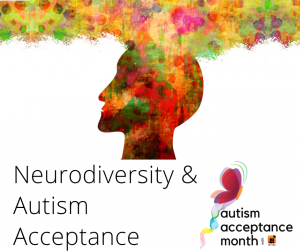 I want to be clear that recognizing neurodiversity is not meant to minimize the very real challenges that neurodivergent people face due to their neurodivergence. Neurodivergent people can experience challenges in regard to friendships, academia, employment, living skills and other areas. I could write an article about the history of discrimination, misunderstandings, lack of proper support, and possible accommodations for each of these areas, but that is for another time. Neurodiversity, however, acknowledges that some of these problems are not inherent to the neurodivergence itself, but often rather a reflection on society’s unwillingness to accommodate for such differences. Neurodivergent people think, learn, process, and /or interpret differently than neurotypical people, and sometimes need extra support doing so. People looking to support neurodivergent people should first check whether that person is looking for assistance in that area. Like other people with disabilities, neurodivergent people might have different goals and possibly different ways in which they aim to achieve those goals. It is important to focus on supporting the person rather than fixing them. Supporting looks like doing things for or with the person on their terms, to make life easier for them. Fixing, on the other hand, looks like modifying behavior or teaching skills that would make life easier for others or the rest of society, without consideration from the neurodivergent person. Regardless of the support a person needs, they are a human being as worthy of autonomy as anyone else. Recognizing neurodiversity means recognizing everyone’s personhood and seeking to support them in their endeavors rather than trying to fix their neurodivergence. When neurodiversity is recognized in a space, neurodivergent people have the opportunity to be themselves. People who identify as neurodivergent often have similar experiences with not fitting in, interesting quirks, discrimination, and communication styles that transcend individual labels of autism, ADHD, learning disabilities and other related conditions. Within the neurodivergent umbrella, people bond over growing up feeling “different” than peers, making sense of confusing interactions with neurotypical people, or helping each other problem-solve and self-accommodate. The neurodivergent community is rich with ideas, history, collaboration, and creativity. In 1999, Singer wrote, “the ‘Neurologically Different’ represent a new addition to the familiar political categories of class/gender/race and will augment the insights of the social model of disability.” Just as we ought to recognize and appreciate the diversity of people’s experiences with genders, races, and class, we too must recognize and appreciate neurodiversity as a political category in its own regard. If the first step towards autism inclusion is acceptance, then the second step is recognizing and celebrating the neurodiversity of the world.
I want to be clear that recognizing neurodiversity is not meant to minimize the very real challenges that neurodivergent people face due to their neurodivergence. Neurodivergent people can experience challenges in regard to friendships, academia, employment, living skills and other areas. I could write an article about the history of discrimination, misunderstandings, lack of proper support, and possible accommodations for each of these areas, but that is for another time. Neurodiversity, however, acknowledges that some of these problems are not inherent to the neurodivergence itself, but often rather a reflection on society’s unwillingness to accommodate for such differences. Neurodivergent people think, learn, process, and /or interpret differently than neurotypical people, and sometimes need extra support doing so. People looking to support neurodivergent people should first check whether that person is looking for assistance in that area. Like other people with disabilities, neurodivergent people might have different goals and possibly different ways in which they aim to achieve those goals. It is important to focus on supporting the person rather than fixing them. Supporting looks like doing things for or with the person on their terms, to make life easier for them. Fixing, on the other hand, looks like modifying behavior or teaching skills that would make life easier for others or the rest of society, without consideration from the neurodivergent person. Regardless of the support a person needs, they are a human being as worthy of autonomy as anyone else. Recognizing neurodiversity means recognizing everyone’s personhood and seeking to support them in their endeavors rather than trying to fix their neurodivergence. When neurodiversity is recognized in a space, neurodivergent people have the opportunity to be themselves. People who identify as neurodivergent often have similar experiences with not fitting in, interesting quirks, discrimination, and communication styles that transcend individual labels of autism, ADHD, learning disabilities and other related conditions. Within the neurodivergent umbrella, people bond over growing up feeling “different” than peers, making sense of confusing interactions with neurotypical people, or helping each other problem-solve and self-accommodate. The neurodivergent community is rich with ideas, history, collaboration, and creativity. In 1999, Singer wrote, “the ‘Neurologically Different’ represent a new addition to the familiar political categories of class/gender/race and will augment the insights of the social model of disability.” Just as we ought to recognize and appreciate the diversity of people’s experiences with genders, races, and class, we too must recognize and appreciate neurodiversity as a political category in its own regard. If the first step towards autism inclusion is acceptance, then the second step is recognizing and celebrating the neurodiversity of the world.Julian Laferrera is a senior at Mount Holyoke College where they are studying mathematics education and philosophy. As a Peer Fellow with the college’s AccessAbility Office, they mentor and support other disabled students. Julian is deeply involved in the Autistic community. Having spent the last eight years learning ASL, including a semester away at Gallaudet University for the Deaf, they plan on getting a Masters in Deaf Education soon.
A Mother’s Dream for her Son’s Independence
The Beginning of our Journey
Initially, we were overwhelmed by the range of therapies and interventions, especially since not many of them seemed to be scientifically proven. As my search for more proven and sophisticated approaches continued, I came across a diploma course in Special Education with a focus on Autism Spectrum Disorders (ASD) from a reputed school. I immediately enrolled in the course. This gave me a better understanding of ASD. Learning about the various conditions, characteristics, behaviors and proven teaching methodologies for children on the spectrum helped me better formulate ways in which I could support my son. As Pranav grew older, so did my desire to empower my son. I continued to educate myself. I used to read a lot of books – from autobiographies of high functioning autistics to parent experiences, research articles, blogs, and other related writings. My thirst for knowledge and my will to empower my son led me to attend a lot of conferences. I interacted with senior professionals and experts in the field and gained many valuable insights.My Goals
When Pranav was about 9-years old, I formulated two primary goals for us. One for Pranav and one for myself.- For Pranav, the goal was to make him independent, functionally and financially.
- For me, it was to support Pranav as he worked to develop his personality and individuality.
Functional Independence
To work towards independent living, we started with functional independence. We realized that his sensory issues are a huge hindrance for his Activities of Daily Living (ADL) independence. He was highly sensitive to some simple activities like washing his face, cutting his nails, a haircut among others. The loud sounds from a pressure cooker and blender also bothered him. We worked on normalizing these sensitive activities through constant modeling. Today Pranav has come a long way from where he started. He now helps me with chopping vegetables and watches calmly as I make chutney (a spicy Indian relish that requires the use of blender). At times he even operates the blender on his own with my presence.Financial Independence
The next area of focus is financial independence. When Pranav was 10, I requested his school to move him to the vocational stream. I believe that this will enable Pranav to learn the skill set required for him to be financially independent. He is now getting trained in 3 or 4 vocational skills in his school and I make sure to work closely with his teachers in building those skills.Safety
Safety is another area that is important while learning to be independent.. We started teaching him about household safety to begin with. Initially, we taught him not to touch anything that was hot. Steam was, therefore, a useful indicator for us. Pranav learned that if steam is coming out of any object/item, he should not touch it. Next, we moved to handle stoves. After a lot of hard-work and modeling, Pranav can now safely operate the stove by himself. Road safety is something we practice regularly. I personally believe that every child should be taught road safety measures. Every day, we go for a walk for about half an hour and I never hold his hands. He walks straight on the footpath. Pranav has also learnt to cross manual signals and he is learning to cross automated signals as well. He is used to traveling in all sorts of public transport with an adult and loves it!Working to Develop Pranav’s Personality
I want Pranav to be a self-regulated individual and to achieve this, I am teaching him to take care of his emotions. I have enabled him to understand, over time, to take NO for an answer. Especially if they involve his favorite items. This has enabled him to adjust to every situation he encounters. For instance, when our relatives visit us, he has to sleep in our room and has to give up his bed. Through regular work, we are now at a place where such requests do not trigger him. Also, as I was teaching him to identify and make do with his emotions, I realized music helped him. That it was serving as a coping mechanism for him to regulate himself. Now he goes for regular music therapy sessions in a reputed musical team which works for children with special needs.Pranav’s Rights
As Pranav works towards leading an independent life, we are working to create an awareness in him that he should be proud of who he is. That he has a whole community of people he can take support from. And that he, unfortunately, would have to work harder than others to secure his rights. To this end, we make it a point to participate in all awareness drives and activities. We want him to bring to light with all pride and dignity that he is autistic. As a mother and as a person committed to social justice, I’m determined to enable Pranav to fight for his rights and create an inclusive society.This is What Independence Looks Like
This year, on World Autism Acceptance Day, Pranav and I went shopping at Big Bazaar. He had his shopping list with him on Avaz. I had helped him create the list with options so that he could choose between two items of his choice. He was able to pick the items of his choice and get them billed. He also interacted with a couple of people around the store! Through the whole experience, Pranav remained calm and he thoroughly enjoyed himself. Truly, given a supportive environment and the right tools, children with autism can happily socialize and interact. Did I mention that this was his first-ever shopping experience? [embedyt] https://www.youtube.com/watch?v=AKSJIID-scU[/embedyt] I took immense pride in what Pranav was able to achieve that day. It was an indication to me that we are moving in the right direction. That I am bringing up my child in a way that empowers him. I also feel blessed and pray to God to guide me in bringing him up in a way that he empowers himself as well as his community!Priya is a qualified Special Educator specializing in Autism Spectrum Disorder (ASD). She lives with her family in Chennai, India. Her son Pranav is 14. He is non-verbal and has been diagnosed with a pervasive developmental disorder (PDD-NOS) which is one of the four Autism Spectrum Disorders. We are grateful to Priya for having shared her story with us. Her journey would give some of us new ideas to try with our own children while opening the eyes of some others to the possibilities.
We would love to hear your thoughts and the kind of journey you are on personally or with someone you care for! If you or anyone in your circle is interested in sharing their story, do drop us a line! We’re listening! :) Drop a comment or write to us at support@avazapp.com
Our Commitment to Autism Acceptance
“Awareness is easy but acceptance comes from a place of understanding.”
April has always been very close to my heart. With the entire month being observed as Autism Acceptance Month, it brings to the fore the sheer diversity and vibrancy that represents the autism community. A time to celebrate the incredible strides made by the community and their allies towards creating an equitable and just society. Not only for themselves, but also for those will come after them.
It also brings into sharper focus some other things. For instance, the fact that the important conversations we have during this month must continue all through the year. That these must translate to commitment and action on the part of every member of society.
We, at Avaz, take this opportunity to reiterate our commitment to continuously support the autism community, as well as the larger community of people with disabilities, in all their endeavors through our work and beliefs. 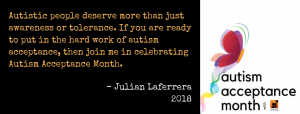
At the core of all our work at Avaz is the belief that whatever we create should enable equal opportunities. We commit ourselves to keep creating products that enable anyone on the autism spectrum to be able to unleash their true potential.
Through our work, we will constantly strive to help break down barriers that arise from society’s misplaced notions about disability, and what equality and accessibility really mean.
All the technology that we have been able to create has been possible only because our users and their families tell us what they want. And we have never stopped listening.
I would like to reiterate our commitment to constantly work with the autism community and the larger community of people with disabilities. And do so to create products that work with them towards realizing their dreams.
I take this opportunity to invite you to join us, partner or collaborate with us. To create solutions. To create acceptance. To create change.
The future that we envision is one of acceptance and inclusion. It is about creating a world where people with disabilities can participate in everything. Where equal opportunities are the norm.
Thank you for letting us journey with you thus far. We look forward to travel further with you in your work towards creating an accepting and inclusive society for all.
In solidarity,
Narayanan
CEO, Avaz
P.S. On account of Autism Acceptance Month, Avaz and free speech are now available at a 50% discount. Click here to know more.
Mindfulness for Children – How to Practice it?
In our previous blog post, we spoke about Mindful Parenting – a technique that melds the practice of mindfulness with approaches to parenting. We discussed how this can enable parents to manage their stress and attend to their wards in a more effective way. If you haven’t had a chance to have a look at the various techniques of mindful parenting shared in that blog, you can take a quick peek here: Mindful Parenting.
Mindfulness is for everyone, regardless of age. Children, especially those on the autism spectrum, can immensely benefit from making the practice a part of their lives. In this week’s blog, we will be discussing mindfulness techniques that you can teach your kids. Mindfulness can enable your child to recognize their emotional responses to stimuli. Using this knowledge, they can over time, learn to respond more effectively to situations and stimuli.
How Mindfulness and Autism are Connected?
Many children on the spectrum struggle with three critical areas: motor skills, sensory regulation, and socialization. They have difficulties in gaining control over the relationship between their mind and body. This is where mindfulness can help. Mindfulness lays the foundation for the skills required for building awareness of the body. Practicing mindfulness gradually enables children to take control of their body. This, in turn, leads to better sensory regulation and a decrease in social anxiety.
Benefits of Mindfulness – For Children
When done properly, mindfulness has several benefits over time, including:
- A better awareness of what is happening inside them, emotionally and physically as well as the happenings around them.
- The ability to identify and control their own emotions.
- Tools to handle their anxiety by helping them to pause, breathe and anchor themselves to calm their mind and body.
- Improving attentiveness while learning.
How to teach Mindfulness to Children on the Spectrum?
There are many ways by which a child can learn to be mindful. The following ideas can be used as a foundation to come up with more customized techniques that suit your child the best.
Here are some simple ways in which you can teach your child to practice mindfulness on a regular basis:
Breathing Exercises: Come up with a breathing exercise/game for your child. For instance, ask your child to cuddle their favorite toy to their tummy and see if they can make it rise slowly up and down using their breath. This enables them to easily concentrate on their breath.
Another instance would be to use a balloon. Hand over a balloon to your child and ask them to blow it up slowly. As the balloon expands, invite them to turn their attention to the balloon. Once they are done, you can slowly release the air from the balloon and call their attention to the balloon’s contraction. This is a great way to teach children to concentrate. You can build upon this technique and come up with similar or better methods!
Bell Listening Exercise: Ring a bell. It could be a physical one or one from an app. Ask your child to close their eyes and listen to the vibration of the bell. As the sound of the bell declines, invite them to slowly shift their attention to any other sounds they hear for about a minute. This is a simple yet effective exercise that shifts your child’s attention to the present moment.
Soles of the Feet: This technique was developed by researchers to manage angst, anger, and aggression. When your child is faced with emotionally stimulating situations, you can teach them to redirect their attention and awareness to a neutral part of the body such as the soles of their feet. This technique helps calm and clear their mind during stressful and stimulating situations.
Calm-down Jars: For this activity, fill a clear jar halfway with water. Top it off with some glycerin or baby oil. Finally, add some glitter to the jar and screw the lid on tight. You can also glue the lid on to prevent spills. If you have a snow globe handy, that would work perfectly as well.
When your child is going through a stressful experience, ask them to shake up the jar and watch as the glitter settles after the swirling chaos within it. This technique allows them to relate their internal state of mind to a visual object. As the external calms down, they too will be able to calm themselves down effectively.
With regular practice, children on the spectrum can benefit greatly from mindfulness and can take control of their body and mind coordination. Also, mindfulness has several benefits and helps them to approach an unexpected or stimulating environment with a calm mindset. Mindfulness, when practiced regularly, can enable children to be more efficient in their activities.
Are you practicing any mindfulness techniques already? Share your thoughts with other readers in the comments section below. :)
Mindful Parenting – How to Practice it?
Parenting can get pretty stressful and challenging. Yet, as many parents would vouch, it is one of the most satisfying and rewarding experiences in life!
Parenting a child with disabilities comes with its own unique set of challenges. Parents of children with autism and other related disorders have been known to experience high levels of stress, depression, and anxiety. Parental stress is a serious issue, but it is often ignored. Self-care gets neglected and parents often end up with severe burnout. This might lead to a situation where parents may no longer be in a position to provide their wards with care and support to the best of their abilities.
Key to be able to manage this stress is, self-care. And one of the most impactful approaches to self-care is through mindfulness. In today’s blog post, we will discuss what mindfulness is, its benefits and a few simple mindfulness practices that one can integrate into their daily lives.
Mindfulness – What is it?
Mindfulness, in simple terms, means paying attention to or being in the moment, without passing any judgment.
What are the benefits of mindfulness?
Consider a situation where your child is having a meltdown when you are at the park or in a store. The most ideal response would be to first, realize and accept your anxiety and frustration at the situation. Next, you would want to focus on how to respond to their meltdown, without letting your thoughts affect your decision-making. This is one instance of mindful parenting
Practising mindfulness, can over time, enable one to approach any issue in a calmer, more systematic manner. It can help you to deal with tough times with greater strength and resilience. The ability to cope with any given situation improves significantly.
Mindfulness also promotes the ability of greater acceptance. Practising acceptance reduces stress. It also helps in better focusing on the present rather than worrying about the distant future.
In essence, mindfulness empowers one to look at oneself and life situations with kindness, love, and forgiveness. When the same mindfulness permeates all aspects of life and becomes a part of the way one approaches parenting, it is mindful parenting.
How to Practice Mindfulness?
Mindfulness is not a destination, it is a journey. It needs to be built slowly and steadily. And it will take time. Here are some simple ways in which one can start inculcating mindfulness into their lives:
Mindful Walks:
The best place to begin mindfulness practice is by simply taking a walk! Put aside a few minutes every day to take a short walk. On the walk, will yourself to notice things around you and the act of your walk itself. While you are doing this, try to concentrate on the smallest details. Things that you would normally miss while being lost in your own thoughts.
In the beginning, it might seem rather tedious. Over time though, this will cease to seem like a task. You may even come to look forward to this walk! Slowly, try replicating the same during the routine tasks you undertake on a daily basis – be it brushing, bathing, cooking or driving.
Such conscious intake of your surroundings enables you to clear your mind of the constant swirl of thoughts and worries in there. As you master this technique, you can try observing your thoughts with similar concentration.
Bonus: This can be a great relaxation technique as well!
Breathing Exercises:
Simple breathing exercises can help with developing mindfulness. The basic exercise that you can start with is just the observation of your breath. Time yourself as you do this. Start at 20 seconds and slowly move upwards. There are many guided meditation apps that you can use to support this practice. These apps will give you guidance as well as tips to improve your practice.
Mindful Bedtimes:
During bedtime, try to include an app-guided meditation a couple of times a week. Body scanning technique is a great way to start practising mindfulness. This promotes great sleep, which is an added bonus!
With everyday practice, mindfulness can immensely help parents be more effective with their children. It also enables one to look at the bigger picture and not get caught up in the smaller things.. Mindfulness has several benefits and has absolutely no side effects. It can provide parents with useful coping techniques and help one to be more efficient in their daily activities.
Do you practice mindfulness? What are the techniques you use? Share your thoughts on this subject with us, in the comments section below. We look forward to hearing from you :)
4 Simple Ways to Teach Social Skills to Your Child
Human beings are social creatures. Social Skills, therefore, are considered to be one of the most important aspects of human life. These skills are deemed an integral part of functioning in society. One begins to pick up these skills from a very young age. This, in turn, prepares one for a lifetime of healthier interactions while enabling the capacity to make meaningful connections with others.
However, the very nature of social skills is subjective. The capacity to pick up these skills at a level that is socially acceptable varies from person to person. Given this subjectiveness, persons with disabilities may find it challenging to understand and demonstrate these skills.
What are some of the ways in which such skills can be developed in a manner that is reaffirming? Team Avaz has been researching this and we have put together some proven ideas that you can try out for yourself.
Modeling
The importance of modeling, in every aspect of life, is worth stressing on repeatedly. There is no doubt that it is the single most effective technique to teach any kind of skill to your child. As a caregiver, you can help model different kinds of social interactions by enacting them to or with your child. Enacting is a great way to familiarise children to a new environment and it enables them to be prepared for a new or unexpected interaction.
Pick one scenario to enact and model your child until they are able to interact with ease.
Self-Modeling
While modeling involves an active role by the caregiver, self-modeling is where the caregiver takes the back seat. One way of self-modeling would be to record the student while they perform or practice the social skill.
Begin this process by first breaking down the interaction to smaller segments. Have your child perform one piece and record it using your phone. You can also prompt or model when needed.
Finally, combine all the pieces together to create a seamless recording. Play this video back to the child. As they watch themselves performing the task from start to finish, they will understand the concept better.
The video can also be used as a tool for reiteration. Backed with practice, this technique will support the child’s effort to generalize any social skill that they are looking to pick up.
Cartoon Strip Social Interaction
Cartoon strip conversation is a technique innovated by Carol Gray. It is a way to let children(or any learner) fill their thoughts in speech bubbles before they role-play a conversation. Cartoon Strip Social Interactions support all levels of challenge and help with improving the fluency of social skills. Research has shown that cartoon strip interaction is an effective way to enable students to improve social interaction skills.
The comic strip below can be used as a guide. There are many such resources available on the internet for free. Use one such comic and guide your child to fill in the bubbles in the boxes. For non-verbal children, you can use the same technique hand in hand with their AAC technology of choice. Prompt them to tap out responses on their AAC device.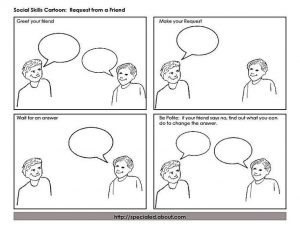
With this method, you can introduce a whole range of interactions including greetings, requests, initiation of social interactions, and negotiations to your child.
For instance, you can practice Greetings like “Good Morning” or “Hi, I’m Johnny”.
Another example would be a Request like “Can you please help me?”.
Role-Playing
The practice is an essential tool for building social skills. Role-playing offers a great way for a child to practice a social skill with another person in a controlled and safe environment. By exposure to other people’s responses, the child will get to grasp the interaction from different perspectives while broadening the scope of their understanding of the skill.
The comprehension and demonstration of emotions, expressions, and interactions can seem quite daunting for a child with a disability. But patient guidance and support will enable them to develop such skills over time. Coupled with practice in a safe and affirming environment, children can acquire the skills to identify emotions as well as their causes and effects in various scenarios. This will enable them to build healthier and more meaningful relationships with their friends and family.
What are some of the ways in which you have tried enabling social skill learning? We invite you to share your ideas with us and our readers in the comments section below! :)
References:
https://www.thoughtco.com/cartoon-strip-social-interactions-3110699
Inclusive Education – How Does it Impact Our Children?
It is a known fact that children are excluded from many school settings because of disability, race, language, religion, gender, etc. But every child has the right to be educated and thrive in an environment that is inclusive irrespective of the differences. Nowadays, parents are more inclined towards inclusive education, but there isn’t much awareness of this topic.
Keeping this in mind, we are going to try and demystify inclusive education and its importance.
Inclusive Education – What is it?
Education is deemed to be inclusive when students from diverse backgrounds learn side by side in the same classroom. Students with different physical and learning abilities are placed in age-appropriate general education classrooms. They participate in field trips and after-school activities together and attend the same sports meets and plays.
It is the teachers and the school administration who recognize that children with disabilities have equal capacities to learn and perform just like their peers without disabilities. To this end, they provide adequate support, resources, and infrastructure to facilitate their education.
Why Inclusive Education is Important?
Inclusive education is about appreciating each child’s differences. It involves taking cognizance of each child’s unique set of strengths and limitations. Inclusive education enables children to understand and live in harmony in a world filled with people different from themselves. An inclusive school is the perfect training ground for real life as the dynamics of the school imparts children with life lessons, values, and morals.
Some important values that inclusive education imparts are:
Greater Sensitivity
Children who grow up in inclusive education dynamics become more sensitive by learning side-by-side with their peers with disabilities. They understand how words can affect a person. They get to practice patience and develop empathy. This also inculcates strong bonds of friendship among the children and helps them learn social skills.
Better Understanding of Strengths and Weaknesses
Children in inclusive schools learn that everyone has strengths and weaknesses. This gives all the children a chance to learn to appreciate such differences. Children with disabilities, especially, are able to develop a positive perception of themselves from the get-go. All the children in such a setting, learn the importance of collaboration to accomplish something. As children of different abilities learn and grow together, so do their values of respect and acceptance.
Learning Together
The primary aim of inclusive education is to enable children to learn and equip themselves with skill-sets that fits their interests. Such an approach benefit everyone. Children learn at their own pace and style within a nurturing and supportive environment.
Creation of an Inclusive Society
Introducing inclusive education into the classroom leads to the acceptance of children with disabilities, thereby enabling them to lead their lives in a more inclusive society. When children are exposed to inclusive education, it imparts the values, skills, and knowledge to include others who are different from them. Children start to perceive the differences in a positive way. In the long run, these future adults will be instrumental in ensuring that equal opportunities are made available to ALL.
Inclusive education is of great importance and schools should not exclude students with disabilities. Children with disabilities should be provided with quality education just like children without disabilities.
With continuous exposure, inclusive education not only enables children but also parents and teachers. Also, inclusive education meets the requirements of every child in the system thereby creating a bright future for this approach. With proper training and support, schools can implement inclusive education with ease and success.
Share your thoughts on this subject with us, in the comments section below. We look forward to hearing from you :)
6 Ways to Show Your Love, All Year Long!

Express thoughts clearly
It is a very human tendency to drop subtle hints or convey our thoughts in a not-so-straightforward way. For people with autism, the task of reading between the lines is a challenge. So, it is always best to communicate thoughts and opinions in a clear and straightforward manner with them. Being transparent and upfront helps them stay focused on the immediate present in addition to giving them a clear idea of what was communicated.Say NO to surprises
When a change is presented in a rational, gradual and logical manner, it is well-received by people on the spectrum. On the other hand, they would find coping with sudden changes in routine difficult. They do best when they know what to expect. Even when a “happy” surprise party is thrown, they would need time to thoroughly consider and walk through the events unfolding in front of them. A change of plans brings with it an immediate sense of uncertainty. This, in turn, could lead to confusion and discomfort. Hence make all plans keeping this in mind.Create opportunities for activities to look forward to
The anticipation of an enjoyable experience (things they are already familiar with) keeps them going throughout the day. The thoughts of an upcoming happy time would help counterbalance anxiety and panic-driven situations. Simple things such as their favorite meal, lunch with a dear friend, or a day to sleep in and rest – looking forward to things like these keep them going. So ensure that you create such enjoyable events for your loved ones on the spectrum.Have things in order
Having things organized in a systematic and consistent manner is essential in providing comfort. Make sure the immediate space – such as rooms, paperwork, school bag, wardrobe and such are organized in the same fashion every day. While this might be a bit tiresome for you, this also means less anxiety brought on by challenges with object permanence that your loved ones on the spectrum face. Simple things like knowing what to expect when they enter a room or when they open the dresser drawer prevents anxiety. Not having to guess and process the excess of information before, during, and after an encounter goes a long way.Give them ample time to process
One of the most important things you can do to support your loved ones is to provide them with adequate time to process information at any given point of time. People on the spectrum need time to process their own emotions and expectations. Without the time to process the events of their life, they might not function to their fullest. So it is essential to give them ample time and space to let them understand the unfoldings of both internal and external events.Give them unconditional love and acceptance
People on the spectrum need to be understood, accepted and loved unconditionally! When they are forced to do things they don’t want, it might lead to meltdowns. Instead, provide them with space to follow their pursuits and special interests. Let them have their “Me” time, and make sure that you do not disturb them or push them to do things that you may think is best for them.This Valentine’s Day let us show our love and support to the adults and children with autism and make them feel loved even more! The above-mentioned ideas are just one way of doing that. We hope that you find these tips useful and implementable for your loved ones. Together, let us make sure that Everyone is being Loved & Cared for! Do you have any ideas that you have used with your loved ones? Feel free to share with us in the comments section below!
A Self Made Woman – Ummul Khair
 Team Avaz had the privilege to interview Ummul and get to know more about her, her journey and her work. So sit back and get inspired by the life of this woman of substance!
Team Avaz had the privilege to interview Ummul and get to know more about her, her journey and her work. So sit back and get inspired by the life of this woman of substance!Team Avaz (TA): Who is Ummul Khair? What is she like as a person? Ummul: I have a disability. Yes! But I’m not a disabled person. I have my strengths and weakness and I would like others to accept my abilities. Accept me for who I am and accept me as a Person with Disability. I used to be an innocent child and always depended on others but now I am able to help others and that makes me happy! TA: Tell us a bit about your childhood? Can you please share some of your fondest memories? Ummul: As a child, I was always on the bed. My mother used to carry me to every place. I didn’t own a wheelchair. So, I never had the chance to leave my home on my own. My parents worried too much because of my disability and never left my side. On the bright side, I was favored by my parents more than my brother. Whatever I wished for, was immediately done! But I secretly yearned for education; to be independent and to help and care for others! I don’t remember most of my childhood, but I do know that I loved eating curd and my favorite candy, Gems. I always looked forward to playing with my cousin! TA: Starting your education at 21 needs lots of courage. Can you please tell us what motivated you? Ummul: I wanted to know what the world was like. I wanted to meet people and make friends. Since I spent my childhood inside my home, I never knew how to handle any situation nor did I know how to interact with people. I wanted to know what rights I had as a woman and as a woman with a disability. I couldn’t go to school because my parents were overprotective. It did not help that people around me believed education was of no use to me. For many years I saw my cousins reading, but never had the opportunity to read those books. I remember reading the subtitles while watching movies and soap operas. There was this particular soap where the protagonist was a woman with a disability. It portrayed her journey and how she overcomes the challenges. Watching it day after day, kindled my spirit and I wanted to become like her! I wanted to break the stereotype.
“To express my thoughts, come out of my boundaries, and break the stereotype, I wanted to pursue my education.”
TA: Talking about education, you did Sociology and now you have done Law. Who or what inspired you to choose this path? Ummul: Do you agree that Rights come by birth? I didn’t know my rights for a long time. I thought it was rude to refuse a favor(though I never asked for it). But now, I don’t accept any favor unless I have requested it. I believe in human rights and that’s what I fight for. Not just for persons with disability but for everyone! This is the reason behind me taking up Law – because no one should be denied their rights. Helen Keller has been a huge inspiration as well. Her writings have had a great influence on me. TA: What, according to you, has been the biggest challenge life has thrown at you so far? And how did you overcome it? Ummul: I used to speak only in Hindi or Urdu. Hence learning a new language, English, and improving my proficiency in it was a challenge. Also, at times, I forget. Imagine being a forgetful lawyer! That’s my biggest challenge. (laughs) On a more serious note, accessibility is another challenge. Not only for me, but also for every person with disabilities. The attitudinal barrier is another predominant challenge that needs to be addressed immediately. When I was at Madras High Court for an access audit, the security person stopped me from entering a particular room as it was not accessible. But that was exactly the reason why I was there! People take one look at me and think that I am struggling in a wheelchair.“People fail to see ME, as the disability is more visible to them!”
TA: You along with the Disability Rights Alliance played a primary role in making the Besant Nagar and Marina beaches in Chennai accessible for wheelchair bound folks – Can you tell us more about this effort? Ummul: Pushing a wheelchair on the sand is very hard. I used to sit near the footpath and a volunteer would have to stay back for me – every time I wanted to visit the beach! These experiences sparked the idea to work towards making beaches accessible for people with disabilities. I researched various accessibility projects around the world. Then I started writing petitions to all the concerned authorities. But it was really hard to get their attention as I was a lone student. This is when I came to know about the Disability Rights Alliance (DRA). I collaborated with them and worked with Chennai Corporation as well. After lots of research, follow-ups, and processes we were able to celebrate World Disability Day at the beach with our students. TA: What kind of changes would you like to see in our society? What is your vision of an inclusive society? Ummul: Equal opportunities for people with disabilities. Every place should be made accessible. When I was in the US representing India for a one-month student leadership program, everything was accessible to me. I was able to go wherever I wanted to and that is something we should work towards. My idea of an ideal inclusive society is where people with disabilities not only seek help but are also able to contribute to society and give back to those in need. TA: That’s really a great vision! Thank you for sharing your thoughts with us. Before we close, is there any message you would like to share with our readers? Ummul: Most certainly!“Don’t ignore us; talk to us and not behind us.
Remember! Everyone is interdependent and no one is completely independent.
Everyone needs support, everyone needs suggestions. So value each other.
Give us the opportunities to show what we are capable of. ”
Ummul signs off by telling us about her rappelling and parasailing experiences and how she loves to take risks and not give up at the face of adversaries! Team Avaz was inspired by this courageous woman who fights for human rights and for the rights of people with disabilities. More power to you Ummul! Together, let us strive to Make Every Voice Heard!
Supporting Young Carers’ Mental Health
 This year’s theme focuses on the Mental Health of young carers. Most young carers have more responsibilities than other young people. As a result, they experience more stress than their peers, some of which they might not be able to handle by themselves.
This year’s theme focuses on the Mental Health of young carers. Most young carers have more responsibilities than other young people. As a result, they experience more stress than their peers, some of which they might not be able to handle by themselves.Here are some ideas that you can try out to ensure that young carers receive all the support they need.
HAVE AN HONEST TALK WITH YOUR CHILDREN
Communication is vital to build and develop any relationship. Therefore, the importance of communication should not be underestimated when it comes to young carers. Talk to your children about mental health and help them understand how important their mental health is. Ask them if they are feeling stressful or depressed. Discuss with them what you can do as a family to help them feel better. Tell your children that you are proud of them for taking up responsibility and supporting their sibling. Talk to them about specific incidents which made you feel this way.BREAKS FROM RESPONSIBILITIES
Most young carers are children who grow up faster than their peers. They try and understand the hardships in life at a tender age. But these hardships should not be a reason to miss out on a happy childhood. To create a positive impact on mental health, regular breaks should be provided. If family outings are not possible, let them have fun with their friends. Most importantly, give them breaks from responsibilities when they are tired or feeling low. Let them know that they are also children who need to enjoy being a child.SUPPORT THEIR STUDIES
Young carers, because of their caring responsibilities, might need support in school to keep up with their peers. Talk to their teachers about the caregiving responsibilities and request them to provide extra help whenever the child needs it. As a parent, you could help your child with assignments and homework. If they had to miss school for a day, ensure that the classes are covered and the concepts are made clear.HELP THEM SOCIALIZE
As a young carer, your child may miss out on opportunities to play and spend time with friends and classmates. This might lead to them feeling isolated, and they might find it hard to make friends. Hence it is important to find other young carers with whom your child can relate and talk to. Meeting other young carers can be an excellent way for your child to make new friends, share their experiences, rebuild their self-esteem, and have the social opportunities that children their age should have.This Young Carers Awareness Day, let us make sure to recognize the efforts of our young carers who help to care for their siblings and parents with disabilities. Spending a little more time with the young carers and supporting their needs would go a long way in promoting their well-being. The above-mentioned ideas might help you to strengthen the bond with your children and help you to support them in better ways. Together, let us make sure that Every Voice is being Heard! Do you have any ideas that you have used with your young carers? Let us know in the comments section below!
Writing Code that Makes a Difference!
Making a positive difference in the society we live in is something we all aspire to in various measures. That said, we see a lot of change makers in our day-to-day life but hardly have any time to acknowledge their efforts in making this world a better place. One such group of people who toil day and night without much appreciation are the programmers or developers behind many of the apps we use all day.
January 07 and September 13 are observed as International Programmers Day in different parts of the world. We are dedicating today’s post to give a huge shout out to our amazing team of programmers, here at Avaz. 
“Being a programmer requires a lot of patience and everlasting love for coding.”, says Balaji, Senior Software Developer at Avaz.
The Development Team or the Dev Team as we call them, are the ones responsible for making Avaz what it is. They are the ones who work with the Product Team to turn user feedback and expert recommendations into features on the Avaz app. From understanding the requirements of the users, ideation of the various elements involved, researching the best approaches, designing the components from scratch, implementing the features to testing the usability of these features and finding issues in them, the Dev Team does it all.
“I have always wanted to create a product that serves the community. And Avaz gave me the opportunity to do it.”, says Abu, Senior Software Developer at Avaz.
Creating the best possible app for the user has always been the primary goal of the Avaz Dev team. The will to serve the community and the ability to deliver the best to our customers has helped them stay motivated throughout this journey. There have been times where they have had to stay up all night or forgo vacations to ensure that some customer requirements go out urgently. But they do all this without complaining. Because as Narayanan, our CEO puts it, “There is a lot of joy in seeing something that you have coded making a huge, real-time difference to a child’s life!”
All of us here at Avaz are very proud of our Dev Team. We take this opportunity to thank each one of our developers for all the hard work and commitment they have put in over the years.
Here’s to Abu, Balaji, Kavitha, Abdul, Narayanan and all those who worked on Avaz before them, for their unceasing efforts to Making Every Voice Heard!
PS – Any day is a good day to express your gratitude. So take this opportunity to thank those who have been supportive of your journey and remind them that they are just AWESOME for being the way they are! :)
Here’s How Siblings Can Engage Using AAC
Siblings are our first friends, and at times, our closest friends. Researchers have found that siblings heavily influence each other and the type of person they eventually grow into. And in the lives of children with special needs, siblings have an especially important role to play.
Involving siblings is a great way to enable children with specialized needs to experience a dynamic and supportive environment. As they build their communication, it helps the siblings to build a deeper relationship with each other. Many a time siblings of children with special needs end up feeling left out because of all the focus and energy being given to the latter. This manner of involving them can be one of the ways to enable them to overcome that feeling. 
Here are some tried and tested ways by which siblings can engage by using AAC –
Collecting Frequently-used Messages:
Ask the sibling to help you brainstorm messages that their brother or sister might want or need to communicate. This can make your work simpler as siblings are closer in age and know things about each other that adults might miss!
Recording Voice Outputs:
Recording voice messages is a fun way to engage your children. Listening to a familiar voice, makes your child want to use the AAC device more. When a sibling records a message using AAC, it develops compassion and a sense of belonging in your children.
Guiding the Siblings:
While most siblings might not love being bossed around, they can engage in games that involves giving directions. Such games teach critical thinking and encourage self-discovery. And games are great ways of coming together and having fun! By using a sequence of messages on their device that you can load beforehand, the children can take turns to play an inclusive version of games like “Simon Says” and so on. This will give the child a sense of control while letting the siblings be actively involved in the game.
Bedtime Stories:
You can get the help of your child to record a sequence of messages and add relevant images of a bedtime story. Later, the child can “read” the story to their sibling by selecting the pictures in a sequential manner.
Lullabies:
Just like the bedtime stories, you can record some of your child’s (who uses the AAC device) favorite lullabies on the AAC device. During bedtime, the sibling can select a lullaby and sing along as the device sings the song. This is a great way to improve the bonding between the siblings.
With little preparation and support from your end, you will be amazed how incredibly passionate siblings are about helping their brother or sister to communicate more effectively. These activities will also help bring out the caregiving qualities of your children. AAC and AT are very helpful tools for increasing children’s opportunities to engage meaningfully with their brothers and sisters. And Avaz is one such tool striving towards Making Every Voice Heard!
Do share other methods you use to enable communication and bonding between siblings with the help of AAC or AT!
2019 – A Sense of Limitless Possibilities
Each New Year brings with it immense promise. A promise of fresh ideas and a renewed energy to bring those to fruition. And 2019 is no different. After a deeply meaningful 2018, all of us here at Team Avaz are extremely excited about the coming year.
What are some of the things that will have the greatest meaning for our users – this is the question we asked ourselves as we planned for 2019. After much thought, here are some of the things we have decided to focus on, in this brand new year.
PRACTICAL INSIGHTS
One of the biggest focus areas for us in the coming year would be to provide you with the best resources, information and research that you can use to equip yourself to become even better at what you do. Whether you are a parent, a caregiver, an educator or a therapist, we will strive to bring you the most relevant and useful content through the year. We would love to hear from you about what it is that you would like to know more about. Do tell us that in the comments section below and we will get cracking to bring you just that!
CREATING BETTER COMMUNICATION PARTNERS
Continuing in a similar breath, but with a more specific objective, this year we want to work with you to enable each one of us (ourselves included!) to become better communication partners. To do this we would need to create many communication opportunities. Additionally, use strategies that would enable those who we work with to communicate better and do so at their own pace. To this effect we are looking at –
- Creating online and offline opportunities to interact and learn from each other.
- Conducting workshops, training webinars and demonstrations to create greater understanding of AAC in general and Avaz in particular.
- Creating tried and tested pool of resources and content on effective communication partnering strategies.
We believe that such opportunities for all of us to engage and share knowledge will go a long way in making all of us better communication partners for the people we work with.
PRODUCT IMPROVEMENTS
The year gone by saw some big ticket improvements to Avaz. And this we are hoping to top that and are raring to go to make Avaz even better. We are already working on adding many new languages. In addition, expect to see some really powerful new features that a lot of you have been requesting for. And of course, we will keep working to iron out the creases and tweak the existing features to give you a better Avaz experience, every time!
Stay tuned to this space for news on updates and new features ☺
NEW PRODUCTS
At Avaz, at the core of everything we do, is the belief that technology can empower any individual with special needs. To that effect, we have been working on many new product concepts and prototypes. This year we expect to release at least two new products. We will share with you more on this soon!
In 2019 we recommit ourselves to our mission of Making Every Voice Heard. As usual the user will be at front and center of all that we do. Avaz is here to stay and grow with you, every step of the way!
Here’s wishing you and all your loved ones a very happy, healthy and prosperous New Year!
The 2018 Avaz Round-Up
In our pursuit towards making every voice heard, 2018, we believe has been a milestone year. We made some big updates to existing versions of Avaz for Communication to give you a product that learns, gets better and grows, just as each of our users do. We have released some new languages in Avaz for Communication and have many more in the pipeline. We are excited about this as we believe that language should never be a barrier in communication. With every new language, we get one step closer to creating barrier-free communication for all. We love interacting with our users to understand how we can make Avaz work better for them. In this regard 2018 saw us reaching out to more parents and users through our workshops and showcases. This, especially, meant a lot to us.
So here’s a quick round-up of 2018 – the year that was!
Collaborations and New Products
Team Avaz has always believed in bringing together great ideas to create products that enable and empower. 2018 was deeply significant in this regard. This year saw some incredibly powerful collaborations with multiple domain experts that led to the creation and release of two amazing new products.
- MDA Avaz Reader – The Madras Dyslexia Association is among India’s most respected and experienced organizations working with children with Dyslexia. With over 20 years of expertise in dyslexia education and support, they have created a variety of tried and tested modules to enable struggling readers to read better. To make this expertise available to more children via easily accessible technology around the world, Avaz has collaborated with MDA to create the MDA Avaz Reader app. The Reader app enables dyslexic children to read independently through methods and features that have proven to be powerful and hugely effective over the years. You can download the app here – Apple App Store & Google Play Store
- Avaz Vietnamese – We partnered with Viet Dynamic Connections to release an AAC app that is customized and localized for the users of Vietnam. The app was released in less than a year of collaboration. We are very excited to have been able to expand the repertoire of languages on Avaz. You can download the app here.
Avaz Community
2018 saw a rise in the number of support groups being formed by parents of Avaz users. These online and offline groups are completely driven by parents who have come together to support each other and share insights, tips, and resources related to Avaz and communication. We are grateful for these communities. They help us stay grounded and inspire us to keep improving Avaz.
Workshops & Events
2018 was a year in which we conducted multiple workshops for parents, caregivers and therapists around the world. These workshops were held both in person as well as remotely in the form of webinars.
The aim of the Avaz Workshops are two-fold –
- To introduce the concept of AAC and how it is beneficial for children as well as complementary to work done by caregivers and therapists.
- To run through the various features of Avaz.
The workshops cover all aspects of AAC and Avaz. Right from setting up and customizing the Avaz app for each user to giving ideas on how AAC like Avaz can be integrated into daily life, the workshops give training and information that is informed by years of user inputs. We have been receiving feedback that these workshops have been immensely useful for the attending parents, special educators and speech therapists. They have also been very effective in addressing doubts related to various aspects of the app and its use.
If you would like to have our team conduct a workshop or webinar for your school, team or for a group of parents, do drop us a mail on support@avazapp.com :)
The year also saw Avaz participate in a number of events & showcases, some of which you can read about here and here. We were also present at the Global Autism Convention in Bangalore, India among other really interesting events through the year.
App Updates
The first quarter saw us overhauling in-app support on Avaz. You can now reach out to us easily via chat while using the app itself. The Avaz Live function was made completely functional and easily accessible. Avaz Live can be used for remote therapy sessions with speech therapists. The therapist, in turn, can also use Live to operate Avaz at the user’s end to take them through use and learning activities. These two features were rolled out for Sri Lanka, Denmark, Australia, France, India & US over the year.
The Avaz App was made fully compatible with Android devices. What’s more, the App is optimized to be used on Android devices of ANY screen size. Some Android only new features are the option of sharing messages created on App with contacts on WhatsApp and the Bubble feature, with which a user can always quickly access Avaz, without having to close the app they are using.
Coming to version specific updates, Avaz Sri Lanka had a comprehensive Sri Lankan Tamil Vocabulary added to it.
As we look back on the year gone by, we cannot wait to do much more in the coming year. Thank you for supporting us and continually pushing us to bring you only the best! We look forward to having you join us as we move ever onward towards Making Every Voice Heard in 2019 and beyond!
Tips for a More Magical Christmas!
Planning and Preparation

Autism-Friendly Decoration
Be Ready with Familiar Food
Prepare Your Family
Plan for a Sensory Retreat
Team Avaz sends loads of love, festive cheer and wishes your way! Wishing you and all your loved ones a Very MERRY CHRISTMAS and a Happy New Year!
Ramp-Walking Their Way to Create Awareness on Access
– Ms. Radha Ramesh, Director, Vidya Sagar.
Vidya Sagar (formerly known as The Spastics Society of India, Chennai), is an organization working with people with multiple disabilities. This organization is proactively working towards meeting the needs of the evolving disability movement through advocacy and innovative awareness programs. One such program in this direction is VaccesS, designed to create awareness on access & accessibility. VaccesS serves as a platform to connect people & organizations creating accessible designs, equipment, and assistive devices to people with special needs, NGOs, schools for people with disabilities and the like. VaccesS also successfully brought together various sections of the community, including mainstream educational institutions, corporates, builders, architects, government officials and more. Many activities and games were conducted through the course of this event. All if these were designed with the aim of enabling participants to experience “enhanced ability” in a fun, interactive fashion. The exhibition showcased various products and equipment of day to day utility with multiple accessibility features, designed by different companies. Also featured were assistive devices and information materials on various aspects of access. Team Avaz was a part of this innovative program. The opportunity was used to present the Avaz App to a diverse set of stakeholders. Many participants took pride in knowing that Avaz is an India-based organization working in the AAC & AT space. The most heartwarming highlight of the two days was the Ramp Walk featuring the students, staff and alumni of Vidya Sagar. Using the school’s wheelchair ramps to stage the show, the literal and figurative references were unmissable. Wearing shades of white, a group of 40 models walked the ramp, exuding great confidence and joy. The walk showcased clothing with simple adaptations to make them more accessible for people with disability. Some of these adaptations included Velcro fasteners, clothing with alternative access points to suit variation in motor skills of the wearer and alterations in the way of wearing the clothes to ensure that the support belts were not visible. The clothes were trendily accessorized with scarves, stoles, and bags from Kalakkal Kadai*, an entrepreneurial venture of the students of Vidya Sagar. The models were mighty thrilled to walk the ramp, many even counting down to its start! The joy, confidence, and pride of being a model on the ramp was evident on every face!
“It was inspiring to see the pioneering work being done to innovate, design and build devices for people across the disability spectrum to use, with active input and participation from the users. VaccesS brings together the whole community of designers and builders, researchers and practitioners as well as users and their families. It provides a vibrant platform to create awareness of both the needs of the disabled as well as the kinds of assistive devices available to enhance lives. The program is a celebration of the human spirit to rise above adversity.”
– Shankaran Nair, Chairperson, Vidya Sagar
VaccesS has successfully created awareness on the different forms of Access – physical access, access to communication and information, and most importantly attitudinal access. This event was a definitive step towards making the inclusion of people with disability a reality.*Kalakkal Kadai – A shop at Vidya Sagar where all the products are made by the students as part of their training at Employment Education Centre (EEC). We would love to hear from you if you or your organization are conducting such events. Write to us in the comments section below and we could feature your event on our blog soon!
Dipak Ghosh – The World at His Toes
“I feel that society only gives us 30% opportunity. While we have to put 130% effort to be capable! We don’t want to take a jump ahead nor do we do we want to lag behind. What we want is to walk together with everyone in the society.” – Dipak Ghosh, Disability Rights Activist
A few weeks ago, we had a chance to present our work and attend Empower 2018 – an Assistive Technology conference in New Delhi, India. Thinkers and innovators from the Indian Institute of Cerebral Palsy (IICP), National Institute of Speech and Hearing (NISH), as well as those from various Indian Institutes of Technology (IITs), among others, were present. It was a great learning experience for us, to be able to interact with brilliant minds from across the country.
The interaction and new friendship we cherish the most from Empower was the one we had (and continue to have!) with Dipak. Dipak is 33. Having completed his BCom. (Hons.) in Accountancy, he is an accomplished artist and musician. He is also among India’s foremost advocates for equal rights and opportunities for persons with disabilities.
Dipak was diagnosed with Cerebral Palsy when he was an infant. He was almost three years old when he was able to sit up. Because of CP, he has very limited use of his hands. This, however, was hardly a deterrent for Dipak. Being a creative child, he taught himself to use his legs to write, paint, play and engage in his daily routine.
As a child, Dipak was quite naughty, often getting into trouble. He passed his secondary education from the Center for Special Education – IICP. He attributes a large part of his success to the support he received during his schooling here. His school life was full of excitement and fun in the company of his friends and teachers. An academic topper, he received several medals in the sports as well. It was here that Dipak learned to draw and play musical instruments with his feet.
Dipak also began using the keyboard very efficiently with his toes. But this was getting extremely demanding and tiring for him. Hence he began searching for a simple and effective communication tool. This was when Dipak came to know about the Avaz AAC app through IICP. He was thrilled when he found Avaz easy and effective to use for his specific requirements. Dipak began using Avaz in 2013 and there has been no looking back since! You can watch a video of him using Avaz here –
[embedyt] https://www.youtube.com/watch?v=A0iIyB4ACw8[/embedyt]
Dipak’s mother is a huge influence and inspiration for him. She has always believed that there is no greater dignity than serving others. Taking a page out of his mother’s beliefs, Dipak is today a well known and respected advocate for the CP community’s rights, inclusion, and opportunities. As a public speaker and activist, he has inspired many by his example. He is currently working on a project called the Media Lab in collaboration with the National Resource Center for Augmentative and Alternative Communication (NRCAAC). This project is looking to formulate a new concept of understanding and expression of ideas, aspirations, feelings, and thoughts.
For all his accomplishments, Dipak was awarded the Surrendra Paul Memorial Award for Courage. He was declared The Most Creative Adult by the Governor of West Bengal.
Dipak is a great inspiration, not only for his community but also for each one of us. His story pushes all of us at Team Avaz onward with greater resolve towards Making Every Voice Heard!Avaz is now available on Play store. Download Avaz for free: https://tinyurl.com/y6wodn8h In India, download Avaz for free here: https://tinyurl.com/y9fxazv8
Avaz App – Now on Android!
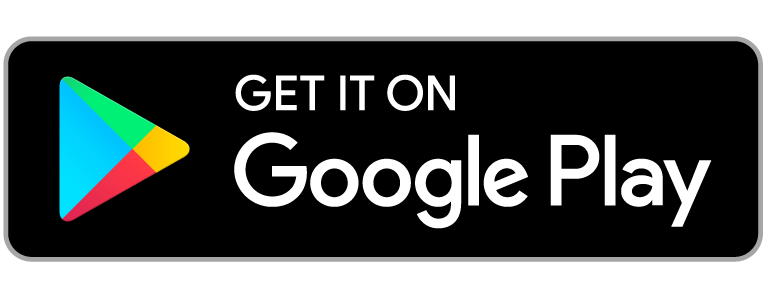
Host an Autism-Friendly Thanksgiving with these Ideas
Preparation and setting expectations is vital for children on the spectrum. Plan Thanksgiving a few days in advance and sit your child down to explain the schedule. Show your child pictures of the relatives who are expected to turn up. Run them through the plan a couple of times. You can also set expectations on your child’s behavior and explain them that they would be rewarded for their good behavior.
- Prepare Your Family
- Make Sure to have Familiar Food
- Prepare for Sensory Needs
- Have an Escape Plan
Play around with these tried and tested ideas to celebrate an autism-friendly Thanksgiving with your family and friends! Do share with us in the comments below, the strategies you use to make this season a happy time for your child. We hope you create lasting memories with your loved ones, with good food and music during this holiday! And don’t forget to thank your family for their support on hosting an autism-friendly Thanksgiving! :) Team Avaz sends your way immense thanks for all the love and support you have given us over the years! Wishing each one of you a very Happy Thanksgiving!
Love Yourself – Self Care before Giving Care
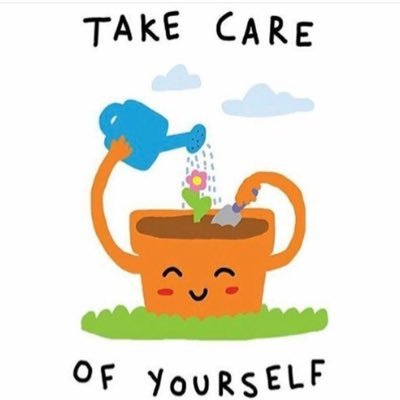 This by no means indicates that you add more pressure to your time and work. At the heart of self care is kindness to the self. It is only a loving reminder that your own well being is equally important, if not more. And there are ways in which any caregiver can do this for themselves. Here are some self-care ideas that you can try out:
This by no means indicates that you add more pressure to your time and work. At the heart of self care is kindness to the self. It is only a loving reminder that your own well being is equally important, if not more. And there are ways in which any caregiver can do this for themselves. Here are some self-care ideas that you can try out:FIND A SUPPORT SYSTEM
- Support Groups: Look for support groups, in-person or online. Interact with others facing similar challenges. This peer group could help you feel supported, connected, and provide relief, as you share your difficulties with those you can relate to. These groups help you realize that you are not alone. They help you build the confidence that you will find a way. Some of the parents we work with have found such groups to be extremely helpful. Find a list of such groups at the end of this post.
- Professional Support: Therapy or counselling can help you manage your fears and anxieties. There is no shame in seeking professional help. Seek out a therapist or counsellor who can help you work through specific challenges and issues you face as a caregiver.
- Support Closer Home: Catching up with friends and close family you enjoy spending time with is a great way to destress and show yourself some love.
Self-care is critical for caregivers of children with special needs. Practicing self-care in small doses and as often as possible, can enable you to be a better advocate for your child. Incorporating a few of these self-care ideas in your day will help you in the long-run. How do you care for yourself? Share with us in the comment section below :)
Here are some links to groups and websites for more self-care resources: SCAN – An Indian based parents support group. Resources for SLPs and Therapists: https://blog.asha.org/2017/06/29/9-self-care-tips-for-the-time-crunched-slp/ http://speechymusings.com/2017/03/28/self-care-tips-slps/
Highlights of AAC Awareness Month – 2018
Team Avaz participated in the Open Day conducted by Vidya Sagar – The Center for Special Education, Chennai. Live demonstrations of Avaz app was made to parents, caregivers, and speech therapists. In addition, a general awareness session on AAC was held and related queries were answered in this event. Our team also attended Empower 2018, an Assistive Technology conference in Delhi. Here, we got the opportunity to share our journey and experiences of building Avaz as a product, with various users and stakeholders in the Assistive Technology space. This experience, rich with interaction and exchange of ideas, helped us gauge a few things with greater clarity –
- Some of the gaps that exist in our own work and
- The long way we collectively have yet to go, in making accessibility of every kind, a reality in all aspects of life.
Make this Diwali a Memorable One for your Children. Here’s How!
 However, loud noise from the fireworks is bothersome for the elderly and ailing, pets and individuals with hypersensitivity. This impact is especially pronounced in children on the autism spectrum. Sudden exposure to loud sounds can lead to a startle reflex that triggers seizures in children with multiple disabilities. For children with social anxieties, the constant stream of visitors may be another source of stress. That said, it is possible for your child to enjoy Diwali, just as much as the next person. All it takes is a tiny bit of planning. Here are some ideas for you to try out and create some sparkling Diwali memories this year!
However, loud noise from the fireworks is bothersome for the elderly and ailing, pets and individuals with hypersensitivity. This impact is especially pronounced in children on the autism spectrum. Sudden exposure to loud sounds can lead to a startle reflex that triggers seizures in children with multiple disabilities. For children with social anxieties, the constant stream of visitors may be another source of stress. That said, it is possible for your child to enjoy Diwali, just as much as the next person. All it takes is a tiny bit of planning. Here are some ideas for you to try out and create some sparkling Diwali memories this year!GENERAL IDEAS Whatever be your plans for Diwali, talk to your child ahead of time about what to expect. How to Prepare:
- Let them know that there will be loud, unfamiliar noises, lots of people, bright lights, a change in routine and so on.
- If your child responds to visual aids, you can use photos to create a story that illustrates the activities you will be doing that day.
- Share with your child why you are excited to celebrate Diwali. Talk about what you enjoyed doing as a child.
- Let your child take the lead in deciding what they would like to do :)
NOISE Noise is inevitable on Diwali these days. How to Prepare:
- In the run-up to the big day, consider watching videos of fireworks while gradually turning up the volume over time.
- Prepare a comfort pack containing toys, books and other objects of comfort close at hand so that your child can try and focus their attention away from the noise.
- Consider purchasing good quality ear plugs and headphones for your child. Noise-canceling headphones are the most effective because they replace irritating environmental noise by producing calming white noise.
- Identify safe spaces that soothe or calm your child. For instance, it could be your room or theirs.
- Plan indoor activities beforehand to engage their attention away from the noise.
- Make use of headphones and earplugs.
- Pull out the comfort pack you readied earlier to offer some relief.
- Take your child to the safe spaces you identified earlier, to calm them down.
NEW CLOTHES For some children, new clothes during festivals could be anxiety-inducing. You can take some steps beforehand to help them manage this. How to Prepare:
- Take your child for shopping to pick their own clothes, if that is a possibility.
- If that’s not possible, show them the new clothes picked out for them. Let them feel the cloth, the textures in it, enjoy the colors, and get familiar with it before the festival.
- You could help your child wear new clothes over the clothes they already like, to increase their comfort level.
ANXIETY FROM MEETING PEOPLE Social anxiety may get compounded when there is a constant stream of Diwali guests. You may also have to go visit others’ homes. There are ways you can take the edge off this anxiety caused by this. How to Prepare:
- Request your friends and family to visit over a couple of days, as opposed to everyone coming on the same day.
- Similarly, you could plan your visits to others’ homes over a couple of days.
- Involve visiting family and friends in activities that your child enjoys so that your child too can have fun in their company.
FIREWORKS
- Use your discretion before taking your child close to fireworks or to see them.
- If they wish to watch fireworks in the sky, get them to wear noise-cancelling headphones before heading out.
- Do maintain a safe distance from fireworks. The bright sparks may be triggering for some children even with noise cancelled out.
- If your child is not keen on fireworks, you can always switch to some quiet and comfortable indoor activities which you pre-planned.
A bit of thoughtful preparation and execution will go a long way in making this Diwali special for your loved ones. What are some of the things that you do to make this holiday memorable for your child – how do you go about planning it? What activities do you look forward to enjoying with your child? Do share with us in the comments section below :) If you found these ideas useful, do take a minute to share this blog post with others who might benefit too! On this auspicious festival of lights, may the glow of joy, prosperity, and happiness illuminate your life and your home. HAPPY DIWALI! *Diyas – earthen oil lamps
Tips for Fun-filled Halloween Memories with your Children
 Halloween is an exciting holiday for the kids. They love trying out different costumes and going trick-o’-treating in their neighborhood. Costumes, decorations, music, and candies are the highlights of this holiday! However, the same may become overwhelming, and at times challenging experience for children, who are on the autism spectrum. Unfamiliar people, places, social interactions and even some of the costumes could cause anxiety and sensory overload for the children. But careful preparation and planning can help turn this into a memorable Halloween! Here are some ideas to help you and your child enjoy the day.
Halloween is an exciting holiday for the kids. They love trying out different costumes and going trick-o’-treating in their neighborhood. Costumes, decorations, music, and candies are the highlights of this holiday! However, the same may become overwhelming, and at times challenging experience for children, who are on the autism spectrum. Unfamiliar people, places, social interactions and even some of the costumes could cause anxiety and sensory overload for the children. But careful preparation and planning can help turn this into a memorable Halloween! Here are some ideas to help you and your child enjoy the day.BEFORE HALLOWEEN:
- Create a visual story of what Halloween may be like for your child, with some pictures or drawings. This will help your child prepare for the day’s activities.
- Try on costumes before Halloween or let your child pick their favorite costume. If the costume is uncomfortable or doesn’t fit right, it may cause unnecessary distress and ruin their fun.
- Consider a Halloween costume that fits over your child’s regular clothes. Have them wear it for short periods of time and at increasing intervals over time.
- Practice going to a neighbor’s door with your child, ringing the bell or knocking on the door and receiving candy.
ON THE DAY OF HALLOWEEN:
- Understand the comfort zone of your child and plan accordingly. For instance, if your child is not comfortable trick-o’-treating, you can start by going to three houses. Assess how your child is doing and build up to more houses the following year.
- Partner with family and friends that your child likes.
- Take your child to an activity in an already familiar community, such as a school festival or a neighborhood party where the child is comfortable and knows the people around.
- If you are giving out candy at your home, give your child the option to give a piece of candy. During the day, practice greeting people and giving out candy.
- If your child is afraid of going out at night, plan Halloween activities that can be enjoyed indoors or during the daytime.
A bit of forethought and planning will go a long way in making Halloween super special for your child! We hope you find some of these ideas useful this Halloween. Do share with us some of the things that you do to make this holiday memorable for your child – how to go about planning it? What activities do you look forward to doing with your child? Do write to us in the comments section below :) Here’s wishing you, and all your loved ones a very enjoyable, fun & HAPPY HALLOWEEN!
AAC & Angelman Syndrome – A Testimonial from a Parent
Pooja’s Journey
Pooja was diagnosed with Angelman Syndrome at a very early age. Among other characteristics typical to this diagnosis, she was non-verbal. She faced many transition issues in her daily life. Furthermore, Pooja also had certain behavioral challenges. Since Pooja’s scanning abilities were great, her therapist in the US had advised us to use Avaz instead of the Picture Exchange Communication System or PECS. That was one of the best suggestions we were offered. And there has been no looking back since then! After the introduction of Avaz into her life, we noticed that she was also able to overcome some of the behavioural challenges she faced. When I came back to India from the US, I noticed that no one here was using AAC. Awareness levels too were very low. Since we had seen success with AAC, I was keen on its continued use for Pooja. I had to personally advocate for the use of AAC and Avaz in many of the schools that Pooja has attended over the years. I have since realized that persistence is the key. Pooja is now in the 4th year of her schooling. After many years of persisting, Pooja’s teachers have finally added their folders into her AAC system. In fact, there used to be a time when I would write daily notes to the teachers in Pooja’s school diary, insisting that they use Avaz in school everyday. On the flip side, such persistence has not always yielded positive responses from teachers & therapists. One such instance was when I was asked to stop behavior therapy at a reputed autism centre in Mumbai. This was because I was constantly insisting on the therapist using at least 5 minutes of Avaz with Pooja for her to pick up basic communication. The director didn’t understand my point of view. I was told that they will not be able to serve Pooja, as their therapists could not work in the manner requested. It has been 3 years since we began using Avaz for at least half an hour daily. Regular use has enabled Pooja to do her tasks easily. Earlier she would be resistant to doing the same work. Now we are at a stage where we are able to discuss Pooja’s daily schedule on Avaz, and she too knows her plan of action for the day. Today Pooja is able to buy groceries or order her favorite food, french fries, at McDonald’s. She says “thank you” to people. She is able to express to me whenever she misses her favorite person – her Nani (maternal grandmother in Hindi). She wishes family members on their birthdays. She is able to recount to her teachers that she went for a movie and ate popcorn. She tells her dad about the time she spent at the mall with her Mama… The list is endless! And the best part. She is now also able to read sight words on Avaz. AAC awareness is gradually increasing in India, but I firmly believe that it could move faster. I really pray that one day, every parent, teacher, and therapist will wake up to the advantages of AAC. I hope that the understanding grows – that such a medium that acts as a voice for our children makes their lives way more expressive, independent and happy.
Since Pooja’s scanning abilities were great, her therapist in the US had advised us to use Avaz instead of the Picture Exchange Communication System or PECS. That was one of the best suggestions we were offered. And there has been no looking back since then! After the introduction of Avaz into her life, we noticed that she was also able to overcome some of the behavioural challenges she faced. When I came back to India from the US, I noticed that no one here was using AAC. Awareness levels too were very low. Since we had seen success with AAC, I was keen on its continued use for Pooja. I had to personally advocate for the use of AAC and Avaz in many of the schools that Pooja has attended over the years. I have since realized that persistence is the key. Pooja is now in the 4th year of her schooling. After many years of persisting, Pooja’s teachers have finally added their folders into her AAC system. In fact, there used to be a time when I would write daily notes to the teachers in Pooja’s school diary, insisting that they use Avaz in school everyday. On the flip side, such persistence has not always yielded positive responses from teachers & therapists. One such instance was when I was asked to stop behavior therapy at a reputed autism centre in Mumbai. This was because I was constantly insisting on the therapist using at least 5 minutes of Avaz with Pooja for her to pick up basic communication. The director didn’t understand my point of view. I was told that they will not be able to serve Pooja, as their therapists could not work in the manner requested. It has been 3 years since we began using Avaz for at least half an hour daily. Regular use has enabled Pooja to do her tasks easily. Earlier she would be resistant to doing the same work. Now we are at a stage where we are able to discuss Pooja’s daily schedule on Avaz, and she too knows her plan of action for the day. Today Pooja is able to buy groceries or order her favorite food, french fries, at McDonald’s. She says “thank you” to people. She is able to express to me whenever she misses her favorite person – her Nani (maternal grandmother in Hindi). She wishes family members on their birthdays. She is able to recount to her teachers that she went for a movie and ate popcorn. She tells her dad about the time she spent at the mall with her Mama… The list is endless! And the best part. She is now also able to read sight words on Avaz. AAC awareness is gradually increasing in India, but I firmly believe that it could move faster. I really pray that one day, every parent, teacher, and therapist will wake up to the advantages of AAC. I hope that the understanding grows – that such a medium that acts as a voice for our children makes their lives way more expressive, independent and happy.We are grateful to Kavitha for having shared Pooja’s story with us. Such stories inspire us to strive towards constantly improving the product and making every voice heard! Share your thoughts! Leave us a comment! Do you have a similar story to share with us? Write to us: support@avazapp.com Picture Credit: Hoda Nicholas *Names Changed
Swati & AAC – A Case for Building Communication before Speech
Gita Arvind is a scientist by education. She lives in Redmond, Washington with her husband and two lovely girls. They keep her curious about everything, from Disney characters to human nature!
Being a mother of a child with speech challenges, Gita is also deeply passionate about advocating for access to AAC for children with special communication needs. She wishes to share her daughter, Swati’s journey with AAC. The following is her account of this journey.
Introducing Swati
Swati is a happy, nonverbal 10-year old, who loves going up to people and asking them to sing to her the songs that she likes. The way her face lights up with a smile when they oblige, is a sight that instantly warms my heart. Don’t you think that is what communication is all about? That is, being able to convey a message that helps you satisfy a need?
Just so you know, in the instance above, Swati did not use speech to communicate, as she is nonverbal. Then, how did she do it, you might ask? Well, she used Augmentative and Alternative Communication (AAC) – specifically, an AAC App on her iPad. And this is something that I would like to talk to you about today.
This is something very close to my heart. It was born out of a desire to ensure that other parents in India, do not have to go through the same heartache and pain that I went through when Swati was about 4 or 5 years old and was still not speaking a word. Each new speech therapist that we consulted, suggested a different approach. But, no one talked about AAC until much much later. They only insisted on trying speech.
Finally, when Swati was around 6 years old, we tried Sign Language. But I found that it was a challenge for her because of the language’s heavy reliance on fine motor skills – and this was an issue for her. Furthermore, it is only understood by those who know sign language, to begin with. We then tried the Picture Exchange Communication System (PECS). That brought with it a different set of limitations. Swati mastered it so quickly, that we were running out of space on her picture books within no time! It was after seeing a bunch of speech therapists and professionals, reading and trying to gather as much information as I could, that I decided to try out an AAC App on my own, with Swati (who was around 7 years old then).
Since then it has been a long journey to get to where we are now. Today, I finally feel validated in my decision to have introduced an AAC App to her.
How AAC has helped Swati
Swati has benefitted in many ways since she started using AAC. Some of those benefits are explained below:
- Behavior
Today, Swati is able to independently make a sentence, to communicate what she wants. She does this on her device, which in turn speaks it out for her. At age 4 or 5, when she still wasn’t speaking, she would probably have had a meltdown while trying to communicate the same thing.
- Fine Motor Skills
Her pointing skill has improved. She is able to choose 1 icon from a grid of 4×8 buttons.
- Attention
Swati has to create sentences by choosing all the words required to communicate it. She is able to pay attention to the screen for the entire duration it takes for her to make a sentence.
- Demonstrate Cognition/Intelligence
Swati’s receptive skills have improved because she can now show what she knows, by choosing the appropriate button on her device. Her expressive skills are also improving, as she learns to express more about what she knows, using her device.
- Self Esteem
Most importantly, she is confident of being understood by anyone around her when she uses her device to communicate. That in itself contributes to an increase in self-esteem!
Why do I want to make this case for access to AAC before speech?

I have seen how Swati’s life has improved for the better since she began using AAC apps. Given this experience, I strongly feel that it is my responsibility to educate and inform more parents and caregivers in India about AAC. I want to stress whenever and wherever possible about giving children access to AAC at an early age. I sometimes wonder how much more progress Swati could have shown, had she been given access to AAC at 3 years of age or even earlier- the typical age when children start to speak. And it bothers me that even today, speech therapists and other allied professionals in India are still unaware of these advances in technology. It is disheartening that they continue to insist only on speech production to parents of children with speech delays.
The app that we used for Swati was the Avaz App. This App is widely available in India and can be customized as per each child’s requirements. It is also available in many of our regional languages. That being said, Avaz is also more affordable compared to other AAC apps in the market and is much more user-friendly. Finally, I request all parents and caregivers out there not to be skeptical about AAC. Proactively consider introducing AAC to your child at an early age.
We are really grateful to Gita for taking time and sharing her daughter’s story with us! Write to Gita on gitaarvind@gmail.com For sales related queries, write to ramachandran.d@avaz.in
Here are the Answers that You were Looking for!
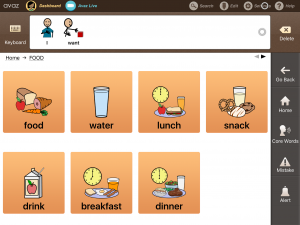 Hope the first post of this blog series gave you some ideas on how to start modeling with AAC and Avaz. With this series, we are attempting to provide some reference points for you to run with, and make it your own. Or perhaps, some of the points discussed would spark an entirely new idea – which we would love to hear about! In the present blog post, we will be discussing some tried and tested communication tips sourced from parents and therapists. As with the last post, these are in response to questions asked by first-time users of AAC apps. Please note, for this post, we have clubbed together two questions addressing similar themes. Q2: How to encourage communication? To encourage communication – I have put together the whole sentence – “I want to blow candles” under the single picture of candle. Likewise “I want chips” under the picture of chips. I did this so that the complete sentence is spoken out by one touch. Is this OK? Q3: I have started using Avaz only recently. I created a home screen for my child with his picture with the caption “I want” and then added toilet, water, food and some of his reinforcers like mobile, TV etc. I guided him to use Avaz. When I served him spicy food, he immediately came and touched the water picture. Now, should I insist on touching the “I want” picture or just add “I want water” to make him hear the complete sentence.
Hope the first post of this blog series gave you some ideas on how to start modeling with AAC and Avaz. With this series, we are attempting to provide some reference points for you to run with, and make it your own. Or perhaps, some of the points discussed would spark an entirely new idea – which we would love to hear about! In the present blog post, we will be discussing some tried and tested communication tips sourced from parents and therapists. As with the last post, these are in response to questions asked by first-time users of AAC apps. Please note, for this post, we have clubbed together two questions addressing similar themes. Q2: How to encourage communication? To encourage communication – I have put together the whole sentence – “I want to blow candles” under the single picture of candle. Likewise “I want chips” under the picture of chips. I did this so that the complete sentence is spoken out by one touch. Is this OK? Q3: I have started using Avaz only recently. I created a home screen for my child with his picture with the caption “I want” and then added toilet, water, food and some of his reinforcers like mobile, TV etc. I guided him to use Avaz. When I served him spicy food, he immediately came and touched the water picture. Now, should I insist on touching the “I want” picture or just add “I want water” to make him hear the complete sentence.Ideas from the Avaz Community
- Adding the entire sentence under a single picture could restrict communication to only the pre-programmed sentences, thus inhibiting spontaneous communication. What if the child wanted to say something else about the chips or the candles, and not actually want them? For example, what if you or the child wanted to talk about how yummy the chips were? We will not be able to do that if the whole sentence/request was embedded in one icon that says “I want chips”. So, it would be best to separate the words and model different ways to use those words.
- Furthermore, the child taps an icon and it pops up, the child sees the icon of a candle but hears the sentence “I want to blow the candle”. This could lead to confusion about what they hear and what they see. Instead, if the words candle or chips are learned and used independently, this problem may not arise.
- As the child starts using Avaz or any AAC tool, they will eventually attempt to say the words they hear. When that happens, it will be difficult for them to say an entire sentence to start with and might discourage them from trying. Instead, making a start with different individual words would motivate them to try speaking out loud.
Hope these ideas are helpful! Do you know of any other simple and effective methods to encourage communication? Please do share your thoughts on all of this and more, in the comments section! We sincerely thank each parent, teacher and SLP who contributed with their valuable suggestions. Our special gratitude to Simona Korkmaz, Gita Arvind, Gemma White, and Priya!
Here are the Answers that You were Looking for!
Q1: Each time my child wants something, they take me to the place where it’s kept. Be it sweets or toys. How should I encourage them to use Avaz at that time? It doesn’t occur to them to always to use the device. Ideas from the Avaz Community
- I would make it a habit to model on AVAZ as much as possible. Especially the items my child wants or uses regularly, like food or toys. When they pull me to the item they want, I would open Avaz, and ask them what they wanted. I would encourage them to answer by using AVAZ. If they do not know how to use it, you can model the answer with them in a hand-over-hand manner. For this, I would also try and keep the device at an easy reach always.
- Say, for instance, your child grabs your hand and takes you to the cookie. You will then have to pick up the device and draw their attention to it. Then proceed to press the words, “I” “want” and “cookie” while speaking the words, “I want cookie”. Over time and with repetition, they will realize that AVAZ is the way to make themselves understood. And when they get here, they will use it!
- You can choose their 5 most favorite items. Model asking for these items. With time and progress, make sure that they get these items only when they communicate through the device.
Avaz – AAC Awareness Month Discount Extended
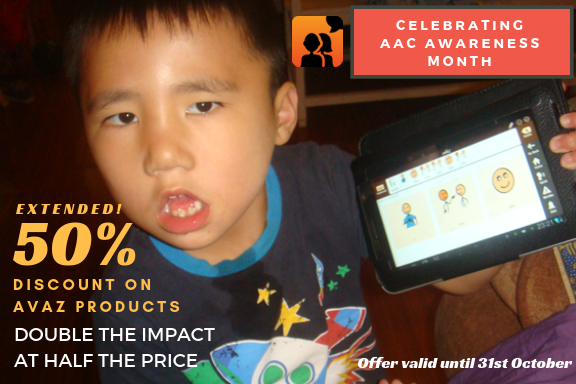 Celebrate this October with:
Celebrate this October with:- 50% off on all individual app purchases (and in-app purchases)
- Additional 50% off on purchases of 20 copies or more through Apple’s Volume Purchase Program
- Valid until October 31st!
Queries? Our Support team is here to assist. You can get in touch with us 24×7 at support@avazapp.com Watch this space for more exciting news and offers.
Observing International Week of the Deaf 2018
Can you help us answer these questions from parents?
Community ties, sharing and learning has always been an important part of how caregivers are able to better support children with disabilities. While being a great source of strength, communities also build knowledge that is grounded on experience and context. The beauty of such knowledge is that it is dynamic and keeps growing as more people add to it. This is the kind of knowledge that is deeply relatable for many on a personal level. And easy to adopt, given that they have been tried and tested!
A couple of weeks ago, parents organized a Q&A session on an Avaz messaging group in India. Parents posted questions about communication and getting started with AAC. Some of these questions were answered by a few of the more experienced parents on the group. As the process went on, we realized that this Q&A is relevant for parents, therapists and teachers worldwide. And we would love for this knowledge to keep growing. We are posting some of those questions here and inviting you to weigh in with answers based on your experience and expertise. Do chime in with your thoughts and answers on the queries that follow, in the comments section below.
Q1: Each time my son wants something he takes me to the place where it’s kept. Be it sweets or toys. How should I encourage him to use Avaz – at that time? It doesn’t occur to him always to use the device.
Q2: How to encourage communication? To encourage communication – I have put together the whole sentence – “I want to blow candles” under the single picture of candle. Likewise “I want chips” under the picture of chips. I did this so that the complete sentence is spoken out by one touch. Is this OK?
Q3: I have started using Avaz since few days only. I created a home screen for my child with his picture with the caption “I want” and then added toilet, water, food and some of his reinforcers like mobile,TV etc. I guided him to use Avaz. When I served him spicy food, he immediately came and touched the water picture. Now, should I insist on touching the “I want” picture or just myself add “I want water” to make him hear the complete sentence.
Thanks for stopping by! We do hope you will take some time to share your thoughts and answers on the queries above, in the comments section below.
Avaz trainings around the world!
We have been conducting multiple Avaz trainings around the world over the last one month! This has been possible thanks mainly to enthusiastic parents and partners, who are going the extra mile to help us spread the word.
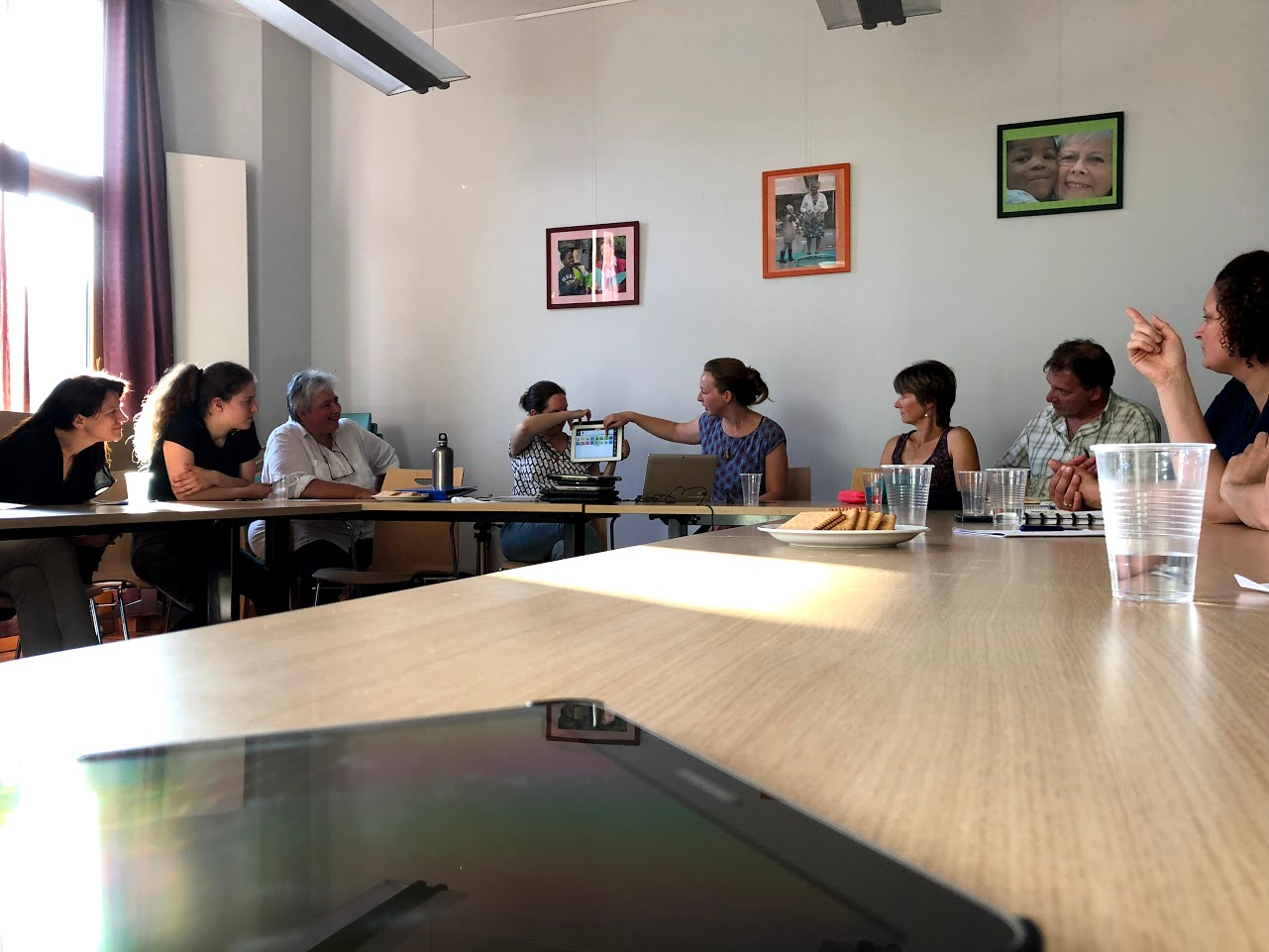
“Learn about Avaz” was conducted by Lalitha, who leads the Customer Success team at Avaz at Redwood City, California. The session included how to set it up, customize it for the child’s needs, the latest features of Avaz
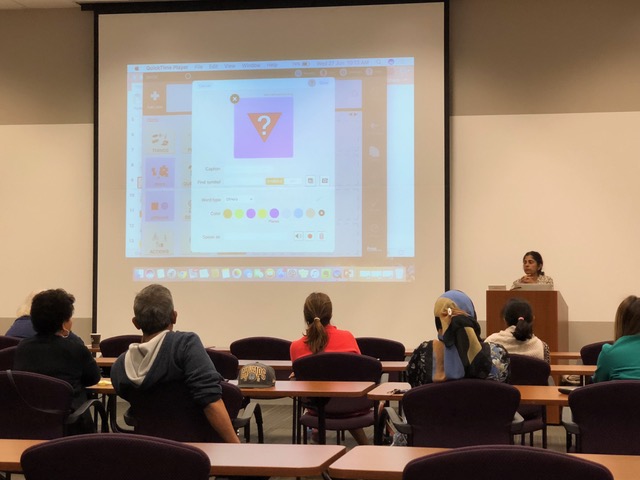 “Introduction to AAC and Avaz” was conducted by Narayan, who heads the Product Development at Avaz, at Noida, India. The session included introduction to AAC, busting myths around AAC and features of Avaz. “Let’s Communicate: AAC through High-Tech devices”, organized by the Sri Lankan Association of Speech & Language Pathologists (SLASLP) in Colombo, Sri Lanka. The session covered the features of Avaz (amongst other AAC apps) and also had a hands-on session for the participants.
“Introduction to AAC and Avaz” was conducted by Narayan, who heads the Product Development at Avaz, at Noida, India. The session included introduction to AAC, busting myths around AAC and features of Avaz. “Let’s Communicate: AAC through High-Tech devices”, organized by the Sri Lankan Association of Speech & Language Pathologists (SLASLP) in Colombo, Sri Lanka. The session covered the features of Avaz (amongst other AAC apps) and also had a hands-on session for the participants. Advaith – The Young Entrepreneur who uses Avaz
We are very excited to share today’s post, which is written by Smrithy Rajesh, a special educator and mother of 10-year old Advaith’s (Addu). Advaith is diagnosed with Autism, Sensory Processing Disorder and ADHD.
Smrithy is a superb mentor and guide for parents who are just starting to use AAC. She has a YouTube channel – where she shares learning and communication strategies and you can read her blog here.Advaith is 10 years old now. I am not worrying about his speech because of his excellent communication skills. He has apraxia and so making sounds is hard for him and words are not clear. For building communication skills we started with sign language then PECS and Avaz. Now he is communicating independently using Avaz for all his needs, expressing feelings, dislikes, preferences, sensory overload, asking for medicines if he has any discomfort, asking for steam if his nose is blocked, ordering food in the restaurant, connected with family and friends and so on. He is using Avaz in all places and in different situations. That is his communication device. That really helped him to reduce his anxiety issues. In the video below you can see, how he is connected with his customers. He is sending messages to them using Avaz. You can see his confidence level and comfort level. Communication is happening everywhere. Use each situation to build communication skills. Start with their need based communication. It really changed our life!! Of course he is able to use words for communicating. AAC stimulates meaningful speech! See Advaith communicating with his customers in this video below.
A proud entrepreneur, Addu sending thanks to his customers using Avaz. For most of his customers he used to send items by speed post. After that they send pictures and messages to him. Then I show him those pictures and explain to him. After that he sends messages to them using Avaz. He is fully connected in all steps and is able to understand. You can see, how happy he is!! We made this video by using his videos and some of his customers’ pictures.Most of the pictures got deleted, but we are thankful to all. Through this his communication skills are also improving and he is connected with more people.
[Infographic] – Strategies for Shared Reading with your child
What are some of the activities that we can do with our child using Avaz?
This is one of the frequently asked questions from parents that we meet. And our favourite suggestion is reading a story along with the AAC system that the child enjoys! Using a simple strategy called RAAP – Read, Ask, Answer and Prompt, parents can really work on the child’s communication skills too. Leave us a comment below if you have a different strategy (or activity) that you would love to share with parents! (The inspiration for the infographic is this blog post from PrAACtical AAC. ) Download the high resolution version by clicking here.
Download the high resolution version by clicking here.How do you see the world through their eyes?

Meera works as a theatre worker and teacher with Theatre Nisha
Meera Sitaraman has a Bachelors in Sociology and a double Masters in Sociology and Medical Anthropology. She works as a theatre worker and teacher with Theatre Nisha. She has been working with children for the past 5 years.
Chitra and Tarun’s journey with Avaz!
Today’s guest post is from Chitra Paul, a parent who uses Avaz with her son.
I am Chitra Paul, Tarun’s mother and we are based in Bangalore, India. I am a clinical microbiologist by training and have worked for a few years before my son came into our lives. My career break became permanent when my son was diagnosed to be on the autism spectrum way back in 2008. Since then it has been a different learning path that I have been on. This led me to do my MA in Special Education and Inclusion from the University of Northampton, UK. My journey has made me into a proponent for inclusion for persons on the autism spectrum and I try not to miss any opportunity to advocate for them.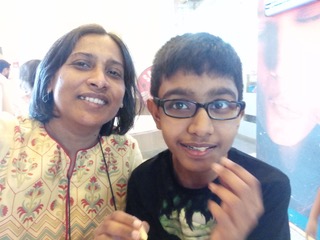 Currently, I also run a couple of support groups for parents via social media. I also provide support to parents on an individual basis in connection with parenting advice, education, intervention or just being a friend to talk to, all within the context of autism. (My email – chitraepaul at gmail dot com) My son, Tarun, is a 12 year old boy diagnosed with autism. He is currently studying in Grade 6 of a mainstream school in Bangalore, India. He is a loving child who enjoys going to school. He has a few friends in school and enjoys being with his classmates. He loves reading and listening to music. He is learning the keyboard and can sing a little too. His favourite hobby is watching advertisements and songs on YouTube.
Currently, I also run a couple of support groups for parents via social media. I also provide support to parents on an individual basis in connection with parenting advice, education, intervention or just being a friend to talk to, all within the context of autism. (My email – chitraepaul at gmail dot com) My son, Tarun, is a 12 year old boy diagnosed with autism. He is currently studying in Grade 6 of a mainstream school in Bangalore, India. He is a loving child who enjoys going to school. He has a few friends in school and enjoys being with his classmates. He loves reading and listening to music. He is learning the keyboard and can sing a little too. His favourite hobby is watching advertisements and songs on YouTube.Being a parent to a boy with autism, I was constantly made aware about the importance of speech when my son was just diagnosed. However, what struck me as I read up more and more into this puzzle called autism was that many people were confusing speech for communication which was indeed the bigger challenge for these children. As my own son was non-verbal I too was constantly looking out for alternate options for him to communicate with. It was at this point that I happened to hear a talk by Mr. Ajit Narayanan at the Autism Conference at NIMHANS in 2011. Avaz impressed my husband and me at that time itself. However, it was a device and the cost factor put us off. But I continued to follow up closely how Avaz was being taken forward. Additionally, as my son was just learning language I put off introducing PECS or any other AAC. Turning point However, things changed around when he was 7-8 when his special educator working on her personal belief discovered that he could write extremely well in perfectly good English with grammar and vocabulary intact. However, he needed some support to his hand when writing. At this point we realised that we need to provide him with a means to communicate and of course the first place I turned to was Avaz. By then Avaz had been modified to an iPad application and we purchased it as the prices were also well within our reach. This is how our journey with Avaz started.
Tarun’s Avaz personalized for his needs
Making Avaz work to Tarun’s strengths However, as my son showed a greater inclination towards words and letters and not pictures, I realised I need to use only text when preparing the cards. That’s how we went about it. As my son had already shown that he was way ahead in using language and was already typing full sentences although nobody had taught him sentence formation etc., we started using the keyboard option at the beginning itself. Another factor was that my son also started typing which was much easier for him than writing. Because of these two factors I couldn’t make him to utilise Avaz in the usual manner as an AAC is advised to be started and used with children with autism. However, since Avaz came into his life, his communication has grown in leaps and bounds and we often have conversations using the keyboard option which can also be saved. As he takes his iPad to school for work and communication, I have also created a personalised folder of regularly used words and sentences so that he can use them if he needs to communicate for daily needs. We have also used the same technique and used personalised material on Avaz during his occupational therapy and speech therapy sessions so that Avaz is his constant support for communication. The best part of Avaz is that it is extremely simple and easy to create sets of communication cards. This was voiced to me recently by another parent, who took my suggestion and purchased Avaz to use with her daughter who is on the autism spectrum. Avaz also has other features that are very unique to the needs of users in India like the option to create and use cards in various regional languages. Another great feature that supports and helps a parent to learn and adapt to the needs of their children is their application called Communication Adventures. I have used many of the ideas and tips listed in both these applications. One of the ideas suggests using it while reading with your child. As my son loves to read, I have used this strategy many a time with great success. A glimpse of my conversations with Tarun Some of these conversations were with his special educator, Ms. Priya, whose immense support helped him to reach this stage. [metaslider id=876][metaslider id=886] Do you have a story that you would like to share with us? Leave us a comment!Autism Awareness vs Autism Acceptance
Guest blog post from Julian Laferrera.
This April, many people around the world are celebrating Autism Awareness Month. I am not one of them; I will be celebrating Autism Acceptance Month. Although these terms sound similar, they mean very different things.
 Autism Awareness Month campaigns focus on bringing public awareness to the condition. Many parents of children with autism use this time to share the challenges they encounter because of their children’s autistic traits. Additionally, there will be many companies donating portions of their proceeds to autism research and early intervention. At face value, this sounds like a wonderful opportunity to talk about autism, a condition that is often widely misrepresented in media, and impacts the lives of autistic people, their families, their schools, and people they interact with everyday. However, Autism Awareness campaigns are lacking in two ways: they ignore the prevalence of autism awareness already in the world, and they promote basic tolerance within the framework of autism as a consistent struggle or burden. Firstly, many people nowadays are aware of autism. Although stereotypes and myths abound, most people have a general idea of what autism means. Secondly, when Autism Awareness campaigns often frame autism as a disease, a burden, something that should be cured, it hurts autistic people. Many autistic people and their allies, myself included, believe that autism is a natural part of human diversity. Curing suggests that autism is inherently unfavorable, burdensome, and unwanted. I love being autistic, and it hurts to hear that some people think that my peers and I would be better off without autism. Autism still can cause issues for me and others, but perhaps not in the way you think. Many of what people see as “challenging behaviors” can actually be reframed as a difficulty in communicating with neurotypical people. Growing up autistic means that sometimes neurotypical people do baffling things, and it’s hard to figure out the reasons why. Growing up autistic can be challenging when you process the world differently than others around you do. Growing up autistic is difficult when people don’t understand your ways of expressing yourself. When I say that I support Autism Acceptance Month, I mean that I view autism as an integral part of autistic individuals and that their challenges are not an inherent flaw but rather are a reflection on the neurotypical society we live in. Given that many people are already “aware” of autism, the next step after awareness is acceptance of those differences. Unlike simple tolerance, acceptance requires effort, on everyone’s part to include autistic people in parts of society where they were previously excluded. Some autistic people don’t communicate with their mouths, or what comes out of their mouths is not connected with what they are trying to say in their heads. After recognizing communication barriers, practicing acceptance means providing and teaching alternative ways to express oneself, through AAC, sign language, typing or other ways. Acceptance looks like teaching about the rules of the neurotypical world, but not forcing autistic people to strictly adhere to them. Acceptance means working with autistic individuals to figure out what accommodations they need to thrive in a particular environment. Overall, the lives of autistic people and neurotypical people can improve when there is mutual respect and learning from one another. In the end, Autism Awareness campaigns can have a negative impact on autistic people’s self-worth through implications of being a burden, promote cures for a condition that is simply a part of diversity, and seeks tolerance as its goal. Autistic people deserve more than just awareness or tolerance. If you are ready to put in the hard work of autism acceptance, then join me in celebrating Autism Acceptance Month.
Autism Awareness Month campaigns focus on bringing public awareness to the condition. Many parents of children with autism use this time to share the challenges they encounter because of their children’s autistic traits. Additionally, there will be many companies donating portions of their proceeds to autism research and early intervention. At face value, this sounds like a wonderful opportunity to talk about autism, a condition that is often widely misrepresented in media, and impacts the lives of autistic people, their families, their schools, and people they interact with everyday. However, Autism Awareness campaigns are lacking in two ways: they ignore the prevalence of autism awareness already in the world, and they promote basic tolerance within the framework of autism as a consistent struggle or burden. Firstly, many people nowadays are aware of autism. Although stereotypes and myths abound, most people have a general idea of what autism means. Secondly, when Autism Awareness campaigns often frame autism as a disease, a burden, something that should be cured, it hurts autistic people. Many autistic people and their allies, myself included, believe that autism is a natural part of human diversity. Curing suggests that autism is inherently unfavorable, burdensome, and unwanted. I love being autistic, and it hurts to hear that some people think that my peers and I would be better off without autism. Autism still can cause issues for me and others, but perhaps not in the way you think. Many of what people see as “challenging behaviors” can actually be reframed as a difficulty in communicating with neurotypical people. Growing up autistic means that sometimes neurotypical people do baffling things, and it’s hard to figure out the reasons why. Growing up autistic can be challenging when you process the world differently than others around you do. Growing up autistic is difficult when people don’t understand your ways of expressing yourself. When I say that I support Autism Acceptance Month, I mean that I view autism as an integral part of autistic individuals and that their challenges are not an inherent flaw but rather are a reflection on the neurotypical society we live in. Given that many people are already “aware” of autism, the next step after awareness is acceptance of those differences. Unlike simple tolerance, acceptance requires effort, on everyone’s part to include autistic people in parts of society where they were previously excluded. Some autistic people don’t communicate with their mouths, or what comes out of their mouths is not connected with what they are trying to say in their heads. After recognizing communication barriers, practicing acceptance means providing and teaching alternative ways to express oneself, through AAC, sign language, typing or other ways. Acceptance looks like teaching about the rules of the neurotypical world, but not forcing autistic people to strictly adhere to them. Acceptance means working with autistic individuals to figure out what accommodations they need to thrive in a particular environment. Overall, the lives of autistic people and neurotypical people can improve when there is mutual respect and learning from one another. In the end, Autism Awareness campaigns can have a negative impact on autistic people’s self-worth through implications of being a burden, promote cures for a condition that is simply a part of diversity, and seeks tolerance as its goal. Autistic people deserve more than just awareness or tolerance. If you are ready to put in the hard work of autism acceptance, then join me in celebrating Autism Acceptance Month.Julian Laferrera is a junior at Mount Holyoke College. They are majoring in mathematics and is in the teacher licensure program for secondary math education. They are a Peer Fellow in the college’s AccessAbility Office, where they mentor and support other disabled students.
Autism myths that educators & parents want to debunk
 [This is a re-post from our archives and unfortunately some of the debunking is still work-in-progress :(]
[This is a re-post from our archives and unfortunately some of the debunking is still work-in-progress :(]Avaz AAC – Autism Acceptance Month discount
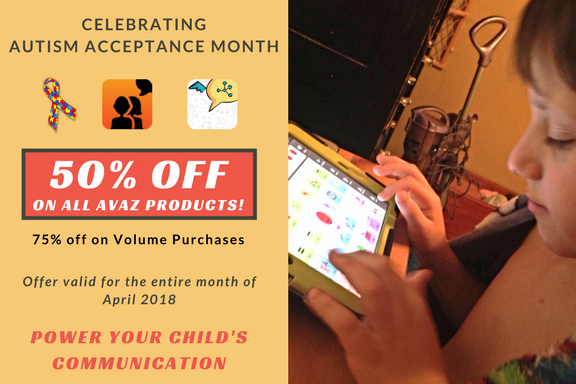
We are starting this April with:
- 50% off on all individual app purchases (and in-app purchases)
- Additional 50% off on purchases of 20 copies or more through Apple’s Volume Purchase Program
- Valid for purchases on Android as well as iPad
- Until April 30th 2018!
Here are the links to the apps Avaz FreeSpeech for Schools Avaz US (iPad), Avaz App for Communication (Android) Avaz Dansk, Avaz Français, Avaz Svenska, Avaz India (iPad), Avaz India (Android) Avaz Australia, Do spread the word and help this reach the people it can benefit!
Queries?
Our Support team is here to assist. You can get in touch with us 24×7 at support@avazapp.com Watch this space for more exciting news and offers.Edited to mention that the discount is till the end of the month.
Let’s bust some myths about AAC for people with Down Syndrome
 Further, research also shows that early exposure of children with complex communication needs (CCN) to AAC minimizes the potential for continued delay that these children face with developing language. In a 2010 study (Drager, Light and McNaughton, 2010), it was found that AAC intervention can have a positive effect on functional communication skills, challenging behaviour, language development (both receptive and expressive), and speech production. Unlike other studies that observed the effect of AAC on children between the age of 3 and 5, this paper specifically focused on understanding the effect of AAC exposure on children under the age of 3. The study recommends AAC intervention by the age of 6-9 months when a disability with the risk of communication risk is identified. That said, many caregivers still have doubts about using AAC. We looked at some of these doubts on using AAC for children with Down syndrome and asked: are they real, or are they myths? Common myths about using AAC for children with Down syndrome: 1. Fear of natural speech development being impeded The fear of AAC intervention becoming an impediment to speech is quite widespread. However, several studies (such as Millar, Light, and Schlosser) show that AAC does not cause impediment in the development of natural speech in individuals with developmental disabilities. On the contrary, children with exposure to AAC learn to use multiple modes of communication, unlike children with no exposure to AAC. 2. Fear that social skills won’t develop Another common fear with using AAC intervention is regarding the development of social skills. How will the child learn social skills using AAC? This fear too is ill-founded — AAC as a multi-pronged model of communication uses modeling, practice and feedback to teach the child different language skills as well as social skills that are required to engage with people (for example, turn taking). Multiple studies have shown this to be effective specifically for children with Down syndrome, including the study by the Janice Light & Kathyrn Drager in 2010. 3. Concern that AAC cannot help tackle challenging behaviour Sometimes, caregivers question the possibility of resolving challenging behaviours using AAC. On the contrary, though, device-based AAC systems can especially be useful in helping with handling challenging behaviour, by working on Functional Communication Training (FCT) with children. For example, caregivers may model with the child on using a specific AAC switch or symbol, to replace a challenging behaviour like hitting his head on the wall to call someone. Studies show that such methods have been effective with most children observed. 4. Concern that the child will be unable to communicate when the AAC device is unavailable With advancements in technology, electronic device based AAC systems have become the order of the day. This often makes caregivers wonder if their child will be left stranded without any means of communication when he or she does not have access to the electronic device. Will the child’s communication become device-dependent? If AAC is properly introduced, this is not a major concern. There are many different types of AAC systems, including unaided and aided systems. While unaided systems usually include signs and gestures, aided systems include picture boards, communication books and electronic devices. If a child has no access to an electronic device based AAC system, and if they have been properly trained to use multiple modes of communication, they will not be left stranded: unaided systems, or other aided systems with similar visuals as the child’s device, may be used to communicate with the child. In our experience, we have heard a lot of success stories of children with Down Syndrome using AAC. Do you have any to share? Leave us a comment! References: 1. Effects of AAC intervention on communication and language for young children with complex communication needs by Kathryn Drager, Janice Light and David McNaughton, (https://pdfs.semanticscholar.org/4fde/36329edf21ce59bf0afb2a0f7adb10ff00cf.pdf) 2. Effect of early AAC intervention for children with Down Syndrome by Janice Light and Kathryn Drager (http://aac-rerc.psu.edu/_userfiles/file/Light%20ASHA%202010%20%20AAC%20and%20children%20with%20Down%20Syndrome.pdf) 3. Millar, D. C., Light, J. C., & Schlosser, R. W. (2006). The impact of augmentative and alternative communication intervention on the speech production of individuals with developmental disabilities (Journal of Speech, Language, and Hearing Research, 49, 248-264.)
Further, research also shows that early exposure of children with complex communication needs (CCN) to AAC minimizes the potential for continued delay that these children face with developing language. In a 2010 study (Drager, Light and McNaughton, 2010), it was found that AAC intervention can have a positive effect on functional communication skills, challenging behaviour, language development (both receptive and expressive), and speech production. Unlike other studies that observed the effect of AAC on children between the age of 3 and 5, this paper specifically focused on understanding the effect of AAC exposure on children under the age of 3. The study recommends AAC intervention by the age of 6-9 months when a disability with the risk of communication risk is identified. That said, many caregivers still have doubts about using AAC. We looked at some of these doubts on using AAC for children with Down syndrome and asked: are they real, or are they myths? Common myths about using AAC for children with Down syndrome: 1. Fear of natural speech development being impeded The fear of AAC intervention becoming an impediment to speech is quite widespread. However, several studies (such as Millar, Light, and Schlosser) show that AAC does not cause impediment in the development of natural speech in individuals with developmental disabilities. On the contrary, children with exposure to AAC learn to use multiple modes of communication, unlike children with no exposure to AAC. 2. Fear that social skills won’t develop Another common fear with using AAC intervention is regarding the development of social skills. How will the child learn social skills using AAC? This fear too is ill-founded — AAC as a multi-pronged model of communication uses modeling, practice and feedback to teach the child different language skills as well as social skills that are required to engage with people (for example, turn taking). Multiple studies have shown this to be effective specifically for children with Down syndrome, including the study by the Janice Light & Kathyrn Drager in 2010. 3. Concern that AAC cannot help tackle challenging behaviour Sometimes, caregivers question the possibility of resolving challenging behaviours using AAC. On the contrary, though, device-based AAC systems can especially be useful in helping with handling challenging behaviour, by working on Functional Communication Training (FCT) with children. For example, caregivers may model with the child on using a specific AAC switch or symbol, to replace a challenging behaviour like hitting his head on the wall to call someone. Studies show that such methods have been effective with most children observed. 4. Concern that the child will be unable to communicate when the AAC device is unavailable With advancements in technology, electronic device based AAC systems have become the order of the day. This often makes caregivers wonder if their child will be left stranded without any means of communication when he or she does not have access to the electronic device. Will the child’s communication become device-dependent? If AAC is properly introduced, this is not a major concern. There are many different types of AAC systems, including unaided and aided systems. While unaided systems usually include signs and gestures, aided systems include picture boards, communication books and electronic devices. If a child has no access to an electronic device based AAC system, and if they have been properly trained to use multiple modes of communication, they will not be left stranded: unaided systems, or other aided systems with similar visuals as the child’s device, may be used to communicate with the child. In our experience, we have heard a lot of success stories of children with Down Syndrome using AAC. Do you have any to share? Leave us a comment! References: 1. Effects of AAC intervention on communication and language for young children with complex communication needs by Kathryn Drager, Janice Light and David McNaughton, (https://pdfs.semanticscholar.org/4fde/36329edf21ce59bf0afb2a0f7adb10ff00cf.pdf) 2. Effect of early AAC intervention for children with Down Syndrome by Janice Light and Kathryn Drager (http://aac-rerc.psu.edu/_userfiles/file/Light%20ASHA%202010%20%20AAC%20and%20children%20with%20Down%20Syndrome.pdf) 3. Millar, D. C., Light, J. C., & Schlosser, R. W. (2006). The impact of augmentative and alternative communication intervention on the speech production of individuals with developmental disabilities (Journal of Speech, Language, and Hearing Research, 49, 248-264.)Useful Communication Tips: From a Parent to a Parent
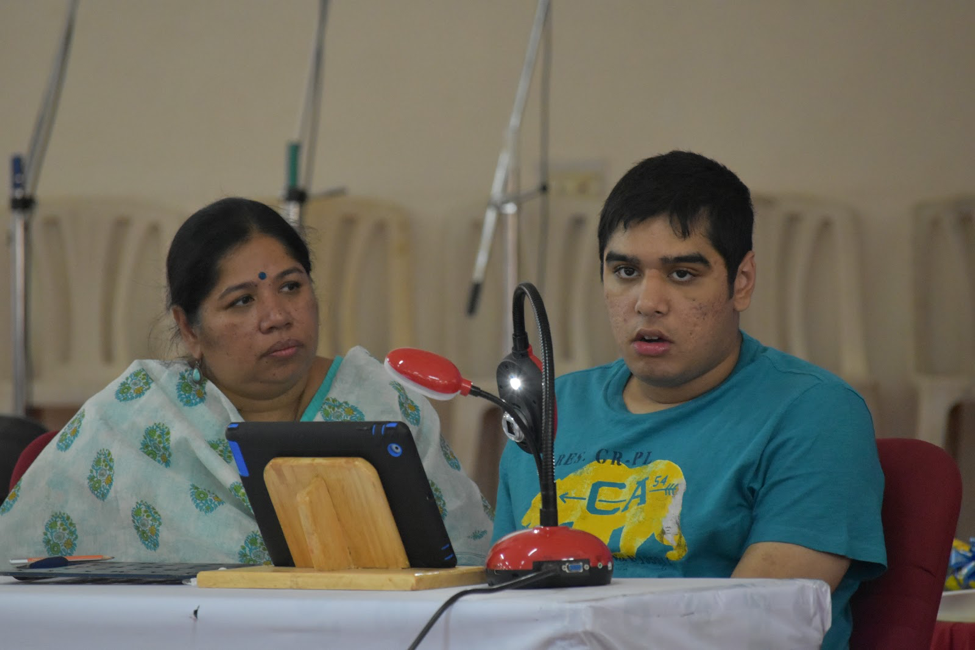 Akila is the parent of Nishant, a 22-year-old with Autism and Apraxia of speech, who is an intern with AMAZE. She was working in the software industry, before Nishant received his diagnosis, after which, she trained herself with a host of courses, to understand autism better. She did DSE Autism, MSc Applied Psychology and multiple international certificate courses like RPM, PECS, AT Tools, FIE and Applied Drama. With a passion for technology, she is always looking for innovative methods and solutions, that help persons with disabilities, improve their quality of life. She uses her vast experience to create awareness about Autism through various forums and media.
Akila is the parent of Nishant, a 22-year-old with Autism and Apraxia of speech, who is an intern with AMAZE. She was working in the software industry, before Nishant received his diagnosis, after which, she trained herself with a host of courses, to understand autism better. She did DSE Autism, MSc Applied Psychology and multiple international certificate courses like RPM, PECS, AT Tools, FIE and Applied Drama. With a passion for technology, she is always looking for innovative methods and solutions, that help persons with disabilities, improve their quality of life. She uses her vast experience to create awareness about Autism through various forums and media.Tip 1: Let go of Denial and Blame Usually, there’s almost an expectation from the parent, that the child will be something like the parent, especially when the child does something positive. It is typical of a family to look at it as the gene pool being passed on. When a child has special needs, the family sees it as, “It can’t be. My gene pool cannot have a defect”. Often, there is denial and even blame, blaming each other or each other’s families. Often mothers feel they are responsible. Instead, they could begin by looking into the child’s strength, abilities, needs, and challenges. Tip 2: All of us are Unique and Different This leads to Akila’s second tip to parents! Your children are not your children. They are the sons and daughters of Life’s longing for itself. They come through you but not from you, And though they are with you yet they belong not to you.
– Kahlil Gibran
Quoting Kahlil Gibran, she highlights the need to look at your child with their own purpose because each of us is unique and different. Letting your child be their own person is the best gift you can give your child. Tip 3: Explore and Express! Children with special needs probably learn using different learning methods, compared to how we learn. Hence they communicate in a way that is different from how we do. As simple and easy as it sounds, this is a whole new paradigm shift for a parent, and one that is needed! With this acceptance, the parent will allow the child to express themselves in their own ways. Tip 4: Multiple Modes of Communication Expose your child and allow them to respond to multiple modes of communication. These could include gestures, picture charts etc., which makes them less anxious to attempt speech. This might make them more willing to repeat words, which might have been more stressful earlier, because of the lack of acceptance. The child should feel accepted, even when they don’t use words to communicate. Tip 5: Create Opportunities for Communication Create opportunities for communication throughout the day. Don’t pre-empt or make it too easy for them to access everything in a way that requires no communication. Do it even if it means that you sabotage the environment, like hiding something or viewing things in smaller installments. If your child likes chocolates, give it in smaller installments rather than the whole thing, at one go. This will make them ask for more. Tip 6: Get your Hands Dirty! Get on the floor and play with your child! This is going to help them understand another aspect of their life – Social Aspect. When the child watches someone else play a game, they learn to understand visually and anticipate something. It is a change in pattern. Though hard to explain, your child’s interpersonal skills start developing when you play informally with your child, through games or even silly interactions. Tip 7: Be Interactive Be interactive with your child to build reciprocity. Reciprocity between two people lays the foundation for social interaction. This lets the child understand that there is one more person in the room that they are interacting with. Once the child starts interacting, you can then expand on it. Tip 8: Focus on their Strength Your child may be processing one of their senses, more dominantly than the others. They may be using or focusing on the visual, more than the auditory or tactile senses or vice versa. How do we find this out? A child may stim with visual movements (visual channel) or hum all the time (auditory channel) seeking information. So observe the child’s sensory pattern. Give inputs appropriate to their sensory pattern. Don’t block it (like humming or tapping) as inappropriate behaviour. You could use this drama-based technique for a child who is tactile. Take some cream and put it on your child’s face, and as you start doing a facial for your child, you can start talking to your child. You will have their attention because the tactile channel is open. The parents may not be experts in these techniques, but the parent usually knows their child’s pattern. Leverage it to enter their world!Do you have tips that you would like to share with other parents? Let us know in the comments section below!
How theatre helps children with special needs express themselves

V. Balakrishnan is an alumni of the National School of Drama (New Delhi), and is the Founder and Artistic Director of Theatre Nisha (Chennai), which has staged over 100 plays in the past 17 years. He has been using theatre as a tool to improve communication and combat learning disabilities for the past 16 years. He has directed over 200 plays, acted in over 150 plays and written 10 scripts. He was recently awarded the Fulbright Distinguished Award in Teaching 2017, completed his inquiry project on Theatre Necessities and Application: Role Play for Liberation from Indiana University.
Avaz: What is expected of you when you teach theatre to children with special needs? What kind of curriculum is used and what sort of engagement happens? V. Balakrishnan: With special children, my work so far, has not been dictated by a curriculum given by the school. The curriculum has mostly been the one which I have developed. I do not follow a set lesson plan because each day is very different. We have to improvise quite a bit on the original plan. Broadly, we do have bifurcations of what we will work on; physicality, voice, reading and acting but what we end up doing changes everyday depending on how the children respond. We work outdoors with the children in these schools. There are particular days when the children may be slightly more hyperactive or it may be too hot. In such cases, we look at what best needs to be done, than stick to a curriculum. Simply put, the curriculum is about making sure that the children are able to intuitively, impulsively and instinctively use their imagination and respond. The final line in any training for actors is to be able to respond honestly and this forms the basic title of our curriculum. What goes into forming this curriculum is something that changes with each school. Avaz: What is your approach to building your own curriculum for these schools? V. Balakrishnan: The broad guidelines are the same but the thought process is more or less developed only after meeting the children. We tailor-make the curriculum according to their needs. When we see children who have some difficulty with motor skills, we try to use a little more of silambam or martial arts. For children with a speech problem or shyness or some kind of complex, we use a lot of storytelling, voice exercises and speech exercises. With some children, we just play games. We just keep playing games till we reach a stage where we can start introducing drama theories and allow the children to understand the responsibilities of acting. Avaz: What are some of the necessary building blocks (like motor skills) to be included in a theatre curriculum for children with special needs? V. Balakrishnan: We make sure both the vocal and physical aspects are completely touched upon. We use movement, rhythm and tempo, speech exercise, introduction to acting concepts and making them explore small scenes using their imagination. Within these aspects, what gets stressed upon a little more than the rest, depends upon the group of children we are working with. Sometimes we understand that there is a speech therapist at work with the child. Then speech intervention is not required from us. We then work more on the motor skills. We work more on something like silambam, an Indian martial art form. Silambam has had some remarkable results with children. It has really helped them because moving the fighting stick from left to right is quite a brain-challenging thing to do. It’s not easy and we have seen some really good results in children who started doing silambam. We have also seen some wonderful results in children who do storytelling, group exercises and probes that we do. It makes them understand social responsibility and work with group dynamics and leadership. Avaz: What is the outcome that schools hope for, by engaging the students with theatre? V. Balakrishnan: Quite frankly special schools do not have drama in their curriculum. It is a regular class, it is marked down as a period in the timetable but they don’t have to write an examination on it. All they have to do is to put up a performance at the end of the day. Although the objective is out there in the open, when the children come to us for the class, it is that we are getting ready for a performance. But what we are working on is trying to understand and identify children who have a problem with expressing themselves or with possibly understanding tempo and rhythm or with reading and so on. So we (the team) divide to figure out the challenge that the child faces and particularly like to work on those aspects. The final performance only becomes a huge excuse (may be) in order to be able to follow these interventions in order to finally make the child confident and believe in themselves. Avaz: Often caregivers find it difficult to understand the child when he/she faces a certain challenge. What can caregivers do to better understand them? V. Balakrishnan: Children always express themselves. When we are talking about learning disabilities, I don’t think that these children per se have any problems vis-a-vis children from “regular schools”. Learning disability is only the disability of our cerebral process to be able to indulge in one particular function with a block. So the child is not able to read or write or draw or do math. But this is something that occurs to every child, even you and I would have one aspect or more than one aspect where we totally suck. I might be tone deaf, but recognising tonality is not a requirement of social order. Hence it is not recognised as a learning disability whereas reading, writing and math is. Apart from that, it is not a disability. It is just one aspect and we are trying hard to make them do it. It is quite possible that a person can live happily without having to write or read but unfortunately it has become a norm in our social order. The only way we can survive is to be able to read, write and calculate. When it comes to children with autism and asperger syndrome, they do express themselves very brilliantly and clearly. Unfortunately, we are not able to read it because we are always trying to make them conform to responding in a way that we think is correct. We are trying to teach them how to smile, laugh, show anger and distaste, while they have their own way of doing it. I think what we really need is some kind of space where these children can be free in their environment and not be taught to conform to a way of living, trying to make them be like us. I think it’s more important to be the way they are but that requires so much of compassion on the part of the entire world and I don’t know if that’s possible.What do you think of theatre as a form of communication? Leave us a comment!
World Through Their Eyes
There seems to be an inherent stress to view the world in a fixed way. This exerts excessive pressure on people with special needs to respond to the world only in ways that others are familiar with, than through modes of expression that they are comfortable with.
There is a growing need to change this to make the world more inclusive. With that in mind, Avaz has launched – World Through Their Eyes, an initiative to create awareness about viewing the world through the eyes of persons with special needs.
We will bring to you different and unique perspectives of persons with special needs and trendsetters in this space, as interviews, ready-to-use strategies, infographics, research and much more over the course of the next few weeks.
Join hands with us in sharing this initiative and spreading more awareness about looking at the World Through Their Eyes!
If you would like to be a part of this initiative, let us know in the comments below so that we can get in touch with you.
Why pictures work better than words for children with special needs?
 Hope you find it useful and share it with others who might find it useful. Leave us a comment below if you would like to be a part of this initiative.
Hope you find it useful and share it with others who might find it useful. Leave us a comment below if you would like to be a part of this initiative.How to use Expansion and Extension strategies for building language
Download a free Activity Bundle for Expansion here
There are two things at play here.- By repeating and expanding the child’s language, you are staying within the realms of responding without directly “correcting” him/her.
- By repeating- you’ve acknowledged that the child successfully conveyed something to you and will be motivated. Step it up very gradually i.e. expand using more words, bend words (Ex: go- went) as you go along. And keep modelling!
 Extensions: To extend a child’s utterance, we simply respond to the child’s utterance in a conversational way, providing a little more new information, that is related to what the child has to say. These are similar to expansions, but in this case, you not only expand the child’s language, but also add some additional information as an extension. For example:
Extensions: To extend a child’s utterance, we simply respond to the child’s utterance in a conversational way, providing a little more new information, that is related to what the child has to say. These are similar to expansions, but in this case, you not only expand the child’s language, but also add some additional information as an extension. For example:- If the child says “Dog run!” you could say, “Yes, the dog is running. He is running fast.”
- If the child says “Red block.” You could say, “Yes, you have a red block. The red block is shaped like a triangle!”
- Another example, if the child were to say “yellow doggy” you could say, “Yes you see a yellow doggie! The yellow doggie is big and fluffy.”
 Expansion and extension seem to work best with children who are using words/phrases or small sentences to communicate. You might not want to use these strategies with every word the child communicates. The hardest part about these strategies is that they require the communication partner to wait and respond to a child’s language instead of directing it. Another thing to keep in mind is to respond to the communicator’s intent i.e. replying to their question or request – and not in a manner of commenting such that the conversation does not go any further. Are there any favorite ideas that you use for expansion and extension? Share it with our readers – by adding them in the comments! Sources: http://www.playingwithwords365.com/strategies-to-help-your-child-talk-using-expansions-and-extensions/ http://www.talkingkids.org/2013/03/using-expansion-and-extension-to-grow.html PrAACtical AAC’s blog on Expansion
Expansion and extension seem to work best with children who are using words/phrases or small sentences to communicate. You might not want to use these strategies with every word the child communicates. The hardest part about these strategies is that they require the communication partner to wait and respond to a child’s language instead of directing it. Another thing to keep in mind is to respond to the communicator’s intent i.e. replying to their question or request – and not in a manner of commenting such that the conversation does not go any further. Are there any favorite ideas that you use for expansion and extension? Share it with our readers – by adding them in the comments! Sources: http://www.playingwithwords365.com/strategies-to-help-your-child-talk-using-expansions-and-extensions/ http://www.talkingkids.org/2013/03/using-expansion-and-extension-to-grow.html PrAACtical AAC’s blog on Expansion 3 Tips to celebrate a gratifying Valentine’s Day with your AAC family
“My wife had a severe stroke a few years ago and her Speech Therapist downloaded your APP together with other similar apps, to provide steps in her rehab to improve her speech and communication. After a period of 6-9 months she made sufficient progress and improved beyond the need for any of the APPS. Currently my wife is still having speech therapy; her communication skills are much improved. There was a time when it seemed that it may be necessary to rely and subscribe to each of the Apps. “Fortunately” this was not required. I have to recommend you and your team in making such a product available; the positivity that this gave my wife is immeasurable and has helped in her rehabilitation. (It) helped tremendously in recognizing words and sentences and the structure. At times my wife used the App to either ask a question or respond if she was unable to remember how to say a word or sentence.” – S.MThank you! Your positive words are immeasurable to us. Thank you for trusting us to be a part of your wife’s recovery. Wishing you and your wife a happy Valentine’s Day and sending you both our love! – Team Avaz
“My daughter is a 11 yr old child with Down Syndrome, PDD and is nonverbal. We have always had to deal with the frustrations of her not being able to communicate her needs/wants. As frustrating as it was for us as parents, it was ten times more frustrating for her. We were reluctant to purchase the app because she had an Augmentative communication device when she was younger and neither she nor I found it to be “user friendly”. I did a lot of research on both Avaz and a competitor and found tons of positive reviews on both. I did come across many people who said that Avaz was just as good as the costly competitor and since I had reservations I went with the least expensive. This ultimately has been a decision that is worth it’s “weight in gold”. My daughter has nearly mastered the navigation, so much so that one day she brought it to me to show me she wanted Taco Bell for lunch. This made me cry. My child had a voice for the first time. Thank you for being the one to give my daughter that “voice” – A.KThank you for trusting us to give your daughter that voice. Your trust means the world to us. Thank you for all the love and this absolutely heartfelt message. Thank you for making our Valentine’s Day so special! – Team Avaz Tip 3: Share and spread the love with others you love We felt absolutely overwhelmed and grounded receiving kind words from our users. That said, our experience wouldn’t be complete without sharing these endearing words, with those close to us, and you are one among them too! You should also know that you are absolutely awesome with who you are and what you do. Thank you for continuing to be a constant part of our lives and making our Valentine’s Day special. That was our Valentine’s Day! What about yours? We want to know all about it too! Leave us a comment! We are waiting!
Understanding different aspects of pragmatics for effective communication
 Communication changes with social settings or context. Let’s take two examples. While talking to a child, our voice mellows, we speak slower and we use a different set of words to convey the same meaning. Similarly, if a person that we are talking to constantly looks away or responds in monosyllables, we decide that the person is bored and change the topic of the conversation. Now, what gave that away? Who taught us to do that? In both of these examples above, there is a certain sense of the social setting, age/mental maturity and physical response. This insight of the social setting in which communication happens is called pragmatics. Acquiring pragmatic skills is difficult for both- a typically growing child and a non-typical child, while they differ at the intensity and speed of acquisition.
Communication changes with social settings or context. Let’s take two examples. While talking to a child, our voice mellows, we speak slower and we use a different set of words to convey the same meaning. Similarly, if a person that we are talking to constantly looks away or responds in monosyllables, we decide that the person is bored and change the topic of the conversation. Now, what gave that away? Who taught us to do that? In both of these examples above, there is a certain sense of the social setting, age/mental maturity and physical response. This insight of the social setting in which communication happens is called pragmatics. Acquiring pragmatic skills is difficult for both- a typically growing child and a non-typical child, while they differ at the intensity and speed of acquisition.Learn more about communicative purposes and download free resources here.
Pragmatics that governs our day-to-day communication includes three different aspects namely: Using language to convey different types of messages:- Greeting– Hi, Have a nice day, goodbye etc.
- Requesting information– What is that? Where are you going?
- Requesting for an action – Can you give me a cookie? I want a cookie.
- Refusing/protesting – Stop the music. Don’t touch my toy. I don’t want to eat.
- Promising – I am going to play your favorite song.
- Informing– I am making a sandwich. We are going to paint this wall.
 Changing language according to the needs of a listener or situation:
Changing language according to the needs of a listener or situation:- Presenting information (background details, facts) to an unfamiliar listener: Hi, my name is Randy. I’m here to meet Sue.
- Presenting information (background details, facts) to an familiar listener: Hi Sue, I read the storybook you gifted me. I loved it.
- Speaking differently depending on the listener: a small boy speaking to a friend of his age vs an adult- “Joe, give me a cookie, please.” vs “Mrs. Stevenson, could you please give me a cookie?”
- Speaking differently depending on the location: speaking differently in a classroom than on a playground. “Hey Greg, could you please pass me a copy of the worksheet.” vs “Greg! Pass the ball.”
 Following rules for conversations:
Following rules for conversations:- Introducing topics of conversation: “Yesterday I went to the movies with my sister…”
- Staying on topic: “Oh, you drew a horse? I drew a dog!”
- Rephrasing when misunderstood: “The time is quarter to five. I mean four forty-five.”
- Using verbal and nonverbal signals: Nodding to agree, pointing the index finger to identify etc
- How close to stand to someone when speaking: Explaining physical space, appropriate touch etc.
The 5 Domains of Language
It seemed like 2017 only yesterday. It is February already! We wanted to welcome this month of love by sharing with you something essential to the expression of love – the different components of language. After all, most often, it is language that aids us in the expression of love.
So we have put together an infographic explaining the different components of language – Pragmatics, Semantics, Syntax, Morphology & Phonology, integrated as a whole.
What do you think of this representation? Did we miss something? Leave us a comment below.
How to make Thanksgiving memorable this year for your child
 Thanksgiving could be overwhelming, in many ways for a lot of us – hosting, planning food! But let’s make this holiday an enjoyable one for the child. Let’s break it down and look at ways to tackle each part to ensure that the child has a good time, without distress or being overwhelmed. Changes in the surroundings:
Thanksgiving could be overwhelming, in many ways for a lot of us – hosting, planning food! But let’s make this holiday an enjoyable one for the child. Let’s break it down and look at ways to tackle each part to ensure that the child has a good time, without distress or being overwhelmed. Changes in the surroundings:- Venue– if you are hosting, give the child time to take in this new temporary re-arrangement and do this a few days ahead. Create a designated “my spot” for the child, with their toys and comfort items. If you are going to a different place, get the child accustomed to it, by showing pictures and talking about the place.
- Clothes– stick to a familiar and comfortable outfit for you and the child. If you want to try new holiday wear- get the kid to wear it a few times before, make sure it is familiar and comfortable.
- The holiday itinerary- Even though this is a holiday, try and stick to the usual routine as much as possible- like play time, meal time, nap time. Do the 2 o’clock dinner too, but as an add-on to the usual routine.
- Setting expectations and the holiday mood – Have some fun story sessions of how you are going to spend the day, using visual aids – e.g. car activities on the drive to the venue, whom you are going to meet, what you are going to eat, the parade on the television etc.
- Faces– Show the child a lot of pictures of the family and create an excitement about meeting them all. It helps jog their memory, as well as prep to meet the newer people.
- Greeting– One recommendation would be to ask a few people in advance to wait and greet one-on-one, once you settle in.
- Volume– Pack your noise cancelling headphones! You never know when the party would liven up, so be conscious of the noise levels and use them when required.
- Conversations– it always helps to role-play greeting, answering questions and the dinner table talk with the child before the holiday. You can also prep your relatives by telling them the latest topics that interests the kid.
- No harm in having some chicken nuggets– Sometimes, it just helps to bring food they usually eat and are comfortable with, especially if your child is a fussy eater. You can always top off the familiar with some holiday specials.
- If you have a food-enthusiast in the house– Some kids tend to get distracted with the overwhelming options and may not know when to stop snacking or eating. You can do the plating and serving at the kitchen rather than putting the dishes out on the table.
- Don’t forget- at every step to give the child a lot of positive feedback! In slow and small doses, your kid got to experiment and have fun. Appreciate their efforts – take notice, give him hugs and, kisses. And remember- if they are overwhelmed and you have to take a break, it’s okay. Or if they are sitting with their toys the entire time- that’s okay too. That’s their way of celebrating the day!
How to have a memorable Halloween
 There are a few ways to ease the child into being a part of this night of celebrations. Let’s tackle the big challenges in do-able ways:
There are a few ways to ease the child into being a part of this night of celebrations. Let’s tackle the big challenges in do-able ways:How Avaz helps parents/teachers to be more comfortable using AAC?
How Avaz provides AAC users with continued access to communication?
Back to School: New beginnings and new features
- We all know how important modelling is. So, we’ve introduced a feature by which you can learn to model a word using the Search bar in Avaz. This feature will help you remember how to find that word easily. Catch a sneak peek here – https://youtu.be/XoVToM3uCqw. (Hat tip to Kate Ahern for this suggestion.)
- You can now use AirDrop to transfer your student’s vocabulary seamlessly across devices. (Huge shout out to the users who wrote in requesting for this.)(Psst… and this is just the start!)
Poetry in Pictures using Avaz AAC
Autism myths that Educators & Parents want to dispel
Parents are the Best People to Help Kids Learn Communication [Infographic]
There is no better communication partner for children than their parents. That’s the main reason that much of the recent research in autism management focuses on parent mediated intervention as a way for a speech professional (like a speech therapist) to maximize communication outcomes.
Below is an infographic explaining why parents are the best communication partners for children.
Why pictures help kids communicate better than words
Every Child Can Read and Write : AAC and Literacy
We believe, as a matter of faith, that one of the end-points of AAC(Augmentative and Alternative Communication) is the development of literacy, i.e. the ability for a non-verbal child to read and write.
Well-designed AAC is more than an assistive technology — it is also an educational technology. In other words, AAC can (and should) provide a way for a child to transition from being a picture-user to being a text-user. Some parents, and even a few therapists, sometimes question the assumption that a non-verbal child is capable of literacy. We take inspiration from David Yoder’s quote — “no child is too anything to be able to read and write”. Both systematic research as well as anecdotal evidence has shown that even children with very high levels of disability can be taught literacy.Avaz – Autism Awareness Month Offer
- Avaz – Pro – 50% off –
$149.99– $74.99
o Download from iTunes here: http://bit.ly/1atGoya
o Download from Android here: http://bit.ly/1CDKdKe
- Avaz – India – 50% off –
$109.99– $54.99
o Download from iTunes here: http://bit.ly/1CDKexN
- Avaz – Italiano – 50% off –
$299.99– $149.99
o Download from iTunes here: http://bit.ly/1bVqld0
- Avaz – Español – 50% off –
$149.99– $74.99
o Download from iTunes here: http://bit.ly/1BZ9yLb
This limited time offer is only valid until April 10, 2015!
Give your loved one, the best gift ever
Avaz Webinar – Powering Your Chilld’s Communication
- Why is communication the most critical skill for a child with Autism?
- Integrating communication-opportunities in your child’s daily life?
- Modelling and why is this critical for the child’s communication development?
- Measuring the vocabulary improvement of your child
Guidelines for Participating in a Avaz App Twitter Chat #avazchat
Avaz Webinar – How can Avaz help your child communicate?
- Customize Avaz for each child’s needs
- Learn how Avaz helps reinforce learning
- Discover Avaz features for children who need consistent motor patterns
- Find out what makes Avaz child-friendly
Join Us For The Twitter Chat With @Debraruh, Global Disability Inclusion Strategist
Dah Der Peas
Demystifying – AAC, Recorded Webinar
Avaz Communication Challenge – Vocabulary Extension
Avaz Webinar – Demystifying AAC
- Is a vocabulary based on core words different from a pragmatically oriented vocabulary?
- How do we deal with multi-graded vocabulary that a child has to grow through? Which color-coding works best for AAC vocabularies? Is it possible to combine high-tech and low-tech vocabularies for the same child?
- Our webinar demystifies this terminology and the process of selecting or building an AAC vocabulary based on the latest research findings.
Avaz – Communication Challenge { Topic: Extension in Communication}
Avaz – Communication Challenge!!
- Use the same words that your child has used and in the same order
- Maintain the same meaning
- Add the missing words to complete the simple sentence that is being conveyed
How do Children Benefit from Speech Therapy at Home?
Choice-Making Empowers Children
The reason we posed this question was because it throws up a number of interesting subtleties in AAC strategy, which every parent should know. First a disclaimer that the ‘correct’ answer depends on the child, and you should consult the child’s therapist for the best advice.
Avaz-Webinar: Recording
It has been a wonderful month for us so far, and we conducted our first webinar last Thursday. Special educators and SLPs participated from around the world. We talked about the various elements of Augmentative and Alternative Communication (AAC) and how Avaz addresses them.
We started with a quick introduction to AAC, and about its importance in the broader context. Participants took a quick tour of Avaz to learn about its features, and the webinar ended with a great question and answer session.
Our webinar participants shared interesting ideas regarding communication pragmatics,language acquisition via motor planning (LAMP) etc.. Some of the participants were very interested in the Track Session feature and wanted more details, so they could make the most of it.
If you weren’t able to attend, here is a link to the webinar. Check it out and share your thoughts with us.
Also, stay-tuned for news on our upcoming webinars.
Presume Competence – An AAC Mantra
I received a heart-warming email today from a mother whose two sons, both with autism, have been using Avaz for nearly a year now. Her email had one detail in particular which will probably remain with me for a very long time. She spoke about her elder son — let’s call him Harry — who is seven years old, non-verbal, with sensory issues and delays in fine-motor and gross-motor skills. Harry hardly initiates speech, so his mother was often left wondering what he was thinking about. But a couple years back, she and Harry’s speech therapist made an astounding discovery. They realized that Harry had taught himself to read, and he is now able to communicate — autonomously and, to a large degree, independently — by using Avaz.
Harry’s mom went on to write about all the wonderful instances where he’d used Avaz to astound his family, his therapist, and his baby-sitters. But I think the most important takeaway from this email is a validation of an AAC guideline that we may have heard about but don’t put into practice often enough. And that’s the advice to presume competence. Presuming competence is so important that I think it deserves to be called an AAC mantra. And it’s probably a good idea for you to repeat this mantra to yourself five times before you start your day with a child: “I must presume competence. I must presume competence.”
Speech, Language, and Communication: What each of them means to a child with autism
Learn more about communicative purposes and download free resources here
Communication, in my mind, represents intent — we want to change something, so the urge to communicate is born in our minds, and ‘unformed thoughts’ kickstart the process that will eventually lead to someone else hearing us. These thoughts then pass through the language centers of our brains and allow us to somehow ‘pick out’ words and put them in a sequence in order to express meaning. The psycholinguistics disciple studies this process, and the pathways that convert thought into sentences are still so mysterious that they are referred to as ‘underground processes.’ And finally, the sentence (or partial sentence) is converted into a ‘motor plan,’ a series of coordinated muscle movements using the lungs, vocal cords, and mouth, which results in articulated speech.“If we withhold the training to develop language from someone who has not yet developed speech, we are, in our ignorance, magnifying a disability. Instead of building bridges, we are widening chasms; and by withholding communication, we are withholding inclusion.”
When we talk about complex communication needs, we are talking about a person who needs help with any of the above processes — but not necessarily all of them. For a child with cerebral palsy and high cognitive function, the abilities to communicate and construct language may be unimpaired; it is only articulation that he or she may have difficulties with — and access — in the form of a communication board, eye-gaze technology, or switch access to a computer — will often provide a way to construct speech artificially. For a child with autism, there was a long-held belief that language was the root of the impairment (though this view may be changing2). Unlike typical children, who are able to teach themselves to speak based on language that they hear around them from birth to age two, non-verbal children with autism and Specific Language Impairment (SLI) are often unable to generalize vocabulary and language from receptive language. Many people believe this is because children with autism “think in pictures” (also the name of Temple Grandin’s famous book about autism). That’s why a communication system like Avaz needs more than just picture-words to replace language — it’s a structured arrangement of words in hierarchies that allow a fluent user’s brain to develop the underground processes that create language out of thoughts, without even consciously thinking about it. And what about communication? For many children with autism, and also for others with intellectual disabilities, the social element of life can be complicated and confusing — and this can often manifest itself as a lack of intent to communicate. The ability to achieve something by expressing language is sometimes called the pragmatic ability, and some of the most effective language systems for children with complex communication needs are based on a combination of communication and language. For example, PODD, in which vocabulary is organized in a pragmatic hierarchy rather than a linguistic one, thereby substantially reducing the cognitive communication burden on a child with complex needs. I believe that as creators of Assistive Technology, we have the responsibility to make sure that a specific impairment in speech / language / communication does not have a snowball effect and become a disability across all three domains. If we withhold the training to develop language from someone who has not yet developed speech, we are, in our ignorance, magnifying a disability. Instead of building bridges, we are widening chasms; and by withholding communication, we are withholding inclusion. The biggest myth in speech and language therapy is to hold back an AAC intervention from a child in the hope that that child will speak. That is a disaster because we are converting a speech disability into a language and communication disability and that’s what Signhild spoke to me so passionately about.Download a free trial version of Avaz AAC here for iOS | Android.
1. L Burkhart, “Multi-Modal Communication and Learning Strategies for Children with Significant Challenges and Complex Communication Needs”, January 2013 2. Taylor LJ1, Maybery MT, Grayndler L, Whitehouse AJ. “Evidence for distinct cognitive profiles in autism spectrum disorders and specific language impairment”, J Autism Dev Disord. 2014 JanVigtigt ændring: Avaz 3.2
Date: 10-Nov-2014
Kære Avaz – Dansk Brugere,
Vi har netop udgivet en gennemtestet stabil opdatering af Avaz Dansk i app-butikken – version 3.2.1 og det er sikkert at opdatere. Den seneste version af denne app vil give mange flere folk som har specielle behov, muligheden for at opleve og drage fordel af Avaz.vaz Dansk er gået fra at være en betalt app til en gratis app, med mulighed for in-app køb. Dette skift har dog givet visse af vores brugere nogen problemer. Vi beklager meget, hvis du har oplevet nogen problemer i forbindelse med denne opdatering.
Avaz Webinar-Discover How Avaz Helps Children Communicate
Hola señoras y señores. Bienvenido a Avaz Espanol
Contest Terms & Conditions
- The promoter is: Avaz Inc. whose registered office is at Stanford Financial Square, 2600 El Caminao Real #403, Palo Alto, CA 94306
- Employees of Avaz Inc. or their family members or anyone else connected in any way with the competition or helping to set up the competition shall not be permitted to enter the competition.
- There is no entry fee and no purchase necessary to enter this competition.
- Closing date for entry will be 17-Oct-2014. After this date the no further entries to the competition will be permitted.
- No responsibility can be accepted for entries not received for whatever reason.
- The promoter reserves the right to cancel or amend the competition and these terms and conditions without notice in the event of a catastrophe, war, civil or military disturbance, act of God or any actual or anticipated breach of any applicable law or regulation or any other event outside of the promoter’s control. Any changes to the competition will be notified to entrants as soon as possible by the promoter.
- The promoter is not responsible for inaccurate prize details supplied to any entrant by any third party connected with this competition.
- No cash alternative to the prizes will be offered. Prizes are subject to availability and we reserve the right to substitute any prize with another of equivalent value without giving notice.
- Winners will be chosen by the staff of the Promoter. The decision of this team is final and conclusive in all circumstances and no correspondence will be entered into.
- The winner will be notified by email/on social-media platforms within 28 days of the closing date. If the winner cannot be contacted or do not claim the prize within 14 days of notification, we reserve the right to withdraw the prize from the winner and pick a replacement winner.
- The promoter’s decision in respect of all matters to do with the competition will be final and no correspondence will be entered into.
- By entering this competition, an entrant is indicating his/her agreement to be bound by these terms and conditions.
- The winner agrees to the use of his/her name and image in any publicity material.
- Entry into the competition will be deemed as acceptance of these terms and conditions.
- This promotion is in no way sponsored, endorsed or administered by, or associated with, Facebook, Twitter or any other Social Network. You are providing your information to Avaz Inc. and not to any other party. The information provided will be used in conjunction with the following Privacy Policy found at https://www.avazapp.com/privacy-policy/
Avaz goes to CTG
A day of nothing spoken, and much communicated @ Avaz
This October – Educate, Organize & Promote
Here’s what’s cooking in our kitchen
- Graphic UI for Track Therapy: Until now you were able to view only text reports of the therapy sessions you were tracking. In Avaz 3.3, apart from a sleeker display of the report itself, you will see analytics of the therapy sessions with graphs measuring mean length of utterance, percentage of core words used etc as well, thus giving you a better insight into the child’s progress.
Avaz – why are we increasing the price?
Happy Father’s Day
On communication
Mom’s the word… Happy Mother’s Day!
SLP Testimonial: “Without Hesitation, Avaz It Is!”
Avaz FreeSpeech will revolutionize how you think about language!
Celebrate Christmas with Avaz
Innovative uses of Avaz’s features!
25% off on Avaz this Thanksgiving
Thanksgiving is a time to simply say, Thank you. It is a time to take a moment, stop and think about all the wonderful blessings in our life and be grateful for our family and friends. And to make this season a little more special for you and your family, we’re offering you a 25% discount on Avaz. Do avail of this offer by making a purchase between 28th November and 2nd December 2013.
 Please do spread the Avaz Thanksgiving cheer around you! We’d appreciate it if you talked about the discount with your family and friends (email, tweet, facebook) or those who might need Avaz.
Please do spread the Avaz Thanksgiving cheer around you! We’d appreciate it if you talked about the discount with your family and friends (email, tweet, facebook) or those who might need Avaz.Avaz Resource centers and the ‘Data Logging’ feature on Avaz
Sensory Processing Disorders
 Children who have a Sensory Processing Disorder (SPD), however, don’t experience such interactions in the same way. SPD affects the way their brains interpret the information that comes in; it also affects how they respond to that information with emotional, motor and other reactions. Babies and toddlers learn about the new world around them by using their senses. At first they put everything in their mouths, they grab your finger with their little fists, then they start using their eyes to look at all those baby mobiles hanging over the crib. They learn to recognise the sound of their mother and father’s voices and other noises. They start putting meaning to what they are hearing and seeing. The lesser known senses that have to do with balance and body position are also necessary in order to making meaning of the world around. If these are not working properly and are not in synch, they acquire a distorted view of the world around them and also of themselves. Although a sensory processing disorder is not considered a qualifying characteristic for a diagnosis of autism, most people with autism have stated sensory processing challenges as the number one difficulty for them, regardless of where they are on the spectrum. So, many people on the autism spectrum have difficulty managing their sensory inputs. They may over- or under-react to visual, tactile and aural input – sometimes to the point where they are unable to participate in typical life activities. Information is processed by the brain in an unusual way that causes distress, discomfort and confusion.
Children who have a Sensory Processing Disorder (SPD), however, don’t experience such interactions in the same way. SPD affects the way their brains interpret the information that comes in; it also affects how they respond to that information with emotional, motor and other reactions. Babies and toddlers learn about the new world around them by using their senses. At first they put everything in their mouths, they grab your finger with their little fists, then they start using their eyes to look at all those baby mobiles hanging over the crib. They learn to recognise the sound of their mother and father’s voices and other noises. They start putting meaning to what they are hearing and seeing. The lesser known senses that have to do with balance and body position are also necessary in order to making meaning of the world around. If these are not working properly and are not in synch, they acquire a distorted view of the world around them and also of themselves. Although a sensory processing disorder is not considered a qualifying characteristic for a diagnosis of autism, most people with autism have stated sensory processing challenges as the number one difficulty for them, regardless of where they are on the spectrum. So, many people on the autism spectrum have difficulty managing their sensory inputs. They may over- or under-react to visual, tactile and aural input – sometimes to the point where they are unable to participate in typical life activities. Information is processed by the brain in an unusual way that causes distress, discomfort and confusion.Using Avaz with motor planning

The settings for motor planners are grouped under “Picture settings (Behavior)” in Avaz.
Contest Winner – Independence Day
Thank you all for participating in our Fourth of July – Independence Day contest. We were overwhelmed with the response!
A $50 iTunes gift card is on its way to Toby & McKade, who sent in this winning entry of McKade using Avaz to tell his parents what he would like to do each day. Toby also wrote a few lines to tell us he loves Avaz and how it has helped everyday interactions for him and his wife with their children.
“Thank you. Avaz is our preferred AAC app. I have been so grateful to have found it. I love that there are different levels to use in the app. Thank you for what you all do for families like mine.”
Approaches to Better Communication

Independence Day Contest!
Celebrate 4th of July with Avaz
Avaz Vocabulary Sets: Raising the Bar with Avaz v2.1
Choosing an AAC app: it’s not even about the app!
Celebrating Father’s Day with AAC
New & Improved Avaz 2.0
1. Track your therapy sessions
Therapists suggested that they would love to have the app track their therapy sessions automatically in the background. This would save them time from taking notes during or after therapy, and allows them to concentrate on their therapy instead. In this version, you can automatically track the users’ activities during a therapy session, by using the Track Session option under Settings. When you end the session, you get an option to email the session log. The session log maintains a log of all sentences spoken out, changes made to settings, and changes made to the vocabulary (add or edit).2. Backup & Restore
Therapists voiced their concern that after customizing the vocabulary in a particular device, they were unable to backup the content, and would lose the content if they change the device. We now offer the option to backup the existing Avaz data onto your iPad using Create new backup from the Backup & Restore menu in Settings. To restore backed up content, select from the list of backups displayed. This restores the state of the app at the time of backup. The backups can be deleted by connecting to iTunes.3. Use Dropbox to synchronize your Avaz content over multiple iPads
With this version it is really simple to synchronize your Avaz content over multiple devices. You can do this by linking your Dropbox account in Avaz. Use the Link to Dropbox option (under Settings -> Backup & Restore) to sign-in to Dropbox and then create backups of your Avaz content. Use the same Dropbox account on the other iPads to synchronize the content.4. Share messages
Avaz now empowers the user to communicate with family and friends through the social media. An Avaz user can share messages (that Avaz speaks) through Facebook, Twitter or Email. Set the medium of communication using Share on Social media option in Settings. You can share the message after you speak it out from the message box. A child can say “hello” to his friends through email or wish “Happy birthday” to his grandmother on Facebook!5. Color coded vocabulary
The vocabulary is now color-coded (optional) and grouped linguistically, to facilitate language development. You can also individually change the colors of any of the images using the Edit image option.6. Enhanced vocabulary
Parents and therapists were keen to have vocabulary that serves a wider range of children, and offers increased opportunities for communication. The Avaz vocabulary has now been enhanced by an additional 2000+ words. You can choose from more than 80 topics of conversation under My Topics – e.g. “Go shopping”, “Play basketball”, “Pet care” etc. Each of these categories contains the relevant context words, supported by appropriate core words to facilitate sentence formation. These topics are grouped under the relevant settings or environment where they are likely to be used – e.g. At home, Outdoor etc.7. Add your own voice to messages
Some parents and therapists wished to personalize the spoken messages by recording their own voice. You can now add your voice to the message using the Record button when you edit the message. This is also useful for correcting mis-pronounced words or words having different audio messages.Backing up your vocabulary with iTunes in Avaz 1.1
Avaz – Success Stories
A day at the library with Avaz
Evolution of Avaz’s easy to use features
Some Common misconceptions about AAC
Babu Loves His Biryani
 Of the many instances that were spent with Babu, one stood out in particular because it was – for lack of a better way of putting it – super cute. His teacher asked him about his favorite foods. Babu quickly navigated the screens with his little finger, scrolling up and down searching for his choice. Then looking up at his mother, his face broke into a naughty smile. Biryani (Indian spiced rice), he tapped. Biryani, biryani, biryani, he persisted laughing all the while. Soon, everyone joined in and his mother happily said to Ms. Radhamani “Yes, he really does love biryani”. Using Avaz, Babu was also able to tell his teacher what he wanted to eat for lunch, and his mother was more than happy to comply. Another instance was when Ms. Radhamani asked him about his family. With almost no hesitation, he tapped on ‘brother’, to the delight of his mom. “He really loves his brother”, she said proudly. But Ms. Radhamani wanted to go further. She wanted him to name the members of his family in order of age. With a little encouragement, he was soon able to tap on Father, Mother, and Brother in that order. Babu’s success with Avaz is a testimonial to the device’s potential to help a child communicate. Babu has only used Avaz for two weeks (yes, ONLY two weeks!), and he has already advanced from picture mode to text mode. A combination of his lessons, individual and group Avaz sessions, and a consistent use of AAC at home – has enabled Babu to make great progress. He has developed his sight reading skills and is now able to better communicate his thoughts and preferences. At the end of the session, he ended by tapping on Thank You. The emotions and pride felt by Babu’s mother were very evident. From this interaction, we were able to observe what seemed to work for Babu and what didn’t. We were able to put together some tips to facilitate effective engagement with any AAC device or app.
Of the many instances that were spent with Babu, one stood out in particular because it was – for lack of a better way of putting it – super cute. His teacher asked him about his favorite foods. Babu quickly navigated the screens with his little finger, scrolling up and down searching for his choice. Then looking up at his mother, his face broke into a naughty smile. Biryani (Indian spiced rice), he tapped. Biryani, biryani, biryani, he persisted laughing all the while. Soon, everyone joined in and his mother happily said to Ms. Radhamani “Yes, he really does love biryani”. Using Avaz, Babu was also able to tell his teacher what he wanted to eat for lunch, and his mother was more than happy to comply. Another instance was when Ms. Radhamani asked him about his family. With almost no hesitation, he tapped on ‘brother’, to the delight of his mom. “He really loves his brother”, she said proudly. But Ms. Radhamani wanted to go further. She wanted him to name the members of his family in order of age. With a little encouragement, he was soon able to tap on Father, Mother, and Brother in that order. Babu’s success with Avaz is a testimonial to the device’s potential to help a child communicate. Babu has only used Avaz for two weeks (yes, ONLY two weeks!), and he has already advanced from picture mode to text mode. A combination of his lessons, individual and group Avaz sessions, and a consistent use of AAC at home – has enabled Babu to make great progress. He has developed his sight reading skills and is now able to better communicate his thoughts and preferences. At the end of the session, he ended by tapping on Thank You. The emotions and pride felt by Babu’s mother were very evident. From this interaction, we were able to observe what seemed to work for Babu and what didn’t. We were able to put together some tips to facilitate effective engagement with any AAC device or app.- Individual attention is the best kind, but group sessions help build social interaction skills.
- Being consistent with the AAC normalizes the device to the child, so they’re able to acclimate to it faster.
- Give the child as long as they need to ‘discover’ the device. Do not be impatient, and do not immediately prompt.
- Set short term and long term goals for the child’s progress using the AAC device.
- Do not get comfortable. If you see that the child has mastered the picture mode, for example, challenge them by gradually shifting to text. Challenges keep kids motivated, especially when they’re able to overcome them!
Most importantly, keep providing positive reinforcement to help the child stay motivated to use the device.
Contingency Mapping to enhance positive behavior in autistic learners
The importance of motivation
The Disconnect
A visit to Chrysalis
Helping Jyothi speak – Lalitha’s reflections
Popular Articles
- Building Literacy: Teaching Grammar to AAC Users
- Expansion of Language: Supporting AAC Learner’s Progress
- Avaz User Stories and Videos
- Avaz Joyful Reading: Resources for Shared Reading
- AAC Resources: Games, Activities and Communication Opportunities
- Avaz AAC User Stories: Why Nishant and his AAC System are Inseparable
- Downloadable Low Tech Communication Boards
- Get the Better of Reading Difficulties with MDA Avaz Reader
- AAC Apps for Adults with Acquired Communication Disorders
- Teletherapy: A smart way to facilitate remote speech therapy for adults and children


























































